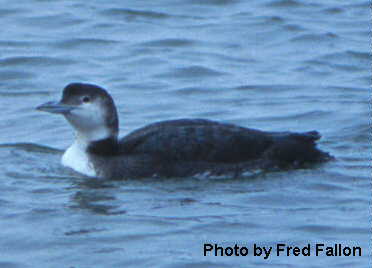
Gavia immer
(Common Loon)
Order: Gaviiformes
Order Description: Loons
Family: Gaviidae
Family Description: Loons
Physical Description:
Size: 28-36" (70-90 cm). A large, long-bodied, low-swimming waterfowl. Bill stout, straight, dagger shaped, dark. Breeding adults have a glossy- green/black head. Back black, checkered with white. White necklace. In winter, gray- brown above and white below.
Similar Species- Yellow-billed loon has an upturned, yellow bill. Pacific loon is smaller with pale gray crown and nape
Song:
Calls are a series of yodels and falsetto, maniacal laughter. A tremulous ha-oo- oo-oo. Usually silent in winter.
Distribution:
Breeds in Iceland, Greenland, and across Canada and northern U.S. to Alaska. Winters along Pacific Coast from Aleutians to northern Mexico, and along Atlantic and Gulf coasts from Newfoundland to Florida and Texas.
Habitat:
Primarily marine when not breeding. During migration, found on inland lakes, rivers, and coastal waters. In Idaho, breeds occasionally on a few lakes and reservoirs in southeastern Idaho, mostly in Fremont County.
Diet:
Feeds mainly on fishes, but may also eat amphibians and various invertebrates.
Ecology:
Builds platform nest on ground, at edge of shallow water. If nesting on small lake, may use adjacent lake for supplementary foraging. Dives from water surface to obtain food. Studies in different sections of U.S. indicate range of territory size from 39 ha (Saskatchewan) to 503 ha (New Hampshire). Species occurs as transient and breeder in Idaho, occupying water bodies that have suitable conformation and are not affected by human disturbance factors. Size and elevation of lake, water depth and clarity, and nesting habitat requirements are important factors in site use.
Reproduction:
Both sexes incubate usually 2 eggs (but frequently 1), for 26-31 days. Initially, both sexes tend young, which fly at 10-12 wk. Most brood mortality may occur within a week of hatching. Generally, loss of eggs to predators is not primary cause of breeding failure. Female renests usually 5-14 days after egg loss. Sensitive to disturbance by boaters at the nest.
Conservation:
| Element Code: | ABNBA01030 |
| Status: | Protected nongame species |
| Global Rank: | G5 |
| State Rank: | S1 |
| National Rank: | N4B,N5N |
Important State References:
Fitch, T. and C.H. Trost. 1985. Nesting status of the common loon in Idaho. Dept. Biol. Sciences, Idaho St. Univ., Pocatello. 23pp.
Photo by Fred Fallon, ©200
Design by Ean Harker©1999, 2000.
Written by Jason Karl, 2000.
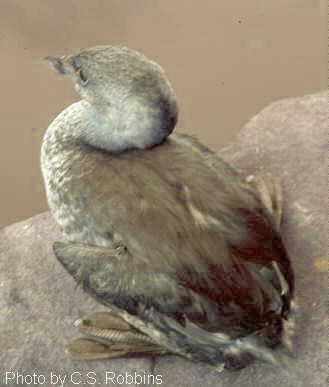
Podilymbus podiceps
(Pied-billed Grebe)
Order: Podicipediformes
Order Description: Grebes
Family: Podicipedidae
Family Description: Grebes
Physical Description:
Size: 12-15" (30-38 cm). A small, drab-brown grebe with a thick, short, chicken-like bill. Note the black bill ring and throat patch in the breeding season. Grebes have a similar appearance to ducks and have thick necks, lobed toes and a tailless look. In the winter, bill and throat patch are white. Sexes similar
Song:
A yelping yeow-yeow-yeow-yeow- keowm-keowm-keowm
Distribution:
Breeds from southeastern Alaska, east through southern Canada to Nova Scotia, and south locally through North and Middle America to South America. Winters in southern British Columbia, south through western and southern U.S. to South America.
Habitat:
During migration and when not breeding, found on brackish bays and estuaries. When breeding, found on lakes, ponds, sluggish streams, and marshes. In Idaho, prefers large lakes and reservoirs, but known to occur on smaller waters.
Diet:
Primarily feeds on fishes, crustacians, and insects, but will also consume amphibians, other invertebrates, and some plant material.
Ecology:
Builds platform nest in emergent vegetation in water about 1 m deep. Forages mainly by short dives in shallow water. Generally, density is 1 nesting pair on ponds of up to 4 ha, but many more are possible. One study found defended area with 46-m radius around nest, but nests may be closer than this. Residents form pairs or family groups, and are more gregarious in winter.
Reproduction:
Female lays 1 clutch (possibly 2 in some areas) of 2-10 (usually 4-7) eggs, and commonly renests if first clutch is lost. Incubation (mostly by female) lasts 20-27 days. Young fly by about 5 wk.
Conservation:
| Element Code: | ABNCA02010 |
| Status: | Protected nongame species |
| Global Rank: | G5 |
| State Rank: | S4 |
| National Rank: | N5B,N5N |
Important State References:
No references are available at this time.
Photo by C.S. Robbins,© 2002
Design by Ean Harker©1999, 2000.
Written by Jason Karl, 2000.
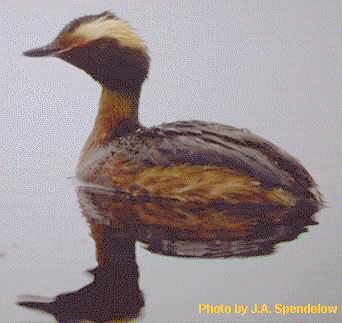
Podiceps auritus
(Horned Grebe)
Order: Podicipediformes
Order Description: Grebes
Family: Podicipedidae
Family Description: Grebes
Physical Description:
Size: 12-15" (30-40 cm). Sexes similar. During breeding season, rusty neck and lower-parts. Distinctive golden ear tufts. Dark head and back. Bill slender and dark. In flight, leading edge of wing white, white speculum. In winter, black "cap" on head with white neck.
Similar Species- Eared Grebe has black neck and crested head, no white on leading edge of wing. Red-necked Grebe is larger with white cheek and long bill with yellow base.
Song:
High squeals or a sharp ka-raa during breeding season. Generally silent.
Distribution:
Breeds in central and southern Alaska and Canada, south to Idaho, northern South Dakota, northern Iowa, and central Wisconsin. Winters mainly coastally south to California, Texas, and Florida. May breed rarely in southeastern Idaho.
Habitat:
When breeding, found on marshes, ponds, and lakes, and occasionally along sluggish streams. When not breeding, occupies bays, estuaries, and seacoasts.
Diet:
Usually eats small fishes, crustacians, and aquatic insects, but will also consume amphibians and leeches.
Ecology:
Usually nests among tall vegetation in shallow water. Predation may result in high nest losses. Size of breeding territory reflects location and abundance of food supply. Forages by diving in shallow water, often near emergent vegetation, but will also pick food from water surface or from vegetation. Usually not gregarious, except at staging and resting areas prior to and during migration.
Reproduction:
In southern Canada, female lays eggs mid-May to mid-July. Both sexes incubate 4-6 eggs for 22-25 days. Young are tended by one or both parents; most young fledge by 6-7 wk. Female renests if nest is destroyed.
Conservation:
| Element Code: | ABNCA03010 |
| Status: | Protected nongame species |
| Global Rank: | G5 |
| State Rank: | S1 |
| National Rank: | N5B,N5N |
Important State References:
No references are available at this time.
Original images provided by Jeff Spendelow,© 2000
Design by Ean Harker©1999, 2000.
Written by Jason Karl, 2000.
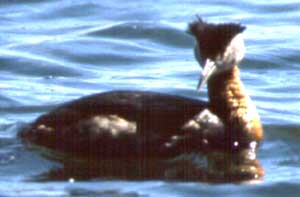
Podiceps grisegena
(Red-necked Grebe)
Order: Podicipediformes
Order Description: Grebes
Family: Podicipedidae
Family Description: Grebes
Physical Description:
Size: 18-22" (45-74 cm). This large grebe has a long, rufous neck with a white cheek and black cap on its head. Long bill, yellow at base. Body dark above and white below. Sexes similar. In winter, grayish with a white crescent-shaped strip on its neck. In flight, white speculum and leading wing edge.
Similar Species- Horned grebes are smaller, with slender black bills and golden ear tufts. Western and Clark's grebes are larger with white necks.
Song:
Generally silent. A sharp bark may be heard during breeding season.
Distribution:
Breeds in Alaska and western and south-central Canada, south to Washington, Montana, northeastern South Dakota, and Minnesota; rarely breeds elsewhere in northern United States. Winters coastally from Alaska to southern California, and also from Nova Scotia to central Florida (casually along Gulf Coast). In Idaho, breeds uncommonly on Panhandle and in south-central and southeastern Idaho.
Habitat:
Winters along seacoasts, bays, and estuaries. During migration, found on lakes, ponds, and rivers. In Idaho, prefers large lakes with clear water.
Diet:
Feeds on small fishes where available, but also eats aquatic and land insects, crustaceans, mollusks, aquatic worms, tadpoles, salamander eggs, some vegetable matter, and feathers.
Ecology:
Nests on floating or half- submerged vegetation. Usually nests solitarily, but will sometimes form loose colonies. Breeding territory size varies in accordance with food supply and other ecological factors. Dives underwater and forages on or near bottom for food. Flees by diving rather than flying.
Reproduction:
Peak egg-laying activity occurs in June in many areas. Male and female in turn incubate usually 3-5 eggs for 22-27 days. Both parents tend young, which probably become independent at 8-10 wk.
Conservation:
| Element Code: | ABNCA03020 |
| Status: | Protected nongame species |
| Global Rank: | G5 |
| State Rank: | S3 |
| National Rank: | N5B,N5N |
Important State References:
Taylor, D.M. and C.H. Trost. 1987. The status of rare birds in Idaho. Murrelet 68:69-93.
Photo by C. Trost, ©1999
Design by Ean Harker©1999, 2000.
Written by Jason Karl, 2000.
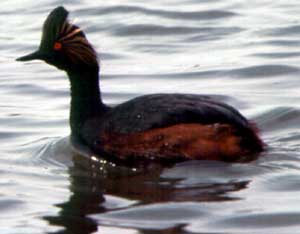
Podiceps nigricollis
(Eared Grebe)
Order: Podicipediformes
Order Description: Grebes
Family: Podicipedidae
Family Description: Grebes
Physical Description:
Size: 12-14" (30-38 cm). This small grebe has a distinctly crested head with golden "ears" during the breeding season. Thin black neck. Body dark, sometimes with rufous coloring on the sides. Sexes similar. In winter, dark neck and ear region contrasting with whiter face. Body dusky above, white below.
Similar Species- Horned Grebes have chestnut necks and flanks, lack crested head. Ear tufts more pronounced on Horned Grebe. In winter, these two species very similar. Eared grebe has slender neck, ill defined cap, and slightly upturned bill.
Song:
A loud ker-yeep! on the breeding range.
Distribution:
Breeds in southwestern Canada, east to Manitoba, and south through parts of western and midwestern U.S. to central Mexico. Winters mainly coastally, from Bitish Columbia to Guatemala, but also winters inland from northern Nevada and Utah south to Guatemala.
Habitat:
During migration and in winter, found on salt lakes, bays, estuaries, and seacoasts. Some individuals migrate to coast in fall; some remain inland during winter, in loose flocks on large bodies of fresh water. When breeding, found on marshes, ponds, and lakes.
Diet:
Diet includes aquatic insects and larvae, small fishes, crustaceans, and other small invertebrates
Ecology:
Feeds on or under surface of water. Escapes by diving. Migrates at night. Builds platform nest on shallow water. Usually nests in colonies on larger lakes (100 pairs on 1 lake is not unusuall). In Idaho, dense colonies of 10-30 pairs have been reported, and in 1993, 266-346 nests were estimated to exist. Gregarious at all times of year. Several hundred thousand may congregate in late summer and fall at Mono Lake, California.
Reproduction:
Breeding begins in mid-April in southern range, and in late May or June in north. both adults, in turn, incubate an average of 3-4 eggs from 20-22 days (southeastern Idaho study reported 2.6 eggs/nest on 11 nests). Young are reportedly independent in 3 wk.
Conservation:
| Element Code: | ABNCA03030 |
| Status: | Protected nongame species |
| Global Rank: | G5 |
| State Rank: | S4 |
| National Rank: | N5B,N5N |
Important State References:
Trost, C.H. 1994. The status and distribution of colonial water birds in northern Idaho and selected species in southern Idaho, 1994. Dept. Biol. Sciences, Idaho St. Univ., Pocatello. 31pp.
Photo by C. Trost, ©1999.
Design by Ean Harker©1999, 2000.
Written by Jason Karl, 2000.
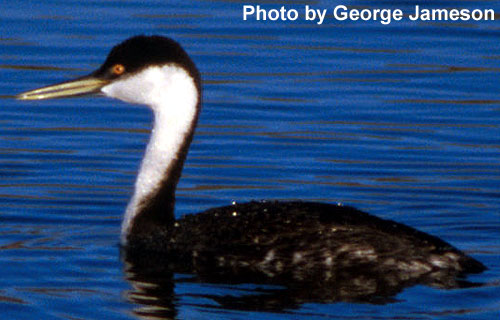
Aechmophorus occidentalis
(Western Grebe)
Order:Podicipediformes
Order Description:Grebes
Family:Podicipedidae
Family Description: Grebes
Physical Description:
Size:22-29" (56-74 cm). This is a large black and white grebe. It's long neck is white on the front and black on the back. It's black cap extends down below the eye. Body black. Bill yellow. Sexes similar.
Similar Species- The Clark's Grebe and Western Grebe were formerly considered to be the same species. The distinguishing morphological difference between them is that the cap on the Clark's Grebe does not extend past the eye. The Clark's Grebe's bill is also orange-yellow.
Song:
A two-part crick-crick. Heard most often during breeding season, but also heard occasionally during winter.
Distribution:
Breeds mainly from western Canada, east to southwestern Manitoba, and south through U.S. from California and Utah east to upper midwestern states. Winters mainly along Pacific Coast from southeastern Alaska to northwestern Mexico.
Habitat:
Found on marshes, lakes, and bays. During migration and in winter, also found on sheltered seacoasts, less frequently along rivers. In Idaho, prefers large rivers and reservoirs that include shallow water areas with emergent vegetation.
Diet:
Diet consists mainly of fishes; opportunistic as to species eaten. Also eats insects (adults and larvae, especially in spring and summer), mollusks, crabs, marine worms, and salamanders. Ingests feathers and small stones.
Ecology:
Builds platform nest on shallow water. Nests in colonies of sometimes hundreds or thousands of birds. In Idaho, nests in large colonies and isolated pairs that are susceptible to water fluctuations. Young may ride on backs of adults. Individuals dive from water surface to obtain food.
Reproduction:
Reported average clutch size is about 2.2-3.3 in southeastern Idaho, 2.5 in Utah, 3.4 in Colorado, and 4.2 in North Dakota. Dump nesting may result in large clutch in one nest. Both adults incubate, in turn. Incubation lasts 3-4 wk. Brood size is usually 1-3. Young are tended by both parents
Conservation:
| Element Code: | ABNCA04010 |
| Status: | Protected nongame species |
| Global Rank: | G5 |
| State Rank: | S4 |
| National Rank: | N5B,N5N |
Important State References:
Trost, C.H. 1994. The status and distribution of colonial waterbirds in northern Idaho and selected species in southern Idaho, 1994. Dept. Biol. Sciences, Idaho St. Univ., Pocatello. 31pp.
Photo by Luther Goldman and George Jameson, ©2002
Written by Jason Karl, 2000.
Design by Ean Harker©1999, 2000.
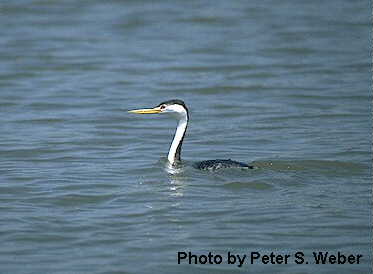
Aechmophorus clarkii
(Clark's Grebe)
Order: Podicipediformes
Order Description: Grebes
Family: Podicipedidae
Family Description: Grebes
Physical Description:
Size: 25" (63 cm). This is a large dark-gray and white grebe. Formerly considered to be a pale morph of the Western Grebe. It has a long, slender neck that is white on the front and black on the back. Note that its black cap does not extend below the eye. Bill orange-yellow. Sexes similar.
Similar Species- The Clark's Grebe and Western Grebe were formerly considered to be the same species. The distinguishing morphological difference between them is that the cap on the Western Grebe extends past the eye. The bill of the Western Grebe is yellow.
Song:
A one-note creek!
Distribution:
Breeds from southeastern Alaska, east to southwestern Manitoba, and south into portions of western and midwestern U.S.; also breeds in Mexico. Winters from southern British Columbia, south along Pacific Coast (sometimes inland) to Mexico.
Habitat:
Found on marshes, lakes, and bays. During migration and in winter, also found along sheltered seacoasts, and, less frequently, along rivers. Usually forages in deeper water than Western Grebe.
Diet:
Eats fishes and aquatic invertebrates.
Ecology:
Builds platform nest on shallow water. Nests colonially, often mixed with Western Grebes. Dives from water surface to obtain food. Species is rare in northern range, but as common as Western Grebe in south. Often seen in association with Western Grebes, but species is less common than the latter in Idaho. Ecology and reproduction are similar to, but not as well understood as, Western Grebe.
Reproduction:
Female lays 1 clutch of 3-4 eggs. Incubation (by both sexes) lasts about 23 days. Young leave nest at hatching, and are tended by both parents.
Conservation:
| Element Code: | ABNCA04020 |
| Status: | Protected nongame species |
| Global Rank: | G5 |
| State Rank: | S2 |
| National Rank: | N5B,N5N |
Important State References:
Trost, C.H. and A. Gerstell. 1994. Status and distribution of colonial nesting waterbirds in southern Idaho, 1993. Dept. Biol. Sciences, Idaho St. Univ., Pocatello. 101pp.
Photos by C. Trost and Peter S. Weber,© 2000
Design by Ean Harker©1999, 2000.
Written by Jason Karl, 2000.
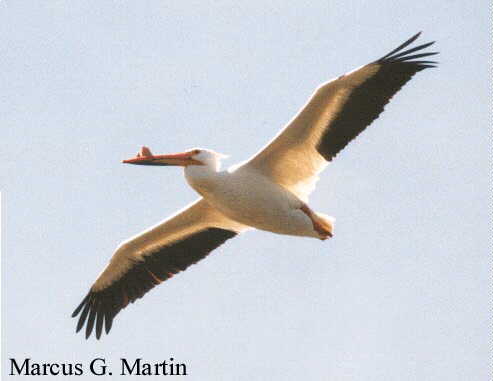
Pelecanus erythrorhynchos
(American White Pelican)
Order: Pelecaniformes
Order Description: Pelicans, Cormorants
Family: Pelecanidae
Family Description: Pelecans
Physical Description:
Size: 54-74" (137-138 cm). This is a large white bird with black primary and secondary flight feathers. Note the large, yellow, pouched bill. It has a wingspan of 8 to 9.5 feet. In flight, it alternately soars and flaps. Flies with neck bent and head close to body.
Similar Species- The Trumpeter Swan has no black on its wings. The Whooping Crane flies with its neck straight.
Song:
Generally silent.
Distribution:
Breeds in Canadian Prairie Provinces and parts of northwestern and midwestern U.S., south to coastal Texas. Winters along Gulf and Pacific coasts south to Guatemala. In Idaho, breeds at Minidoka National Wildlife Refuge, Blackfoot Reservoir, and on Snake River near Glenn's Ferry.
Habitat:
Found on rivers, lakes, estuaries, and bays. In Idaho, found on large inland reservoirs and island nests.
Diet:
Feeds mainly on fishes of little commercial value (e.g., carp, perch, catfish, suckers, stickleback). Eats some salamanders and crayfishes.
Ecology:
Gregarious. Nests on ground, in rimmed scrape. In Idaho, several nesting colonies have been abandoned due to human distrubance. Foxes and coyotes are nest predators. Estimates from 1993 survey indicate 150-175 nexts are located at Minidoka NWR and 80-100 nests are located at Blackfoot Reservoir.
Reproduction:
Both adults incubate 2 eggs (usually); rarely does more than 1 young fledge (in an Idaho study, 5 nests yielded an average of 1.8 young/nest). Young are tended by both adults, leave nest in about 21-28 days, and first fly at 7-10 wk. In Manitoba study, 34-38 days elapsed between time flocks first flew over colony sites and time eggs hatched.
Conservation:
| Element Code: | ABNFC01010 |
| Status: | Protected nongame species |
| Global Rank: | G3 |
| State Rank: | S1 |
| National Rank: | N3B,N3N |
Important State References:
Trost, C.H. and A. Gerstell. 1994. Status and distribution of colonial nesting waterbirds in southern Idaho, 1993. Dept. Biol. Sciences, Idaho St. Univ., Pocatello. 101pp.
Photo by Marcus Martin, ©1999.
Design by Ean Harker©1999, 2000.
Written by Jason Karl, 2000.
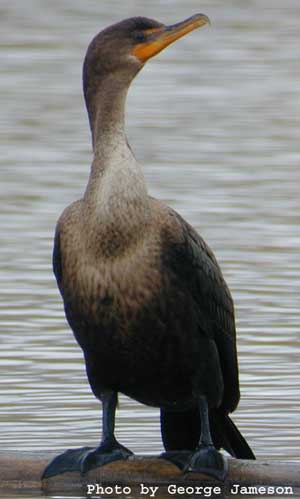
Phalacrocorax auritus
(Double-crested Cormorant)
Order: Pelecaniformes
Order Description: Pelicans, Cormorants
Family: Phalacrocoracidae
Family Description: Cormorants
Physical Description:
Size 30-36" (76-91 cm). Idaho's only breeding cormorant. A goose-sized, black or dark bird. Immature birds light brownish. Breeding adults have inconspicuous tufts on either side of the crown of the head. Head normally uplifted. Distinguished from other cormorants by its orange-yellow throat patch. Cormorants will fly in lines or wedges, similar to geese, but are silent. Neck kinked when in flight.
Similar Species- No other cormorants normally breed in Idaho. Very distinct.
Song:
Generally silent.
Distribution:
Breeds throughout much of North America (locally in interior), from southern Alaska, Manitoba, and Newfoundland, south to Gulf Coast and northwestern Mexico. Winters throughout most of coastal breeding range.
Habitat:
Found on lakes, rivers, swamps, and seacoasts. In Idaho, occupies larger water courses and reservoirs.
Diet:
Feeds primarily on nongame fish.
Ecology:
Dives from water surface to obtain food; usually feeds in water less than 15 m deep. Forages cooperatively. Nests mostly in colonies; entire colony will nest either in tree or on ground. Increased sea surface temperatrues, such as those associated with El Nino events, were correlated with decreases in nesting populations in Washington. Species is common transient and summer breeder in Idaho, where nesting areas are easily disturbed by man. Gulls prey on eggs. Young can suffer from heat prostration.
Reproduction
Both sexes in turn incubate 2-9 eggs (usually 3-4), for 24-25 days (southeastern Idaho study found average of 3.5 young for 12 nests). Young first fly to water at about 35-42 days, and become independent at 10 wk. Adults usually breed by third year.
Conservation:
| Element Code: | ABNFD01020 |
| Status: | Protected nongame species |
| Global Rank: | G5 |
| State Rank: | S2 |
| National Rank: | N5B,N5N |
Important State References:
Trost, C.H. and A. Gerstell. 1994. Status and distribution of colonial nesting waterbirds in southern Idaho, 1993. Dept. Biol. Sciences, Idaho St. Univ., Pocatello. 101pp.
Photo by George Jameson, ©2002 and Jeff Spendelow,© 1999
Design by Ean Harker©1999, 2000.
Written by Jason Karl, 2000.
Botanus lentiginosus
(American Bittern)
Link to photo provided by the USGS - Patuxent Wildlife Research Center: http://www.mbr-pwrc.usgs.gov/Infocenter/infocenter.html
Order: Ciconiiformes
Order Description: Bitterns, Herons, Egrets,and Ibises
Family: Ardeidae
Family Description: Bittern
Physical Description:
Buffy brown with a streaky breast. When disturbed it stands still with its bill pointed skyward. In flight its dark primaries contrast with the buffy brown back.
Song:
A deep "gulping" gurgle is made.
Distribution:
Breeds from southeastern Alaska, east to Newfoundland, south across upper and middle U.S. and locally along Gulf Coast and down to Mexico, Winters from southwestern British Columbia, southeast through parts of U.S. to southern Mexico.
Habitat:
Found on freshwater bogs, swamps, wet fields, cattail and bullrush marshes, brackish and saltwater, and meadows. In Idaho, also occurs on streams, canals, reservoirs, and wet meadows.
Diet:
Eats mainly fishes, crayfishes, amphibians, mice, shrews, and other animals, and insects.
Ecology:
Nocturnal, crepuscular. Nests on ground, never is trees or bushes. Mostly solitary, but may nest in loose colonies. Species is easily overlooked and may be quite common.
Reproduction:
Female (apparently) incubates 2-6 eggs (usually 3-5), for 24-28 days. Young leave nest at about 14 days.
Conservation:
| Element Code: | Unknown |
| Status: | Protected nongame species |
| Global Rank: | G4 |
| State Rank: | S4 |
| National Rank: | Unknown |
Important State References:
No references available at this time.
Written by Jason Karl, 2000.
Additional information by C. Trost, 2000
Design by Ean Harker©1999, 2000.
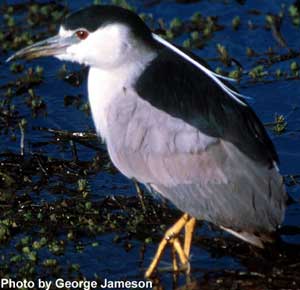
Nycticorax nycticorax
(Black-crowned Night-heron)
Order: Ciconiiformes
Order Description: Bitterns, Herons, Egrets,and Ibises
Family: Ardeidae
Family Description: Herons, Bitterns, and Egrets
Physical Description:
Size 23-28" (58-71 cm). A medium sized heron with stocky build and thick, black, slightly down-turned bill. Glossy black-green crown, gray wings and, underparts white. Three large white plumes on the back of the neck. Short neck. Usually stands hunched, inactive. Immatures are mottled brown with buff spots or streaks.
Similar Species- Immature Black-Crowned Night-Herons can resemble American Bitterns. The Bittern has a black neck stripe and black primaries.
Song:
A flat, barking Quock!
Distribution:
Breeds from Washington and southern Idaho, east through parts of Canada and Great Lakes to Nova Scotia, and south to southern South America. Winters from Oregon, Utah, lower Ohio Valley, and New England, south to South America.
Habitat:
Found in brackish, saltwater, or freshwater situations in marshes, swamps, and wooded streams, and on shores of lakes, ponds, and lagoons.
Diet:
Feeds opportunistically on fishes, amphibians, and invertebrates; may also eat small mammals and young birds.
Ecology:
Nocturnal/crepuscular, but may sometimes feed by day. Builds nest in trees or bushes. In Idaho, prefers to nest in trees and bushes such as alders, cottonwood, chokecherry, and willows. Nests in small to large colonies. Forages in shallow water for food; may also forage on land. In Idaho, predators include various gulls, Black-billed Magpies, and American Crows. Reproduction has been depressed by pesticide contamination. Some Idaho birds winter in Mexico.
Reproduction:
clutch size varies from 3-5 eggs in northern range, 2-4 eggs in south (southeastern Idaho study reported 3.6 average clutch size). Both sexes incubate eggs; incubation apparently lasts 24-26 days. Young fly at about 42 days, and usually breed at 2-3 yr.
Conservation:
| Element Code: | ABNGA11010 |
| Status: | Protected nongame species |
| Global Rank: | G5 |
| State Rank: | S3 |
| National Rank: | N5B,N5N |
Important State References:
Findholt, S. and C.H. Trost. 1985. Organochlorine pollutants, eggshell thickness, and reproductive success of Black-crowned Hight-Herons in Idaho, 1979. Colonial Waterbirds 8:32-41.
Photo by George Jameson, ©2002
Design by Ean Harker©1999, 2000.
Written by Jason Karl, 2000.
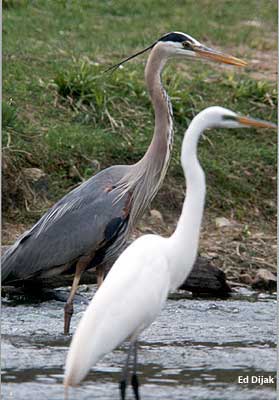
Ardea herodias
(Great Blue Heron)
Order: Ciconiiformes
Order Description: Bitterns, Herons, Egrets,and Ibises
Family: Ardeidae
Family Description: Herons, Bitterns, and Egrets
Physical Description:
Size: 42-52" (107-132 cm). A lean, tall gray-blue bird. Back and wings are blue-gray, underparts whitish. Head white with a black stripe ending in black plumes behind the eye. Black and white foreneck and chest end in gray plumes in the breeding adults. Bill thick, yellow, daggerlike. Thighs rufous. It flies with its neck coiled.
Similar Species- Sandhill Crane has a red cap, is heavier, shorter billed and flies with its neck and legs outstretched.
Song:
Generally silent, makes a loud Croak sound when startled or alarmed.
Distribution:
Breeds from southeastern Alaska and southern Canada, south to southern Mexico. Winters from southeastern Alaska, central U.S., and southern New England, south to northern South America. Wanders widely outside usual range. Some sub-adults may summer in non-breeding range.
Habitat:
Found on freshwater and brackish marshes, along lakes, rivers, bays, lagoons, ocean beaches, fields, and meadows. In Idaho, species follows major watercourses.
Diet:
Eats fishes, insects, crustaceans, amphibians, reptiles, mice, shrews, and other animals.
Ecology:
Builds nest in tree, sometimes in shrub, rarely on ground. Nests in colonies. Colony size can vary from few pairs to hundreds of pairs; colonies may be displaced by Bald Eagles. In general, individuals are most active just before dawn and at dusk, but Idaho study found herons come and go from colonies regularly, with no peak activity periods. Individuals usually forage while standing in water, but will also forage in fields or drop from air (or perch) into water. May establish feeding territories in winter. Usually solitary when not breeding. In Idaho, some herons are year-round residents while others, especially in northern Idaho, are breeders or transients. Species is most common and widely distributed colonial waterbird in Idaho.
Reproduction:
Both sexes incubate 3- 7 eggs (usually 4), for 25-29 days (Idaho study reported mean colony size at 24.6 birds with 2.2 young/nest). Both parents tend young, which leave nest in 60-90 days, and may first breed at 2 yr.
Conservation:
| Element Code: | ABNGA04010 |
| Status: | Protected nongame species |
| Global Rank: | G5 |
| State Rank: | S5 |
| National Rank: | N5B,N5N |
Important State References:
Trost, C.H. 1994. The status and distribution of colonial waterbirds in northern Idaho and selected species in southern Idaho, 1994. Dept. Biol. Sciences, Idaho St. Univ., Pocatello. 31pp.
Photos by Ed Dijak,© 2000
Design by Ean Harker©1999, 2000.
Written by Jason Karl, 2000.
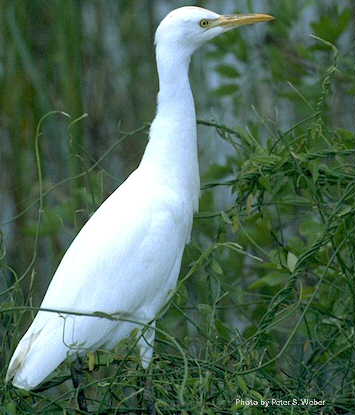
Bubulcus ibis
(Cattle Egret)
Order: Ciconiiformes
Order Description: Bitterns, Herons, Egrets,and Ibises
Family: Ardeidae
Family Description: Herons, Bitterns, and Egrets
Physical Description:
Size 20" (51 cm). A small white heron. resembles the Snowy Egret, but has s shorter, thicker neck and orangish bill and legs. Breeding adults have a buff-orange plumes on mantle, breast and crown. Often stands in a hunched position.
Similar Species- Great Egret is much taller and more slender with longer bill and legs. Legs always black. Snowy Egret has longer, slimmer black bill, yellow feet.
Song:
Makes various croaking sounds on the breeding range.
Distribution:
Breeds from California, southern Idaho, Colorado, and North Dakota, east through parts of southern Canada and northern U.S. to Maine, and south (primarily in coastal lowlands) to South America. Winters throughout much of breeding range.
Habitat:
Found in wet pastures and freshwater and brackish areas, but may also be found in dry fields and garbage dumps.
Diet:
Eats mainly insects and amphibians, but may also eat reptiles and small rodents.
Ecology:
Builds nest in tree with other egrets and ibis. Frequently nests in colonies. In Idaho, shares nesting areas with herons. Often flies in large flocks in morning and evening. Usually feeds on dry or moist ground near cattle or horses, sometimes near farm machinery.
Reproduction:
Both sexes incubate 2- 6 eggs (usually 3-4), for 21-24 days. Young fly short distances at 40 days, and reasonably well at 50 days. May breed at 1 yr.
Conservation:
| Element Code: | ABNGA07010 |
| Status: | Protected nongame species |
| Global Rank: | G5 |
| State Rank: | S2 |
| National Rank: | N5B,N5N |
Important State References:
Trost, C.H. and A. Gerstell. 1994. Status and distribution of colonial nesting waterbirds in southern Idaho, 1993. Dept. Bio. Sciences, Idaho St. Univ., Pocatello. 101pp.
Photos by C. Trost and P.S. Weber,© 2000
Design by Ean Harker©1999, 2000.
Written by Jason Karl, 2000.
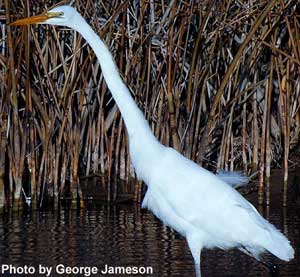
Ardea alba
(Great Egret)
Order: Ciconiiformes
Order Description: Bitterns, Herons, Egrets,and Ibises
Family: Ardeidae
Family Description: Herons, Bitterns, and Egrets
Physical Description:
Size 37-41" (94-104 cm). Body snow white. Breeding adults have back covered in white plumes. Juveniles lack plumes and have a dark tip on their bill. Yellow bill, black legs and feet. Flies with neck kinked, characteristic or herons.
Similar Species- Cattle Egret is smaller, more compact, with shorter bill and legs, thick head. Snowy Egret is smaller with black bill and yellow feet.
Song:
A low croak. Usually silent.
Distribution:
Breeds from southern Oregon and southern Idaho, east (irregularly) through Canadian Priarie Provinces and northeastern U.S., and south to Gulf Coast states, southern New Mexico, coastal Mexico, and southern South America. Winters from southern U.S., south through breeding range to southern South America. Wanders irregularly outside usual range.
Habitat:
Found on marshes, swampy woods, tidal estuaries, lagoons, along streams, lakes, and ponds, and in fields and meadows.
Diet:
Eats mainly fishes, amphibians, snakes, snails, crustaceans, insects, and small mammals.
Ecology:
Builds nest in tree, occasionally in shrub. Nests solitarily or in small to large colonies. Usually forages singly, during daylight, in marshes and shallow water ponds, but may also feed in fields or drop from air (or perch) into water. Arrives back at roost at sunset or at dark. Individuals may gather in groups when not breeding.
Reproduction:
Both sexes incubate 1- 6 eggs (usually 3-4 in northern range, 2-3 in south). Incubation lasts 23-24 days. Young fly at about 42 days.
Conservation:
| Element Code: | ABNGA04040 |
| Status: | Protected nongame species |
| Global Rank: | G5 |
| State Rank: | S1 |
| National Rank: | unknown |
Important State References:
Trost, C.H. and A. Gerstell. 1994. Status and distribution of colonial nesting waterbirds in southern Idaho, 1993. Dept. Biol. Sciences, Idaho St. Univ., Pocatello. 101pp.
Photo by C. Trost, George Jameson, and Ed Dijak,© 2000
Design by Ean Harker©1999, 2000.
Written by Jason Karl, 2000.
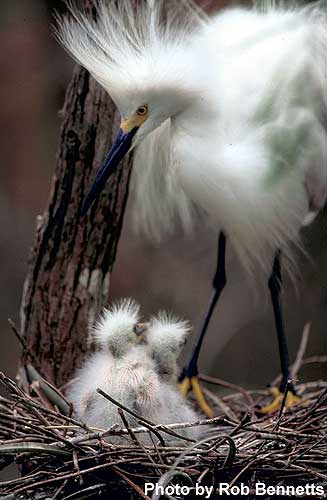
Egretta thula
(Snowy Egret)
Order: Ciconiiformes
Order Description: Bitterns, Herons, Egrets,and Ibises
Family: Ardeidae
Family Description: Herons, Bitterns, and Egrets
Physical Description:
Size: 20-27" (51-69 cm). A medium-sized heron with snow-white body. Black bill and legs with yellow feet. Breeding Adults have long, filamentous plumes down back and tail. Flies with its neck tightly coiled.
Similar Species- Great Egret much taller, black legs and feet and yellow bill. Cattle Egret has yellow-to red-orange bill, thicker head.
Song:
A low croak heard in colony. Also a bubbling wulla-wulla-wulla.
Distribution:
Breeds from northern California, southern Idaho, Kansas, lower Mississippi Valley, and Gulf and Atlantic coasts, south through Mexico to South America. Winters from northern California, southwestern Arizona, Gulf Coast, and South Carolina, south through breeding range. Wanders irregularly outside usual range.
Habitat:
Found on marshes, lakes, ponds, reservoirs, lagoons, and shallow coastal habitats.
Diet:
Eats small fishes, frogs, lizards, snakes, crustaceans, worms, snails, and insects.
Ecology:
Nests under shrubs, or in trees and bushes, preferably on islands. Usually found in loose groups; frequently roosts communally, and nests in large colonies. Usually forages in shallow water, but may also graze in fields. Species is present in Idaho from mid-April to September. In past, Idaho reproduction has been depressed due to DDT and other pesticide contamination. Predators include gulls, crows, and magpies.
Reproduction:
Female lays eggs usually from April to May or June in northern range. Both sexes incubate 4-5 eggs in northern range, 2-4 in south (in Idaho study, clutch size averaged 3.7). Incubation lasts 18 days or longer. Young leave nest at 20-25 days; may first breed at 1 yr.
Conservation:
| Element Code: | ABNGA06030 |
| Status: | Protected nongame species |
| Global Rank: | G5 |
| State Rank: | S2 |
| National Rank: | N5B,N5N |
Important State References:
Findholt, S. 1984. Organochlorine residues, eggshell thickness, and reproductive success of snowy egrets nesting in Idaho. Condor 86:163-169.
Photo by R. Bennetts,© 2000
Written by Jason Karl, 2000.
Design by Ean Harker©1999, 2000.

Plegadis chihi
(White-faced Ibis)
Order: Ciconiiformes
Order Description: Bitterns, Herons, Egrets,and Ibises
Family: Threskiornithidae
Family Description: Ibises
Physical Description:
Size: 19-26" (48-66 cm). A chestnut-brown wading bird with green and violet glossy tint to underparts. Long legs. Long, decurved bill. Breeding adults have a white ring around the bill and eye, red legs. Immatures and non-breeding adults lack the white face and red color to legs. Flies with neck and legs outstretched.
Similar Species- No similar species in Idaho. Very similar in appearance to the Glossy Ibis which breeds only in eastern North America.
Song:
A low quacking while flying
Distribution:
Breeds locally from central California, eastern Oregon, southern Idaho, and Northern Plains states, south through parts of Gulf Coast states and Mexico to South America. Winters from southern California, southern Texas, and Louisiana, south through lowlands to Guatemala and El Salvador, and generally in breeding range in South America. Wanders outside usual range.
Habitat:
Found mostly in freshwater areas, on marshes, swamps, ponds and rivers. In Idaho, prefers shallow-water areas.
Diet:
Eats crayfish, frogs, fishes, insects, newts, earthworms, and crustaceans.
Ecology:
Builds nest on ground, or in shrub or tree. In Idaho, nests in tule habitat (not known to nest in state prior to 1970). Nesting failure may result from loss of riparian habitat. Typically feeds in freshwater marshes. Some avian predation is known (gulls), but mammalian predation is minimal except during droughts.
Reproduction:
clutch size usually varies from 3-4 eggs. Incubation lasts 21-22 days. In southern Idaho study, clutch size varied from 2.7-4 eggs/nest, and brood size averaged 2.4 young/nest.
Conservation:
| Element Code: | ABNGE02020 |
| Status: | Protected nongame species |
| Global Rank: | G5 |
| State Rank: | S2 |
| National Rank: | N4B,N4N |
Important State References:
Trost, C.H. and A. Gerstell. 1994. Status and distribution of colonial nesting waterbirds in southern Idaho, 1993. Dept. Biol. Sciences, Idaho St. Univ., Pocatello. 101pp.
Photo by George Jameson, ©2002
Design by Ean Harker©1999, 2000.
Written by Jason Karl, 2000.
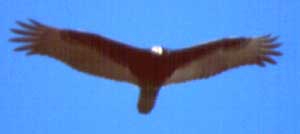
Cathartes aura
(Turkey Vulture)
Order: (Ciconiiformes*) Falconiformes
Order Description: New World Vultures
Family: Cathartidae
Family Description: Vultures
Species Update:
*Cathartidae species are now officially considered Ciconiiformes. In other words, New World vultures (i.e., Turkey Vulture, Condors, etc.) have been genetically found to be related to storks and not hawks in DNA research on convergent evolution.
Physical Description:
26-32" (66-81 cm). Large, black bird with a red, featherless face and a pale, downcurved bill; yellow feet. In flight, wings show lighter primary feathers.
Similar Species- Black Vulture, Swainson's Hawk, Zone-tailed Hawk
Song:
Occasionally hisses.
Distribution:
Breeds from southern British Columbia, east to southern Manitoba and New England, and south through U.S. and Middle America to South America. Winters mainly from northern California, Arizona, Ohio Valley, and Maryland south to South America.
Habitat:
Found in forested and open situations (more commonly in latter), from lowlands to mountains. In Idaho, occupies broad valley and mountain areas.
Diet:
Eats mainly vertebrate carrion; prefers fresh meat. Sometimes eats ripe or rotten fruits.
Ecology:
Uses scant nest on cliff or standing snag. May roost singly, or in large flocks in trees at night; roosts are often near or over water. In Maryland/Pennsylvania study, average distance between communal roost and feeding site was 8 km. Roosts may be temporary (at food source), seasonal (spring-fall), or permanent. In one study, most individuals left roost 3.5-5 hr after sunrise. Individual may remain at roost up to 2 or more days during rainy weather. Locates food visually, or by odor. Hunts at 60 m, but migrates between 1200-1500 m. Light wing loading permits ease of flight. Species is resistant to botulism.
Reproduction:
Both sexes incubate 2 eggs (usually) for 5-6 wk. Young first fly at about 9 wk. Family may stay together several months after young fledge.
Conservation:
| Element Code: | ABNKA02010 |
| Status: | Protected nongame species |
| Global Rank: | G5 |
| State Rank: | S4,NTMB |
| National Rank: | N5B,N5N |
Important References:
AOU Checklist, 1998, 7th Ed..
Additional Information by C. Trost.2000.
Photo by C. Trost, ©1998.
Design by Ean Harker©1999, 2000.
Written by Jason Karl, 2000.
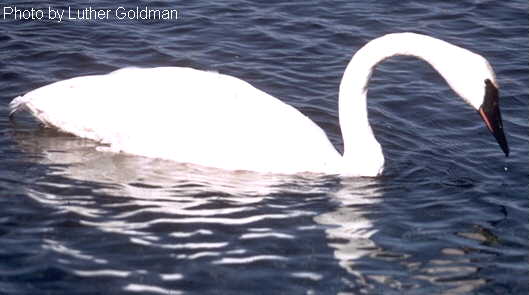
Cygnus buccinator
(Trumpeter Swan)
Order: Anseriformes
Order Description: Swans, Geese, Ducks
Family: Anatidae
Family Description: Swans, Geese and Ducks
Physical Description:
Size: 60-72" (150-180 cm). A large, pure white swan with long neck, flat head and heavy, all black bill. Swim with neck straight and bill horizontal.
Similar Species- Tundra swan is smaller with a small yellow spot between the eye and the bill. Head rounder, call softer, high-pitched hoo-hoo-hoo given in flight.
Song:
A loud, booming horn-like call on one pitch
Distribution:
Breeds in Alaska, western Canadian provinces, southeastern Oregon, eastern Idaho, Montana, and northwestern Wyoming. Introduced and established in Nevada and southwestern South Dakota. Winters primarily from southern Alaska to Montana, and south to northern California, sometimes Utah, New Mexico, and eastern Colorado.
Habitat:
Breeds primarily in freshwater in emergent vegetation such as reeds or sedges, but occasionally chooses brackish situations. Winters on open ponds, lakes, and sheltered bays and estuaries. In Idaho, breeding occurs on marshes, lakes, and beaver ponds; wintering occurs along shallow, slow-moving waters.
Diet:
Adults feed on aquatic vegetation, but may also graze in fields. Young eat aquatic beetles and crustaceans, and, after 5 wk, aquatic plants. In Idaho, adults feed primarily on water- milfoil and pondweed; existing evidence indicates that preferred winter food is declining.
Ecology:
Builds nest on ground. Forages on, or just under, water surface. Occurs as resident along Yellowstone Park border; migrant, northern populations winter in Harriman State Park and Island Park. Extensive studies have been done in Idaho on wintering and nesting behavior and habitat. High first-year mortality in Tri-state (WY, ID, MT) cygnet population. Low winter flows and cold conditions can negatively impact wintering swans. Several breeding areas in Idaho outside of Fremont Co. are result of transplants.
Reproduction:
clutch size varies from 2-9 eggs, but is usually around 5 (in Idaho study, mean clutch size ranged 3.6-4.4). Both sexes, but mainly the female, incubate eggs. Incubation lasts 33-37 days. Nestlings are precocial, but remain with adults until subsequent spring. Fledging period lasts 100-120 days. In Idaho, productivity of Trumpeter Swans has decreased in last 10 yr, perhaps due to poor cygnet survival.
Conservation:
| Element Code: | ABNJB02030 |
| Status: | Protected nongame species |
| Global Rank: | G5 |
| State Rank: | S1 |
| National Rank: | N4B,N4N |
Important State References:
Gale, R.S., E.O. Garton, and I.J. Ball. 1987. The history, ecology, and management of the Rocky Mountain population of trumpeter swans. Idaho Dept. Fish & Game, Boise. 314pp.
Photos by Luther Goldman,© 2002 and from © Corel Corporation, 1993 - Corel Professional Photo Series # 94000, Yellowstone National Park, #94055.
Design by Ean Harker 1999, 2000, 2001.
Written by Jason Karl, 2000.
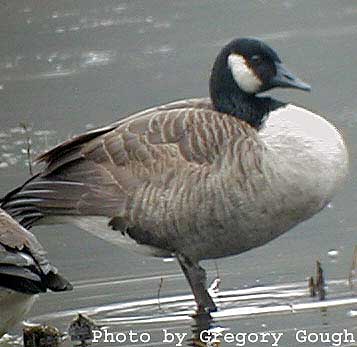
Branta canadensis
(Canada Goose)
Order: Anseriformes
Order Description: Swans, Geese, Ducks
Family: Anatidae
Family Description: Swans, Geese and Ducks
Physical Description:
Size: 22-45" (56-92 cm). The most common goose in North America. Adults have a black head, neck, and bill and white cheek patches. Body gray to brown. Lower belly, upper and lower tail coverts white. Tail and rump black. Great variation in size and neck length between populations.
Similar Species- None in Idaho.
Song:
A deep, loud, musical Ha-Honk! Often made in flight with other Canada Geese.
Distribution:
Breeds from northern Alaska, east to Labrador and Greenland, and south to southeastern Canada, California, Utah, and northern Arkansas. Winters from Alaska and southern Canada, south to Florida, Gulf Coast, and northern Mexico. In North America, many introduced non-migratory populations exist within and outside normal range.
Habitat:
Found in various habitats near water, from temperate regions to tundra. During migration and in winter, found on coastal and freshwater marshes, lakes, rivers, and fields. In Idaho, occurs in variety of habitats, including lakes, reservoirs, rivers, farmlands, and city parks.
Diet:
Grazes on marsh grasses, sprouts of winter wheat in spring, and grains in fall. Eats clover, cattails, bulrushes, algae, pondweed, and other plants. Also eats mollusks and small crustaceans.
Ecology:
Highly social species. Builds nest on ground, usually near water. Feeds in shallows, marshes, and fields. Usually feeds in early morning and late afternoon. May be active day or night during migration. In one study, mean annual survival rate for Rocky Mountain birds banded on neating areas was 53% (immatures) and 64% (adults). Large resident population exist in southern Idaho; during winter, northern migrants are present throughout state. Populations through out state have been enhanced through artificial nest platforms. Species is sometimes considered an agricultural pest. A study initiated by the Idaho Dept. Fish & Game in southwestern Idaho in 1993 is estimating population size and trend and examing factors affecting mortality rates.
Reproduction:
Female incubates 2-11 eggs (usually 5-6), for 25-30 days. Nestlings are precocial. Young are tended by both adults, and remain with adults until next spring. Some individuals begin breeding at 2 yr, most by age 3. May nest early in Idaho to avoid high spring waters.
Conservation:
| Element Code: | ABNJB05030 |
| Status: | Game species |
| Global Rank: | G5 |
| State Rank: | S5 |
| National Rank: | N5B,N5N |
Important State References:
Krohn, W.B. and E.G. Bizeau. 1980. The Rocky Mountain population of the western Canada goose: its distribution, habitat and management. USDI Fish and Wildl. Serv. Spec. Sci. Rpt. Wildl. No. 229. 93pp.
Photos by Gregory Gough and © Corel Corporation, 1993 - Corel Professional Photo Series # 94000, Yellowstone National Park, #94056.
Design by Ean Harker©1999, 2000.
Written by Jason Karl, 2000.
Aix sponsa
(Wood Duck)
Link to photo provided by USGS - Patuxent Wildlife Research Center: http://www.mbr-pwrc.usgs.gov/Infocenter/infocenter.html
Order: Anseriformes
Order Description: Swans, Geese, Ducks
Family: Anatidae
Family Description: Swans, Geese and Ducks
Physical Description:
Size: 10-21" (43-52 cm). Male is unmistakable, brightly colored with a long, swept-back crest. Neatly striped faced pattern of green, white and dark purple. Throat and breast chestnut. Bold, white, vertical line seperating chestnut breast from buff flanks and bark brown wings and back. Females dark above and lighter brown below. Distinct white eye patch. In flight: stocky build, white belly, dusky wings and long, square tail.
Similar Species- Male distinct. No other freshwater duck has a white eye patch like the female Wood Duck.
Song:
Male gives a clear, hissing whistle which rises in pitch. When distressed, male gives a Whoo-eeek! Female a low Creek!
Distribution:
Breeds from southern British Columbia and Alberta, south to central California and northern Idaho, and throughout most of eastern U.S. and adjacent southern Canada. Winters mostly on Pacific Coast and interior California, north to Kansas, southern Iowa, Ohio Valley, and New England.
Habitat:
Found near woodlands on quiet, inland waters such as wooded swamps, flooded forests, ponds, marshes, and along streams. In Idaho, occupies wooded streams, flooded marshes, and lake margins. Winters on both freshwater and brackish marshes, ponds, streams, and estuaries.
Diet:
Eats seeds and other parts of aquatic plants, nuts (especially acorns), fruits, shrubs, and aquatic and land insects. Young initially eat mainly insects, but may also eath duckweed, and, occasionally, frogs
Ecology:
Builds nest in tree cavity, or may sometimes use cavity left by other species. Forages in shallow water. High annual mortality rate (commonly 50% in adults, higher in young-of-year). In Idaho, species has adapted well to nest boxes (which enhance local populations), is largely absent from southern Idaho (where suitable habitat is lacking), but occurs commonly in northern Idaho during nesting season and migration.
Reproduction:
Female incubates 9-15 eggs (usually 10-12) for 27-37 days. Young first fly at about 9 wk, and are abandoned by parent at 1-2 mo. yearlings may breed, but are often unsuccessful. Female often produces 2 broods/yr in southern range, and 1 (occasionally 2), in north.
Conservation:
| Element Code: | ABNJB09010 |
| Status: | Protected nongame species |
| Global Rank: | G5 |
| State Rank: | S4 |
| National Rank: | N5B,N5N |
Important State References:
Gadwa, G.U. 1977. Experimental transplanting of wild wood duck hens and broods in northern Idaho. M.S. Thesis, Univ. Idaho, Moscow. 33pp.
Design by Ean Harker©1999, 2000.
Written by Jason Karl, 2000.
Anas crecca
(Green-winged Teal)
Order: Anseriformes
Order Description: Swans, Geese, Ducks
Family: Anatidae
Family Description: Swans, Geese and Ducks
Physical Description:
Size: 12.5-15.5" (32-39 cm). The smallest dabbling duck. Male: compact, gray body separated by a vertical white from the pinkish speckled breast. Head chestnut-brown with a green patch around and behind the eye. Cream-colored patch under dark tail. Female is dark gray-brown with buff under-tail. In flight, both sexes show a green speculum on the wing. No other pattern on the top or bottom of wing in flight.
Similar Species- The Cinnamon Teal and Blue- winged Teal have blue or white patches on the upper wings. In flight male Blue-winged Teal shows dark belly. Females of Cinnamon Teal and Blue-winged Teal are larger and longer billed.
Song:
Male gives a series of high, whistle-like Dreeep's. Female, a low quack.
Distribution:
Breeds from north-central Alaska and northwestern and central Canada, south to California, northern New Mexico, northern Great Plains states, Ohio, western New York, Maine, and Nova Scotia. Winters in U.S., south to central Mexico.
Habitat
Found on freshwater ponds, marshes, and shallow edges of lakes. In Idaho, found at low and medium elevations on streams, ponds, irrigation ditches, lakes, rivers, and reservoirs. During migration and in winter, found on shallow, salt or brackish water and along shores.
Diet:
Eats aquatic plants, seeds of sedges, smartweeds, pondweeds, grasses, aquatic insects, mollusks, crustaceans, tadpoles, berries, grapes, and acorns. Will eat waste grain in fall.
Ecology:
Builds well-hidden nest on ground. Dabbles in shallow water, and forages on land.
Reproduction:
Female incubates 7-15 eggs (usually 8-9) for 21-23 days. Male abandons female early in incubation. Female tends nestlings, which are precocial and become independent in about 23 days. Young have fastest growth rate of all North American waterfowl.
Conservation:
| Element Code: | ABNJB10010 |
| Status: | Game species |
| Global Rank: | G5 |
| State Rank: | S4 |
| National Rank: | - |
Important State References:
No references are available at this time.
Photo by Greg Kearns, ©2002.
Design by Ean Harker©1999, 2000.
Written by Jason Karl, 2000.
Anas platyrhynchos
(Mallard)
Link to photo provided by USGS - Patuxent Wildlife Research Center: http://www.mbr-pwrc.usgs.gov/Infocenter/infocenter.html
Order: Anseriformes
Order Description: Swans, Geese, Ducks
Family: Anatidae
Family Description: Swans, Geese and Ducks
Physical Description:
Size: 20.5-28" (52-71 cm). This is the largest of North America's dabbling ducks. From fall until the end of breeding season, males have a solid greed head, white collar, reddish-chestnut breast, grayish sides and a black rump. Females are mottled brown with a whitish tail and mottled orange bill. Both sexes have a blue speculum bordered on the top and bottom by white bars
Similar Species- Female mallards and many other dabbling ducks can look similar; however the mallard is the only species with white borders on the top and bottom edge of the speculum.
Song:
The call of the female is a loud waack-waack-waack! The males gives a softer version of this call.
Distribution:
Breeds from Alaska, Mackenzie Delta, and Maine, south to southern California, Mexico, Oklahoma, and Virginia. Winters from southern Alaska and southern Canada to southern U.S. and Mexico
Habitat:
Found primarily on shallow waters such as streams, ponds, lakes, marshes, and flooded fields. During migration and in winter, found mostly on fresh water and cultivated fields, less commonly in brackish situations.
Diet:
Eats seeds, rootlets, and tubers of aquatic plants, seeds of swamp and river bottom trees, acorns, cultivated grains, insects, mollusks, amphibians, small fishes, and fish eggs. Adults eat mostly vegetable material. Young initially feed primarily on invertebrates.
Ecology:
Dabbles in shallow water; foraging opportunities are optimal where water depth is less than 40 cm. Adapted to dynamic wetland conditions that provide variety of wetland types in relatively close proximity. Adaptable to variety of nest sites, but usually builds nest on ground, near water. May occasionally nest in hallow tree or artificial structures. In study conducted in prarie pothole region, breeding density (2.3-9.5 birds/km2) fluctuated with pond abundance. May attain high nesting density (400 nests/ha) on islands free of mammalian predators. An Idaho study suggested that mammalian and avian (Black-billed Magpies) predators may significantly effect nest success in some wildlife management areas. Many semi-feral populations exist. Most common duck in Idaho, where it resides year-round except at high elevations in winter.
Reproduction:
Female incubates 5-14 eggs (usually 8-10), for 26-30 days. Young first fly at 49-60 days, and first breed at 1 yr.
Conservation:
| Element Code: | ABNJB10060 |
| Status: | Game species |
| Global Rank: | G5 |
| State Rank: | S5 |
| National Rank: | N5B,N5N |
Important State References:
Gazda, R.J. 1994. Duck productivity and nest predation in southeastern Idaho. M.S. Thesis, Univ. of Montana, Missoula. 61pp.
Design by Ean Harker©1999, 2000.
Written by Jason Karl, 2000.
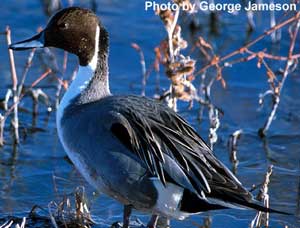
Anas acuta
(Northern Pintail)
Order: Anseriformes
Order Description: Swans, Geese, Ducks
Family: Anatidae
Family Description: Swans, Geese and Ducks
Physical Description:
Size: Male 25-29" (64-74 cm), Female 20.5-22.5" (52-57 cm). The adult male pintail has a brown head and white neck with a conspicuous white stripe that runs up onto the side of the brown of the head. Males also have a long, needle- pointed tail. Body grayish with some black on the wings. Females are mottled brown with a slender neck, bluish bill and somewhat pointed tail.
Similar Species- Female Mallards are heavier with a shorter, thicker neck, blue speculum bordered by white. Female Gadwalls have a white speculum.
Song:
Males give a higher Dreeep-eep. Females a low quacking.
Distribution:
Breeds from Alaskan tundra, through Canada to western and central United States. Winters from eastern and southeastern coastal U.S., Great Lakes, southeastern Alaska, southwestern British Columbia, and western and southwestern U.S., south to Colombia and Venezuela.
Habitat:
Found on lakes, rivers, marshes, and ponds in grasslands, barrens, dry tundra, and open boreal forests. Also found in cultivated fields. During migration and in winter, found in both freshwater and brackish situations. In Idaho, prefers lowland marshes for feeding and nesting, but may winter on small creeks and reservoirs.
Diet:
Eats various plants and animals, depending on availability. Feeds on seeds and nutlets of aquatic plants (sedges, grasses, pondweeds, smartweeds); also eats mollusks, crabs, minnows, worms, fairy shrimp, aquatic insects, and waste grain. Animal foods are important to females during pre-laying and laying periods. Juveniles eat mostly insects.
Ecology:
Dabbles for food; may also feed in fields and on tidal flats. Builds nest on ground. Northern Alaska study found 0.3- 1.5 nests/km2, in various locations. One to 1.8 nests/km2 found in prairie pothole country. Female and brood may move among different ponds during first few weeks after hatching. Species nests commonly in southeaster Idaho, and sparingly in northern Idaho, but is frequent fall and spring migrant known to winter in many parts of state. An Idaho study suggested that avian (Black-billed Magpies) and mammalian predators may significantly affect nest success in some wildlife management areas.
Reproduction:
clutch size varies depending on age of parents (6-10 eggs for adults, 5-7 for yearlings); adults nest earlier than do yearlings. Female incubates eggs; incubation lasts 21-25 days. Male abandons female early in incubation. precocial nestlings are tended by female, with male usually present. Young fledge in about 6-7 wk.
Conservation:
| Element Code: | ABNJB10110 |
| Status: | Game species |
| Global Rank: | G5 |
| State Rank: | S5 |
| National Rank: | N5B,N5N |
Important State References:
Gazda, R.J. 1994. Duck productivity and nest predation in southeastern Idaho. M.S. Thesis, Univ. of Montana, Missoula. 61pp.
Photos by Jeff Spendelow, George Jameson, and C. Trost,© 1999
Design by Ean Harker©1999, 2000.
Written by Jason Karl, 2000.
Anas discors
(Blue-winged Teal)
Link to photo provided by USGS - Patuxent Wildlife Research Center: http://www.mbr-pwrc.usgs.gov/Infocenter/infocenter.html
Order: Anseriformes
Order Description: Swans, Geese, Ducks
Family: Anatidae
Family Description: Swans, Geese and Ducks
Physical Description:
Size: 14.5-16" (37-41 cm). Teal are small-bodied dabbling ducks. Males have a bluish-gray head with a large white crescent before the eye. Body mottled brown above, pinkish with black spots below. Females mottled buff to brown. Both sexes have a large blue patch on the forewing. When on the water, this blue patch can sometimes be seen as a bluish stripe along the side of the body.
Similar Species- Female Blue-winged Teal are almost indistinguishable from female Cinnamon Teal and Green-winged Teal. Female Northern Shovelers have a broader bill and are much larger.
Song:
Call of the male is a high-pitched, single note peep. Females have a high quack.
Distribution:
Breeds from southern Canada, south to southern California, New Mexico, central Texas, Louisiana, and North Carolina. Winters from southern U.S., south to northern South America.
Habitat:
Found on marshes, ponds, sloughs, lakes and sluggish streams. During migration and when not breeding, found in both freshwater and brackish situations (prefers freshwater marshes, ponds, and sloughs, but can also be found in river pools, salt ponds, and estuaries). In Idaho, occupies low- elevation wetlands, but may be seen on higher-elevation lakes during fall migration.
Diet:
Feeds on vegetative parts of aquatic plants (algae, duckweeds, pondweeds, etc.), as well as seeds (sedges, pondweeds, grasses, etc.). Also feeds on large amounts of aquatic invertebrates.
Ecology:
Nests on dry land near water. Usually forms flocks when not breeding. May feed with other dabbling ducks, coots, and shorebirds. Hybridizes occasionally with Cinnamon Teal.
Reproduction:
Female incubates 6-15 eggs (usually 9-11), for 23-27 days. Nestlings are precocial, and tended by female. First flight of young occurs 35-44 days after hatching.
Conservation:
| Element Code: | ABNJB10130 |
| Status: | Game species |
| Global Rank: | G5 |
| State Rank: | S5 |
| National Rank: | N5B,N5N |
Important State References:
No references are available at this time.
Design by Ean Harker©1999, 2000.
Written by Jason Karl, 2000.
Anas cyanoptera
(Cinnamon Teal)
Link to photo provided by USGS - Patuxent Wildlife Research Center: http://www.mbr-pwrc.usgs.gov/Infocenter/infocenter.html
Order: Anseriformes
Order Description: Swans, Geese, Ducks
Family: Anatidae
Family Description: Swans, Geese and Ducks
Physical Description:
Size: 14.5-17" (37-43 cm). Teal are small-bodied dabbling ducks. The male Cinnamon Teal are a deep cinnamon to chestnut color on the head, breast, belly and sides. Wings often streaked with darker brown. Female is mottled buff to brown. Both sexes have a large blue patch on the forewing. At rest, this patch can sometimes be seen as a blue stripe along the body.
Similar Species- Female Cinnamon Teal are almost indistinguishable from female Blue-winged and Green-winged Teal. Female Northern Shovelers are larger with a broad bill.
Song:
Courtship call of the male is a high-pitched rattling. Female, a soft quack.
Distribution:
Breeds from southwestern Canada, eastern Montana, and parts of Great Plains and midwestern states, south to northern Mexico. Winters from southwestern U.S., south to southern Mexico, and rarely or casually to parts of South America.
Habitat:
Found on shallow lake margins, reed beds, ponds, lagoons, sluggish streams, and marshes. Found primarily in freshwater, but occasionally in marine situations in winter. In Idaho, occupies ponds, lakes, and streams at middle and lower elevations.
Diet:
Feeds on aquatic plants in shallow water areas, especially on rush and pondweed seeds and leaves, but also on grass seeds. Will also eat small amounts of animal food, especially insects and mollusks.
Ecology:
Dabbles or dips in shallow water to obtain food, Nests in depression on ground, usually in or near marsh. Before breeding season, usually seen in single pairs; in fall, seen in small family groups. An Idaho study suggested that mammalian and avian predators may significantly be affecting nest success in some wildlife management areas.
Reproduction:
Female incubates 9-12 eggs (sometimes 6-14), for 21-25 days. Nestlings are precocial and downy, and are capable of flight in about 7 wk. Nests are often parasitized by other duck species.
Conservation:
| Element Code: | ABNJB10140 |
| Status: | Game species |
| Global Rank: | G5 |
| State Rank: | S5 |
| National Rank: | N5B,N5N |
Important State References:
Gazda, R.J. 1994. Duck productivity and nest predation in southeastern Idaho. M.S. Thesis, Univerisity of Montana, Missoula. 61pp.
Design by Ean Harker©1999, 2000.
Written by Jason Karl, 2000.
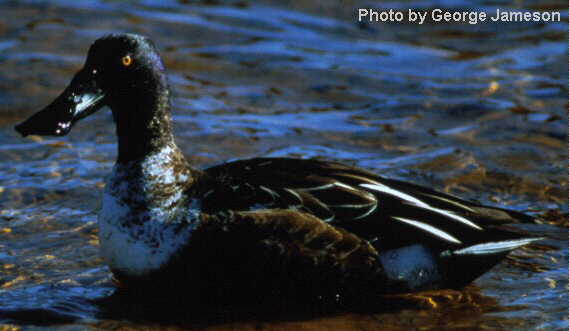
Anas clypeata
(Northern Shoveler)
Order: Anseriformes
Order Description: Swans, Geese, Ducks
Family: Anatidae
Family Description: Swans, Geese and Ducks
Physical Description:
Size: 17-20" (43-51 cm). The Northern Shoveler is actually a large teal. Easily identified by its broad, spoon-shaped bill and relatively short neck. When swimming, it sits low with its bill angled toward the water. Males have a green head, white breast and chestnut sides. Females are mottled buff to brown. Both sexes have a greenish speculum and bluish patch on the forewing.
Similar Species- Male mallards are larger, have chestnut breast with white belly and narrower bill. Female Blue-winged, Green-winged and Cinnamon Teal are smaller with shorter, narrower bills.
Song:
Males give a rattling call while courting: otherwise silent. Females give a low quack.
Distribution:
Breeds from Alaska, east to Manitoba, south to California, New Mexico, and Western Indiana, and locally eastward. Winters from southwestern British Columbia to Arizona, east from there to Gulf Coast, coastal Georgia and South Carolina, and south to northern South America. Rarely winters in northern to north-central or northeastern United States.
Habitat:
Found on shallow, often muddy, freshwater areas with surrounding cover, including ponds, marshes, sloughs, and creeks. During migration and in winter, occupies both freshwater and brackish habitats, and (atypically) cultivated fields. In Idaho, prefers potholes, ponds and marshes at lower elevations.
Diet:
Opportunistic forager. Eats seeds of sedges, bulrushes, sawgrass, pondweeds, smartweeds, algae, duckweed, and others. Will also eat mollusks, aquatic insects, and crustaceans. Manitoba study found males and females ate primarily aquatic invertebrates during pre-laying and laying periods. Aquatic invertebrates (e.g., water boatmen) may dominate winter diet in some areas.
Ecology:
Commonly builds nest at water's edge. Usually dabbles at water surface (in Idaho, known to skim aquatic plants and animals off surface). Usually feeds in pairs or small groups. Large concentrations can be seen at migration staging areas. An Idaho study suggested that avian and mammalian predators may significantly affect nest success in some wildlife management areas.
Reproduction:
Breeding begins late March in southern range, to early June in north. Female incubates 6-14 eggs (usually 10- 12), for 23-25 days. Female tends nestlings, which are precocial and downy, and become independent in about 6-7 wk.
Conservation:
| Element Code: | ABNJB10150 |
| Status: | Game species |
| Global Rank: | G5 |
| State Rank: | S5 |
| National Rank: | N5B,N5N |
Important State References:
Gazda, R.J. 1994. Duck productivity and nest predation in southeastern Idaho. M.S. Thesis, Univ. of Montana, Missoula. 61pp.
Photo by C. Trost, ©1999 and George Jameson, ©2002
Design by Ean Harker©1999, 2000.
Written by Jason Karl, 2000.
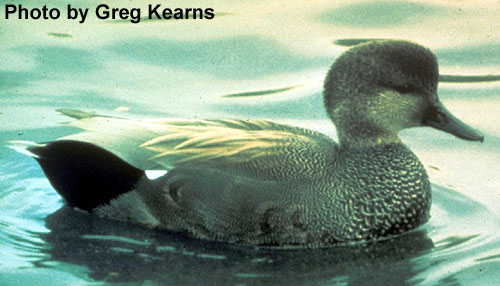
Anas strepera
(Gadwall)
Order: Anseriformes
Order Description: Swans, Geese, Ducks
Family: Anatidae
Family Description: Swans, Geese and Ducks
Physical Description:
Size: 18.5-23" (47-58 cm). A very nondescript dabbling duck. Males grayish brown mottled. Some brown on head and black undertail coverts. Females mottled brown. The key to identification of this species is its white speculum, unique to the Gadwall.
Similar Species- Almost all female ducks look similar to the Gadwall; however, no other duck has a white speculum.
Song:
Male has a series of low rrebb-rrebb notes and various whistles. Females give a soft quack.
Distribution:
Breeds from southern Alaska and southwestern and south-central Canada, south to southern Wisconsin, southern Kansas, northern New Mexico, central California, and locally on parts of East Coast. Winters from southern Alaska to central California, across portions of middle U.S. to central Florida and Gulf Coast, and south into south-central Mexico.
Habitat:
Found on lakes, ponds, rivers, and marshes. Prefers freshwater, but may be found on any open water during migration and winter. Moderate- to large-sized wetlands of permanent or semi-permanent nature, expanses of open water with submerged vegetation, and open, undisturbed shorelines are important molting habitats. In Idaho, occupies marshes, lakes, and reservoirs -- tends to avoid mountainous areas.
Diet:
Feeds on leaves, stems, and tubers of aquatic plants. Also eats algae and seeds of sedges and grasses. Occasionally grazes in pastures and grain fields; may feed on acorns. Eats some small fishes and aquatic invertebrates, which comprise about half spring and summer diet; eats green portions of aquatic plants in non-nesting season. Juveniles initially eat equal amounts of animal and plant food; plant food begins to dominate after 2 wk.
Ecology:
Feeds generally in water 15- 66 cm deep. Builds concealed nest on ground. One study found that few hundred nests/ha are possible on islands lacking mammalian predators. An Idaho study suggested that mammalian and avian predators may significantly affect nest success in some wildlife management areas. Highest breeding densities occur in northern Great Plains and intermountain valleys of western United States. Molting males may form groups of hundreds or thousands in midsummer
Reproduction
Breeding usually begins in mid-April in southern range, early June in north. Female incubates about 9-11 eggs for 4 wk. Female tends young, which fly at 49-63 days. Species breeds later than most other ducks. Relatively high percentage of yearlings do not breed.
Conservation:
| Element Code: | ABNJB10160 |
| Status: | Game species |
| Global Rank: | G5 |
| State Rank: | S5 |
| National Rank: | N5B,N5N |
Important State References:
Gazda, R.J. 1994. Duck productivity and nest predation in southeastern Idaho. M.S. Thesis, Univ. of Montana, Missoula. 61pp.
Photo by Greg Kearns, ©2002.
Design by Ean Harker©1999, 2000.
Written by Jason Karl, 2000.
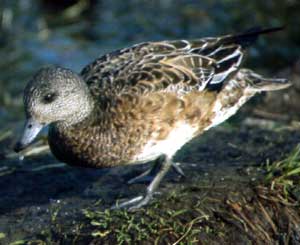
Anas americana
(American Wigeon)
Order: Anseriformes
Order Description: Swans, Geese, Ducks
Family: Anatidae
Family Description: Swans, Geese and Ducks
Physical Description:
Size: 18-23" (46-58 cm). Males have grayish head with green face stripe and white crown and forehead (hence the nickname Baldplate). Body brownish with wings and back either dark brown or black. Belly white. Females mottled brown with some gray on the head. Both sexes have a blue bill tipped with black. Note the white patch on the forewing; visible in flight. speculum green.
Similar Species- The Eurasian Wigeon is an accidental stray to Idaho. It has a chestnut head with buff crown and forehead. Females can resemble Gadwalls. Gadwall has white speculum, not white forewing.
Song:
Males give a three-parted whistle with the second note higher: whee-whee- whee. Females quack.
Distribution:
Breeds mainly from Alaska, east to Manitoba, and south to northeastern California, northern Nevada, northern Colorado, and portions of Great Plains states. Winters mainly from southern Alaska to Mexico, central U.S. to southern Great Lakes and Ohio Valley, and Nova Scotia south coastally to Gulf Coast.
Habitat:
Generally found on large marshes and lakes. When not breeding, occupies both freshwater and brackish areas and forages on marsh edges, sloughs and sheltered bays. In Idaho, usually inhabits low- elevation lakes, marshes and reservoirs, but may be found on higher-elevation waters during fall migration.
Diet:
Feeds on leaves, stems, buds, and some seeds of pondweeds, wigeon grass, grasses, and sedges. May also eat some snails, beetles, and crickets.
Ecology:
Builds concealed nest, not necessarily near water. Forages in shallow water and grazes in fields; may damage cultivated crops. In Idaho, known to graze in fields and forage in flooded fields.
Reproduction:
Breeding begins in early May in southern range, to early June in north. clutch size varies from 6-12 eggs, but is usually 9-11. Female incubates eggs (incubation lasts from 22-24 days) and tends young, which become independent in about 6-7 wk.
Conservation:
| Element Code: | ABNJB10180 |
| Status: | Game species |
| Global Rank: | G5 |
| State Rank: | S5 |
| National Rank: | N5B,N5N |
Important State References:
No references are available at this time.
Photos by Luther Goldman,©2002 and C. Trost,©2000
Design by Ean Harker 1999, 2000.
Written by Jason Karl, 2000.
Aythya valisineria
(Canvasback)
Order: Anseriformes
Order Description: Swans, Geese, Ducks
Family: Anatidae
Family Description: Swans, Geese and Ducks
Physical Description:
Size: 19.5 to 24" (50-61 cm). One of the largest diving ducks. Males have a chestnut-red head and neck. Breast and tail black. Mid body whitish. Female grayish with a brown breast. Bill on both sexes black, long and sloping from the forehead. The shape of the head, more pointed with a shallow sloping forehead, is distinctive to the Canvasback.
Similar Species- Redheads are commonly confused with Canvasbacks. Male Redheads have rounded heads and shorter bills. The chestnut on a Redhead does not extend as far down the neck. Redheads are also not as white as Canvasbacks. Red-breasted and Common Mergansers have a long, thin, orange bills and crested heads.
Song:
Male gives a cooing sound during courting. Female quacks.
Distribution:
Breeds from central Alaska and northwestern Canada, south to northern California, and locally in inland areas to western Nevada, northern Utah, northern Colorado, central New Mexico, and parts of Midwest. Winters along Pacific Coast from Alaska to Baja California, and east through parts of Midwest to Great Lakes; also winters along East Coast from New England to Florida, and west along Gulf Coast to Mexico. Nests primarily in southeastern Idaho.
Habitat:
Found on marshes, ponds, lakes, rivers and bays. Winters on deep, freshwater lakes and rivers as well as on sheltered bays and estuaries. In Idaho, associated with large rivers, lakes and reservoirs.
Diet:
Feeds on aqautic plants such as pondweeds, wild celery, water lilies, seeds of grasses, wild rice, sedges, arrowhead, and bulrushes. Rhizomes, tubers, and seeds figure prominently in winter diet. Will also eat some animal food such as mollusks, aquatic insects, and small fishes.
Ecology:
Dives underwater to obtain food. Builds concealed, cup-shaped nest over water. In some areas, nests are commonly parasitized by Redhead.
Reproduction
clutch size varies from 7-12 eggs (usually 9-10). Female incubates eggs and tends young; incubation lasts 23-29 days. Nestlings are precocial and downy. Young first fly at 10-12 wk. Females are philopatric (returning to same site) to breeding areas.
Conservation:
| Element Code: | ABNJB11020 |
| Status: | Game species |
| Global Rank: | G5 |
| State Rank: | S4 |
| National Rank: | N5B,N5N |
Important State References:
No references are available at this time.
Photos by C. S. Robbins, ©2002 and C. Trost,© 1999
Design by Ean Harker©1999, 2000.
Written by Jason Karl, 2000.
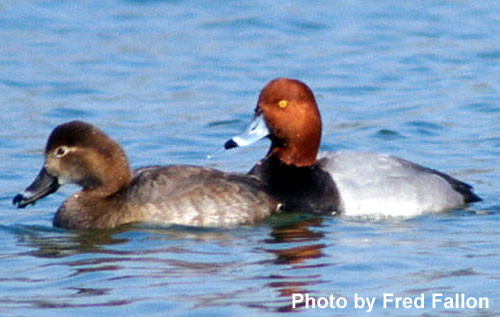
Aythya americana
(Redhead Duck)
Order: Anseriformes
Order Description: Swans, Geese, Ducks
Family: Anatidae
Family Description: Swans, Geese and Ducks
Physical Description:
18-22" (26-56 cm). Cinnamon-red head and eye with black-tipped grayish blue bill. Dark gray to black breast and lighter gray wings, flanks, and back. Black under tail. Females uniformly dark brown with lighter, chestnut head and paler belly; pale eye ring.
Similar Species- Canvasback, female scaups
Song:
Deep, slurred quack: qwar-qwarq-qwar-qwarq.
Distribution:
Breeds locally in Alaska, east from there through parts of Canada to Minnesota, and south to parts of Southwest and Midwest; also breeds sporadically in portions of eastern states. Winters from southern British Columbia south to Nevada, northern Arizona, and parts of Midwest, and on East Coast from New England south to Mexico and Guatemala.
Habitat:
Found on large marshes, lakes, lagoons, rivers and bays. Winters mostly on brackish and marine lagoons and bays, less frequently in inland freshwater situations. In Idaho, prefers marshy ponds, lakes, and potholes, except in winter, when it uses deep, open water.
Diet:
Feeds on leaves and stems of aquatic plants. Eats pondweeds, wigeon grass, algae, and seeds of sedges and grasses. Will eat some insects, mollusks, and small crustaceans. North Dakota study found breeding individuals ate 51-70% invertebrates (mostly chironomids) and 30-49% plant matter; seeds of shallow-marsh emergent plants were important in diet of females during a wet year.
Ecology:
Dives from water surface to obtain food. Builds concealed, cup-shaped nest over shallow water.
Reproduction:
In general, breeding begins in late April in southern range, and early June in inorth. clutch size varies from 10- 16 eggs. Female incubates eggs (incubation lasts 24-28 days) and tends young, which are precocial and downy. Young can fly at 56-73 days. Species often parasitizes other waterfowl nests.
Conservation:
| Element Code: | ABNJB11030 |
| Status: | Game species |
| Global Rank: | G5 |
| State Rank: | S4 |
| National Rank: | N5B,N5N |
Important State References:
No references are available at this time.
Photos by Fred Fallon and C. S. Robbins, ©2002.
Design by Ean Harker©1999, 2000.
Written by Jason Karl, 2000.
Aythya collaris
(Ring-necked Duck)
Link to photo provided by USGS - Patuxent Wildlife Research Center: http://www.mbr-pwrc.usgs.gov/Infocenter/infocenter.html
Order: Anseriformes
Order Description: Swans, Geese, Ducks
Family: Anatidae
Family Description: Swans, Geese and Ducks
Physical Description:
14 1/2-18" (37-46 cm). Black above, including breast, tail, and peaked head with red eyes. White rings at base and near end of a black bill. White below, including flanks. Females dark brown with darker back and black bill with one white ring near end; pale eye ring.
Similar Species- Tufted Duck, female scaups
Song:
Barked qua-qua-qua-qua-qua-qua.
Distribution:
Breeds from southeastern and east-central Alaska and central British Columbia, east through Saskatchewan to Newfoundland, and south to northeastern California, southeastern Arizona, southern Colorado, and parts of the Midwest to New York. Winters from southeastern Alaska and Massachusetts, south through southwestern U.S. and Mexico to Panama.
Habitat:
Found on marshes, lakes, rivers, and swamps, especially in wooded areas. Winters primarily in freshwater and brackish situations on larger lakes, rivers, and estuaries; prefers deep, open water. In Idaho, prefers shallow forested ponds and lakes for breeding, and large rivers and reservoirs during winter.
Diet:
Plant material, such as tubers, leaves, rootstocks, and seeds of aquatic plants, is important part of diet. Also eats aquatic invertebrates, especially in summer. Downy young eat insects, snails, sponges, seeds, and other plant material.
Ecology:
Builds nest in dry spot on ground near water, or sometimes on dry site over water. Dives from water surface to obtain food from as far as 12 m underwater. Most active in early morning and evening; sleeps by day near emergent vegetation by shorelines.
Reproduction:
clutch size varies from 6-14 eggs (usually 8-10). Female incubates eggs (25-29 days), and tends young, which are precocial and downy, and fly about 49 days after hatching.
Conservation:
| Element Code: | ABNJB11040 |
| Status: | Protected nongame species |
| Global Rank: | G5 |
| State Rank: | S3 |
| National Rank: | N5B,N5N |
Important State References:
No references are available at this time.
Design by Ean Harker©1999, 2000.
Written by Jason Karl, 2000.
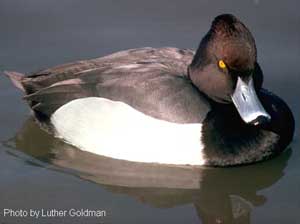
Aythya affinis
(Lesser Scaup)
Order: Anseriformes
Order Description: Swans, Geese, Ducks
Family: Anatidae
Family Description: Swans, Geese and Ducks
Physical Description:
15-18 1/2" (38-47 cm). Dark brown breast, rump, tail, and head with yellow eyes; bluish gray bill with black tip. Gray scaled back; white flanks. Females have brown mottled flanks, brown breast, and white facial patch at base of bill.
Similar Species- Greater Scaup, Ring-necked Duck
Song:
Easily remembered as repeatedly calling: scaup.
Distribution:
Breeds from Alaska and parts of Canada, south to northern Idaho, northern Wyoming, northern North Dakota, and Minnesota, and casually or irregularly to western Washington, northeastern California, southern Idaho, northeastern Colorado, and parts of Midwest. Winters from southern Alaska, east to New England, and south through southern Idaho, Utah, northeastern Colorado, parts of Midwest, and southern U.S., to northern Colombia.
Habitat:
During migration and when not breeding, found along coast in sheltered bays, estuaries, and marshes, or inland on lakes, ponds, and rivers; found on saltwater especially if lakes and ponds are frozen. In southern winter range, prefers freshwater ponds, lakes, and sloughs with reasonably clear water 1 m or more deep.
Diet:
Diet consists of about equal amounts of plant and animal food. Feeds on seeds of pondweeds, wigeon grass, wild rice, sedges, and bulrushes. Also eats crustaceans, mollusks, and aquatic insects.
Ecology:
Feeds mostly in freshwater 1-2 m deep. Builds nest on ground, close to water; occasionally nests over water. In Idaho, prefers marshes for nesting, and open reservoirs and large rivers during migration and in winter.
Reproduction:
Egg-laying begins early May in sourthern range, to mid-June in north. clutch size varies from 6-15 eggs, but is usually 9-12 (older females lay largest clutches). Female incubates eggs (incubation lasts 22-27 days) and tends young. A variable percentage of yearling females do not breed.
Conservation:
| Element Code: | ABNJB11070 |
| Status: | Game species |
| Global Rank: | G5 |
| State Rank: | S4 |
| National Rank: | N5B,N5N |
Important State References:
No references are available at this time.
Photo by Luther Goldman,© 2002
Design by Ean Harker©1999, 2000.
Written by Jason Karl, 2000.
Histrionicus histrionicus
(Harlequin Duck)
Link to phot provided by USGS - Patuxent Wildlife Research Center: http://www.mbr-pwrc.usgs.gov/Infocenter/infocenter.html
Order: Anseriformes
Order Description: Swans, Geese, Ducks
Family: Anatidae
Family Description: Swans, Geese and Ducks
Physical Description:
14 1/2-21" (37-53 cm). Intricate pattern of white, gray, black, and cinnamon. Head has a black stripe from bill to back of neck; two white stripes on either side of black stripe descending to base of bill with a splash; third stripe is cinnamon above a dark gray cheek; cheek has white ear patch and a white vertical stripe on side of neck; gray bill. Gray breast has two vertical white stripes edged with black. Back and wings are gray. Cinnamon flanks. Females are a mixture of gray and brown with white ear patches.
Similar Species- Female Bufflehead
Song:
A toy bugle-like awa-awaa.
Distribution:
Breeds from Alaska and western Canada, south to eastern Oregon, east-central California, Idaho, and Wyoming; also breeds in eastern Canada. Winters from Aleutian and Pribilof islands, south to central California; also winters from Maritime Provinces south to Maryland.
Habitat:
Winters in rough, coastal waters, especially along rocky shores. In Idaho, breeds on forested mountain streams of relatively low gradient free of human disturbance.
Diet:
Feeds primarily on crustaceans, mollusks, insects, and a few small fishes (98% of diet consists of animal food).
Ecology:
In Idaho, hens nest in cliff cavities, tree cavities, and on ground. Breeding pairs show strong fidelity to breeding streams year after year. Preliminary study data indicate some Idaho birds migrate to San Juan Islands, WA, in winter. Birds migrate to Idaho from Pacific Coast in April and females return to coast in August or September with males returning earlier. Entire Idaho population is less than 100 birds on about 30 streams in northern Idaho.
Reproduction:
clutch size varies from 5-10 eggs (usually 6-8). Female incubates eggs (about 27-32 days) and tends young, which are precocial and downy, fly in 5-6 wk, and apparently breed at 2 yr. Idaho study found mean brood size to be 3.4 young/brood.
Conservation:
| Element Code: | ABNJB15010 |
| Status: | Game species |
| Global Rank: | G4 |
| State Rank: | S1 |
| National Rank: | N4B,N4N |
Important State References:
Cassirer, E.F., C.R. Groves, and R.L. Wallen. 1991. Distribution and population status of Harlequin Ducks in Idaho. Wilson Bull. 103:723-725.
Design by Ean Harker©1999, 2000.
Written by Jason Karl, 2000.
Bucephala clangula
(Common Goldeneye)
Link to photo provided by USGS - Patuxent Wildlife Research Center: http://www.mbr-pwrc.usgs.gov/Infocenter/infocenter.html
Order: Anseriformes
Order Description: Swans, Geese, Ducks
Family: Anatidae
Family Description: Swans, Geese and Ducks
Physical Description:
16-20" (41-51 cm). Male has glossy, dark green head with round white patch near base of bill; black back and tail; neck, breast, and sides white; white areas on wings and back visible in flight. Females' plumage is gray with darker gray wings and tail; brown head; bill dark with small pale yellow patch near tip.
Similar Species- Barrow's Goldeneye, female mergansers, male Bufflehead
Song:
Courting call of male is a double nasal quaa-quaak. Wings whistle in flight.
Distribution:
Breeds in Alaska, across parts of Canada, and south to northern Washington, central Montana, and across northern U.S. to Maine. Winters from southeastern Alaska to southern California, from Great Lakes to Gulf Coast, and from Newfoundland to Florida.
Habitat:
Found on ponds, lakes, rivers, and coastal bays, wintering primarily on bays and estuaries, less commonly on rivers and lakes. In Idaho, normally associated with water bodies near forests; prefers deep, open waters of large rivers, lakes, and reservoirs.
Diet:
In inland areas during summer and fall, feeds on aquatic insects, crustaceans, and aquatic plants. Along coastal wintering grounds, feeds largely on crustaceans, mollusks, small fishes, and some plant material.
Ecology:
Builds nest in tree cavity near water. Dives under water to obtain food.
Reproduction:
Breeding begins early May in southern range, to June in north. clutch size varies from 5-19 eggs (usually 8-12). Female incubates eggs and tends young; incubation lasts 28-32 days. Nestlings are precocial and downy, and fly at 51-60 days.
Conservation:
| Element Code: | ABNJB18010 |
| Status: | Game species |
| Global Rank: | G5 |
| State Rank: | S3 |
| National Rank: | N5B,N5N |
Important State References:
No references are available at this time.
Design by Ean Harker©1999, 2000.
Written by Jason Karl, 2000.
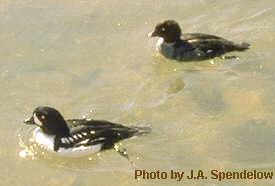
Bucephala islandica
(Barrow's Goldeneye)
Order: Anseriformes
Order Description: Swans, Geese, Ducks
Family: Anatidae
Family Description: Swans, Geese and Ducks
Physical Description:
16 1/2-20" (42-51 cm). White crescent in front of eye on a glossy purple-black head; low, abrupt forehead sloping down to a black bill; back and sides black; neck and breast white; wings black with a line of white patches. Female has a brown head, grayish body and wings, white collar, and yellow bill with a dark tip.
Similar Species- Common Goldeneye
Song:
Rapid whinny produced by wings in flight.
Distribution:
Breeds from southeastern Alaska, east through parts of western Canada, and south to eastern Washington, southwestern Oregon, eastern California, northern Montana, and northwestern Wyoming. Also breeds in eastern Canada. Winters from southern Alaska, south along coast to central California, and locally from southern British Columbia and northern Montana, south to southwestern Arizona, Utah and Colorado. Also winters along East Coast.
Habitat:
Winters on lakes, rivers, estuaries, and bays. Frequently winters along Snake River in southern Idaho. In central Idaho, prefers mountain lakes for breeding.
Diet:
In inland areas during summer and fall, feeds on aquatic insects, crustaceans and aquatic plants. Along coastal wintering grounds, feeds largely on crustaceans, mollusks, small fishes, and some plant material.
Ecology:
Nests in tree cavity near water; may nest on cliff. Intraspecific nest parasitism is common. Dives underwater to obtain food. Usually found in small, scattered groups in summer; found in large flocks in winter. Uncommon breeder in Idaho.
Reproduction:
clutch size varies from 6-15 eggs (usually 10-13). Female incubates eggs; incubation lasts about 30 days. In British Columbia, mean hatching date is mid- to late June. Nestlings are precocial and downy. Adult pair bond may last more than 1 yr.
Conservation:
| Element Code: | ABNJB18020 |
| Status: | Game species |
| Global Rank: | G5 |
| State Rank: | S3 |
| National Rank: | N5B,N5N |
Important State References:
Schultz, G.A. 1978. Barrow's Goldeneyes nesting in central Idaho. Murrelet 59:107- 108.
Original images provided by Jeff Spendelow,© 1999
Design by Ean Harker©1999, 2000.
Written by Jason Karl, 2000.
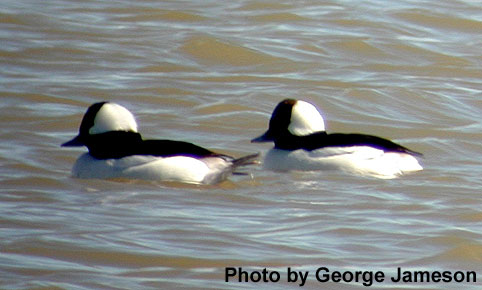
Bucephala albeola
(Bufflehead)
Order: Anseriformes
Order Description: Swans, Geese, Ducks
Family: Anatidae
Family Description: Swans, Geese and Ducks
Physical Description:
13-15 1/2" (33-39 cm). Black above and white below with a gray bill. White patch from behind eye to back of head; white wing patches visible in flight. Females brown above and gray below; whitish breast and elongated white patch on face.
Similar Species- Male Hooded Merganser, male goldeneyes, female Harlequin Duck
Song:
Hoarse, crow-like qua-qua.
Distribution:
Breeds from central Alaska and parts of western Canada, south to northern Washington, and east to northern Montana; also breeds (locally) south to mountains of Oregon and northern California. Winters from Alaska, Great Lakes, and Maritime Provinces, south to Mexico and Gulf Coast.
Habitat:
Found on lakes, ponds, rivers, and seacoasts. Winters on sheltered bays and estuaries. In Idaho, occupies ponds, lakes, rivers, and reservoirs; winters on larger bodies of open water.
Diet:
In freshwater, feeds on aquatic insects, snails, amphipods, small fishes, and some aquatic plants. In saltwater, eats crustaceans, mollusks, fishes, and some aquatic plants.
Ecology:
Dives underwater to obtain food. Nests in tree near water, either in natural cavity or in cavity made by flicker or woodpecker. Will also nest in burrow in bank. Female strongly defends brood territory. British Columbia study found that breeding density was not limited by nest sites, but rather by territorial behavior. Usually seen in small groups (2-3 individuals). Usually migrates at night. Breeds uncommonly on mountain lakes in Idaho.
Reproduction:
Breeding begins mid- May in southern range, to early June in north. clutch size varies from 6-11 eggs (usually 7-9). Incubation lasts 28-33 days; female incubates eggs and tends young, which fly 50-55 days after hatching and breed at 2 yr.
Conservation:
| Element Code: | ABNJB18030 |
| Status: | Game species |
| Global Rank: | G5 |
| State Rank: | S3 |
| National Rank: | N5B,N5N |
Important State References:
No references are available at this time.
Photos by C. Trost,© 1998 and George Jameson, ©2002
Design by Ean Harker©1999, 2000.
Written by Jason Karl, 2000.
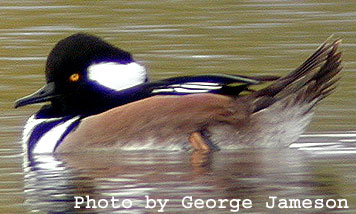
Lophodytes cucullatus
(Hooded Merganser)
Order: Anseriformes
Order Description: Swans, Geese, Ducks
Family: Anatidae
Family Description: Swans, Geese and Ducks
Physical Description:
16-19" (40-48 cm). Male has black head with contrasting white crest with black hind border; yellow eyes. Shiny black back; white breast with two broad black lines; cinnamon-colored flanks and belly; bill dark and thin. Female is chestnut brown with darker wings and a lighter belly; rust-colored crest.
Similar Species- Male Bufflehead
Song:
Courting male gives a frog-like croak.
Distribution:
Breeds from southeastern Alaska and southwestern Canada, south to southwestern Oregon, eastern Idaho, and northwestern Montana. Also breeds in eastern U.S. and eastern Canada. Winters along Pacific, Atlantic, and Gulf slopes.
Habitat:
Found on streams, lakes, swamps, marshes, and estuaries. Winters mostly in freshwater, but can also be found on estuaries and sheltered bays. In Idaho, prefers wooded streams and flooded bottomlands during summer, and open bodies of water in winter.
Diet:
Eats mostly small fishes, crayfishes, and other crustaceans, but may also eat aquatic insects.
Ecology:
Dives underwater to obtain food. Nests in cavity in tree. Limited breeding occurs in northern Idaho and along Snake River in southeast. Usually seen during fall and spring migration and in winter. Similar to Wood Duck in habitat use.
Reproduction:
Female incubates 6-18 eggs for 29-37 days. In some areas, nests may include eggs of Wood Duck or Goldeneye. Young first fly at about 10 wk, and first breed at abou 2 yr.
Conservation:
| Element Code: | ABNJB20010 |
| Status: | Game species |
| Global Rank: | G5 |
| State Rank: | S2 |
| National Rank: | N5B,N5N |
Important State References:
No references are available at this time.
Photo by George Jameson, ©2002
Design by Ean Harker©1999, 2000.
Written by Jason Karl, 2000.
Mergus merganser
(Common Merganser)
Order: Anseriformes
Order Description: Swans, Geese, Ducks
Family: Anatidae
Family Description: Swans, Geese and Ducks
Physical Description:
22-27" (56-69 cm). Male has glossy green-black head with a orange-red bill; black back and wings; white below. White is visible on sides and inner wings in flight. Females have brownish-red head with crest and gray back and wings.
Similar Species- Male Red-breasted Merganser
Song:
Repeated croaking sounds.
Distribution:
Breeds from Alaska and Canada, south to central California, Arizona, and Mexico. Also breeds in northeastern U.S. and eastern Canada. Winters from Alaska and southern Canada, south to Mexico and Florida.
Habitat:
Found mostly on lakes and rivers; winters primarily on open lakes and rivers and brackish lagoons, rarely in marine coastal situations. In Idaho, breeds on forest watercourses, and winters on Snake River and larger reservoirs in southern part of state.
Diet:
Eats mainly fishes, but will also eat amphibians, crustaceans, mollusks, and other invertebrates. Young initially feed on insects caught underwater.
Ecology:
Dives under water surface to obtain food. Usually nests in cavity in tree, but will occasionally nest on ground, around shrubs or under rocks.
Reproduction:
Female incubates 6-17 eggs (usually 9-12), for 28-32 days. Young first fly at 60-70 days, and breed at end of second year.
Conservation:
| Element Code: | ABNJB21010 |
| Status: | Game species |
| Global Rank: | G5 |
| State Rank: | S5 |
| National Rank: | N5B,N5N |
Important State References:
No references are available at this time.
Photo by Greg Kearns, ©2002.
Design by Ean Harker©1999, 2000.
Written by Jason Karl, 2000.
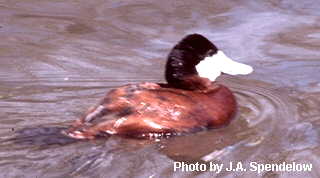
Oxyura jamaicensis
(Ruddy Duck)
Order: Anseriformes
Order Description: Swans, Geese, Ducks
Family: Anatidae
Family Description: Swans, Geese and Ducks
Physical Description:
14 1/2-16" (37-41 cm). Males have a large blue bill on a black and white head; body is chestnut with a white belly. Females are drab brown with large brown bill and a darkish cap. Both have long tails.
Similar Species- Pied-billed Grebe
Song:
A sputtering pwip-pwip-pwip-pwip-pwip-p-p-p.
Distribution:
Breeds from Alaska (casually) and parts of Canada, south to southern California, central Arizona, southern New Mexico, western and southern Texas, and southwestern Louisiana. Scattered, sporadic, or former breeding located in several other areas in U.S., Canada, and Mexico. Winters from southern British Columbia, Idaho, Colorado, Kansas, Great Lakes, and Atlantic Coast, south throughout southern U.S., most of Mexico, and South America.
Habitat:
Found on marshes, lakes and coastal areas. When not breeding, found on sheltered, brackish and marine coastal areas, as well as on lakes and rivers.
Diet:
Diet varies with age, season, and site. Eats pondweeds, algae, wild celery, seeds of sedges, smartweeds, grasses, insects and their larvae, and shellfish and crustaceans.
Ecology:
Dives under water surface to obtain food. Basically diurnal, but appears to migrate mostly at night. Nests over or close to water (preferably shallow water with emergent vegetation).
Reproduction:
Female incubates 6-10 eggs (sometimes 5-17), for about 23 days. Male often accompanies female and brood. Often parasitizes Redhead and Canvasback nests.
Conservation:
| Element Code: | ABNJB22010 |
| Status: | Game species |
| Global Rank: | G5 |
| State Rank: | S5 |
| National Rank: | N5B,N5N |
Important State References:
No references are available at this time.
Original images provided by Jeff Spendelow,© 1999
Design by Ean Harker©1999, 2000.
Written by Jason Karl, 2000.
Aquila chrysaetos
(Golden Eagle)
Link to photo provided by USGS - Patuxent Wildlife Research Center: http://www.mbr-pwrc.usgs.gov/Infocenter/infocenter.html
Order: Falconiformes
Order Description: Vultures, Osprey, Hawks, Falcons
Family: Accipitridae
Family Description: Osprey, Hawks and Eagles
Physical Description:
30-41" (75-104 cm). Dark eagle with golden accents on back of neck that occasionally continue around the face onto the breast. White band on upper tail feathers; white flash in wings at base of the primaries. Yellow feet; gray bill. Immatures have white on tail that ends with a dark bar. Immatures have a distinct white patch at the base of the primaries underneath, and a white base to the tail.
Similar Species- Immature Bald Eagles, Black Vulture, black morph of Rough-legged Hawk
Song:
A yelped kyarp-- kyarp-kyarp.
Distribution:
Breeds from Alaska, east through Northwest Territories to Labrador, and south to northern Mexico, central Texas, western Oklahoma, and western Kansas. Also breeds rarely in eastern U.S. to New England. Winters from south-central Alaska and southern Canada, south through breeding range.
Habitat:
Found on prairies, tundra, open wooded country, and barren areas, especially in hilly or mountainous regions. In Idaho, prefers open and semi-open areas in both deserts and mountains.
Diet:
Feeds mainly on small mammals, but may also eat insects, snakes, birds, juvenile ungulates, and carrion. Jack rabbits are principal prey in southern Idaho, and this preference is unaffected by changes in prey density.
Ecology:
Builds stick nest on cliff or in tree. Commonly forages in early morning and early evening. Idaho study indicated males capture more food during brood rearing, while females spend more time feeding offspring. Territory size averaged 3276 ha. Positive correlation between breeding success and jackrabbit numbers reported in Idaho, Colorado, and Utah. Species resides in Idaho year-round, although recent studies have revealed some winter birds are breeders from Alaska and Northwest Territories.
Reproduction:
Egg-laying occurs from February-May, depending on range (late February to early March in Utah). Female (usually) incubates 1-3 eggs (rarely 4, usually 2) for about 43-45 days. In southwestern Idaho, numbers fledged/pair has ranged from .39-1.36 over last 20 yr. Young can fly at 60-77 days (longer in far north than in south) and are cared for by parents for 30+ additional days (family unit will sometimes remain together several months). Breeding typically takes place in fourth or fifth year. Lifelong monogamy may be the rule, though some apparent exceptions have been recorded.
Conservation:
| Element Code: | ABNKC22010 |
| Status: | Protected nongame species |
| Global Rank: | G5 |
| State Rank: | S5 |
| National Rank: | N5B,N5N |
Important State References:
Collopy, M.S. 1984. Parental care and feeding ecology of golden eagle nestlings. Auk 101:753-760.
Design by Ean Harker©1999, 2000.
Written by Jason Karl, 2000.

Haliaeetus leucocephalus
(Bald Eagle)
Order: Falconiformes
Order Description: Vultures, Osprey, Hawks, Falcons
Family: Accipitridae
Family Description: Osprey, Hawks and Eagles
Physical Description:
30-43" (76-109 cm). Distinct white head and neck with a yellow bill. White tail, but otherwise dark brown to black; yellow feet and eyes, which adults take up to 4 years to achieve. The juveniles are dark brown with blotchy white patches under wings and tail, and with huge bill.
Similar Species- Golden Eagle
Song:
Fairly soft pwip-pwip and a faster chitter.
Distribution:
Breeds from central Alaska, east to northern Saskatchewan, Labrador, and Newfoundland, and south, locally, to northern Mexico, New Mexico, Arizona, Texas Gulf Coast, and Florida;very local breeder in interior North America. Winters generally throughout breeding range except in far north.
Habitat:
Found primarily near seacoasts, rivers, and reservoirs and lakes.
Diet:
Catches fish (or steals from osprey); also eats various mammals and carrion. Idaho diet includes fish, big game carrion, waterfowl, and jackrabbits.
Ecology
Forages from high altitudes; often forages from perch. Builds stick nest in fork of tall tree, or occasionally on cliff. In winter, adults often roost communally at night, in trees used in successive years. In winter in some areas, adults preferentially roost in conifers, or other sheltered sites, and may associate with waterfowl concentrations, or congregate in areas with abundant dead fish (in Idaho, individuals congregate in numbers on watercourses in northern, eastern, and southwestern parts of state). Montana study determined introduction of shrimp (Mysis relicta) had cascading effect through food chain, ultimately causing displacement of Bald Eagles. North-central Arizona study found February-April home ranges of immatures averaged 400 km2; birds moved frequently and roosted singly or in small groups. Home ranges of Bald Eagles nesting along Cascade Reservoir in west-central Idaho have ranged from 15-60 km2 during breeding season, and have typically been half that size at other times (management recommendations suggest 400 m buffer zone around nest sites to protect key habitat features such as nests, perch trees and food resources). From 1979- 1995, Idaho's nesting Bald Eagle population increased from 11 to 77 occupied territories. In 1995, 51 pairs from occupied territories successfully fledged an average of 1.2 young/pr.
Reproduction:
Both sexes incubate 1- 3 eggs (usually 2) for about 5 wk. Second-hatched young sometimes dies. Young first fly at 10-12.5 wk, remain around nest for several more weeks, and generally do not breed until about 5-6 yr. Adults may not lay every year.
Conservation:
| Element Code: | ABNKC10010 |
| U.S. ESA Status: | LTNL |
| Status: | Protected nongame species |
| Global Rank: | G4 |
| State Rank: | S3 |
| National Rank: | N4B,N4N |
Important State References:
Beals, J., and W. Melquist. 1995. Idaho bald eagle nesting report, 1995. Idaho Dept. Fish & Game, Boise. 23pp.
Photos by P.S. Weber, ©2002 and from © Corel Corporation, 1993 - Corel Professional Photo Series # 94000, Yellowstone National Park, #94099.
Design by Ean Harker©1999, 2000.
Written by Jason Karl, 2000.
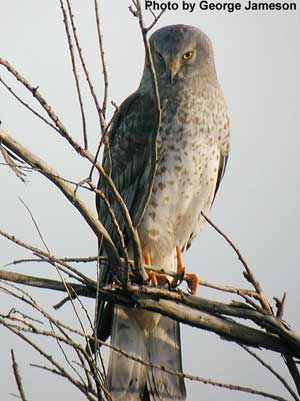
Circus cyaneus
(Northern Harrier)
Order: Falconiformes
Order Description: Vultures, Osprey, Hawks, Falcons
Family: Accipitridae
Family Description: Osprey, Hawks and Eagles
Physical Description:
18-22" (46-55 cm). Male: Gray above, white below. Black wing tips; white rump; brown spotting below; light edging on feathers above. Female: Brown above, buff below; heavy dark barring on breast; streaking on head and face. Long tail on both sexes.
Similar Species- Turkey Vulture; which also has a dihedral to its wings ("V"-shaped in flight). Swainson's Hawk; which has more pointed wings and a dihedral in their soar.
Song:
Nasal, "baby toy" squeak.
Distribution:
Breeds from Alaska, east to Quebec, and south to Baja California, southern Texas, southern Missouri, West Virginia, and southeastern Virginia. Winters from southern Canada to northern South America.
Habitat:
Found on marshes, meadows, grasslands, and cultivated fields. In Idaho, associated with deserts, marshes and irrigated agriculture; avoids forested areas.
Diet:
Eats small mammals (especially voles and cotton rats), small and medium-size birds (especially passerines), and some reptiles, amphibians, large insects, and carrion.
Ecology:
Nests on ground. Perches on ground, or on stumps or posts. Hunts mostly in early morning and late afternoon in some areas, but may hunt throughout day. Usually flies low when hunting; captures prey on ground. In winter, throughout range, individuals may aggregate in communal roosts in areas of high prey density, and may hunt in same area for several consecutive days. Roosts in winter in undisturbed fields or marshes. In southwestern Idaho study, male and female home ranges were 15.7 km2 and 1.13 km2, respectively. Males hunted up to 9.5 km from nests for voles and whiptail lizards.
Reproduction:
clutch size usually varies from 3-6 eggs. Female incubates eggs for about 30-32 days; male brings food. Young fly at about 30-35 days, and usually breed at 2+ yr. Some males are polygynous. Number of breeders and clutch size may increase when prey is abundant.
Conservation:
| Element Code: | ABNKC11010 |
| Status: | Protected nongame species |
| Global Rank: | G5 |
| State Rank: | S5,NTMB |
| National Rank: | N5B,N5N |
Important State References:
Martin, J.W. 1987. Behavior and habitat use of breeding Northern Harriers in southwestern Idaho. J. Raptor Res. 21:57-66.
Photo by George Jameson, ©2002 and Jeff Spendelow,© 1999
Design by Ean Harker©1999, 2000.
Written by Jason Karl, 2000.

Accipiter striatus
(Sharp-shinned Hawk)
Order: Falconiformes
Order Description: Vultures, Osprey, Hawks, Falcons
Family: Accipitridae
Family Description: Osprey, Hawks and Eagles
Physical Description:
10-14" (25-36 cm). Notice the square, not round, tail; often notched. Adults are slate blue above, white below with rich rusty cross-barring. Undertail coverts white. Eyes red. The juveniles are brown on the back, with a few white spots, the breast is white and streaked with brown, and the eyes are yellow.
Similar Species- Cooper's Hawk, Northern Goshawk
Song:
A shrill alarm call; females have a lower pitched call than males.
Distribution:
Breeds from Alaska, east to Saskatchewan, Labrador, and Newfoundland, and south to South America. Winters (casually) north to southern Alaska and southern Canada, and south to Panama.
Habitat:
Found in forests and open woodlands (coniferous, mixed, or deciduous, but primarily coniferous in more northern and mountainous portions of range). Migrates through various habitats, mainly along ridges, lakeshores, and coastlines.
Diet:
Eats mainly small- to medium-size birds, but will occasionally eat small mammals, insects, and lizards.
Ecology:
Builds stick nest in coniferous or deciduous tree. Oregon study found average distance between nests was 4.3 km. Captures prey in mid-air, or takes prey from its perch. Species is extensive migrant in fall in Idaho, occupying urban areas with abundant prey (primarily House Sparrows). Individual members are occasionally killed by larger raptors; species has suffered from pesticide contamination.
Reproduction
Female incubates 4-5 eggs for 30-32 days (34-35 days has also been reported); male brings food. Young fledge at 3-4.5 wk, are independent at about 7 wk, and first breed at 2 yr (sometimes as yearlings).
Conservation:
| Element Code: | ABNKC12020 |
| Status: | Protected nongame species |
| Global Rank: | G5 |
| State Rank: | S5 |
| National Rank: | N5B,N5N |
Important State References:
No references are available at this time.
Original images provided by Jeff Spendelow,,© 1999
Design by Ean Harker©1999, 2000.
Written by Jason Karl, 2000.
Accipiter cooperii
(Cooper's Hawk)
Link to photo provided by USGS - Patuxent Wildlife Research Center: http://www.mbr-pwrc.usgs.gov/Infocenter/infocenter.html
Order: Falconiformes
Order Description: Vultures, Osprey, Hawks, Falcons
Family: Accipitridae
Family Description: Osprey, Hawks and Eagles
Physical Description:
14-20" (36-51 cm). Notice the rounded, not square, tail. Adult males are slate blue above, rusty barred below. Adult females are larger and brownish-blue above. Both have a darker cap, white undertail coverts, and red eyes. Juveniles are brown backed with a white breast and brown streaks on it. The eyes are yellow.
Similar Species- Sharp-shinned, and Cooper's Hawks, Northern Goshawk
Song:
Woodpecker-like kak-kak-kak-kak.
Distribution:
Breeds from southern British Columbia, east to central Saskatchewan and Nova Scotia, and south to northern Mexico and southeastern United States. Winters from Washington, Colorado, southern Minnesota, southern Ontario, and New England, south to Middle America.
Habitat:
Primarily found in mature forests (either deciduous or coniferous, but mostly the former); also found in open woodlands and forest edges. Migrates mostly along ridges and coastlines. In Idaho, nests in coniferous and deciduous forests (especially along riparian corridors), and occupies edges and more open habitat when not breeding.
Diet:
Eats mainly medium- size birds such as starlings, thrushes, and quail. Will also eat some birds up to size of adult Ruffed Grouse, small birds, small mammals, reptiles, and amphibians.
Ecology:
Secretive. Typically hunts from inconspicuous perch. Sometimes attracted to birds at feeders. Builds stick nest in coniferous or deciduous tree. In various areas, nesting density has been measured at 1 nest/730-2300 ha; nests are usually not closer than 1 km apart. Individuals maintain small territory centered on nest site. Annual mortality has been measured at about 80% in immatures, and 34% in adults. Idaho population is partially migratory -- pushed into lower elevations and into southern Idaho during winter.
Reproduction:
Female incubates 4-5 eggs for about 5 wk; male brings food. Young leave nest at 4-5 wk, return to nest for food for about 10 days, become independent at about 8 wk, and first breed at 2 yr (occasionally at 1 yr.)
Conservation:
| Element Code: | ABNKC12040 |
| Status: | Protected nongame species |
| Global Rank: | G4 |
| State Rank: | S4,NTMB |
| National Rank: | N5B,N5N |
Important State References:
No references are available at this time
Design by Ean Harker©1999, 2000.
Written by Jason Karl, 2000.
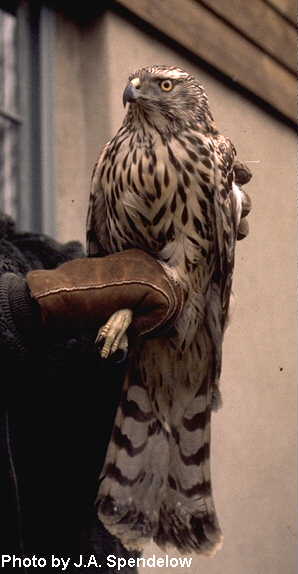
Accipiter gentilis
(Northern Goshawk)
Order: Falconiformes
Order Description: Vultures, Osprey, Hawks, Falcons
Family: Accipitridae
Family Description: Osprey, Hawks and Eagles
Physical Description:
20-26" (50-66 cm). Gray all over; lighter below with fine black streaks on breast. White tips on longish tail; lighter eyebrows. Red eyes and yellow-orange feet. Immatures brown above, paler below with heavy brown streaks; yellow eyes and feet; tail has wavy blackish and gray bands. Juveniles have a white eyeline.
Similar Species- Cooper's, and Sharp-shinned hawks, Gyrfalcon
Song:
Seagull-like kak-kak-kak-kak.
Distribution:
Breeds from western and central Alaska, east to northeastern Manitoba, Labrador, and Newfoundland, and south to central California, southeastern Arizona, eastern foothills of Rockies, southern Manitoba, New England, and Appalachians; breeds locally in Mexico. Winters throughout breeding range and irregularly south to northern Mexico.
Habitat:
Found in deciduous and coniferous forests, along forest edges, and in open woodlands. Will forage in cultivated regions. Migrates mostly along ridges and coastlines. In Idaho, summers and nests in coniferous and aspen forests; winters in riparian and agricultural areas.
Diet:
Eats mainly rabbits, squirrels, ducks, and upland game birds; local diet depends partly on availability.
Ecology:
Builds stick nest in coniferous or deciduous tree. Nests are usually 2 km or more apart, but may be as close as 0.8 km. Tends to hunt low in forest canopy; most hunting is conducted from perch. From 1980-1990, 34 goshawk territories were identified on Targhee National Forest. Nests were in dense stands of old-growth coniferous timber with high canopy cover. Timber harvest activities may be negatively affecting occupancy rates of goshawks.
Reproduction:
Female incubates 2-4 eggs for 32-34 days/egg; male provides food. Young leave nest at 5-6 wk, begin hunting at about 50 days, and become independent at about 70 days. Some individuals breed as yearlings.
Conservation:
| Element Code: | ABNKC12060 |
| Status: | Protected nongame species |
| Global Rank: | G5 |
| State Rank: | S4 |
| National Rank: | N4B,N4N |
Important State References:
Patla, S. 1991. Northern Goshawk monitoring project report #2. USDA Targhee National Forest, St. Anthony. 42 pp.
Original images provided by Jeff Spendelow,© 1999
Design by Ean Harker©1999, 2000.
Written by Jason Karl, 2000.
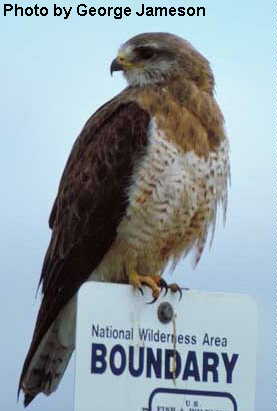
Buteo swainsoni
(Swainson's Hawk)
Order: Falconiformes
Order Description: Vultures, Osprey, Hawks, Falcons
Family: Accipitridae
Family Description: Osprey, Hawks and Eagles
Physical Description:
19-22" (48-56 cm). Dark brown above with reddish hood, white throat and body accentuated by a dark bib-like band across breast. Darker gray flight feathers highlight buffy wing linings. Indistinctly striped tail gray above often becoming white at the base, light below with dark border. They are frequently found in dark morphs, which don't have the white breast and belly. Also, the leading edge of the wings in both morphs is usually white, in contrast to that of Red-tails.
Similar Species- Red-tailed, Rough-legged, and Ferruginous hawks
Song:
Shrill, monotone skreeeeee, also a shorter descending scream that trails off at the end.
Distribution:
Breeds in portions of Alaska and western Canada, east to Minnesota and Illinois, and south to southern California, parts of Mexico, Texas, and Missouri; eastern breeding limits are unstable, Winters from southwestern U.S. and southeastern Florida (irregularly), south to South America.
Habitat:
Found in open pine/oak woodlands, and in cultivated land with scattered trees (e.g., alfalfa and other hay crops, and certain grain and row crops, but not vineyards, orchards, rice, or corn). During migration and in winter, also found in grasslands and other open country. In Idaho, prefers to nest in trees or shrubs near riparian zones adjacent to agricultural lands.
Diet:
Vertebrates (mainly mammals such as young ground squirrels and pocket gophers) dominate diet during breeding season; invertebrates (especially crickets and grasshoppers) are common food at other times. Depending on availability, individuals also eat snakes, lizards, birds, amphibians, and some carrion. Concentrations of Swainson's Hawks foraging on grasshoppers have been documented in Idaho.
Ecology:
Hunts while soaring or from perch. Builds stick nest in tree, or occasionally on cliff. nesting density in suitable habitat varies from 0.1-1.6 nests/10 km2; nests average 1.4-2.4 km apart. May form pre- migratory aggregations in summer and migrate in immense flocks. Migrants may roost at night on ground in very large fields, and go without feeding during most of migration (with occasional feeding during initial and terminal stages). In Idaho, species is highly migratory (present between April and September and winters in Argentina). A 1985 survey in southern Idaho located 109 occupied nests and indicated that Swainson's Hawks were still a widespread common nester in state.
Reproduction:
Female incubates 2-3 eggs for 34-35 days/egg (laid April-May in Oregon, mainly May-June in Canada). Both adults tend young (Idaho study reported 1.17 young/nest). Young leave nest in about 30 days, fly at 42-44 days, depend on parents for 4-4.5 wk after fledging, and first breed at 2 yrs.
Conservation:
| Element Code: | ABNKC19070 |
| Status: | Protected nongame species |
| Global Rank: | G4 |
| State Rank: | S4,NTMB |
| National Rank: | N5B |
Important State References:
Bechard, M.J., K.D. Hague-Bechard, and D.H. Porter. 1986. Historical and current distributions of Swainson's and Ferruginous Hawks in southern Idaho. Dept. Biology, Boise St. Univ., Boise. 58pp.
Photos by George Jameson, ©2002 and C. Trost, ©1999.
Design by Ean Harker©1999, 2000.
Written by Jason Karl, 2000.
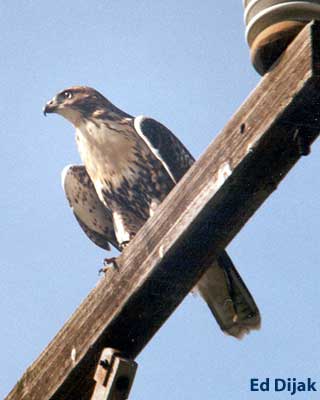
Buteo jamaicensis
(Red-tailed Hawk)
Order: Falconiformes
Order Description: Vultures, Osprey, Hawks, Falcons
Family: Accipitridae
Family Description: Osprey, Hawks and Eagles
Physical Description:
19-25" (48-64 cm). Dark brown above; lighter below with dark band of streaks across the belly. Red on tail as name suggests; lighter rump.
Similar Species- Swainson's, Rough-legged, Ferruginous, and Red-shouldered hawks.
Song:
A down-slurred scream: keeeer.
Distribution:
Breeds from parts of Alaska and parts of western and southern Canada, south to Baja California, northern Mexico, southern Texas, Gulf coast, and Florida, and south from there through highlands of Middle America to Coasta Rica and western Panama. Winters from southern Canada, south through remainder of breeding range, and in lowlands of Central America.
Habitat:
Found in various settings from open woodlands and forests to desert and agricultural lands.
Diet:
Opportunistic. Commonly eats rodents, birds, and reptiles, but will also eat other vertebrates and invertebrates as available. In Idaho, diet often includes ground squirrels, gophers, rabbits, mice, small birds, and reptiles. In Idaho studies, prey selection depended on relative prey densities and diet.
Ecology:
Builds stick nest in cliff, tree, or on artificial structure. Breeding density (pairs/km2) varies from 0.03 (Utah) to 0.78 (California), but is mostly less than 0.25. Elevated perches are important element of habitat. Home range found to be 13 km2 in Idaho study; composition of sympatric Red-tail and Ferruginous hawks was not affected by interspecific competition. Species is most common hawk in Idaho.
Reproduction:
Female incubates 5 eggs for about 34 days per egg. Both parents tend young, which leave nest at about 4 wk, fly at about 6.5-7 wk, and depend on parents for food for few weeks after fledging (Idaho study found 2.9 young/successful pair were produced). If clutch is lost, adult pair will renest (usually in another nest) a few weeks later. Successful reproduction usually does not occur before 2 yr. Pair bond is typically lifelong, at least in non-migratory populations, and probably in migrants as well.
Conservation:
| Element Code: | ABNKC19110 |
| Status: | Protected nongame species |
| Global Rank: | G5 |
| State Rank: | S5,NTMB |
| National Rank: | N5B,N5N |
Important State References:
Steenhof, K. and M.N. Kochert. 1988. Dietary responses of three raptor species to changing prey densities in a natural environment. J. Animal Ecol. 57:37-48.
Photos by Ed Dijak and George Jameson, ©2002
Design by Ean Harker©1999, 2000.
Written by Jason Karl, 2000.
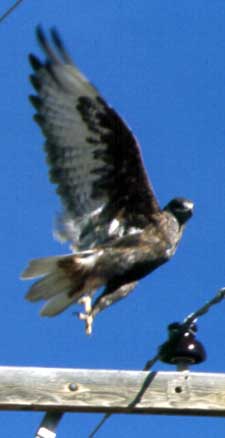
Buteo regalis
(Ferruginous Hawk)
Order: Falconiformes
Order Description: Vultures, Osprey, Hawks, Falcons
Family: Accipitridae
Family Description: Osprey, Hawks and Eagles
Physical Description:
22 1/2-25" (57-64 cm). Typical adults white below except for finely barred rufous legs, feathered to toes; upperparts reddish-brown with white patch at base of primaries (visible in flight); tail whitish or pale rufous, turning rusty toward tip; wing linings with some reddish mottling and dark wrist. Head often quite pale. Immatures have light thighs and lack rusty patches on wings; white rump and gray tail.
Similar Species- Red-tailed Hawk, Rough- legged Hawk, Swainson's Hawk
Song:
High pitched squeal, similar to, but shorter than the Red-tailed Hawk's.
Distribution:
Breeds from eastern Washington, southern Alberta, southern Saskatchewan, and southwestern Manitoba, south to eastern Oregon, Nevada, Arizona, New Mexico, north-central Texas, western Oklahoma, and western Kansas. Winters from southwestern and south-central U.S., south to Baja California and central mainland of Mexico.
Habitat:
Found in shrub steppe at periphery of pinyon/juniper or other woodlands.
Diet:
Eats small mammals and reptiles (snakes and lizards), and occasionally eats birds (grouse, meadowlarks, etc.). Will also eat some insects. In Idaho, diet includes ground squirrels, rabbits, pocket gophers, kangaroo rats, mice, voles, lizards, and snakes.
Ecology:
Hunts from air or perch, most frequently near sunrise and sunset. Builds nest in tree or on cliff. Up to 8-10 nests per 100 km2 are possible if local conditions are favorable. Idaho study estimated average home range of males to be 7-8 km2; birds did not use habitats proportional to availability. In general, species is adversely affected by agricultural development. In Idaho, species is associated with nesting Swainson's Hawks, and commonly migrates south in fall, but resides in limited numbers in southern part of state. A 1985 southern Idaho survey located 72 occupied nests and revealed recent distribution is being maintained.
Reproduction:
Female incubates 3-4 eggs for about 32-33 days; male provides food. Young fledge in 35-50 days (males before females), and depend on parents for several additional weeks (southern Idaho study reported average brood number of 3.2). clutch size, fledging rate, and/or breeding density tend to vary with prey availability (especially jackrabbits or ground squirrels). Female evidently does not often renest if clutch is lost. Individuals are easily disturbed by humans during early nesting season. There is no eveidence that yearlings breed.
Conservation:
| Element Code: | ABNKC19120 |
| Status: | Protected nongame species |
| Global Rank: | G4 |
| State Rank: | S3,NTMB |
| National Rank: | N4B,N4N |
Important State References:
Bechard, M.J., K.D. Hague-Bechard, and D.H. Porter. 1986. Historical and current distributions of Swainson's and Ferruginous Hawks in southern Idaho. Dept. Biol., Boise St. Univ., Boise. 58pp.
Photo by C. Trost,© 1998
Design by Ean Harker©1999, 2000.
Written by Jason Karl, 2000.
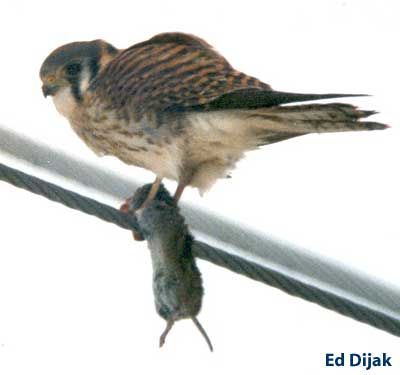
Falco sparverius
(American Kestrel)
Order: Falconiformes
Order Description: Vultures, Osprey, Hawks, Falcons
Family: Falconidae
Family Description: Falcons
Physical Description:
9-12" (23-30 cm). Male: Slate gray on top of head and wings; wings dotted with black. Rusty back dotted with black; breast tinged with rust fading to a white belly dotted with black. Two vertical black stripes descend the lightly colored cheeks. Light rust bill is tipped with black; light buffy yellow legs and feet with black talons. Tail rusty with black subterminal band. Female: Darker barring on back and wings; both of which are rusty; tail completely barred.
Similar Species- Sharp-shinned Hawk, Merlin
Song:
Clearly called klee-klee-klee-klee.
Distribution:
Breeds from central Alaska and most of forested Canada, south through most of North, Central, and South America, to Tierra del Fuego. Winters from northern U.S. (locally in southern Canada), south through breeding range to Panama.
Habitat:
Found in open or partly-open habitat such as shrub steppe, wooded streams, burned forests, cultivated lands, farmland with scattered trees, open woodlands, along roads, and sometimes in cities. In Idaho, found from low deserts to high mountain meadows.
Diet:
In summer, feeds on insects and small vertebrates (e.g., snakes, lizards, birds, mice, and sometimes bats). In winter in northern range, feeds mainly on birds and mice. In Idaho, diet includes insects and small mammals.
Ecology:
Forages from conspicuous perch or while in flight (regularly hovers in flight while hunting). Hunts most actively in morning and late afternoon, rests during middle of day. Two western U.S. studies found average territory size to be 109.4 ha and 129.6 ha. Home range diameter during breeding season varies from 0.5-2.4 km. Nests in cavities (in Idaho, regularly nests in urban areas). Nesting density varies greatly throughout range, depending on nest-site availability and probably food supply; may tolerate close nesting by other pairs in some regions. May be attacked by larger raptors. Year-round Idaho resident.
Reproduction:
Female incubates 3-7 eggs (usually 4-5, but 2-6 in Idaho) for 29-31 days. Southeastern Idaho study reported clutch sizes ranging from 4.5-4.7, during 1975-76, and average numbers fledged ranged from 3.7-4.0. Both parents tend young, which leave nest in about 29-31 days, but may stay with parents for 2-4 wks or more (no later than late summer in U.S.). Readily lays replacement clutch if first clutch lost. Most young first breed at 1 yr. Monogamy through successive breeding seasons seems to prevail.
Conservation:
| Element Code: | ABNKD06020 |
| Status: | Protected nongame species |
| Global Rank: | G5 |
| State Rank: | S5,NTMB |
| National Rank: | N5B,N5N |
Important State References:
Craig, T.H. and C.H. Trost. 1979. The biology and nesting density of breeding American Kestrels and Long-eared Owls on the Big Lost River, southeastern Idaho. Wilson Bull. 91:50-61.
Photos by Ed Dijak and C. Trost,© 1999-2002
Design by Ean Harker©1999, 2000.
Written by Jason Karl, 2000.
Pandion haliaetus
(Osprey)
Link to photo provided by USGS - Patuxent Wildlife Research Center: http://www.mbr-pwrc.usgs.gov/Infocenter/infocenter.html
Order: Falconiformes
Order Description: Vultures, Osprey, Hawks, Falcons
Family: Accipitridae
Family Description: Osprey, Hawks and Eagles
Physical Description:
21-24 1/2" (53-62 cm). Dark brown back and wings; white below and under wings. Head black and white: black splash on crown, black eye ring, and black eye stripe continuing past ear. Black spotting on breast of female. Distinctive bend in wing when flying.
Similar Species- Bald Eagle
Song:
Whistled chirping: cheerp-cheerp-cheerp.
Distribution:
Breeds from northwestern Alaska, east to northern Saskatchewan, Labrador, and Newfoundland, and south to Baja California, Arizona, Gulf Coast, Florida, and Yucatan Peninsula. Winters from California and Gulf Coast, south through Central America to South America.
Habitat:
Found along rivers, lakes, reservoirs, and seacoasts, occuring widely in migration, often crossing land between bodies of water.
Diet:
Feeds almost exclusively on fishes (usually live).
Ecology:
Catches food by diving feet- first into shallow water. Builds stick nest usually near water (sometimes up to 5 km from water), in tree or atop pole. Simetimes nests semi-colonially. Artificial platforms are highly productive, and help expand local populations, especially along reservoirs. Species is kleptoparasitised by Bald Eagles. Idaho study revealed birds nesting in northern Idaho winter in Central America. Northern Idaho nestlings disperse to Nevada, Oregon, and Montana.
Reproduction:
Female incubates 2-4 eggs (usually 3), for about 38 days; male provides food (Idaho study found young/nest averages 1.37). Young first fly at 44-59 days, and are dependent on parents for 6 wk or more (less in northern range). Breeding usually occurs at 3 yr, sometimes at 4-5 yr.
Conservation:
| Element Code: | ABNKC01010 |
| Status: | Protected nongame species |
| Global Rank: | G5 |
| State Rank: | S5,NTMB |
| National Rank: | N5B,N4N |
Important State References:
Johnson, D.R. and W.E. Melquist. 1991. Wintering distribution and dispersal of northern Idaho and eastern Washington ospreys. J. Field Ornithol. 62:517-520.
Design by Ean Harker©1999, 2000.
Written by Jason Karl, 2000.
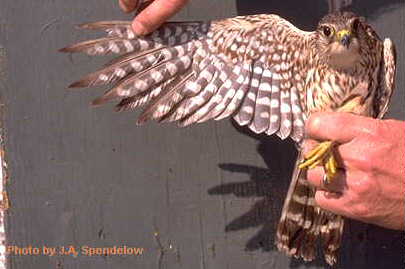
Falco columbarius
(Merlin)
Order: Falconiformes
Order Description: Vultures, Osprey, Hawks, Falcons
Family: Falconidae
Family Description: Falcons
Physical Description:
10-13 1/2" (25-34 cm). Color varies from dusky brown to light or dark gray. Head may be contrasting color of brown on a gray bird. Streaking on head; lighter below with dark streaks. Several buffy bands cross the tail. Some have eyebrow stripe and/or mustache.
Similar Species- Peregrine Falcon, Prairie Falcon, American Kestrel
Song:
High pitched, repeated pwee-pwee-pwee, that accelerates.
Distribution:
Breeds from north westerm Alaska, northern Yukon, northern Manitoba, and Labrador south to northern Michigan, northwest Nebraska, northern Montana, rarely in northern and eastern Idaho, eastern Oregon, and central Washington. They winter in southern portions of this range and southward.
Habitat:
They bree in both deciduous and coniferous forests, frequently near water, where they rely on old corvid nests (i.e., ravens crows, and magpies). They recently extended their breeding into some cites, such as Saskatoon, Saskatchewan. In Idaho they are very rare, but are thought to use riparian habitat along streams or lakes.
Diet:
Mostly small birds up to magpie in size, which they capture on the wing. They also hunt blackbirds, and House Sparrows.
Ecology:
As in most bird eating raptors, their density is usually low. Their hunting techniques are varied, from suprise attacks off hidden perches to breath-taking vertical dives. They fly so quickly that they easily overtake their prey, sometimes coming from underneath a flock and taking a bird going up.
Reproduction:
The normal clutch size is between 4 and 5 eggs, whcih are laid at two day intervals. The female dose most of the incubation, except when the male has brought in food. They begin breeding at about two years and the oldest known breeder was six years.
Conservation:
| Element Code: | ABNKD06030 |
| Status: | Protected nongame species |
| Global Rank: | G5 |
| State Rank: | S1 |
| National Rank: | N4B,N4N |
Important State References:
No references are available at this time.
Original images provided by Jeff Spendelow,© 1999
Design by Ean Harker©1999, 2000.
Written by Jason Karl, 2000.
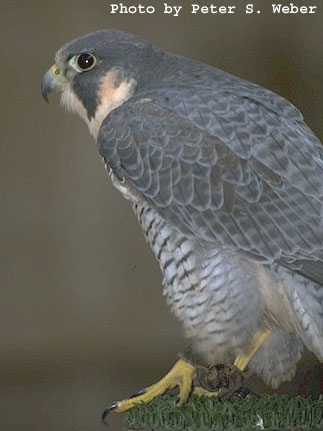
Falco peregrinus anatum
(Peregrine Falcon)
Order: Falconiformes
Order Description: Vultures, Osprey, Hawks, Falcons
Family: Falconidae
Family Description: Falcons
Physical Description:
15-21" (38-53 cm). Dark gray back; white eyebrow; white cheeks with dark "sideburns"; white neck; white and gray scaling below. Typical falcon wings are pointed; narrow tail. Immatures are brown instead of gray.
Similar Species- Gyrfalcon, Prairie Falcon, Merlin
Song:
A loud, shrill, coarse kek-kek-kek-kek-kek-kek.
Distribution:
Nearly cosmopolitan; breeds on every continent except Antarctica.
Habitat:
Found in various open situations from tundra, moorland, steppes, and seacoasts (especially where there are suitable nesting cliffs), to mountains, open forested regions, and populated areas. In Idaho, former and current nest sites are located in both mountain and desert regions, and are generally associated with bodies of water.
Diet:
Feeds primarily on birds (medium-size passerines up to small waterfowl), but will also eat (rarely or locally) small mammals, lizards, fish, and insects (eaten by young birds). In Idaho, diet consists almost entirely of birds.
Ecology
Nests on cliff or building May hunt anytime during day, but usually hunts in morning or evening. Initiates prey pursuit from perch or while soaring. May hunt up to several km from nest site. Great- horned Owl is serious nest predator in U.S. (in Idaho, Golden Eagles are also predators). Severe weather may result in high mortality in northern range. Since 1982, 288 captive- reared young have been released in Idaho. The first re-establishing pair of peregrines was discovered in 1985. As of 1995, 13 pairs of peregrines occupied territories in Idaho. In 1995, 6 occupied territories in Idaho successfully fledged an average of 2.7 young/pr.
Reproduction
clutch size averages 4 eggs at mid-latitudes, 3 in far north. Female incubates eggs for 32-35 days; male brings food. clutch is often replaced if lost, usually at an alternate site (brood losses are apparently caused mainly by bad weather). Young fledge at 39-49 days, gradually become independent, and breed at 2-3 yr (occasionally as yearlings). Adults form life-long pair bond.
Conservation:
| Element Code: | ABNKD06071 |
| U.S. ESA Status: | E(S/) |
| Status: | Protected nongame species |
| Global Rank: | G4 |
| State Rank: | S1,NTMB |
| National Rank: | N4B,N4N |
Important State References:
Levine, E., W. Melquist, and J. Beals. 1995. Idaho peregrine falcon survey, nest monitoring, and release program, 1995. Idaho Dept. Fish & Game, Boise 25pp.
Photo by Peter S. Weber,© 2000
Design by Ean Harker©1999, 2000.
Written by Jason Karl, 2000.
Falco mexicanus
(Prairie Falcon)
Link to photo provided by USGS - Patuxent Wildlife Research Center: http://www.mbr-pwrc.usgs.gov/Infocenter/infocenter.html
Order: Falconiformes
Order Description: Vultures, Osprey, Hawks, Falcons
Family: Falconidae
Family Description: Falcons
Physical Description:
17-20" (43-51 cm). Gray-brown above with white edging on feathers for a scaling effect. White below with dark, vertical streaks. Brown on top of head and white on neck; blackish, vertical streaks on cheeks. Yellow feet and dark bill. Undersides of wings show black wingpits in flight.
Similar Species- Peregrine Falcon
Song:
Hoarse, repeated whistle, sometimes incessant.
Distribution:
Breeds from southeastern British Columbia, southern Alberta, southern Saskatchewan, and northern North Dakota, south to Baja California, parts of southwestern U.S., and northern Mexico. Winters from breeding range in southern Canada, south to Baja California and northern Mexico.
Habitat:
Found in open situations in mountainous shrub steppe, or grasslands areas. In Idaho, breeds in shrub steppe and dry mountainous habitat, and winters at lower elevations.
Diet:
Feeds opportunistically on mammals, lizards, and birds. In southwestern Idaho, Townsend's ground squirrels are main prey item.
Ecology:
Nests on cliff, sometimes in old corvid or raptor nest. Rapidly pursues birds in flight, but usually captures prey on or near ground. May cache prey in vegetation, on ledge, or in small crevice or cavity (caching is most common during early brood rearing). Cumulative home range size increases from incubation to hatching period. Birds disperse from lower elevations after young fledge. Average home range in southwestern Idaho study was 49-73 km2; highest known nesting density in North America occurs in that area (recorded nesting densities: 23 pairs on 26 km of cliffs in Colorado; and 200 pairs in 130 km along Snake River). Annual mortality has been estimated at 74% in immatures, and 25% in adults. Southwestern Idaho study found construction and recreation activities had no detectable adverse effects on nesting Prairie Falcons.
Reproduction
Laying may begin as early as: February in Texas and Mexico; March in California, Washington, Arizona, and Oregon; and April in Montana and Wyoming. Female (usually) incubates 6 eggs for 29-33 days; male brings food (in southern Idaho study, maximum broods averaged 3.14 young/nest). In southwestern Idaho, from 1974-83, numbers fledged/pair ranged from 1.48-3.23. Young are tended by both parents, remain at nest site for 36-41 days, and first breed at 2 yr. (sometimes 1).
Conservation:
| Element Code: | ABNKD06090 |
| Status: | Protected nongame species |
| Global Rank: | G4 |
| State Rank: | S5,NTMB |
| National Rank: | N5B,N5N |
Important State References:
Holthuijzen, A.M.A. 1990. Behavior and productivity of nesting prairie falcons in relation to construction activities at Swan Falls Dam. Final Report. Idaho Power Co., Boise. 77pp.
Design by Ean Harker©1999, 2000.
Written by Jason Karl, 2000.
Perdix perdix
(Gray Partridge)
Order: Galliformes
Order Description: Pheasant, Grouse, Turkey, Quail
Family: Phasianidae
Family Description: Pheasant, Grouse, Turkey, Quail
Physical Description:
12-14" (30-36 cm). A gray-brown bird with cinnamon face; cinnamon on sides of tail and chestnut diagonal streaks on flanks. Fine white streaks on back; brown inverted "U" belly patch on males. Gray feet and bill; dark eyes.
Similar Species- Chukar, Northern Bobwhite
Song:
A scratchy, low squeek.
Distribution:
Native to western Eurasia. Widely introduced in North America, and established locally from southern Canada to northern U.S. (from New York, west to Oregon).
Habitat:
Found primarily in cultivated regions with marginal cover of bushes, undergrowth, or hedgerows. In study conducted in Palouse region of Idaho, birds wintered mostly in plowed stubble fields.
Diet:
Feeds primarily on seeds of wheat, corn, barley, oats, smartweeds, lambs quraters, crabgrass, and others. Also eats leaves of clover, alfalfa, bluegrass, and dandelion. Chicks feed on insects for first few weeks of life. In winter, and spring diets; small grains (oats, barley, wheat, rye) are rarely consumed, though widely available. In one study, partridges ate more leafy vegetation when row crop grains were buried by snow, consumed predominately insects in early summer, and ate foxtail seeds in late summer and early fall.
Ecology:
Builds concealed nest in shallow depression in grass or shrubs; Idaho study found most nests were in areas of permanent cover. Forages on ground. In New York study, home range was 82-672 ha; size did not differ by season.
Reproduction:
Breeding begins late May to early June. Female lays 8-23 eggs in 1 nest; 2 hens my lay eggs in same nest. Incubation lasts 23-25 days; hatching peaks in mid-June in north-central Idaho. Nestlings are precocial and downy. Parents probably form lifetime pair bond; both parents tend young. Idaho study found nesting success ranged from 12%-63% over 2-yr period.
Conservation:
| Element Code: | ABNLC01010 |
| Status: | Game species |
| Global Rank: | G5 |
| State Rank: | SE |
| National Rank: | NE |
Important State References:
Mendel, G.W. 1979. The hungarian partridge in the Palouse Region of Northern Idaho. M.S. Thesis, Univ. Idaho, Moscow. 161pp.
Design by Ean Harker©1999, 2000.
Written by Jason Karl, 2000.
Alectoris chukar
(Chukar)
Order: Galliformes
Order Description: Pheasant, Grouse, Turkey, Quail
Family: Phasianidae
Family Description: Pheasant, Grouse, Turkey, Quail
Physical Description:
13-15 1/2" (33-39 cm). Gray above, on breast, and on rump; lighter below; breast and wings tinted with rufous. Blackish brown eye stripe that curves around a whitish face to connect to a blackish chin stripe. Dark reddish, vertical stripes on flanks. Dark orange bill and eye ring; lighter orange legs.
Similar Species- Northern Bobwhite, Gray Partridge
Song:
Repeats its name in a series of chucks: chuck-chucka-chuck-chucka-chuck.
Distribution:
Native to Eurasia. Introduced and resident in North America from south-central British Columbia, northern Idaho, and central and eastern Montana, south to northern Baja California, southern Nevada, northern Arizona, northwestern New Mexico, and south-central Colorado.
Habitat:
Found on rocky hillsides, mountain slopes with grassy vegetation, open and flat deserts with sparse grasses, and barren plateaus.
Diet:
Feeds primarily on seeds and leaves. Also eats some fruits and insects.
Ecology:
Builds concealed nest on ground, or in rocks or bush. Most foraging activity occurs in mid-morning, but may continue into afternoon. Frequently inactive and near water at mid-day in hot weather. In favorable habitat, population density can reach levels of 1 bird/4 hectares. In late summer, family groups may join and form larger groups. Males reportedly may leave female during incubation and spend summer with other males. Idaho study found greatest dispersion in spring; in summer birds restricted themselves to tree-shrub vegetation adjacent to water. A habitat-use study in north-central Idaho was initiated in 1994 by the Idaho Dept. Fish & Game.
Reproduction:
clutch size varies from 8-15 eggs. Incubation lasts 22-23 days (some authorities state male may incubate first clutch while female lays second). Nestlings are precocial. Young are almost full-size at 84 days.
Conservation:
| Element Code: | ABNLC03010 |
| Status: | Game species |
| Global Rank: | G5 |
| State Rank: | SE |
| National Rank: | NE |
Important State References:
Oelklaus, W.F. III. 1976. Chukar partridge dispersion along the middle and lower Snake and Columbia Rivers. M.S. Thesis, Univ. Idaho, Moscow. 56pp.
Photo byC. Trost,© 1999
Design by Ean Harker©1999, 2000.
Written by Jason Karl, 2000.
Phasianus colchicus
(Ring-necked Pheasant)
Link to photo provided by USGS - Patuxent Wildlife Research Center: http://www.mbr-pwrc.usgs.gov/Infocenter/infocenter.html
Order: Galliformes
Order Description: Pheasant, Grouse, Turkey, Quail
Family: Phasianidae
Family Description: Pheasant, Grouse, Turkey, Quail
Physical Description:
30-36" (75-91 cm). Male: Iridescent greenish-black head with red facial patches and wattles and two feathered tufts; pinkish gray bill hooks at the end; white, incomplete neck ring; long, pointed tail. Body deep tawny-chestnut with blue-black belly and rich golden, mottled flanks. Immatures and females: primarily buff, mottled with brown and black.
Similar Species- Sharp-tailed Grouse
Song:
Explosive double squawk: Kork-kok
Distribution:
Native to Asia. Introduced and established in North America from southern Canada, south locally to California, Utah, sothern New Mexico, southeastern Texas, northwestern Oklahoma, southern Illinois, Pennsylvania, New Jersey, and Maryland.
Habitat:
Found in open country -- especially cultivated areas, scrubby wastes, open woodlands, and edges of woods, but also in shrub steppe, riverside thickets, swamps, and open mountain forests.
Diet:
Eats waste corn, wheat barley, oats, buckwheat, berries, and seeds of ragweed, burdocks, and pine. In spring, eats green vegetatioin. Will also eat some insects, mice, and snails.
Ecology
Nests in depression in grass or weeds. Forages on ground. roosts in trees. Usually ranges over no more than 2-3 km. In fall, family groups may join and form flocks of 30-40 birds; flocks break up in spring. Populations in Idaho thought to be declining due to winter habitat loss. Idaho study showed pheasants preferred sagebrush, wetland, and herbaceous cover types in winter, and avoided grassland and agricultural areas. Livestock grazing decreased pheasant use of sagebrush. In 1994 the Idaho Dept. Fish & Game initiated research on pheasant response to intensive habitat management, predator management, and the effects of pesticides on pheasants.
Reproduction:
Usually 10-12, but sometimes 5-23, eggs are laid in 1 nest. Two hens may lay eggs in same nest. Incubation lasts 23-25 days. Nestlings are precocial and downy; young are tended by female.
Conservation:
| Element Code: | ABNLC07010 |
| Status: | Game species |
| Global Rank: | G5 |
| State Rank: | SE |
| National Rank: | NE5 |
Important State References:
Leptich, D.J. 1992. Winter habitat use by hen pheasants in southern Idaho. J. Wildl. Manage. 56:367-380.
Design by Ean Harker©1999, 2000.
Written by Jason Karl, 2000.
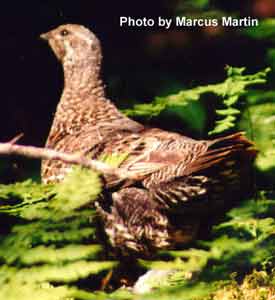
Falcipennis canadensis
(Spruce Grouse)
Order: Galliformes
Order Description: Pheasant, Grouse, Turkey, Quail
Family: Phasianidae
Family Description: Pheasant, Grouse, Turkey, Quail
Physical Description:
15-17" (38-43 cm). Brown and white mottling and barring all over that darkens to black at the throat in the male and at the tail in both sexes. Tail ends with a brown or buff tip. Male also has distinct white tipped feathers on breast and tail; red eye combs.
Similar Species- Ruffed Grouse
Song:
Deeply, trilled, dove-like call ending with a donkey ee-a. Wings make sharp clap in flight displays.
Distribution:
Found from central Alaska, east through parts of Canada to Labrador, and south to northeastern Oregon, central Idaho, western Montana, northwestern Wyoming, northern Montana, Minnesota, northern Wisconsin, and parts of New England.
Habitat:
Found in coniferous forests (primarily spruce and pine), especially in forests with dense grass and shrub understories.
Diet:
Eats needles and buds of spruce, jack pine, fir, and larch. Also consumes berries, seeds, fungi, leaves, and some insects as available. In Ontario study, spring diet consisted mainly of conifer foliage, flowers, fruits, foliage of ground plants, grit, and arthropods.
Ecology:
Nests in depression on ground, often near fallen tree. Takes food from foliage, or forages on ground. Primarily arboreal. Usually found alone or in small, family flocks. In southwestern Alberta study, spring population density fluctuated from 5-30/ha over 21 yr; population decline was attributed to maturation of forest. Populations may be highest in earlier stages of post-fire succession.
Reproduction
Female incubates 5-10 eggs (usually 6-7) for 23-24 days. Hatching occurs from late June-early July in Alberta. Young are tended by female. Females reach sexual maturity as yearlings. Cold, wet conditions during incubation result in poor productivity. In Ontario study, large clutch size was associated with high intake of flowers of trailing arbutus and moss spore capsules; females relied on spring diet and stored reserves for nutrients required for clutch formation.
Conservation:
| Element Code: | ABNLC09010 |
| Status: | Game species |
| Global Rank: | G5 |
| State Rank: | S4 |
Important State References:
No references are available at this time.
Photos by Marcus Martin,© 1999 and Peter S. Weber,© 2000
Design by Ean Harker©1999, 2000.
Written by Jason Karl, 2000.
Dendragapus obscurus
(Blue Grouse)
Order: Galliformes
Order Description: Pheasant, Grouse, Turkey, Quail
Family: Phasianidae
Family Description: Pheasant, Grouse, Turkey, Quail
Physical Description:
15 1/2-21" (39-53 cm). Males sooty-gray and females brown- gray. Mottled above, solid below and whitish flanks; dark tail with pale gray terminal band (absent in birds north of the Rockies). Males have a yellow-orange comb over black eyes.
Similar Species- Female Sage Grouse, Spruce Grouse, Ruffed Grouse
Song:
Deep hoot that almost sounds like water dripping: Whoop-whoop-whoop- whoop. Can almost feel it more than hear it.
Distribution:
From southeastern Alaska, south through western Canada to eastern Washington, and south from there through Rocky Mountains to eastern Nevada, northern and eastern Arizona, southwestern and north-central New Mexico, and eastern Colorado. Also present from western Washington south in coastal ranges and Cascades through Sierra Nevada to southern California and extreme western Nevada.
Habitat:
Found in coniferous forests (especially fir), mostly in open situations with mixture of deciduous trees and shrubs. Spends winter (usually at elevations higher than that of summer habitat) in open coniferous forests of various categories of age and tree density. Idaho study found spring and summer habitat to be low-elevation bigtooth maple, mountain mahogany, and mixed shrub stands with open understory and overstory.
Diet:
In summer, feeds on variety of berries, insects, flowers, and leaves. In winter, feeds mainly on needles and buds of conifers (Douglas-fir is often important). Also eats waste grain.
Ecology:
Primarily a solitary, montane species. Nests in depression on ground, frequently near shrub or fallen tree. Forages on ground or takes food from foliage. roosts in large conifers with dense foliage. Courting males establish territories.
Reproduction:
Breeding begins mid- April in southern range, to late May in north. Female incubates 7-10 eggs (sometimes up to 16), for 26 days, and may renest if nest is destroyed. Nestlings are precocial and downy. Young are tended by female. yearling males often do not breed.
Conservation:
| Element Code: | ABNLC09020 |
| Status: | Game species |
| Global Rank: | G5 |
| State Rank: | S5 |
| National Rank: | N5 |
Important State References:
Stauffer, D.F. and S.R. Peterson. 1985. Ruffed and blue grouse habitat use in southeastern Idaho. J. Wildl. Manage. 49:459-466.
Original images provided by Brad Bergstrom,© 1999
Design by Ean Harker©1999, 2000.
Written by Jason Karl, 2000.
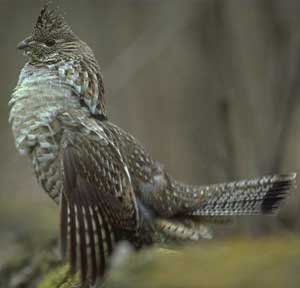
Bonasa umbellus
(Ruffed Grouse)
Order: Galliformes
Order Description: Pheasant, Grouse, Turkey, Quail
Family: Phasianidae
Family Description: Pheasant, Grouse, Turkey, Quail
Physical Description:
16-19" (40-48 cm). Two color phases. Red phase: mottled rufous above, lighter and barred below; tail red, finely barred, with broad, dark subterminal band and light tip. Gray phase: gray replaces red and rufous. Both phases show a slight crest, a fan-shaped tail, and black feathers on sides of neck.
Similar Species- Female Spruce Grouse, Sharp-tailed Grouse
Song:
Male beats wings on logs in an accelerating drum roll. May sound like a distant motor starting up.
Distribution:
Central Alaska and most of forested Canada, south to northern California, central Arizona, central Idaho, central Utah, western South Dakota, Minnesota, Georgia, and Virginia.
Habitat:
Found in wet or relatively dry, dense forests with some deciduous trees, such as boreal forests (especially early seral stages dominated by aspen) or northern hardwood ecotone. In southeastern Idaho study, Ruffed Grouse were associated with early-successional aspen stands year-round.
Diet:
Young eat mainly insects and spiders. Adults eat insects (30% of summer diet), nuts, flowers, buds, and leaves of trees and shrubs, seeds, and fruits. In many areas, aspen, willow, and rose family are important food resources.
Ecology:
Nests in depression on ground. Usually roosts in small groups in winter. Population densities may fluctuate (10- yr cycle in some populations). Spring density may reach 2-10/40 ha; fall density 20-55/ha (highest in boreal forest regions). brood home range is about 6-19 ha. In Missouri study, mean adult male home range was 67 ha in spring-summer, 104 ha in fall-winter. Mature and some immature males may defend a territory. Predators include Great-horned Owl and Northern Goshawk. Shallow snow cover or icy crust on snow may reduce winter survival by precluding access to subnivean shelter.
Reproduction:
Drumming/mating peak in mid-March to May, depending on range. Egg laying occurs April-May, depending on latitude. Female incubates 4-19 eggs (generally 9-12) for 23-24 days. Nestlings are precocial and downy, and fly in 10-12 days. Young are tended by female. broods break up in fall when young are about 84 days old (young disperse at about 120-125 days in Wisconsin). Single-brooded, but females may renest if first nesting attempt is unsuccessful. Sexually mature in 1 yr; uncommonly lives more than 5 yr. Cold, wet weather in May/June may cause high losses among broods.
Conservation:
| Element Code: | ABNLC11010 |
| Status: | Game species |
| Global Rank: | G5 |
| State Rank: | S5 |
| National Rank: | N5 |
Important State References:
Stauffer, D.F. and S.R. Peterson. 1985. Ruffed and blue grouse habitat use in southeastern Idaho. J. Wildl. Manage. 49:459-466.
Photo by C. Trost, ©1999.
Design by Ean Harker©1999, 2000.
Written by Jason Karl, 2000.
Centrocercus urophasianus
(Sage Grouse)
Link to photo provided by USGS - Patuxent Wildlife Research Center: http://www.mbr-pwrc.usgs.gov/Infocenter/infocenter.html
Order: Galliformes
Order Description: Pheasant, Grouse, Turkey, Quail
Family: Phasianidae
Family Description: Pheasant, Grouse, Turkey, Quail
Physical Description:
26-30" (65-76 cm). Streaked gray above with dark belly and white breast. Throat black with white collar; yellow-orange eyebrow. Spike-like tail feathers that are fanned out in mating ritual. Immatures and females have mottled brown throat and breast.
Similar Species- Blue Grouse, Sharp-tailed Grouse
Song:
Male makes a bubbling pop-pop sound as air is released from air sacs during courtship ritual. Clucks like a chicken when flushed.
Distribution:
Previously widespread. Resident locally from central Washington, southern Idaho, Montana, and parts of southern Canada and Great Plains, south to eastern California, south-central Nevada, southern Utah, western Colorado and northern New Mexico.
Habitat:
Found in foothills, plains and mountain slopes where sagebrush is present, or in mixture of sagebrush, meadows, and aspen in close proximity. In some areas, suitable winter habitat is probably most limiting seasonal factor.
Diet:
Feeds on sagebrush during winter. At other times of year, feeds on sagebrush as well as leaves, blossoms, and buds of associated plants. Also eats insects (e.g., ants and grasshoppers).
Ecology:
Builds concealed nest in depression on ground under sagebrush. Forages in foliage, or on ground. lek breeder; up to 400 males may display in area 0.8 km long. In Idaho, populations may move 0.2-81.0 km from summer to winter range. Agricltural areas are important component of summer rante; sagebrush stands are more important in winter. In Idaho study, nesting success was higher in sagebrush versus non-sagebrush sites. Other Idaho investigations by the Dept. Fish & Game are examining the impact of wildfire in shrub steppe on sage grouse.
Reproduction:
Female incubates 7-8 eggs (sometimes 7-15), for 25-27 days. Young are precocial and downy, are tended by female, and fly when they are 7-14 days old.
Conservation:
| Element Code: | ABNLC12010 |
| Status: | Game species |
| Global Rank: | G5 |
| State Rank: | S4 |
| National Rank: | N5 |
Important State References:
Connelly, J.W., W.L. Wakkinen, A.D. Apa, and K.P. Reese. 1991. Sage grouse use of nest sites in southeastern Idaho. J. Wildl. Manage. 55:521-524.
Design by Ean Harker©1999, 2000.
Written by Jason Karl, 2000.
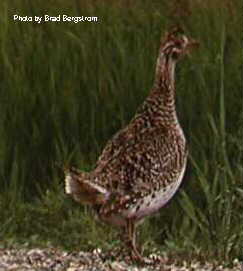
Tympanuchus phasianellus columbianus
(Sharp-tailed Grouse)
Order: Galliformes
Order Description: Pheasant, Grouse, Turkey, Quail
Family: Phasianidae
Family Description: Pheasant, Grouse, Turkey, Quail
Physical Description:
15-20" (38-51 cm). Speckled pale brown and blackish overall, somewhat darker above than below, spotted white on wings; belly whitish, spotted dark. Central tail feathers slightly elongated with graduated white outer tail feathers. Male has violet neck sacs and longer tail than female.
Similar Species- Female Ring-necked Pheasant, Prairie-chickens, Ruffed Grouse
Song:
A low, dove-like co-coo. Also, squeaky, bubbly cackles.
Distribution:
Locally from Alaska, east to western Quebec, and south to eastern Washington, eastern Oregon, southern Idaho, Utah, Colorado, northeastern New Mexico (at least formerly), and parts of Midwest.
Habitat:
Found in grasslands (especially with scattered woodlands), arid sagebrush, brushy hills, oak savannas, and edges of riparian woodlands. Also found in upland winter wheat fields. In west-central Idaho study, grouse preferred big sagebrush to other summer cover types; mountain shrub and riparian cover types were critical components of winter habitat.
Diet:
Initially, chicks eat insects and some berries. Adults eat berries, grain, leaves, buds, and flowers of wide variety of plants. In spring, fall, and winter, roughly 10% of adult bird's diet is insects (up to 40% in summer); 90% or more is plant material. In Idaho study, hawthorn fruits and buds of serviceberry and chokecherry were primary winter foods.
Ecology:
Builds concealed nest in depression on ground, in grass or near shrub. Forages in foliage or on ground (broods forage in short vegetation in early morning and evening, and in taller vegetation at other times). Gathers in flocks in fall and winter. Often uses snow as roost cover in winter. In Idaho study, winter food/cover was regarded as most limiting habitat characteristic for long-term abundance. Spring/autumn home ranges were 1.87 km2. In Montana, spring, summer, and fall distribution of males is generally within 1.6 km of lek; in other states, movements of up to several km between seasonal habitats have been reported.
Reproduction:
Males engage in communal courtship displays. Breeding begins early April in southern/western range, to early May in north. Female incubates 10-13 eggs (usually) for 23-24 days (Idaho study reported average clutch of 10.8). Young are tended by female; brood disperses in 6-8 wk.
Conservation:
| Element Code: | ABNLC13033 |
| Status: | Game species |
| Global Rank: | G4 |
| State Rank: | S3 |
| National Rank: | N4 |
Important State References:
Marks, J.S. and V.S. Marks. 1987. Habitat selection by Columbian sharp-tailed grouse in west-central Idaho. USDI Bur. Land Manage., Boise District, U.S. Govt. Report 792-057/40, 019, Boise. 115pp.
Original images provided by Brad Bergstrom,© 1999
Design by Ean Harker©1999, 2000.
Written by Jason Karl, 2000.
Meleagris gallopavo
(Wild Turkey)
Link to photo provided by USGS - Patuxent Wildlife Research Center: http://www.mbr-pwrc.usgs.gov/Infocenter/infocenter.html
Order: Galliformes
Order Description: Pheasant, Grouse, Turkey, Quail
Family: Phasianidae
Family Description: Pheasant, Grouse, Turkey, Quail
Physical Description:
Male: 46-48" (116-122 cm), female: 36" (90-91 cm). Largest North American game bird. Featherless, blue-gray head with red wattles (larger in males). All dark with Iridescent reddish and bronzy cast; tail and rump tipped whitish; wings barred. Male has spurs and long dangling tuft of feathers in middle of breast.
Song:
Similar to domestic turkey gobble.
Distribution:
Native to eastern and southwestern U.S., Mexico, and southern Ontario. Extirpated or reduced populations in some of those areas have been re- introduced; also re-introduced widely outside of former range.
Habitat:
Found, especially in mountainous regions, in forests and open woodland (scrub oak, and deciduous or mixed deciduous-coniferous areas). Also found in agricultural areas in some regions; agricultural areas may provide important food resources in winter. In an Idaho study, brood rearing sites were characterized by low overstory canopy cover and high ground cover.
Diet:
Feeds on seeds, nuts, acorns, fruits, grains, buds, and young grass blades. During summer, eats many insects; may also eat some small vertebrates (frogs, toads, snakes, etc.).
Ecology:
Nests in depression on ground. Usually forages on ground. Roosts in trees at night. Sexes usually form separate flocks in winter. Severe winters and/or lack of winter habitat are important limiting factors in many northern areas., In Massachusetts study, predation exerted greatest influence on productivity; in Minnesota study, winter conditions and resulting pre- breeding female condition were important factor. In southeaster Oklahoma study, mean seasonal home range for adult females were 225 ha (winter), 865 ha (spring), 780 ha (summer), and 459 ha (fall). In Colorado study, adult males moved average distance of 5.3 km from winter ranges to spring breeding areas, and sub-adult males moved average distance of 8.7 km; in spring, males moved about 1000 m between morning and evening roosts used on same day.
Reproduction:
Female incubates average of 10-12 eggs for 27-28 days (in northeastern Colorado, most nests are initiated mid-April to mid-May). Hatching begins in May in southern range, usually early June in north. Young are tended by female; brood stay together until winter. Females first breed as yearlings. An Idaho study compared nest success and initiation rates between resident and introduced hens and found no significant difference.
Conservation:
| Element Code: | ABNLC14010 |
| Status: | Game species |
| Global Rank: | G5 |
| State Rank: | SE |
| National Rank: | N5 |
Important State References:
Edelman, F.B. 1995. Ecology of Merriam's wild turkeys in west central Idaho. M.S. Thesis, Univ. of Idaho, Moscow. 168pp.
Design by Ean Harker©1999, 2000.
Written by Jason Karl, 2000.
Callipepla gambelii
(Gambel's Quail)
Link to photo provided by USGS - Patuxent Wildlife Research Center: http://www.mbr-pwrc.usgs.gov/Infocenter/infocenter.html
Order: Galliformes
Order Description: Pheasant, Grouse, Turkey, Quail
Family: Phasianidae
Family Description: Pheasant, Grouse, Turkey, Quail
Physical Description:
10-11 1/2" (25-29 cm). Gray above and on breast; light belly with central black patch, bordered by dark, rusty flanks streaked with white. Black face and chin edged with white; white band across forehead, topped by lighter rusty crown and black plume. Immatures and females duller and lack belly patch.
Similar Species- California and Mountain Quails
Song:
A throaty, laughing, kha-kha-CAW.
Distribution:
Resident from east-central California, southern Nevada, southern Utah, western Colorado, and northwestern New Mexico, south to northeastern Baja California, portions of northern Mexico, and western Texas. Introduced in north-central Idaho.
Habitat:
Found in deserts (primarily with brushy or thorny growth such as mesquite, desert thorn, and yucca), but also in adjacent cultivated regions. Usually lives near water in river valleys or near streams. Ideal cover is composed of creek banks, willow thickets, brush piles, vines and brambles.
Diet:
Feeds on seeds, green vegetaion, and some fruits.
Ecology:
Builds nest in depression on ground, frequently under vegetation. May occasionally nest in bush or tree. Forages on ground. Most active in morning and in late afternoon and evening. In fall, family groups form coveys of 12-24 or 40-50 birds; coveys break up by March.
Reproduction:
Female incubates 12- 14 eggs (sometimes 10-19) for 21-23 days (male is usually nearby). precocial, downy nestlings are usually tended by both parents. Female may renest if first attempt is unsuccessful.
Conservation:
| Element Code: | ABNLC23030 |
| Status: | Game species |
| Global Rank: | G5 |
| State Rank: | SE |
| National Rank: | N5 |
Important State References:
Taylor, D.M. and C.H. Trost. 1987. The status of rare birds in Idaho. Murrelet 68:69-93.
Design by Ean Harker©1999, 2000.
Written by Jason Karl, 2000.
Callipepla californica
(California quail)
Link to photo provided by USGS - Patuxent Wildlife Research Center: http://www.mbr-pwrc.usgs.gov/Infocenter/infocenter.html
Order: Galliformes
Order Description: Pheasant, Grouse, Turkey, Quail
Family: Phasianidae
Family Description: Pheasant, Grouse, Turkey, Quail
Physical Description:
9-11" (23-28 cm). Adult males bluish-gray above, with scaled belly and rusty or brownish sides streaked with white; black forward-curving plume arises from chestnut crown; black face and throat outlined in white; white eyebrow. Females more brown than gray; buff scaling on belly and diagonal streaking on flanks; short dark plume.
Similar Species- Gambel's and Mountain Quails
Song:
A three syllabled Chi-ca'-go.
Distribution:
Resident from southern Oregon and western Nevada, south to southern Baja California. Apparently introduced into southern British Columbia, Washington, Idaho, northern Oregon, and Utah.
Habitat:
Found (usually near water) in brushy, grassy, and weedy areas in both humid and arid regions, including chaparral, forest edges, cultivated lands, semi-desert scrub, thickets, sagebrush, and, less frequently, open second-growth woodlands.
Diet:
Primarily vegetarian. Eats leaves, seeds (e.g., clovers, lupines, grasses, grains), acorns, and berries. In spring, also eats tips of grasses and buds, as well as spiders, snails, and insects (e.g., grasshoppers, ants, beetles).
Ecology:
Usually nests on ground in shallow depression lined with vegetation. Sometimes nests above ground in fork of tree branch. Active during day, feeding mainly 1-2 hr after sunrise, and 1-2 hr before sunset. Highly gregarious, especially in fall and winter. In fall, family groups form coveys of 10- 200 birds, which usually disband by late April. Predators include hawks, owls, snakes, and coyotes.
Reproduction:
Breeding begins in January (southern range), and ends in mid-May (north). Female incubates 12-17 eggs (sometimes 6-18), for 21-23 days. precocial, downy nestlings are active soon after hatching, and are tended by both parents.
Conservation:
| Element Code: | ABNLC23040 |
| Status: | Game species |
| Global Rank: | G5 |
| State Rank: | SE |
| National Rank: | N5 |
Important State References:
No references are available at this time.
Design by Ean Harker©1999, 2000.
Written by Jason Karl, 2000.
Oreortyx pictus
(Mountain Quail)
Order: Galliformes
Order Description: Pheasant, Grouse, Turkey, Quail
Family: Phasianidae
Family Description: Pheasant, Grouse, Turkey, Quail
Physical Description:
10 1/2-11 1/2" (26-29 cm). Gray from head, down back of neck, and on breast; dark, rust red bordered by white on chin and front of neck. Brown wings and tail. White, black and orange-rust scaling on belly. Long, straight, black plume on top of head. Immatures and females have shorter plumes.
Similar Species- Gambel's and California Quails
Song:
A mellow, whistled whook?
Distribution:
Resident from southwestern British Columbia, western and southern Washington, and central Idaho, south through mountains of California and northern and western Nevada, to northern Baja California and Mexico.
Habitat:
Found in brushy mountainsides, coniferous forests, forest and meadow edges, and dense undergrowth. Also found in more arid conditions in sagebrush, pinyon and juniper. In Idaho, favors areas with tall dense shrubs that are close to water.
Diet:
In spring and summer, feeds on herbaceous vegetation (especially leaves, buds, and flowers of legumes) and some insects (grasshoppers, beetles, and ants). Eats seeds, acorns, and fruits during rest of year. Idaho study determined fringecup and thistle seeds dominated summer diet; elderberry fruits were important in fall.
Ecology:
Builds concealed nest in depression on ground, frequently near shrub, base of tree, or fallen log. Forages on ground, usually in early morning and late afternoon; rests at mid-day. Forms coveys of 3- 20 birds in late summer and early fall; covey disperses in late winter. Daily range varies by season (less than 920 m in winter, and less than 800 m in summer). Study conducted in different California habitats found 9-30 individuals may inhabit 100 ha. Population in Idaho has been declining for last 30 yr (1960-90), possibly due to riparian habitat degredation. Recent Idaho study points to predation by feral cats as a problem.
Reproduction:
Female (sometimes male) incubates 7-10 eggs for 24-25 days. precocial nestlings are tended by both parents, or by either adult. Young can fly about 14 days after hatching.
Conservation:
| Element Code: | ABNLC24010 |
| Status: | Game species |
| Global Rank: | G5 |
| State Rank: | S2 |
| National Rank: | N5 |
Important State References:
Heekin, P.E., R. Guse, C. Connell, K.P. Reese, and P.M. Zager. 1993. Mountain quail ecology -- job progress report, Study I, Job I. Idaho Dept. Fish & Game, Boise. 15pp.
Design by Ean Harker©1999, 2000.
Written by Jason Karl, 2000.
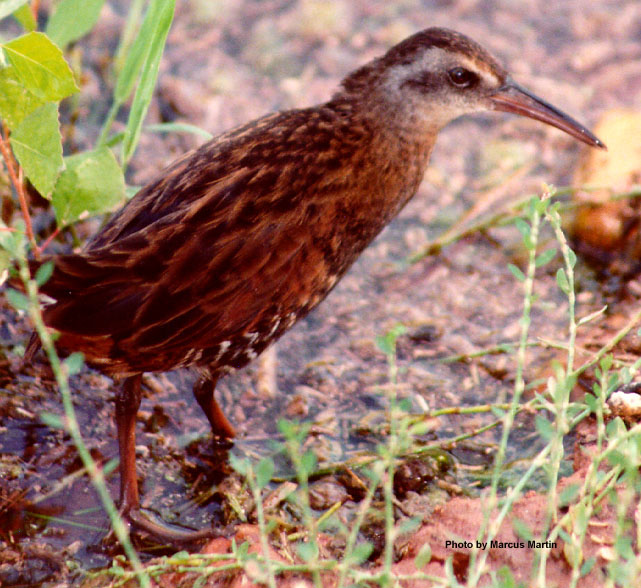
Rallus limicola
(Virginia Rail)
Order: Gruiformes
Order Description: Rails, Coots, Cranes
Family: Rallidae
Family Description: Rails and Coots
Physical Description:
8 1/2-10 1/2" (22-27 cm). Colorfully camouflaged. Cinnamon wings, breast, and neck; back cinnamon with black mottling; darker brown-black and white barred flanks. Gray cheeks and red eyes. Long, slender, orange bill slightly downcurved. Immatures are darker with more black.
Similar Species- Clapper Rail, Sora, Yellow Rail, Black Rail
Song:
Calls include grunts, squeaks, and rapidly descending notes: Wak-wak-wak.
Distribution:
Breeds locally from southern British Columbia to Newfoundland, and south to northwestern Baja California, southern Arizona, west-central Texas, Missouri, Ohio, North Carolina, central Mexico, and South America. Winters from southern British Columbia to northern Baja California, and north to Gulf Coast and North Carolina.
Habitat:
Found in freshwater (occasionally brackish) marshes, mostly in cattails, reeds, and deep grasses.
Diet:
Eats insects and other invertebrates, seeds of aquatic plants, and duckweed.
Ecology:
Builds nest in vegetation, usually in dry area, but occasionally over mud or water. Probes into mud with bill.
Reproduction:
Lays clutch of 5-12 eggs (from April to June on West Coast, May to June or July in central and middle Atlantic and northern states). Incubation lasts about 20 days. Both sexes incubate eggs and tend young, which leave nest soon after hatching.
Conservation:
| Element Code: | ABNME05030 |
| Status: | Protected nongame species |
| Global Rank: | G5 |
| State Rank: | S5 |
| National Rank: | N5B,N5N |
Important State References:
No references are available at this time.
Photo by Marcus Martin,© 1999
Design by Ean Harker©1999, 2000.
Written by Jason Karl, 2000.
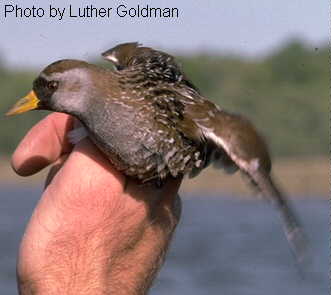
Porzana carolina
(Sora)
Order: Gruiformes
Order Description: Rails, Coots, Cranes
Family: Rallidae
Family Description: Rails and Coots
Physical Description:
8-9 3/4" (20-25 cm). Olive brown above with broad black streaks and fine white lines; gray head, neck and breast; underparts barred black, white, and gray; black face extending partly down neck; short yellow bill; yellow feet. Short tail often held cocked reveals white under tail. Immature is browner and lacks throat patch.
Similar Species- Yellow Rail, Virginia Rail, Common Moorhen, American Coot
Song:
Rapid descending whinny of very short, shrill dee notes. In spring an ascending ner-wee?
Distribution:
Breeds from southeastern Alaska, east to Newfoundland, and south locally to northwestern Baja California, southern New Mexico, eastern Colorado, southern Missouri, central Ohio, and Maryland. Winters regularly from central California, east to southern Texas and Gulf Coast, and south through Central America to portions of South America.
Habitat:
Found primarily in freshwater marshes, less frequently in flooded fields, sometimes foraging on open mudflats adjacent to marshy habitat. Prefers sedges and cattails where mud and water are deep. Also found in swamps and slough borders.
Diet:
Eats mollusks, insects, seeds of marsh plants, and duckweed.
Ecology:
Usually nests on ground or vegetation; occasionally builds nest over water. Frequently conceals nest with vegetation. Forages on ground. Departs dense cover mostly in early morning and evening. roosts communally in cattails or other dense vegetation when not breeding.
Reproduction:
Both sexes incubate 6- 18 eggs (commonly 10-12) for 18-20 days. Young are tended by both parents, and leave nest within 1-2 days (but may return at night for brooding).
Conservation:
| Element Code: | ABNME08020 |
| Status: | Protected nongame species |
| Global Rank: | G5 |
| State Rank: | S5 |
| National Rank: | N5B,N5N |
Important State References:
No references are available at this time.
Photo by Luther Goldman,© 2002
Design by Ean Harker 1999, 2000.
Written by Jason Karl, 2000.

Fulica americana
(American Coot)
Order: Gruiformes
Order Description: Rails, Coots, Cranes
Family: Rallidae
Family Description: Rails and Coots
Physical Description:
13-16" (33-41 cm). Slate gray with black head and neck; ivory bill and forehead topped with red ; red eyes; yellow-green legs extending to big lobed feet; white patches on either side of the tail. Immatures are paler with a duller bill.
Similar Species- Common Moorhen
Song:
Calls varied; mostly raucous, grating croaks and cackles.
Distribution:
Breeds from Alaska (casually), east across parts of Canada, and south (locally) to southern Baja California, Gulf Coast, Florida, and portions of Central America. Winters along Pacific Coast, north to southwestern U.S., lower Ohio Valley, and Maryland, and south through southeastern U.S. and Middle America to Panama and probably Colombia.
Habitat:
Found on calm, open water with plenty of algae and other aquatic vegetation, such as freshwater lakes, ponds, marshes, and larger rivers, wintering also on brackish estuaries and bays. Also found on land bordering these habitats.
Diet:
Eats seeds, roots, and other plant material, insects, snails, small fishes, tadpoles, and other small organisms.
Ecology:
Builds concealed nest over water. Feeds on land and in water. Often found in groups when not breeding.
Reproduction:
Both sexes incubate 6- 22 eggs (most often 8-12 in North America) for 23-24 days. Young are tended by both parents, though brood may be divided between them. Young first fly probably at 7-8 wk.
Conservation:
| Element Code: | ABNME14020 |
| Status: | Game species |
| Global Rank: | G5 |
| State Rank: | S5 |
| National Rank: | N5B,N5N |
Important State References:
No references are available at this time.
Original images provided by Jeff Spendelow,© 1999
Design by Ean Harker©1999, 2000.
Written by Jason Karl, 2000.
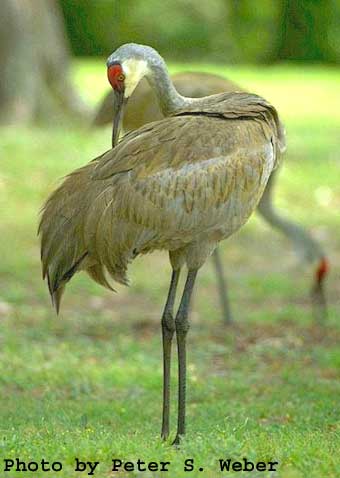
Grus canadensis
(Sandhill Crane)
Order: Gruiformes
Order Description: Rails, Coots, Cranes
Family: Gruidae
Family Description: Cranes
Physical Description:
34-48" (86-122 cm). Gray with bare red patch on crown; often stained with rust from wetlands rich in iron. Long, straight neck; long, dark legs. Immatures are brown.
Similar Species- Immature Whooping Crane
Song:
Gives a long, hollow, rolling garooooooo, audible at great distances
Distribution:
Breeds from northern Alaska and middle arctic Canada, south locally to northeastern California, Nevada, Wyoming, Colorado, South Dakota, and Minnesota. Also breeds in southeastern United States. Winters from southern U.S., south to central Mexico.
Habitat:
Found in open grasslands, marshes, marshy edges of lakes and ponds, river banks, and, occasionally, pine savannas.
Diet:
Feeds on roots, tubers, seeds, grain, berries, earthworms, insects, and small vertebrates (mice, lemmings, birds, snakes, lizards, etc.). Young forage for invertebrates during first few weeks of life. Idaho study found plants made up 73% of diet by volume, with insects and earthworms constituting 27%.
Ecology:
Usually builds concealed nest on ground surrounded by water, or in undisturbed location. roosts at night along river channels, on alluvial islands of braided rivers, or in natural basin wetlands. Communal roost site along open expanse of shallow water is key feature of wintering habitat. Often feeds and rests in fields and agricultural lands; also forages in marshes. Flocks in winter. Mean territory size in Idaho study was 17 ha. Highest reported density is Grays Lake, Idaho -- 200 pairs/10,000 ha. Grays Lake birds migrate in September and October to New Mexico and Arizona.
Reproduction:
Nesting occurs in Idaho from late April-early July. Nests with eggs can be found from: late February-late May in Florida (mean laying date mid-March); April in mid-U.S.; and mid-May in northern range. Both sexes, in turn, incubate usually 2 eggs for 28-30 days. Idaho study found 78% nest success; mean brood size at hatching and fledging was 1.8 and 1.3, respectively. Both parents tend young, which fly at about 2 mo, and remain with parents until following year. Pair usually renests if clutch is lost or abandoned (interval between clutches is 18-20 days in Florida). Usually, only 1 chick survives to fledging. May pair as early as 3 yr, but more commonly at 5-6 yr; in mid-continental North America, most recruitment is by cranes older than 7 yr.
Conservation:
| Element Code: | ABNMK01010 |
| Status: | Protected nongame species |
| Global Rank: | G5 |
| State Rank: | S5 |
| National Rank: | N5B,N5N |
Important State References:
Mullins, W.H. and E.G. Bizeau. 1978. Summer foods of sandhill cranes in Idaho. Auk 95:175-178.
Photos by Marcus Martin,© 1999 and Peter S. Weber,© 2000
Design by Ean Harker©1999, 2000.
Written by Jason Karl, 2000.
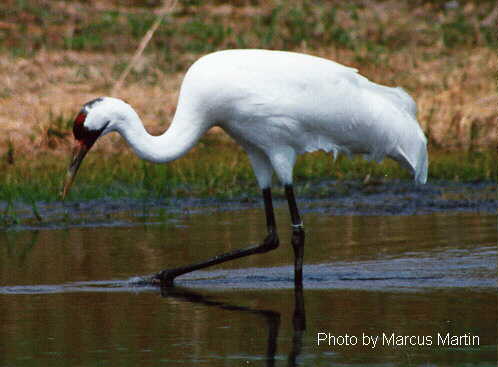
Grus americana
(Whooping Crane)
Order: Gruiformes
Order Description: Rails, Coots, Cranes
Family: Gruidae
Family Description: Cranes
Physical Description:
50-52" (125-131 cm). The tallest North American bird; very rare. White with black wing tips. Long straight neck topped by a red face caused by an exposed patch of red skin on crown and along jaw. Feet and legs dark. Immatures are washed with rust color, especially about the head.
Similar Species- American White Pelican, Snow Goose, Sandhill Crane
Song:
Gives a musical, trumpet-like ker-loo, ker-loo.
Distribution:
Formerly found over much of central and eastern North America; present range is much reduced. Breeds in south-central MacKenzie River District and adjacent northern Alberta. Winters on Gulf Coast of Texas. Introduced in Idaho in Grays Lake National Wildlife Refuge; Idaho population winters in central New Mexico in Bosque del Apache National Wildlife Refuge.
Habitat:
Found in freshwater marshes and wet prairies. During migration and in winter, also found in grain and stubble fields, and on shallow lakes. Winters on salt flats and marshes.
Diet:
During summer, feeds on insects, crustaceans, and berries. Winter diet includes grains, acorns, wolfberry fruit, insects, crustaceans, mollusks, fishes, amphibians, and reptiles. One study found radio-marked migrants fed primarily in variety of croplands.
Ecology:
Nests in dense, emergent vegetation in freshwater marshes, wet prairies, and along lake margins. Constructs mound nest of marsh vegetation; nest rises 20-48 cm above water level. Population has exhibited 10-yr periodicity. Mated pairs and families establish and defend winter territories on coastal marshes in Texas. Breeding territories are very large, averaging 770 ha. Idaho population was re-established through translocation (cross-fostered eggs) to sandhill cranes at Gray's Lake. High mortality (especially juveniles) due to shootings, collisions, and bad weather. No successful breeding occurred in experimental population in Idaho.
Reproduction:
Breeding begins in early May. Pair mates for life. Both sexes, in turn, incubate 2 eggs (sometimes 1-3), for 33-34 days. Nestlings are precocial, are tended by both adults, fledge when no less than 10 wk old, remain with parents until following year (dissociate after arrival on breeding grounds), and reach sexual maturity at 4-6 yr.
Conservation:
| Element Code: | ABNMK01030 |
| U.S. ESA Status: | LEXN |
| Status: | Protected nongame species |
| Global Rank: | G1 |
| State Rank: | SE |
| National Rank: | N1N |
Important State References:
Carlson, G.E. and C.H. Trost. 1992. Sex determination of the whooping crane by analysis of vocalizations. Condor 94:532-536.
Photo by Marcus Martin,© 1999
Design by Ean Harker©1999, 2000.
Written by Jason Karl, 2000.
Charadrius vociferus
(Killdeer)
Link to photo provided by USGS - Patuxent Wildlife Research Center: http://www.mbr-pwrc.usgs.gov/Infocenter/infocenter.html
Order: Charadriiformes
Order Description: Shorebirds, Gulls, Terns
Family: Charadriidae
Family Description: Plovers
Physical Description:
9-11" (23-28 cm). Adults have white underparts and underwings with two contrasting broad black bands across breast (top band completely encircles neck); plain tan above; rump rufous; tail long and tapered with white edges and black subterminal band; upper wing with bold white stripe seen in flight. Black forecrown and face mask separated by white forehead and eyebrow; bill small and black; eyes large and dark.
Similar Species- Other Plovers
Song:
Gives piercing alarm whistles, repeats its name, and trills a dididididididee.
Distribution:
Breeds from Alaska, east through parts of Canada to Newfoundland, and south to southern Baja California, central Mexico, Gulf Coast, southern Florida, and western South America. Winters from southeastern Alaska (rarely), southern British Columbia, central U.S., and New England, south to western Indies and northern South America.
Habitat:
Found in fields, meadows, pastures, mudflats, and shores of lakes, ponds, and rivers; found less commonly along seacoasts.
Diet:
Feeds on small invertebrates on ground surface, but will also feed in shallow water.
Ecology:
Nests in depression on ground, in variety of habitats from unconcealed locations near human habitation, to gravelly, camouflaged areas. Nesting density in several different areas was 13-30 pairs/ha. Forages on ground. Sometimes active on moonlit nights. Adults engage in broken-wing distraction displays. In Idaho study, Killdeer were more abundant in grazed than ungrazed riparian habitat.
Reproduction:
clutch size varies from 3-5 eggs, but is usually 4. Both parents incubate eggs; incubation averages 24-30 days (female may desert second clutch in some areas). Young are attended by both parents, and first fly at about 25 days.
Conservation:
| Element Code: | ABNNB03090 |
| Status: | Protected nongame species |
| Global Rank: | G5 |
| State Rank: | S5,NTMB |
| National Rank: | N5B,N5N |
Important State References:
Medin, D.E. and W.P. Clary. 1990. Bird and small mammal populations in a grazed and ungrazed riparian habitat in Idaho. USDA Forest Service Inter. Res. Sta. Res. Paper INT-245, Boise. 8pp.
Design by Ean Harker©1999, 2000.
Written by Jason Karl, 2000.
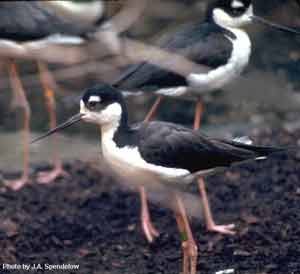
Himantopus mexicanus
(Black-necked Stilt)
Order: Charadriiformes
Order Description: Shorebirds, Gulls, Terns
Family: Recurvirostridae
Family Description: Avocets, Stilts
Physical Description:
13-17" (33-43 cm). Adult male glossy black back, wings, hindneck, crown, and ear; white spot over eye. White below. Long pink-red legs and needle-like black bill. Females and Immatures more brownish back.
Similar Species- American Avocet
Song:
A loud, incessant yapping yip-yip-yip-yip-yip.
Distribution:
Breeds from southern Oregon, Idaho, northern Utah, southern Colorado, eastern New Mexico, central Kansas, coastal Texas and southern Louisiana, south through Middle America to southern Chile and southern Argentina; may also breed in eastern Montana and western South Dakota. Breeds locally on Atlantic Coast from mid-Atlantic states, south to southern Florida. Winters mostly from southern California, southern coastal Texas, and Florida, south through breeding range.
Habitat:
Found in shallow water (salt or fresh) with soft muddy bottom. In Idaho, found on marshes, on flooded meadows and margins of pond, and on lakes and reservoirs; also occupies islands in Snake River.
Diet:
Eats polychaets, crustaceans, snails, and variety of insects (e.g., bugs, beetles, caddisflies, mosquito larvae, grasshoppers). Also feeds on some small fishes, as well as seeds of aquatic plants.
Ecology:
Social; sometimes found in loose groups of up to 50 individuals. Nests in small colonies. Builds nest in depression on ground, frequently in grass. Prefers to wade in shallow pools (up to 30 cm deep) but avoids deep water; plucks food from surface of water or mud, or probes in soft mud.
Reproduction:
Both adults, in turn, incubate 4 eggs about 25 days. Nestlings are precocial. Both adults tend young, which become independent in about 4 wk, and first fly at 7-8 wk.
Conservation:
| Element Code: | ABNND01010 |
| Status: | Protected nongame species |
| Global Rank: | G5 |
| State Rank: | S4 |
| National Rank: | N5B,N5N |
Important State References:
No references are available at this time.
Original images provided by Jeff Spendelow,© 1999
Design by Ean Harker©1999, 2000.
Written by Jason Karl, 2000.
Recurvirostra americana
(American Avocet)
Link to photo provided by USGS - Patuxent Wildlife Research Center: http://www.mbr-pwrc.usgs.gov/Infocenter/infocenter.html
Order: Charadriiformes
Order Description: Shorebirds, Gulls, Terns
Family: Recurvirostridae
Family Description: Avocets, Stilts
Physical Description:
15 1/2-20" (41-51 cm). A tall shorebird with distinctively upcurved bill. Adult has broad black and white stripes on back and inner half of upper wing; primaries black; belly and tail region white; head, neck, and breast light cinnamon in breeding plumage and dusky white in winter; legs long, thin, gray; black bill very long, very fine, distinctly upswept.
Similar Species- Black-necked Stilt, Godwits, Willet
Song:
Broadcasts ringing, repeated kyip calls.
Distribution:
Breeds from parts of southern Canada and Minnesota, south locally to southern California, central Nevada, northern Utah, south-central Colorado, southern New Mexico and San Luis Potosi, and east to central Kansas and coastal Texas. Nonbreeders may summer in usual winter range. Winters from California and southern Texas, south through Mexico, casually in Central America, and locally in southern Florida.
Habitat:
Found in lowland marshes, mudflats, ponds, alkaline lakes, and estuaries.
Diet:
Eats variety of aquatic insects and their larvae, crustaceans, and seeds of aquatic plants.
Ecology:
Nests in depression on ground, or on gravel, mud or vegetation. When breeding, nests in loose colonies. Colony may engage in group distraction displays or mob predators. Individuals walk slowly through water and often feed in flocks that number 12-300 birds. May dive or extend head under surface of water while feeding. May forage by swimming in deep water using their partially webbed feet to swim.
Reproduction:
Breeding begins in mid-April in southern range, to mid-May in north. Both parents incubate 3-4 eggs for 23- 25 days. Young are precocial and tended by both adults, and become independent in about 6 wk.
Conservation:
| Element Code: | ABNND02010 |
| Status: | Protected nongame species |
| Global Rank: | G5 |
| State Rank: | S5 |
| National Rank: | N5B,N5N |
Important State References:
No references are available at this time.
Design by Ean Harker©1999, 2000.
Written by Jason Karl, 2000.
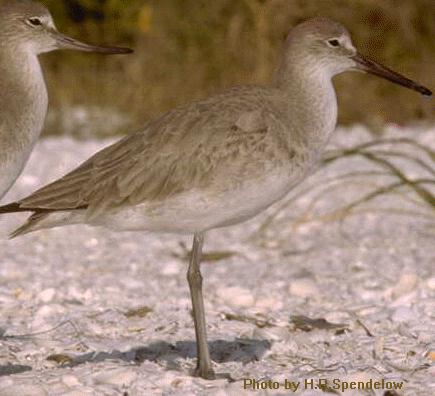
Catoptrophorus semipalmatus
(Willet)
Order: Charadriiformes
Order Description: Shorebirds, Gulls, Terns
Family: Scolopacidae
Family Description: Sandpipers and Phalaropes
Physical Description:
14-17" (36-43 cm). Tall, robust, long-legged, and fairly long- billed, light sand-gray bird with bluish-gray legs. Lighter bellow. May appear slightly streaky. In flight, the black and white wing pattern is visible; from above a white rump patch.
Similar Species- Greater Yellowlegs, Godwits, Wandering Tattler
Song:
Musical, repetitious pill-will-willet, weep-weep-weep, and others.
Distribution:
Breeds locally from eastern Oregon, Idaho, and parts of souht- central Canada, south to east-central California, western Nevada, central Utah, northern Colorado, and parts of Midwest. Also breeds locally along parts of Atlantic and Gulf coasts. Winters north to California and Virginia, and south to South America. Nonbreeders may summer in winter range.
Habitat:
Found in marshes, tidal mudflats, beaches, lake margins, tidal channels, river mouths, coastal lagoons, sandy or rocky shores, and, less frequently, open grasslands.
Diet:
Feeds primarily on small invertebrates (crustaceans, mollusks, insects, and worms).
Ecology
Builds nest (concealed or in open) in depression on beach or flat. When not breeding, forages singly or in small, loose groups, typically in shallow water, on water surface, or in mud. Gathers in large flocks to sleep or rest. Uses separate feeding and nesting areas when breeding. Females show strong fidelity to mate and feeding areas between years. In Idaho study, Willets were more abundant in grazed than ungrazed riparian habitat.
Reproduction:
Female (possibly male, at night) incubates 4 eggs for 22 days. Eggs are laid April-May, depending on range. Young are tended by both parents, and are abandoned at an early age.
Conservation:
| Element Code: | ABNNF02010 |
| Status: | Protected nongame species |
| Global Rank: | G5 |
| State Rank: | S4 |
| National Rank: | N5B,N5N |
Important State References:
Medin, D.E. and W.P. Clary. 1990. Bird and small mammal populations in a grazed and ungrazed riparian habitat in Idaho. USDA Forest Service Inter. Res. Sta. Res. Paper INT-245, Boise. 8pp.
Photo by H.R. Spendelow,© 1999
Design by Ean Harker©1999, 2000.
Written by Jason Karl, 2000.
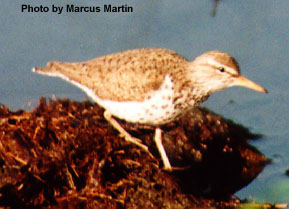
Actitis macularia
(Spotted Sandpiper)
Order: Charadriiformes
Order Description: Shorebirds, Gulls, Terns
Family: Scolopacidae
Family Description: Sandpipers and Phalaropes
Physical Description:
7 1/2-8" (18-20 cm). Olive-brown above, with a white line over the eye and dark line through the eye; a dusky smudge encloses a white wedge near the shoulder. In summer the white underparts are spotted with brown and blackish spots cover above. Bill is orange-pink with dark tip; legs are flesh-colored. No spots in winter.
Similar Species- Solitary Sandpiper, Wandering Tattler
Song:
A clear peet or peet-weet! or repeated weet-weet-weet-weet-weet.
Distribution:
Breeds across portions of Alaska and Canada, south to Oregon, southern California, central Arizona, southern New Mexico, Texas, and parts of southeastern United States. Winters from southwestern British Columbia, western Washington, southern Arizona, southern New Mexico, southern Texas, and coastal southeastern U.S., south to South America.
Habitat:
Found on seacoasts and shores of lakes, ponds, and streams, and occasionally in marshes. Prefers shores with rocks, wood, or debris.
Diet:
Eats mainly small invertebrates.
Ecology:
Builds nest in depression on ground, on elevated site in vegetation or rocks. May form loose colonies when breeding. Obtains food from water surface, or by probing along shores, or sometimes inland. When not breeding, defends individual territory, and forms small flocks to sleep (normally does not flock). In one study, predation by single mink reduced local annual reproductive success from 30-50 chicks fledged to zero.
Reproduction:
Male incubates 4 eggs (usually) for 20-21 days. Female may lay clutch for more than 1 male (polyandrous). Male may change mate if nest fails. Young are attended by male, leave nest soon after hatching, and fly at 13-16 days.
Conservation:
| Element Code: | ABNNF04020 |
| Status: | Protected nongame species |
| Global Rank: | G5 |
| State Rank: | S5 |
| National Rank: | N5B,N5N |
Important State References:
No references are available at this time.
Photo by Marcus Martin, ©1999.
Design by Ean Harker©1999, 2000.
Written by Jason Karl, 2000.
Bartramia longicauda
(Upland Sandpiper)
Link to photo provided by USGS - Patuxent Wildlife Research Center: http://www.mbr-pwrc.usgs.gov/Infocenter/infocenter.html
Order: Charadriiformes
Order Description: Shorebirds, Gulls, Terns
Family: Scolopacidae
Family Description: Sandpipers and Phalaropes
Physical Description:
11-12 1/2" (28-32 cm). Unique shape: Short bill on small head with shoe-button eyes; thin, long neck; long tail and long yellowish legs. Dark brown mottling on back and upper wings, with feathers fringed golden-buff and barred with black; streaked crown with narrow buff median stripe; throat whitish with fine dark streaks becoming larger on lower breast and flanks. Whitish unstreaked belly.
Similar Species- Buff-breasted Sandpiper, Curlews
Song:
Calls a mellow, whistled quip-ip-ip-ip. Song, begins with short rattle, continues with weird windy whistles: whoooleeeeee, wheelooooooooo. First slides up in pitch, second slides down.
Distribution:
Breeds locally from Alaska, east through central Canada and Great Lakes region to southern New Brunswick, and south in interior to eastern Washington, northeastern Oregon, Idaho, Colorado, northwestern Oklahoma, Texas, and parts of Midwest and mid-Atlantic states. Winters in South America.
Habitat:
Found in grasslands (especially prairies), dry meadows, pastures, short-grass savannas, plowed fields, fields around airports, and (in Alaska) scattered woodlands at timberline. Found very rarely (in migration) along shores and mudflats. In Idaho, prefers dry grass prairies, and is not tied to wet areas or shores.
Diet:
Eats mainly insects and other small, terrestrial invertebrates.
Ecology:
Forages on ground. When not breeding, found alone or in small, scattered groups. Has conspicuous habit of whistling while sitting on fence posts. Arrives in Idaho in early May and begins courtship and copulation immediately; engages in high flying as part of courtship. Builds concealed nest in depression on ground in vegetation. Population in Idaho appears restricted to 3 or 4 small colonies.
Reproduction:
Both sexes incubate 4 eggs (usually), for 21-24 days (eggs are laid May-June, depending on range). Both parents tend young, which first fly at 30-31 days.
Conservation:
| Element Code: | ABNNF06010 |
| Status: | Protected nongame species |
| Global Rank: | G5 |
| State Rank: | S1,NTMB |
| National Rank: | N5B |
Important State References:
Taylor, D.M. and C.H. Trost. 1987. The status of rare birds in Idaho. Murrelet 68:69-93.
Design by Ean Harker©1999, 2000.
Written by Jason Karl, 2000.
Numenius americanus
(Long-billed Curlew)
Link to photo provided by USGS - Patuxent Wildlife Research Center: http://www.mbr-pwrc.usgs.gov/Infocenter/infocenter.html
Order: Charadriiformes
Order Description: Shorebirds, Gulls, Terns
Family: Scolopacidae
Family Description: Sandpipers and Phalaropes
Physical Description:
20-26" (51-66 cm). Tall shorebird with a very long (4-8 1/2"), sickle-shaped bill. Warm buff-brown mottling above; brown streaking on neck and on lighter belly. In flight, shows cinnamon wing linings. Long, gray legs. Immature has a much shorter bill and less streaking on breast and throat.
Similar Species- Whimbrel, Ibis
Song:
A loud cur-lee, ascending in pitch. Also a short alarm trill kli-li-lili-lili.
Distribution:
Breeds from southwestern Canada, south to eastern Washington, northeastern California, Nevada, Utah, southern Colorado, New Mexico and northern Texas, and east to southwestern Kansas. Winters from central California, southern Arizona (rarely), northern Mexico, and parts of Gulf Coast states, south to southern Mexico, and irregularly to Central America.
Habitat:
Found in prairies and grassy meadows, generally near water. During migration and in winter, also found on beaches and mudflats. In Idaho, prefers open, recently-grazed shrub steppe containing short vegetation for nesting; often feeds in agricultural areas.
Diet:
Feeds on insects (grasshoppers, beetles, caterpillars, etc.). Eats some berries. During migration, also feeds on crayfishes, crabs, snails, and toads. In Idaho, grasshoppers and carabid beetles are dominant in chick diet. May probe into loose soil for insect larvae. Predation on nestling birds has been observed.
Ecology:
Forages on ground. Idaho study found adults foraged within 10 km of their nest sites; minimum home range approached 1000 ha. Individuals buildnests on ground, frequently in depressions or on slopes. Will sometimes nest on platform. Breeding density has been reported as: about 5-7 males/100 ha in Idaho; 1 pair/6-7 km2 in Saskatchewan; up to 15 territories in 10.4 km2 in Washington In Idaho, predators include canids, mustelids, feral cats, magpies, gulls, and raptors; grazing livestock have damaged nests.
Reproduction:
Curlews arrive in southwestern Idaho in late March. Eggs are laid over 4-7 days. clutch size varies from 3- 5 eggs (in Idaho, average is near 4). Incubation lasts 28-30 days; both sexes incubate eggs. Nestlings are precocial. Young are tended by both parents. Fledging lasts from mid-June until end of July, and success is greater for early nesters. By mid-August, most curlews have departed Idaho.
Conservation:
| Element Code: | ABNNF07070 |
| Status: | Protected nongame species |
| Global Rank: | G5 |
| State Rank: | S3,NTMB |
| National Rank: | N5B,N5N |
Important State References:
Jenni, D., R.L. Redmond, and T. Bicak. 1982. Behavioral ecology and habitat relationships of Long-billed Curlews in western Idaho. USDI Bur. Land Manage. Boise District, Boise. 234 pp.
Design by Ean Harker©1999, 2000.
Written by Jason Karl, 2000.
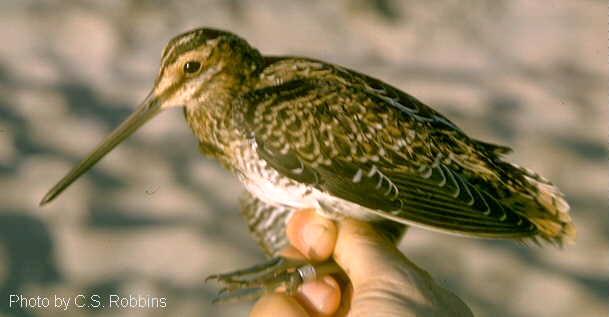
Gallinago gallinago
(Common Snipe)
Order: Charadriiformes
Order Description: Shorebirds, Gulls, Terns
Family: Scolopacidae
Family Description: Sandpipers and Phalaropes
Physical Description:
10 1/2-11 1/2" (26-29 cm). Black-brown, with buff-white stripes and red-brown dots and lines on the back and head. buff to white neck and breast streaked with brown; sides, flanks, and undertail coverts barred with brown. Short, orange tail is rounded. Extremely long, straight bill and short legs.
Similar Species- Dowitchers, American Woodcock
Song:
Call a scratchy zhak when flushed. Song, a measured chip-a, chip-a, chip-a, etc. In high aerial display, tail produces an eerie, pulsing huhuhuhuhuhuhuhu.
Distribution:
Breeds from northern Alaska, east through parts of Canada to Maritime Provinces, and south to southern Alaska, central California, eastern Arizona, New Mexico (probably), Colorado, and parts of Midwest, mid-Atlantic states, and New England. Winters from southern Alaska (rarely), southern British Columbia, Washington, Oregon, Utah, central U.S., and Virginia, south to South America.
Habitat:
Found in wet, grassy, or marshy areas, from tundra to temperate lowlands and hilly regions. In winter and during migration, also found in wet meadows, flooded fields, bogs, swamps, moorlands, and marshy banks of rivers and lakes.
Diet:
Eats mostly insects (especially burrowing larvae), mollusks, crustaceans, and worms; sometimes eats seeds of sedges and grasses.
Ecology:
Nests in depression on ground, under concealing vegetation. When not breeding, forages singly or in loose groups. Feeds by probing into mud or soft soil, or taking some food on surface. Largely crepuscular in feeding, Nocturnal in migration. Usually roosts in flocks.
Reproduction:
Female incubates 4 eggs (usually) for 17-20 days. Young leave nest soon after hatching, are tended by both parents in 2 separate groups, and are capable of sustained flight at about 20 days.
Conservation:
| Element Code: | ABNNF18010 |
| Status: | Game species |
| Global Rank: | G5 |
| State Rank: | S5 |
| National Rank: | N5B,N5N |
Important State References:
No references are available at this time.
Photo by C. S. Robbins. ©2002.
Design by Ean Harker©1999, 2000.
Written by Jason Karl, 2000.
Phalaropus tricolor
(Wilson's Phalarope)
Link to photo provided by USGS - Patuxent Wildlife Research Center: http://www.mbr-pwrc.usgs.gov/Infocenter/infocenter.html
Order: Charadriiformes
Order Description: Shorebirds, Gulls, Terns
Family: Scolopacidae
Family Description: Sandpipers and Phalaropes
Physical Description:
8-10" (20-25 cm). Tall and trim, dark-winged phalarope with white rump. Needlelike black bill slightly longer than head. Gray above, white below. Breeding female: Broad black stripe starting at bill, crossing eyes and descending neck blends into rust-colored stripe that continues down back. Rust and gray mottled on back, wings and tail; legs black. Breeding male: Smaller and duller, with just a wash of cinnamon on the sides of neck and white spot on the hind-neck. In Fall, black fades to gray. Immature: Darker gray above with buff fringes and breast; yellowish legs.
Similar Species- Other Phalaropes, Lesser Yellowlegs
Song:
A low grunting wurk, wurk, wurk.
Distribution:
Breeds from British Columbia and southern Yukon, east across central Prairie Provinces to Great Lakes area and New Brunswick, and south to south- central California, Utah, eastern Arizona, western New Mexico, Texas, and parts of Midwest. Nonbreeders have been recorded in summer north to central Alaska and parts of western Canada. Winters mainly in western and southern South America, and casually north to southern California and southern Texas.
Habitat:
Found in freshwater marshes and wet meadows. When not breeding, also found on lakes, mudflats and salt marshes, along seacoasts, and at sewage ponds; rarely reported at sea.
Diet:
Eats insects (larvae and adults), especially mosquitoes and craneflies. On salt flats, may feed on flies, brine shrimp, and seeds of aquatic plants.
Ecology:
Builds nest on damp ground; ground may be surrounded by water. Sometimes forms loose colonies, or feeds with other species. Feeds as it walk along muddy shores, wades in shallow water, or swims in whirls.
Reproduction:
Breeding begins in mid- to late May. Male incubates 3-4 eggs for about 20 days; female usually leaves before eggs hatch. Nestlings are precocial and downy. Young are tended by male. Female may acquire second mate and lay second clutch.
Conservation:
| Element Code: | ABNNF20010 |
| Status: | Game species |
| Global Rank: | G4 |
| State Rank: | S5 |
| National Rank: | N5B,NZN |
Important State References:
No references are available at this time.
Design by Ean Harker©1999, 2000.
Written by Jason Karl, 2000.
Larus pipixcan
(Franklin's Gull)
Link to photo provided by USGS - Patuxent Wildlife Research Center: http://www.mbr-pwrc.usgs.gov/Infocenter/infocenter.html
Order: Charadriiformes
Order Description: Shorebirds, Gulls, Terns
Family: Laridae
Family Description: Gulls and Terns
Physical Description:
13 1/2-14 1/2" (34-39 cm). In summer, the head is black with a conspicuous broken white eye-ring and red, slender bill, and the breast has a rosy bloom. Back gray; wings gray, ending in a white band and then black tips. Usually have black legs, but sometimes red feet. Immatures are brownish-gray above and white below, with black tail band, and hooded appearance.
Similar Species- Laughing Gull
Song:
A shrill, laughing kuk-kuk-kuk; also mewing cries.
Distribution:
Breeds from Canadian Prairie Provinces, south to east-central Oregon, southern Idaho, northwestern Utah, northwestern Wyoming, northeastern South Dakota, and northwestern Indiana. Nonbreeders occur in summer from east-central British Columbia and northeastern Manitoba, south to northern New Mexico, southeastern Wyoming, Kansas, central Indiana, and Great Lakes. Winters primarily in South America, and casually along coastal Texas and Louisiana.
Habitat:
When breeding, found on sloughs, marshy lakes, and prairie freshwater marshes. When not breeding, found on seacoasts, bays, estuaries, lakes, rivers, marshes, ponds, irrigated fields, and mudflats.
Diet:
Feeds primarily on insects. Also eats aquatic insects and small fishes in small ponds and sloughs.
Ecology:
Builds floating nest anchored to platform of dead reeds. Forms large colonies (up to 15,000-20,000 individuals); largest colony in Idaho is at Gray's Lake National Wildlife Refuge with an estimated 5,000-6,000 nests. Breeders will desert nests if disturbed. Individuals catch prey in air and follow farmers' plows to feed on unearthed insects and their larvae.
Reproduction:
Breeding begins early May to early June. Both sexes incubate 2-3 eggs for about 18-20 days. Nestlings are semi-precocial. Young are tended by both adults.
Conservation:
| Element Code: | ABNNM03020 |
| Status: | Protected nongame species |
| Global Rank: | G5 |
| State Rank: | S2 |
| National Rank: | N4B,NZN |
Important State References:
Trost, C.H. and A. Gerstell. 1994. Status and distribution of colonial nesting waterbirds in southern Idaho, 1993. Dept. Biol. Sciences, Idaho St. Univ., Pocatello. 74pp.
Design by Ean Harker©1999, 2000.
Written by Jason Karl, 2000.
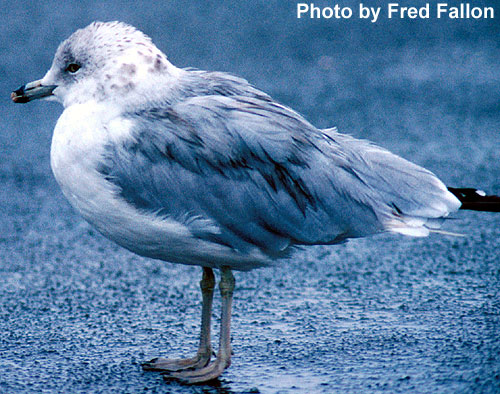
Larus delawarensis
(Ring-billed Gull)
Order: Charadriiformes
Order Description: Shorebirds, Gulls, Terns
Family: Laridae
Family Description: Gulls and Terns
Physical Description:
17 1/2-21" (44-53 cm). Adults have white head, neck, underparts, and tail; wing tips black with large white spots; extensive blackish on underside of primaries; bill yellow with narrow black ring completely encircling the bill; feet yellow; reddish eye-ring. Immatures have pinkish bill with black tip; gray-brown above with whitish underparts; white tail with narrow black subterminal band; pinkish legs.
Similar Species- Mew, Herring, and California Gulls
Song:
A high pitched, shrill kyow kyow kyow.
Distribution:
Breeds from Washington east to Manitoba, and south to northeastern California, Colorado, and South Dakota. Also breeds in eastern U.S. and Canada. Nonbreeders occur in summer north to central Alaska, portions of western Canada, and south through wintering range. Winters coastally from southern British Columbia to southern Mexico (rarely south to Central America). Also winters on East Coast and in interior from Great Lakes to central Mexico.
Habitat:
Found on seacoasts, bays, estuaries, rivers, lakes, ponds, irrigated fields and plowed lands, and in cities and dumps. In Idaho, often associated with California Gulls, but nests in more vegetated areas.
Diet:
Feeds opportunistically on various animals, plant material, and garbage. Also eats insects and fruits.
Ecology:
Forages on land or water surface, or sometimes in vegetation; may take prey in air. Builds nest in matted vegetation on islands. Forms colonies. Pirates other nests. Fox predation may result in reproductive failure of local breeding colonies.
Reproduction:
Both sexes incubate usually 3 eggs (2.2-3.0 eggs in Idaho) for about 21 days. Young are tended by both parents, are fed until able to fly, and usually attain adult plumage in 3 yr. Adults may form female-female pairs or polygynous trios. In Idaho, colony size averages over 2000 nests.
Conservation:
| Element Code: | ABNNM03100 |
| Status: | Protected nongame species |
| Global Rank: | G5 |
| State Rank: | S2 |
| National Rank: | N5B,N5N |
Important State References:
Trost, C.H. and A. Gerstell. 1994. Status and distribution of colonial nesting waterbirds in southern Idaho, 1993. Dept. Biol. Sciences, Idaho St. Univ., Pocatello. 74pp.
Photo by Fred Fallon, ©2002.
Design by Ean Harker©1999, 2000.
Written by Jason Karl, 2000.
Larus californicus
(California Gull)
Link to photo provided by USGS - Patuxent Wildlife Research Center: http://www.mbr-pwrc.usgs.gov/Infocenter/infocenter.html
Order: Charadriiformes
Order Description: Shorebirds, Gulls, Terns
Family: Laridae
Family Description: Gulls and Terns
Physical Description:
20-23" (51-58 cm). Adults have white head, underparts, and tail; back and wings dark gray; wing tips black with large white spots; red and black spot on the lower mandible; dark eyes with reddish eye-ring; legs yellow-green. Immatures mottled with brown both above and on underparts; tail mostly all dark; bill gray-pink with subterminal black bar; legs pinkish; lack eye-ring.
Similar Species- Herring and Ring-billed Gulls
Song:
A shuddering, repetitive kee-yah.
Distribution:
Breeds from parts of western Canada, south to east-central North Dakota, central Montana, northwestern Wyoming, eastern Idaho, northwestern Utah, Northwestern Nevada, eastern California, southeastern Oregon, and southern Washington. Winters from southern Washington and eastern Idaho, south along Pacific Coast to southern Baja California and northwestern mainland Mexico.
Habitat:
Found on seacoasts, bays, estuaries, mudflats, marshes, irrigated fields, lakes, ponds, dumps, agricultural lands, and in cities.
Diet:
In inland areas, feeds on mice and insects (crickets, grasshoppers, and cutworms). Along the coast, feeds on dead fish and garbage; scavenges behind boats and around harbors and dumps.
Ecology:
Builds nest in depression on ground; in Idaho, nests are typically on islands. May gather in large flocks, often in association with Ring-billed or other gulls. Species is colonial; colony size in Idaho averages about 4000 nests. Although Great Horned Owl may cause significant mortality in breeding colony, colonial waterbird surveys conducted between 1984 and 1994 indicate that California Gull numbers have increased three-fold during this time period.
Reproduction:
Breeding begins in late April in southern range, to early June in north. Both sexes incubate 3 eggs for 23-27 days (2.2-2.6 eggs in Idaho). Nestlings are semi-precocial and downy. Young are tended by both parents. Adults may form female-female pairs.
Conservation:
| Element Code: | ABNNM03110 |
| Status: | Protected nongame species |
| Global Rank: | G5 |
| State Rank: | S3 |
| National Rank: | N5B,N5N |
Important State References:
Trost, C.H. and A. Gerstell. 1994. Status and distribution of colonial nesting waterbirds in southern Idaho, 1993. Dept. Biol. Sciences, Idaho St. Univ., Pocatello. 101pp.
Design by Ean Harker©1999, 2000.
Written by Jason Karl, 2000.
Sterna caspia
(Caspian Tern)
Link to photo provided by USGS - Patuxent Wildlife Research Center: http://www.mbr-pwrc.usgs.gov/Infocenter/infocenter.html
Order: Charadriiformes
Order Description: Shorebirds, Gulls, Terns
Family: Laridae
Family Description: Gulls and Terns
Physical Description:
19-23" (48-58 cm). Large, bulky tern with a shallowly forked tail. Black cap with a slight crest; large, spear-shaped, red bill with a dark tip; streaked forehead. Extensive black primaries on underside.
Similar Species- Elegant and Royal Terns
Song:
A hoarse, low kraa-uh, deeper than other terns; also repeated kaks. Immature birds utter a high, whistled whee-you.
Distribution:
Breeds locally (mostly in interior, but on coast in Washington and California) in Washington, eastern Oregon, northern Utah, northwestern Wyoming, Idaho (recent range expansion), and North Dakota, south to southern California, western Nevada and northern Mexico. Also breeds in portions of Canada, and locally on Atlantic and Gulf coasts and U.S. Great Lakes. Winters mainly north to California and North Carolina, and south to Mexico, sometimes to northern South America.
Habitat:
Found on seacoasts, bays, estuaries, lakes, marshes, and rivers.
Diet:
Eats mainly fishes, but will also eat eggs and young of other terns and gulls.
Ecology
Least gregarious tern; nests singly, or may form colonies of up to several thousand pairs (in Idaho, average colony size is 11.5 nests). Nests in rocks or on ground (in Idaho, nesting sites are on islands). When not breeding, often rests with flocks of other terns. Dives from air to obtain food at water surface; sometimes feeds from surface like a gull.
Reproduction:
clutch varies from 2-3 eggs. Both parents incubate eggs (20-22 days) and tend young, which leave nest in a few days, and first fly at 4-5 wk.
Conservation:
| Element Code: | ABNNM08020 |
| Status: | Protected nongame species |
| Global Rank: | G5 |
| State Rank: | S1 |
| National Rank: | N4N5B,N4N |
Important State References:
Trost, C.H. and A. Gerstell. 1994. Status and distribution of colonial nesting waterbirds in southern Idaho, 1993. Dept. Biol. Sciences, Idaho St. Univ., Pocatello. 74pp.
Design by Ean Harker©1999, 2000.
Written by Jason Karl, 2000.
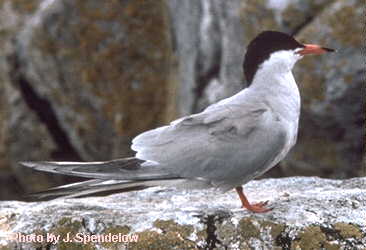
Sterna hirundo
(Common Tern)
Order: Charadriiformes
Order Description: Shorebirds, Gulls, Terns
Family: Laridae
Family Description: Gulls and Terns
Physical Description:
13-16" (33-41 cm). A medium-sized, slender tern with long, deeply forked tail. Breeding adults are white, with pearl gray back and wings, and a black cap; dark outer and light inner primary feathers; bill red-orange with a black tip; feet red- orange. Winter adults and immatures: black cap is reduced to nape and eye line, and the bill is blackish.
Similar Species- Forster's Tern, Arctic Tern
Song:
A harsh, drawling kee-arr (downward inflection), also a quick, sharp kik-kik-kik.
Distribution:
Breeds from northern Alberta, east across parts of Canada to southern Labrador, and south to eastern Washington, northeastern Montana, portions of Great Plains, Midwest, and New England, and Gulf Coast (locally). Winters from Baja California and South Carolina, south to Peru and northern Argentina. In Idaho, has recently nested at American Falls Reservoir.
Habitat:
Found on seacoasts, estuaries, bays, lakes, rivers, and marshes.
Diet:
Eats mainly small fishes and crustaceans.
Ecology:
Dives from air to obtain food at water surface. Nests on ground, amid sand, shells, or pebbles. Found singly or in small, loose groups when not breeding; sometimes forms large flocks during migration. Two-year study found fish abundance affected reproductive performance. In Massachusetts study, loss of eggs and chicks was attributed to nocturnal desertion of nests by adults in response to predation by Great Horned Owl. Susceptible (especially females, just prior to laying) to poisoning from toxin accumulated in fishes.
Reproduction:
Female incubates 2-3 eggs (laid mostly May-July) for 21-27 days. Both sexes tend young, which may leave nest after 3 days (but return for brooding), and first fly at about 4 wk. Female may lay 2 clutches/yr, but second brood rarely fledge.
Conservation:
| Element Code: | ABNNM08070 |
| Status: | Protected nongame species |
| Global Rank: | G5 |
| State Rank: | S1 |
| National Rank: | N5B,NZN |
Important State References:
Trost, C.H. and A. Gerstell. 1994. Status and distribution of colonial nesting waterbirds in southern Idaho, 1993. Dept. Biol. Sciences, Idaho St. Univ., Pocatello. 74pp.
Photo by Jeff Spendelow,© 1999
Design by Ean Harker©1999, 2000.
Written by Jason Karl, 2000.
Sterna forsteri
(Forster's Tern)
Link to photo provided by USGS - Patuxent Wildlife Research Center: http://www.mbr-pwrc.usgs.gov/Infocenter/infocenter.html
Order: Charadriiformes
Order Description: Shorebirds, Gulls, Terns
Family: Laridae
Family Description: Gulls and Terns
Physical Description:
14-16 1/4" (36-41 cm). A slender, graceful, gull-like bird with a black cap, long, pointed wings; and a deeply forked tail. Breeding adults have pale gray back and wings with frosty tips, whitish primaries, and gray tail. Bright orange-red bill with black tip; legs orange. Winter adults and immatures only have black patch around eye; bill black.
Similar Species- Common Tern, Arctic Tern
Song:
A harsh, nasal aaaap; a low, nasal kyarr; a buzzy zraa; and a high-pitched kyer.
Distribution:
Breeds from central Prairie Provinces of Canada, south to southern California, western Nevada, southern Idaho, northern Utah, northern and eastern Colorado, and portions of Midwest. Also breeds along portions of Gulf and Atlantic coasts. Winters from central California and Baja California, south to Central America, and from northern Mexico to portions of Gulf and East coasts.
Habitat:
Found on freshwater and salt marshes. During migration and in winter, also found on seacoasts, bays, estuaries, rivers, and lakes.
Diet:
Eats insects and fishes.
Ecology:
When not breeding, found singly or in small, loose groups. Frequently nests in loose colonies; vigorously defends nest. In Idaho, average colony size is small -- 8.1 nests. Builds platform nest on water, or may nest independently on ground or sand. Intolerant of other birds, but American Coot may parasitize nest. Snatches food off surface of water while in flight, or dives into water.
Reproduction:
Both sexes incubate 3- 4 eggs for about 23-24 days. Nestlings are semi-precocial and downy. Young are tended by both adults until capable of flight.
Conservation:
| Element Code: | ABNNM08090 |
| Status: | Protected nongame species |
| Global Rank: | G5 |
| State Rank: | S2 |
| National Rank: | N5B,N5N |
Important State References:
Trost, C.H. 1994. Status and distribution of colonial waterbirds in northern Idaho and selected species in southern Idaho, 1994. Dept. Biol. Sciences, Idaho St. Univ., Pocatello. 31pp.
Design by Ean Harker©1999, 2000.
Written by Jason Karl, 2000.
Chlidonias niger
(Black Tern)
Link to photo provided by USGS - Patuxent Wildlife Research Center: http://www.mbr-pwrc.usgs.gov/Infocenter/infocenter.html
Order: Charadriiformes
Order Description: Shorebirds, Gulls, Terns
Family: Laridae
Family Description: Gulls and Terns
Physical Description:
9-10 1/4" (23-26 cm). A small, dark tern with black bill. Breeding adult: Head and underparts black; back, wings, and top of slightly forked tail dark gray. Wing linings and undertail coverts white. In fall and winter have gray back and wings, white underparts, and white head with dark hood.
Song:
Call a sharp kip, krik, or keek.
Distribution:
Breeds from British Columbia, across portions of Canada to Nova Scotia, and south locally to southern California, Colorado, portions of Midwest, and northern New England. Winters along both coasts, and from Panama to Peru and Surinam.
Habitat:
Prefers sheltered, offshore waters and bays; comes to shore chiefly during migrations or when breeding, when it is found along seacoasts, bays, estuaries, lagoons, lakes, and rivers.
Diet:
Eats insects and other invertebrates, including small fishes and crustaceans.
Ecology:
Gregarious. Forms loose nesting colonies, sometimes in association with Forster'sTern. Usually builds floating platform nest in vegetation. Feeds from surface of saltwater, forages on vegetation, or plucks food from air.
Reproduction
Both sexes incubate 3 eggs (usually), for 20-24 days. Both parents tend young, which first fly at about 3 wk, and become fully fledged at about 4 wk.
Conservation:
| Element Code: | ABNNM10020 |
| Status: | Protected nongame species |
| Global Rank: | G4 |
| State Rank: | S2 |
| National Rank: | N4B,NZN |
Important State References:
Trost, C.H. 1994. The status and distribution of colonial waterbirds in northern Idaho and selected species in southern Idaho, 1994. Dept. Biol. Sciences, Idaho St. Univ., Pocatello. 31pp.
Design by Ean Harker©1999, 2000.
Written by Jason Karl, 2000.
Zenaida macroura
(Mourning Dove)
Link to photo provided by USGS - Patuxent Wildlife Research Center: http://www.mbr-pwrc.usgs.gov/Infocenter/infocenter.html
Order: Columbiformes
Order Description: Pigeons, Doves
Family: Columbidae
Family Description: Pigeons and Doves
Physical Description:
11-13" (28-33 cm). Brown above with somewhat darker tail and wings and pale buffy below. Long, pointed tail with large white spots on outside edges and dark spots along inside edge. Nape and sides of neck have a purple sheen; black spot on side of head below ear patch; bill dark; light blue eye-ring.
Similar Species- White-winged Dove, Inca Dove, Band-tailed Pigeon, Ringed Turtle-Dove, Spotted Dove, Eurasian Collared Dove
Song:
A hollow, mournful cooo, cooo, coo. First one or two notes often not heard.
Distribution:
Breeds from southern Canada and possibly southeastern Alaska, south to Panama. Winters in breeding range, except for northernmost populations, which migrate farther south to winter.
Habitat:
Found in open woodlands, forest edges, cultivated lands with scattered trees and bushes, parks and suburban areas, arid and desert country (generally near water), and second growth. Occupies wide variety of habitats from northern to southern Idaho, but prefers lower elevations and open regions.
Diet:
Feeds on wide variety of wild seeds, as well as waste grain (wheat, corn, rye, oats, etc.). Also eats some insects, but about 98% of diet is seeds.
Ecology:
Usually forages on ground. May fly long distances in search of water; Idaho study found doves in desert moved an average of 3.7 km from feeding and loafing sites to watering sites. Individuals nest in trees, on ground, or in nests of other species. In Idaho, species is highly migratory, nesting throughout state, but wintering in small, localized flocks; greatest numbers migrate south after summering and breeding.
Reproduction:
Protracted breeding season. Both sexes (male diurnally) incubate usually 2 eggs for 13-15 days. Young are fed by at least 1 parent for 27 days (mainly by male after 16 days). Pair forms life-long bond, and may raise 2-5 broods/yr. Breeding population trends in Idaho have declined from 1966-1987, as they have throughout the western U.S.
Conservation:
| Element Code: | ABNPB04040 |
| Status: | Game species |
| Global Rank: | G5 |
| State Rank: | S5,NTMB |
| National Rank: | N5 |
Important State References:
Reeves, H.M., R.E. Tomlinson, and J.C. Bartonek. 1993. Population characteristics and trends in the western management unit. Pp. 341-376 in T.S. Basket et al., eds. Ecology and management of the mourning dove. Stackpole Books, Harrisburg, PA.
Design by Ean Harker©1999, 2000.
Written by Jason Karl, 2000.
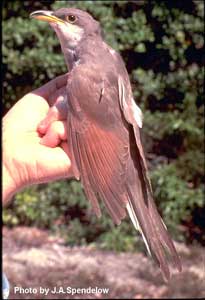
Coccyzus americanus
(Yellow-billed Cuckoo)
Order: Cuculiformes
Order Description: Cuckoos
Family: Cuculidae
Family Description:Cuckoos
Physical Description:
11-13 1/2" (28-34 cm). A long, slender bird with, gray-brown back, and white underparts. Red-brown in primary feathers of the wings, most noticeable in flight; long, black tail with large white spots at tips of undertail feathers. Yellow lower mandible on the slightly curved bill.
Similar Species- Black-billed Cuckoo
Song:
Song is a long, rapid, throaty ka-ka-ka-ka-ka-ka-ka-ka-ka-ka-ka-ka-kow-kow- kowlp-kowlp--kowlp--kowlp, slowing toward the end.
Distribution:
Breeds from interior California, east to northern Utah, Minnesota, and New Brunswick, and south to southern Baja California, Mexico, and Gulf Coast. Winters in southern Central America and South America.
Habitat:
Found in open woodlands (especially where undergrowth is thick), parks, and deciduous riparian woodlands. When not breeding, found in forests, woodlands, and scrub. In Idaho, occupies riparian areas with thick understory.
Diet:
Eats mainly caterpillars. Will also eat other insects, some fruits, and occasionally, small lizards and frogs.
Ecology:
Buiilds untidy nest in tree or shrub; occasionally uses nest of other species. Forages or hovers in foliage. Rare in Idaho, and present only in summer. Species is declining in parts of range due to deterioration of riparian habitat.
Reproduction:
Female (usually) incubates 2-6 eggs (commonly 3-5), for about 14 days. Both parents tend young, which climb in branches at 7-9 days.
Conservation:
| Element Code: | ABNRB02020 |
| Status: | Protected nongame species |
| Global Rank: | G5 |
| State Rank: | S1 |
| National Rank: | N5B |
Important State References:
Taylor, D.M. and C.H. Trost. 1987. The status of rare birds in Idaho. Murrelet 68:69-93.
Original images provided by Jeff Spendelow,© 1999
Design by Ean Harker©1999, 2000.
Written by Jason Karl, 2000.
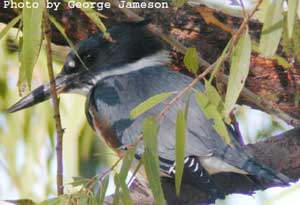
Ceryle alcyon
(Belted Kingfisher)
Order: Coraciiformes
Order Description: Kingfishers
Family: Alcedinidae
Family Description: Kingfishers
Physical Description:
11-14 1/2" (28-36 cm). A large-headed bird with ragged, bushy crest and large, heavy, spear-shaped bill. Males are bluish-gray above and white below with broad gray-blue breast band. Female has a second rust-colored band on upper belly, below the bray-blue one.
Similar Species- Green Kingfisher
Song:
Call is a loud, harsh, dry, staccato rattle, often prolonged.
Distribution:
Breeds from western and central Alaska, east across portions of Canada to Labrador, and south to southern California, southern Texas, Gulf Coast, and southern Florida. Winters in south-coastal and southeastern Alaska, British Columbia, Colorado, southern Great Lakes region, and New England, and south to northern South America (rare).
Habitat:
Found primarily along water (both freshwater and marine), including lakes, wooded creeks and rivers, seacoasts, bays, and estuaries.
Diet:
Eats mainly fishes, but will also eat various other vertebrates and invertebrates.
Ecology:
Solitary except during breeding period. Usually nests in burrow constructed in bank near water. In some areas, availability of foraging sites may be more limiting than availability of nest sites. Obtains food by diving into water from air or perch.
Reproduction:
Both sexes incubate 5- 8 eggs (usually 6-7), for 23-24 days. Young leave nest after 30-35 days.
Conservation:
| Element Code: | ABNXD01020 |
| Status: | Protected nongame species |
| Global Rank: | G5 |
| State Rank: | S5,NTMB |
| National Rank: | N5B,N5N |
Important State References:
No references are available at this time.
Photo by George Jameson, ©2002
Design by Ean Harker©1999, 2000.
Written by Jason Karl, 2000.
Tyto alba
(Common Barn-owl)
Link to photo provided by USGS - Patuxent Wildlife Research Center: http://www.mbr-pwrc.usgs.gov/Infocenter/infocenter.html
Order: Strigiformes
Order Description: Owls
Family: Strigidae
Family Description: Typical Owls
Physical Description:
14-20" (36-51 cm). Medium-sized owl. White, heart-shaped face ringed with tan with dark eyes and light bill; no ear tufts. White below, sparsely spotted black; golden tan back with fine pearl gray streaks; spotted black and white on crown, back, and wings.
Similar Species- Short-eared Owl, immature Snowy Owl
Song:
A loud, almost blood-curdling, rasping hiss.
Distribution:
Resident from southern Canada and northern U.S., south to South America. Northern populations are partially migratory.
Habitat:
Found in wide variety of situations in open and partly-open country. Frequently found around human habitation.
Diet:
Eats mainly small mammals. In many areas (including southern Idaho), voles are principal prey. Pocket gophers, ground squirrels, pocket mice, kangaroo rats, and deer mice are locally important.
Ecology:
Nests in cavity in standing snag, cliff, or building. Breeding density depends on availability of nest sites and food supply. Young disperse widely from natal area (up to hundreds or 1900 km has been documented). Home ranges may overlap considerably where nest sites and prey are abundant. Individual remains solitary or paired when not breeding. Hunts mostly at night, from about 1 hr after sunset to about 1 hr before sunrise. May forage up to a few km from nesting or roosting site. Hunts mainly by quartering flights 1.5-4.5 m above ground. In northern winter, often roosts in dense conifers; also roosts in nest boxes, barns, and silos. Susceptible to starvation during prolonged low temperatures and snow cover. In Utah study, most adults survived only 1 breeding season. Great Horned Owl is principal predator in North America. Long-term study of breeding density and foraging ecology continues in Idaho Birds of Prey Area.
Reproduction:
Breeds throughout year in Texas (as many as 3 broods/year); some California birds attempt 2 broods/year. Average clutch size is 4-6 eggs. Female incubates eggs (21-24 days for single egg, 29-34 days for full clutch). Female broods and feeds young, male brings food. In Utah study, mean fledging time was 64 days. Male may care for fledged young as female begins second clutch. Most individuals apparently breed at 1 yr. Pair are typically monogamous with life-long pair bond; polygyny sometimes occurs.
Conservation:
| Element Code: | ABNSA01010 |
| Status: | Protected nongame species |
| Global Rank: | G5 |
| State Rank: | S3 |
| National Rank: | N5 |
Important State References:
Marti, C.D. 1988. A long-term study of food-niche dynamics in the common barn- owl: comparisons within and between populations. Can. J. Zool. 66:1803-1812.
Design by Ean Harker©1999, 2000.
Written by Jason Karl, 2000.
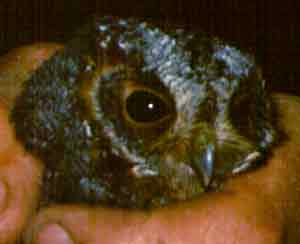
Otus flammeolus
(Flammulated Owl)
Order: Strigiformes
Order Description: Owls
Family: Strigidae
Family Description: Typical Owls
Physical Description:
6-7" (15-18 cm). Has small, indistinct ear tufts and dark eyes on a brownish-gray face framed by black. Grayish above with largish white spots on shoulders; light below, with white and rust-colored markings.
Similar Species- Screech-owls
Song:
A low, mellow hoot, single or double, is repeated almost endlessly, and sounds mechanical.
Distribution:
Breeds locally from southern and southeastern British Columbia, north-central Washington, eastern Oregon, Idaho, western Montana, and northern Colorado, south to portions of southwestern states and central Mexico. Winters from central Mexico, south in highlands to Guatemala and El Salvador, and casually north to southern California.
Habitat:
Found in montane forests; associated mainly with ponderosa or Jeffrey pine (often intermixed with aspen in northern range, oaks in southern range, Douglas-fir in British Columbia). In areas with warm, dry summers, also found locally in spruce/fir and lodgepole pine/red fir. During migration, found in wooded areas in lowlands and mountains. Prefers old growth. In Idaho, occupies older ponderosa pine, Douglas-fir, and mixed coniferous forests.
Diet:
Feeds on various insects (e.g., moths, beetles, grasshoppers, crickets, and caterpillars). May eat small mammals or birds.
Ecology:
Nocturnal. Foraging tactics include hawk-gleaning, hawking, hover-gleaning, and drop-pouncing. Nests in cavity (old woodpecker hole) in standing snag. In Colorado study, nesting home ranges averaged 14 ha; foraging activity was concentrated in 1-4 areas within home range. During nesting period in Colorado, foraging activity peaked 15-30 min after sunset and 1-1.5 hr before sunrise; birds ceased activity during snow or rain. One study found generally fewer than 4 singing males/40 ha in Oregon, British Columbia, and Colorado. Surveys in Idaho report densities up to 1.24 males/40 ha.
Reproduction:
Female incubates 2-4 eggs (usually 3), for 21-22 days; male brings food. Nestling period has been reported as 22-24 nights and 21-23 days; fledglings are tended by both parents (in Colorado, parents divide brood).
Conservation:
| Element Code: | ABNSB01020 |
| Status: | Protected nongame species |
| Global Rank: | G4 |
| State Rank: | S3,NTMB |
| National Rank: | N4B |
Important State References:
Moore, T.L. and G.D. Frederick. 1991. Distribution and habitat of flammulated owls (Otus flammeolus) in west-central Idaho. Idaho Dept. Fish & Game, Boise. 28pp.
Photo by C. Trost, ©2000.
Design by Ean Harker©1999, 2000.
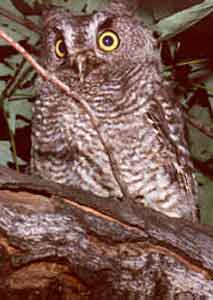
Otus kennicottii
(Western Screech-owl)
Order: Strigiformes
Order Description: Owls
Family: Strigidae
Family Description: Typical Owls
Physical Description:
7-10" (18-25 cm). Small owl with ear tufts and usually gray camouflage coloring. A black-rimmed facial disk surrounds clear yellow eyes and a dark bill. Underparts grayish-white with black vertical streaks and fine gray cross-bars. Prominent white spots on the shoulders.
Similar Species- Eastern Screech-Owl, Whiskered Screech-Owl
Song:
An accelerating "bouncing ball" series of hollow whistles, often dropping in pitch toward the end.
Distribution:
Resident from south-coastal and southeastern Alaska, coastal and southern British Columbia, northern Idaho, western Montana, southeastern Colorado, and western Oklahoma, south to southern Baja California, northern Mexico, and western Texas. Apparently has moved north into southern Alberta.
Habitat:
Found in woodlands (especially oak and riparian woodlands), and in scrub. In central Idaho, screech owls are limited in distribution by occurrence of deciduous riparian habitat, but are occasionally found in aspen.
Diet:
Feeds mainly on small mammals (mice and shrews), insects, birds, and sometimes other small vertebrates. Diet may vary seasonally and geographically, depending on local prey abundance.
Ecology:
Nocturnal. Nests in cavity in standing snag; may nest in crevice in building, in abondoned magpie nest, or in nest box. Hunts from perch; captures prey on ground. In central Idaho, home ranges of 2 radio- tagged birds were reported as 3-9 ha and 29-58 ha. Distance between adjacent pairs varies from about 50 to a few hundred m. Recent study in southwestern Idaho examined timing of dispersal and post-fledging movements using radiotelemetry and videotaping.
Reproduction:
clutch size averages 3-4 eggs; incubation by female lasts about 26 days.
Conservation:
| Element Code: | ABNSB01040 |
| Status: | Protected nongame species |
| Global Rank: | G5 |
| State Rank: | S4 |
| National Rank: | N5 |
Important State References:
Ellsworth, E.A., J.E. Emerson, J.R. Belthoff, and J. Doremus. 1994. Post-fledging movements and dispersal timing of western screech owls. Pp. 285-288 in K. Steenhof, Ed., Snake River Birds of Prey National Conservation Area, 1994 Annual Rep., USDI Bur. Land Mange., Boise District.
Photo by Jim Nestler,© 2002
Design by Ean Harker©1999, 2000.
Written by Jason Karl, 2000.
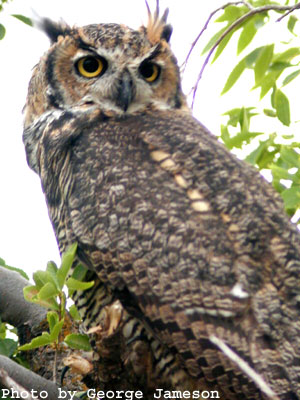
Bubo virginianus
(Great Horned Owl)
Order: Strigiformes
Order Description: Owls
Family: Strigidae
Family Description: Typical Owls
Physical Description:
18-25" (46-64 cm). Large owl with ear tufts set wide apart. Mottled gray-brown above with closely spaced, fine dark gray horizontal barring below. Conspicuous white throat bib below a tawny face.
Similar Species- Long-eared Owl
Song:
A deeply resonant hooting, usually uttered 5-6 times.
Distribution:
Breeds from western and central Alaska, east to southern Keewatin and Labrador, and south to southern South America. Winters generally throughout breeding range. Northernmost populations are partially migratory, wintering south to southern Canada and northern United States. Species is most common and widely distributed owl in Idaho.
Habitat:
Found in various moist or arid forested habitats, from lowland forests (deciduous or evergreen) to open temperate woodlands, including second-growth forests, swamps, orchards, riverine forests, brushy hillsides, and desert.
Diet:
Broad diet; eats mainly mammals (commonly mouse to rabbit size), and small to large birds (including hawks and waterfowl) but also amphibians, reptiles, and invertebrates. Idaho study found voles and deer mice were main food items. Parents provide about 300 g of food per day, per nestling.
Ecology:
Hunts from perch; captures prey on ground. Caches food. Utilizes abandoned stick nest in tree, cliff ledge, or man- made platform. Productivity peaks with snowshoe hare population in northern range. Size of home range varies seasonally and geographically. density varies, but is usually about 1 pair/5-21 km2. Idaho study found density of 1.7 owls/10 km2; juvenile survival was 1.8/nest.
Reproduction:
Female incubates 2-3 eggs for 26-35 days; male supplies food. Young leave nest at 4-5 wk, fly well at 9-10 wk, and are dependent on parents for several wk. Most yearling females do not nest. Female may re-lay if first clutch is lost.
Conservation:
| Element Code: | ABNSB05010 |
| Status: | Protected nongame species |
| Global Rank: | G5 |
| State Rank: | S5 |
| National Rank: | N5 |
Important State References:
Frounfelker, C.R. 1977. Prey selection of the great horned owl with reference to habitat and prey availability. M.S. Thesis, Univ. Idaho, Moscow. 62pp.
Photo by George Jameson, ©2002
Design by Ean Harker©1999, 2000.
Written by Jason Karl, 2000.
Glaucidium gnoma
(Northern Pygmy-owl)
Link to photo provided by USGS - Patuxent Wildlife Research Center: http://www.mbr-pwrc.usgs.gov/Infocenter/infocenter.html
Order: Strigiformes
Order Description: Owls
Family: Strigidae
Family Description: Typical Owls
Physical Description:
6 3/4-7 1/2" (17-19 cm). A very small owl with long, finely barred tail. Small round head has no ear tufts and two white-edged black spots at back of neck suggesting eyes. Brown with fine buff spotting on head and streaked flanks; white spots on wings; bolder brown streaks on white belly and breast. Eyes clear yellow.
Similar Species- Ferruginous Pygmy-Owl
Song:
A series of hollow whistles ending with 2-3 deliberate notes on one pitch. Also a rapid trill or rattle.
Distribution:
Resident from British Columbia, south through western U.S., interior Mexico, and Guatemala to central Honduras, and east to Colorado, central New Mexico, and western Texas. Possibly breeds in southeastern Alaska.
Habitat
Found in dense forests or open woodlands in foothills and mountains; frequents meadows while foraging. Usually found in vicinity of forest opening, rather than in unbroken, dense forest.
Diet:
Feeds mainly on mice and large insects, but will also eat other small mammals, birds, and reptiles.
Ecology:
Chiefly diurnal; most activity at dawn and dusk. Glides/dives down from elevated perch to capture prey. In Idaho, forages diurnally more than other forest owls. caches food. Nests in natural or abandoned cavity in standing snag. Tends to be solitary, or in highly dispersed pairs or faily groups throughout year. Reported territory size: 0.2-4 km2 (Europe). Maximum reported density: 4.2 territories/10 km2 (Europe). May display seasonal elevation migration.
Reproduction:
Eggs are laid in April- June in California, May-June in Colorado and Arizona. Female (probably) incubates usualy 3 eggs (in northern Americas) for about 29 days; male brings food. Young are fed by both parents, leave nest at about 30 days, and are tended by parents another 20-30 days, maturing in first year.
Conservation:
| Element Code: | ABNSB08010 |
| Status: | Protected nongame species |
| Global Rank: | G5 |
| State Rank: | S4 |
| National Rank: | N4N5 |
Important State References:
Hayward, G.D. 1983. Resource partitioning among six forest owls in The River of No Return Wilderness, Idaho. M.S. Thesis, Univ. Idaho, Moscow. 132pp.
Design by Ean Harker©1999, 2000.
Written by Jason Karl, 2000.
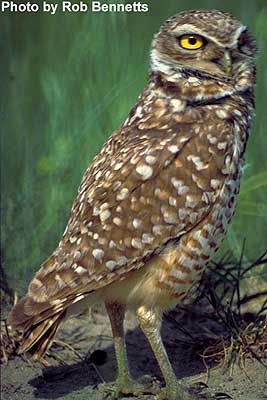
Athene cunicularia
(Burrowing Owl)
Order: Strigiformes
Order Description: Owls
Family: Strigidae
Family Description: Typical Owls
Physical Description:
9-11" (23-28 cm). Small owl with no ear tufts on rounded head; stubby tail and long legs. Earth brown with white spots on back, wings, and crown; whitish below with brown barring. Whitish eyebrows and chin stripe; yellow eyes. Immature has no barring below.
Song:
A cackling alarm note: quick-quick-quick. Also a mellow, rolling dove-like coo- c-o-o.
Distribution:
Breeds in southwestern Canada, south through western U.S., central Mexico, and central and southern Florida, to much of South America (locally). Withdraws from northernmost portions of breeding range in northern winter. Winters regularly south to portions of Central America.
Habitat:
Found in open grasslands (especially prairies, plains and savannas), and sometimes in open areas such as airports or vacant lots near human habitation. In southern Idaho, nests in sagebrush steppe and agricultural lands.
Diet:
Feeds primarily on large insects (especially in warmer months) and rodents. Sometimes eats birds and amphibians.
Ecology:
Primarily Nocturnal in winter in northern range, diurnal and crepuscular in summer. Catches prey in flight or drops to ground. Nests and roosts in burrow dug by mammal or owl. May mimic rattlesnake if disturbed in burrow. Territory defense is mainly limited to immediate vicinity of nest burrow; may share foraging area. Badger plays important role in nesting ecology in Idaho -- provides nest burrows and is a major predator. Reported densities: 12.5 ha/pair (California); 3.5-6 ha/pair (North Dakota); 13-16 ha/pair (Saskatchewan). Home range in Saskatchewan reported at 0.14-4.81 km2; 95% of all movements were within 600 m of nest burrow.
Reproduction:
Female incubates 6-7 eggs (on average), for 27-30 days. Male provides food during incubation and early nestling stages. Young (average of 3-5 fledglings) run and forage at 4 wk, are capable of sustained flight at 6 wk, and first breed at 1 yr (some may not). Female generally produces 1 brood/yr.
Conservation:
| Element Code: | ABNSB10010 |
| Status: | Protected nongame species |
| Global Rank: | G4 |
| State Rank: | S3,NTMB |
| National Rank: | N4B,N4N |
Important State References:
Rich, T. 1986. Habitat and nest-site selection by burrowing owls in the sagebrush steppe of Idaho. J. Wildl. Manage. 50:548-555.
Photo by R. Bennetts,© 1999.
Written by Jason Karl, 2000.
Design by Ean Harker©1999, 2000.

Strix varia
(Barred Owl)
Order: Strigiformes
Order Description: Owls
Family: Strigidae
Family Description: Typical Owls
Physical Description:
17-24" (43-60 cm). Whitish gray with dark barring across chest and streaked lengthwise on belly. Puffy head with brown eyes.
Similar Species- Spotted Owl, Great Gray Owl
Song:
Usually eight accented hoots, in two groups of four.
Distribution:
Resident from portions of Alaska, southern British Columbia, western Washington, eastern Oregon, and northeastern California, east through northern Idaho and northwestern Montana to portions of south-central Canada. Also resident in portions of eastern Canada and eastern, midwestern, and southern United States. Appears to be expanding range southward in Idaho.
Habitat:
Found in dense woodlands and forests with large, mature, decadent coniferous or hardwood trees providing secure nesting cavities. May prefer older stands, but uses earlier stages of forest in succession if enough large trees, snags, or nest boxes are present. Also found in swamps and wooded river valleys, often in areas bordering streams, marshes, and meadows, but also in upland areas (use reflects vegetation types rather than water proximity).
Diet:
Eats mice, birds, reptiles, amphibians, invertebrates, and other mammals. Small mammals such as voles, deer mice, and shrews often comprise bulk of diet.
Ecology:
Nests in abandoned or natural cavity in standing snag. Nocturnal. Flies at low altitude to locate prey. Birds feeding young may also forage diurnally. Opportunistic foraging may occur at any time. Minnesota study found home range was usually less than 400 ha (but up to 760) over 2-7 mo; boundaries generally remained constant from year to year, with no overlap (usually), except for mated pair. Annual home range averaged 282 ha in Michigan. Reported density was 0.03-1.0 pairs/km2. Species has become established in northern and central Idaho since at least 1968.
Reproduction:
Egg-laying occurs January-May, depending on range. clutch size varies from 2-3 eggs; incubation lasts 28- 33 days. Young may leave nest at 4-5 wk, fly at 6 wk, but receive some food from parents until 4 mo.
Conservation:
| Element Code: | ABNSB12020 |
| Status: | Protected nongame species |
| Global Rank: | G5 |
| State Rank: | S4 |
| National Rank: | N5 |
Important State References:
Olson, R.A., T. Craig, and E. Craig. 1978. Recent records of the barred owl, Strix varia, in Northern Idaho. J. Id. Acad. Sci. 14:24-25.
Photo by R. Bennetts,© 1999
Written by Jason Karl, 2000.
Design by Ean Harker©1999, 2000.
Strix nebulosa
(Great Gray Owl)
Link to photo provided by USGS - Patuxent Wildlife Research Center: http://www.mbr-pwrc.usgs.gov/Infocenter/infocenter.html
Order: Strigiformes
Order Description: Owls
Family: Strigidae
Family Description: Typical Owls
Physical Description:
24-33" (61-84 cm). Largest owl in North America. Large rounded head lacks ear tufts; long tail. Enormous pale facial disk patterned in concentric gray and brown circles; white crescent on throat with black chin spot; yellow eyes and bill. Mottled gray and brown above, gray and brown lengthwise streaking below.
Similar Species- Spotted and Barred Owls
Song:
Very deep whoo-hooo-hoo repeated in a series over eight or nine seconds.
Distribution:
Breeds from central Alaska to northern Ontario, and locally south in mountains to California (vicinity of Yosemite), Idaho, Montana, Wyoming, northern Minnesota, and portions of south-central Canada. Winters generally throughout breeding range.
Habitat:
Found in coniferous and hardwood forests, especially pine, spruce, paper birch, and poplar; also found in second growth, especially near water. In Idaho, found at lower elevations and in agricultural areas during winter, and in conifer forests in spring and summer, most commonly near extensive meadows.
Diet:
Commonly eats pocket gophers and voles; may also eat other small mammals. In Idaho, owls nesting near clearcuts were found to have greater proportions of pocket gopher in diet.
Ecology:
Nests in broken-top snags or uses abandoned stick nest of other species, especially Goshawks. Hunts from perch; captures food on ground. Forages usually in open area where scattered trees or forest margin provides suitable sites for visual searching; also uses sound to locate prey under snow cover. When nesting, may hunt day or night. In Oregon study, radio-tagged juveniles moved 9-31 km from nest over period of 1 yr; adults moved 3-43 km during same period. In Idaho study, home range per pair was found to be 2.6 km2. Predation by Great Horned Owl was greatest known mortality factor in northern Minnesota and southeastern Manitoba study.
Reproduction:
Lays eggs in March- June, depending on range. Mean date of first egg was 5 May in southern Idaho and northwestern Wyoming; egg-laying may be delayed in deep snow years. Female incubates 2-5 eggs (3.3 in Idaho), for 28-29 days. Young leave nest at 3-4 wk (4 wk in Idaho and Wyoming), fly well at 5-6 wk (6 wk in Idaho and Wyoming), and become independent at about 4-5 mo. In Idaho study, mean s size was 3.0 young/pair.
Conservation:
| Element Code: | ABNSB12040 |
| Status: | Protected nongame species |
| Global Rank: | G5 |
| State Rank: | S2 |
| National Rank: | N4 |
Important State References:
Franklin, A.B. 1988. Breeding biology of the Great Gray Owl in southeastern Idaho and northwestern Wyoming. Condor 90:689-696.
Design by Ean Harker©1999, 2000.
Written by Jason Karl, 2000.
Asio otus
(Long-eared Owl)
Link to photo provided by USGS - Patuxent Wildlife Research Center: http://www.mbr-pwrc.usgs.gov/Infocenter/infocenter.html
Order: Strigiformes
Order Description: Owls
Family: Strigidae
Family Description: Typical Owls
Physical Description:
13-16" (33-41 cm). A slender, crow-sized owl with dark, long ear tufts closer together than on most other owls. Gray-brown mottling above and dark vertical streaks below;face orange to buff; eyes yellow-orange.
Similar Species- Great Horned Owl, Screech- owls
Song:
A drawn out hoot: hoooo, repeated at intervals, and cat-like wails.
Distribution:
Breeds from southern and eastern British Columbia, east across parts of Canada, and south to northwestern Baja California, southern New Mexico, northern Mexico, Arizona, and Virginia. Winters from southern Canada, south to northern Baja California, central Mexico, and Gulf Coast.
Habitat:
Found in deciduous and evergreen forests, orchards, wooded parks, farm woodlots, river woods, and desert oases. In western states, often associated with deciduous woods near water. Uses wooded areas for roosting and nesting, and open areas for hunting.
Diet:
Feeds on small mammals, particularly voles (usually weighing less than 100 g). In Idaho, typical prey includes moles, kangaroo rats, harvest mice, and pocket mice, but particular prey varies with locality; prey size is most important factor in food selection.
Ecology
Flies at low altitudes to locate prey. Typically forages in open, grassy areas, (e.g., marshes or old fields), but may forage in forests in some areas. Nocturnal, though diurnal foraging may occur at high latitudes, or when feeding young. Uses abandoned tree nest of other species, often corvids. May form loose nesting colonies and perform group distraction displays. Breeding density is generally not more than 1-2 pairs/km2, and is often much less. In Idaho study, colonies nested in clumps of trees, rather than single tree. Individuals are gregarious in winter.
Reproduction:
Nests mainly from mid-March to mid-May, depending on area. Female (usually) incubates an average of 4-5 eggs for 25-30 days. Young leave nest at 20-26 days, fly at 30-40 days, become independent at about 2 mo, and reach sexual maturity in first year. In Idaho study, fledged young/nest ranged from 3.4-4.0. Predators such as racoons cause most nest failures.
Conservation:
| Element Code: | ABNSB13010 |
| Status: | Protected nongame species |
| Global Rank: | G5 |
| State Rank: | S5,NTMB |
| National Rank: | N5B,N5N |
Important State References:
Marks, J.S. 1986. Nest-site characteristics and reproductive success of long-eared owls in southwestern Idaho. Wilson Bull. 98:547-560.
Design by Ean Harker©1999, 2000.
Written by Jason Karl, 2000.
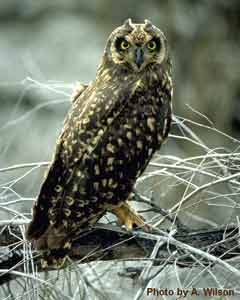
Asio flammeus
(Short-eared Owl)
Order: Strigiformes
Order Description: Owls
Family: Strigidae
Family Description: Typical Owls
Physical Description:
13-17" (33-43 cm). Short ear tufts are close together and seldom noticeable on a relatively small head for an owl. tawny brown with light brown streaking below that goes from heavy on breast to finer on belly; darker above with white spots. Face mask and wing linings are also light; large buffy wing patches show on the underwing in flight along with a black wrist patch. Eyes yellow. Immature darker.
Similar Species- Long-eared Owl, Barred Owl, Common Barn-owl
Song:
A harsh, sneezy, barked kyow!
Distribution:
Breeds from northern Alaska, east to northern Labrador, and south to California, Utah, Colorado, parts of Midwest, and Virginia. Winters mostly from southern Canada, south to southern Baja California, southern Mexico, Gulf Coast, and Florida.
Habitat:
Found in open country in prairies, meadows, tundra, moorlands, marshes, savannas, dunes, fields, and open woodlands.
Diet:
Eats mainly rodents (commonly voles), but will also eat small birds, insects, and other small mammals.
Ecology:
Nests in depression on ground. Both sexes perform distraction displays. Breeding density in different areas has been reported at 0.6-6 pairs/km2. Reported average home range size is 15-200 ha. Roosts by day on ground, on low open perch, under low shrub, or in conifer. Somewhat gregarious in winter; groups may gather where prey is abundant. May defend feeding territory in winter. Forages primarily by flying low (typically into wind), and dropping down onto prey, sometimes after hovering briefly. Will forage day or night; may favor late afternoon and early eavening. Recent study in southwestern Idaho reported 7% mortality rate in nestlings.
Reproduction:
clutch size is usually 4-7 eggs (number increases in northern range). Incubation lasts 24-29 days. Young may leave nest at 12-18 days, fly at 3-5 wk, remain in nest vicinity until about 6 wk old, and reach sexual maturity in first year. Often only the oldest chicks survive.
Conservation:
| Element Code: | ABNSB13040 |
| Status: | Protected nongame species |
| Global Rank: | G5 |
| State Rank: | S5,NTMB |
| National Rank: | N5B,N5N |
Important State References:
Rivest, T.A. 1994. Short-eared owl mortality between mid-nestling age and dispersal. Pp. 296-304 in K. Steenhof, ed., Snake River Birds of Prey National Conservation Area, 1994 Annual Report. USDI Bur. Land Manage., Boise District.
Design by Ean Harker©1999, 2000.
Written by Jason Karl, 2000.
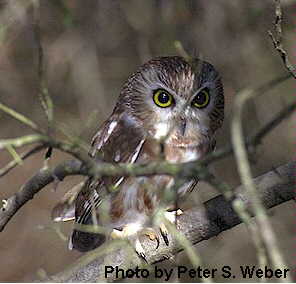
Aegolius acadicus
(Northern Saw-whet Owl)
Order: Strigiformes
Order Description: Owls
Family: Strigidae
Family Description: Typical Owls
Physical Description:
7-8 1/2" (18-21 cm). Small, tame owl. Lacks ear tufts on its flat- topped head and has a short tail. Brown above, lightly streaked with white on the forehead and crown, large white spots on wings; white below with blotchy reddish-brown streakings. Face whitish with yellow eyes and dark bill. Immatures are chocolate brown with broad white eyebrows that form a "V" over the bill.
Similar Species- Boreal Owl, Screech-owls, Pygmy-owls, Flammulated Owl
Song:
A mellow series of low, whistled notes on one pitch; often unevenly spaced and repeated mechanically up to 130 times per minute: took took took took took took etc.
Distribution:
Breeds from southern Alaska, east across portions of Canada to New Brunswick, and south to southern California, southern Arizona, southern Mexico, western Texas, Missouri, southern Minnesota, and Maryland. Also breeds in Great Smoky Mountains. Winters generally throughout breeding range (some southward withdrawal), and irregularly or casually south to southern United States.
Habitat:
Found in dense coniferous or mixed forests, cedar groves, alder thickets, swamps, and tamarack bogs. When not breeding, found in dense second growth, brushy areas, arid scrub, and open buildings. In Idaho, less abundant in higher-elevation spruce/fir forests, but is the most abundant owl in mid-elevation conifer forests.
Diet:
Eats mainly small mammals (e.g., deer mice, voles, and shrews), and sometimes birds and insects. In Idaho, eats higher proportion of very small mammals (2-15 g).
Ecology:
Nests in natural or abandoned cavity in tree. Throughout range, often roosts in dense evergreens in winter. Hunts at night. Apparently obtains prey mainly by pouncing from above, after short flight from elevated perch. In Idaho, defends exclusive territories. Limited data on breeding density suggest maximum of few pairs/km2.
Reproduction:
Female incubates about 5-6 eggs for 26-28 days. Young first fly at 4-5 wk. Nest-box study in southwestern Idaho revealed polygyny (1 male mating with > 1 female) in Saw-whets.
Conservation:
| Element Code: | ABNSB15020 |
| Status: | Protected nongame species |
| Global Rank: | G5 |
| State Rank: | S4 |
| National Rank: | N5B,N5N |
Important State References:
Marks, J.S., J.H. Doremus, and R.J. Cannings. 1989. Polygyny in the Northern Saw- whet Owl. Auk 106:732-734.
Photos by Peter S. Weber,© 2000, and Jeff Spendelow,© 1999
Design by Ean Harker©1999, 2000.
Written by Jason Karl, 2000.
Aegolius funereus
(Boreal Owl)
Order: Strigiformes
Order Description: Owls
Family: Strigidae
Family Description: Typical Owls
Physical Description:
8 1/2-12" (22-30 cm). Short-tailed, flat-headed, chubby owl; lacks ear tufts and very tame. Chocolate brown with fine white spots thickly crowded on head. Large facial disk is pale grayish with dark border, yellow eyes, and yellow bill. Immature is dusky brown; eyebrows dirty whitish or gray; belly obscurely blotched.
Similar Species- Northern Saw-whet Owl, Hawk Owl, Northern Pygmy-owl, Screech-owls
Song:
Spring call is similar to the tolling of a soft bell or dripping water. Also a series of high-pitched whistles, rising slightly.
Distribution:
Breeds from central Alaska, east across portions of Canada to Labrador and New Brunswick, and south to northeastern Washington, Idaho, Montana, and northeastern Minnesota, and further south in mountains to Colorado and New Mexico. Winters mainly in breeding range, and south irregularly to northern United States.
Habitat:
Found in coniferous forests, mixed forests, thickets of alder, aspen, or stunted spruce, and muskeg bogs. Generally found in spruce/fir in Rockies. In Idaho, nests in mixed conifer, spruce/fir, Douglas-fir, and aspen stands.
Diet:
Eats mainly small mammals (often red-backed voles, but also shrews, pocket gophers, and deer mice). Will sometimes eat birds and insects.
Ecology:
Hunts from perch; captures prey on ground. caches food. Nests in abandoned or natural cavity in standing snag in older forests with complex physical structures. Defends nest site only. roosts in dense cover by day; forages mostly at night. Idaho study found home range averaged 1451 ha in winter and 1152 ha in summer. Best foraging habitat was in spruce/fir stands.
Reproduction:
In Idaho, nesting occurs in mid-April to late May. Female incubates 2-5 eggs for 25-36 days. Young fledge at about 27-31 days, are independent at 5-6 wk, and become sexually mature by 1 yr.
Conservation:
| Element Code: | ABNSB15010 |
| Status: | Protected nongame species |
| Global Rank: | G5 |
| State Rank: | S2 |
| National Rank: | N4 |
Important State References:
Hayward, G.D., P.H. Hayward, and E.O. Garton. 1993. Ecology of boreal owls in the northern Rocky Mountains, USA. Wildl. Mono. 59.
Design by Ean Harker©1999, 2000.
Written by Jason Karl, 2000.
Chordeiles minor
(Common Nighthawk)
Link to photo provided by USGS - Patuxent Wildlife Research Center: http://www.mbr-pwrc.usgs.gov/Infocenter/infocenter.html
Order: Caprimulgiformes
Order Description: Nighthawks, Goatsuckers
Family: Caprimulgidae
Family Description: Goatsuckers and Nightjars
Physical Description:
8 1/2-10" (21-25 cm). Long notched tail and long, slim, pointed wings with conspicuous white band. Dark with mottled brown, gray, and white above and below; paler below. Male has a white throat patch and white subterminal tail band. Female is browner with a buffy throat and no tail band.
Similar Species- Lesser Nighthawk
Song:
A short, nasal call, peent or spee-ik.
Distribution:
Breeds from southern Canada south to Panama. Winters throughout South America.
Habitat:
Found in mountains and plains, in open and semi-open habitat such as open coniferous forests, savannas, grasslands, fields, and around cities and towns.
Diet:
Feeds on flying insects (e.g., mosquitoes, moths, beetles, flies, and caddisflies).
Ecology:
Nests on ground, occasionally on rooftop or in old robin's nest. Forages at night or during day (most active during early morning and evening and at night). Catches insects high in air or close to ground.
Reproduction:
Female incubates 2 eggs for about 19 days. Nestlings are semi-precocial, are tended by both parents, and become independent in about 30 days.
Conservation:
| Element Code: | ABNTA02020 |
| Status: | Protected nongame species |
| Global Rank: | G5 |
| State Rank: | S5,NTMB |
| National Rank: | N5B |
Important State References:
No references are available at this time.
Design by Ean Harker©1999, 2000.
Written by Jason Karl, 2000.
Phalaenoptilus nuttallii
(Common Poorwill)
Order: Caprimulgiformes
Order Description: Nighthawks, Goatsuckers
Family: Caprimulgidae
Family Description: Goatsuckers and Nightjars
Physical Description:
7-8 1/2" (18-21 cm). Light brown body mottled with silvery gray and black; whitish collar separating black throat from narrowly barred underparts. Dark outer tail feathers are tipped with white; tail and wings are rounded.
Similar Species- Whip-poor-will, Buff-collared Nightjar
Song:
A melancholy call that sound like its name; the first note lower than the second. A third syllable is audible at close range, poor-will-ip. In flight it utters a low wurt, wurt.
Distribution:
Breeds from southern British Columbia, southeastern Montana, and portions of Midwest, south on West Coast from central California to southern Baja California, and through central Texas to central mainland of Mexico. Winters from central California, southern Arizona, and southern Texas, south to limits of breeding range in Mexico.
Habitat:
Found in shrub steppe, rocky canyons, open woodlands, and broken forests (primarily in arid or semi-arid habitats). Also found in valleys and foothills, mixed chaparral/grassland, and pinyon/juniper habitat.
Diet:
Feeds on insects such as moths, beetles, grasshoppers, and locusts.
Ecology:
Nocturnal. Nests on gravel or rock. Catches insects on ground, or vaults upward and captures insects in air.
Reproduction:
Breeding begins in late March in southern range, to late May in north. Both sexes alternate incubating 2 eggs. Nestlings are semi-precocial and downy.
Conservation:
| Element Code: | ABNTA04010 |
| Status: | Protected nongame species |
| Global Rank: | G5 |
| State Rank: | S4,NTMB |
| National Rank: | N5B,N?N |
Important State References:
No references are available at this time.
Design by Ean Harker©1999, 2000.
Written by Jason Karl, 2000.
Cypseloides niger
(Black Swift)
Order: Apodiformes
Order Description: Swifts, Hummingbirds
Family: Apodidae
Family Description: Swifts
Physical Description:
7-7 1/2" (18-19 cm). A large sooty black swift with a notched tail and sickle-shaped wings. At close range, a touch of white can be seen on the forehead. Feathers of immatures are edged with white.
Similar Species- White-throated, Vaux's, and Chimney Swifts
Song:
More silent than other swifts. Occasionally gives a soft, high-pitched twitter.
Distribution:
Breeds from southeastern Alaska and western Canada, south to southern California, northwestern Montana, Colorado, Utah, northern New Mexico, and southeastern Arizona. Winters in Mexico and Costa Rica.
Habitat:
Found in montane habitats. In Idaho, prefers higher-elevation mountains.
Diet:
Feeds on insects (e.g., caddisflies, mayflies, beetles, flesh flies, hymenopterans).
Ecology:
Requires moist cliff environment for nesting. Builds cup-shaped nest of mud, mosses, and algae on cliff ledge, near or behind waterfalls, or in shallow cave. Nests in colonies. Nest site persistence and tenacity are almost absolute. Catches prey in air, often at great heights.
Reproduction:
Female lays 1 egg in June or July. Incubation lasts 24-27 days and fledging occurs at 45-49 days. Nestling is altricial.
Conservation:
| Element Code: | ABNUA01010 |
| Status: | Protected nongame species |
| Global Rank: | G5 |
| State Rank: | S1,NTMB |
| National Rank: | N4B |
Important State References:
Taylor, D.M. and C.H. Trost. 1987. The status of rare birds in Idaho. Murrelet 69:69-93.
Design by Ean Harker©1999, 2000.
Written by Jason Karl, 2000.
Chaetura vauxi
(Vaux's Swift)
Order: Apodiformes
Order Description: Swifts, Hummingbirds
Family: Apodidae
Family Description: Swifts
Physical Description:
4-5" (10-12 cm). A small, dark, swallow-like bird; dingy brown underparts and pale throat; short, unforked tail; long, stiff, gently curved wings.
Similar Species- White-throated, Black, and Chimney Swifts
Song:
Loud, rapid, bat-like ticking or chippering notes.
Distribution:
Breeds from southeastern Alaska, western Canada, northern Idaho, and western Montana, south to central California. Winters in central Mexico, south through breeding range, and casually in southern Louisiana and western Florida.
Habitat:
Found in coniferous, forested regions, but forages and migrates over open country, rivers, and lakes.
Diet:
Feeds on insects.
Ecology:
Builds nest in standing snag, or occasionally in chimney. Nests singly or in small colonies. Catches prey in air. During migration, often roosts in large flocks in hollow trees or chimneys. Recent studies in Oregon suggest this species is associated with old-growth forests.
Reproduction:
clutch size varies from 3-6 eggs, but is usualy 4-6. Incubation probably lasts about 19 days. Young are capable of first flight 20-21 days after hatching.
Conservation:
| Element Code: | ABNUA03020 |
| Status: | Protected nongame species |
| Global Rank: | G5 |
| State Rank: | S4,NTMB |
| National Rank: | N5B |
Important State References:
No references are available at this time.
Design by Ean Harker©1999, 2000.
Written by Jason Karl, 2000.
Aeronautes saxatalis
(White-throated Swift)
Order: Apodiformes
Order Description: Swifts, Hummingbirds
Family: Apodidae
Family Description: Swifts
Physical Description:
6-7" (15-18 cm). Barn Swallow-sized. Adults mostly black, with white throat sometimes extending to the breast; white mid-belly and flank patches; grayish-white face; area around eye dark.
Similar Species- Black, Vaux's, and Chimney Swifts
Song:
Call is a prolonged shrill, chattering jejejeje, in descending scale.
Distribution:
Breeds from southwestern Canada, east to Montana, upper Great Plains states, southeastern Wyoming, eastern Colorado, New Mexico, and western Texas, west to southern California and central Arizona, and south to Central America. Winters from central California and central Arizona, south to limits of breeding range.
Habitat:
Found primarily in mountainous country, especially near cliffs and canyons.
Diet:
Catches flying insects such as flies, beetles, bees, winged ants, and bugs.
Ecology:
Builds nest in deep crevice in rock wall, or occasionally, in building. Forms small nesting colonies. Fastest of North American swifts. Can become torpid during cold periods. Exhibits spectacular aerial courtship display.
Reproduction:
copulation occurs in air. clutch size varies from 3-6 eggs, but is usually 4-5.
Conservation:
| Element Code: | ABNUA06010 |
| Status: | Protected nongame species |
| Global Rank: | G5 |
| State Rank: | S4 |
| National Rank: | N5B,N4N |
Important State References:
No references are available at this time.
Design by Ean Harker©1999, 2000.
Written by Jason Karl, 2000.
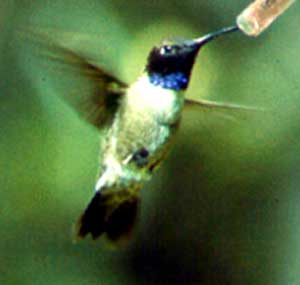
Archilochus alexandri
(Black-chinned Hummingbird)
Order: Apodiformes
Order Description: Swifts, Hummingbirds
Family: Trochilidae
Family Description: Hummingbirds
Physical Description:
3 1/4-3 3/4" (8-10 cm). Adult males are dark green above; black chin and blue-violet (may look black) lower throat, forming gorget, are bordered by white collar below; sides olive-green; tail black and forked. Females are greenish above, plain whitish below with variable amount of spotting on throat and pale buff sides; tail has small white-tipped corners. Both sexes have a slightly downcurved black bill and a small white spot behind eye.
Similar Species- Female and immature Ruby- throated and Costa's Hummingbirds, Anna's Hummingbird.
Song:
Call is a low, soft tchew or tup; song consists of weak, high-pitched squeaks. Male makes a dry buzz with wings in flight.
Distribution:
Breeds from southwestern British Columbia, Washington, central Idaho, and northwestern Montana, south to northern Mexico and southern Texas, and east to western Wyoming, eastern Colorado, eastern New Mexico, and central Texas. Winters from northern Mexico and southern Texas, south to southern Mexico, and casually to Louisiana and Florida.
Habitat:
Found in semi-arid habitat near water, canyons, slopes, chaparral, riparian woodlands, open woodlands, and scrub. Also found in parks, orchards, and gardens.
Diet:
Feeds on nectar and insects.
Ecology:
Primarily solitary. Builds cup-shaped nest in tree, frequently near water. Takes nectar from flowers, or forages by darting out from perch to catch insects in air.
Reproduction:
Female incubates 2 eggs (occasionally 1-3) for 13-16 days. Young are tended by female, leave nest in about 3 wk, and are fed by female for several days after fledging. Adults may begin second nesting before young of first nesting become independent.
Conservation:
| Element Code: | ABNUC45020 |
| Status: | Protected nongame species |
| Global Rank: | G5 |
| State Rank: | S5,NTMB |
| National Rank: | N5B |
Important State References:
No references are available at this time.
Photo by C. Trost,© 1999
Design by Ean Harker©1999, 2000.
Written by Jason Karl, 2000.
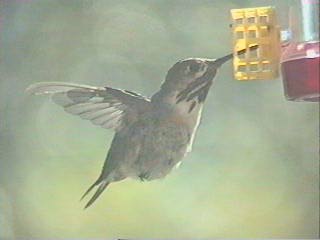
Stellula calliope
(Calliope Hummingbird)
Order: Apodiformes
Order Description: Swifts, Hummingbirds
Family: Trochilidae
Family Description: Hummingbirds
Physical Description:
2 3/4-4" (7-10 cm). A tiny hummingbird; short bill and characteristic hovering posture -- with tail slightly cocked up and body almost horizontal. Bill is more frequently stained with yellow from pollen than other hummers. Males have elongate purple-red throat feathers than can appear as streaks or rays on white background, be fluffed out to give a whiskered effect, or be folded like a dark inverted V on a white throat; white below with green sides; metallic green above. Females have pale cinnamon-buff sides; upperparts green, red-brown base of tail with white tips on corners; white below with a few fine, dark spots on throat.
Similar Species- Male Costa's Hummingbird, female and immature Allen's, Rufous, and Broad-tailed Hummingbirds, female Black- chinned Humming bird
Song:
Calls a high, thin tsip. Male's display call is a high, thin zee-ree.
Distribution:
Breeds in mountains from central interior British Columbia and southwestern Alberta, south through Washington, Oregon, Nevada, and California to northern Baja California, and east to northern Wyoming, western Colorado, and Utah. Winters from northern to central Mexico.
Habitat:
Found in mountains (along meadows, canyons and streams), in open montane forests, and in willow and alder thickets. During migration and in winter, found in chaparral, lowland brushy areas, and deserts.
Diet:
Feeds on nectar, insects, and spiders. Food sources include: paintbrush, penstemon, columbine, trumpet gilia, and elephant head.
Ecology:
Builds cup-shaped nest in tree on limb or cone, or in shrub. Nests from 180 m (Washington) to more than 3000 m (California). Takes nectar from flowers, or may hunt from perch. Tends to feed close to ground. In southern British Columbia, defends territories from late April-late June. Smallest bird north of Mexico.
Reproduction:
One brood of 2 eggs is laid in May-July (British Columbia). Incubation lasts about 15 days. Young are capable of flight about 20 days after hatching. About 338 days elapse from egg-laying to fledging. Males depart breeding grounds while females are incubating.
Conservation:
| Element Code: | ABNUC48010 |
| Status: | Protected nongame species |
| Global Rank: | G5 |
| State Rank: | S5,NTMB |
| National Rank: | N5B |
Important State References:
No references are available at this time.
Photo by Jim Nestler, 2002 and C. Trost, 2001
Design by Ean Harker©1999, 2000.
Written by Jason Karl, 2000.
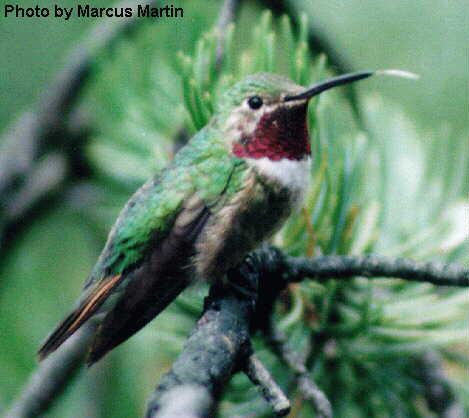
Selasphorus platycercus
(Broad-tailed Hummingbird)
Order: Apodiformes
Order Description: Swifts, Hummingbirds
Family: Trochilidae
Family Description: Hummingbirds
Physical Description:
4-4 1/2" (10-11). Males have metallic green crown and back; metallic rose throat; white belly and breast; green sides; tail wide and rounded, mostly black with inconspicuous red-brown on outer webs of feathers. Female is green above, dull whitish below, with warm buff-tinged sides; green central tail feathers; outer tail feathers rust-colored at base, black in middle, and white on outer tips; chin and throat marked with dark spots.
Similar Species- Anna's Hummingbird, male Ruby-throated Hummingbird
Song:
Calls a sharp chip. The sound of adult male wings is a unique, loud, musical trilling.
Distribution:
Breeds from north-central Idaho, northern Utah, and portions of Wyoming, south to southeastern California, portions of Mexico and Guatemala, and western Texas. Winters in highlands of northern Mexico south to Guatemala.
Habitat:
Found in open woodlands (especially pinyon/juniper and conifer/aspen associations), brushy hillsides, and montane scrub and thickets. During winter and in migration, also found in open, lowland situations where flowering shrubs are present. May move to higher elevations after breeding.
Diet:
Consumes nectar, small insects, and spiders.
Ecology:
Usually nests 1-4 m above ground, on low, horizontal branch in tree. Often nests above water. Forages in flowers and foliage. In Arizona study, males defended 2040 m2 (average) breeding territory. In Colorado study, males were observed displaying close to one another in apparent lek. In some areas, species may compete with Rufous Hummingbird for same food resources.
Reproduction:
Egg-laying occurs mainly June-July in Arizona, Utah, and Colorado. Females may nest close together, and may occasionally attempt 2 broods. Female incubates 2 eggs for 16-17 days. Young are tended by female, and fledge in 21-26 days (18 days has been reported). Females are long-lived and show strong fidelity to breeding site.
Conservation:
| Element Code: | ABNUC51010 |
| Status: | Protected nongame species |
| Global Rank: | G5 |
| State Rank: | S5,NTMB |
| National Rank: | N5B |
Important State References:
No references are available at this time.
Photos by Marcus Martin, and C. Trost,© 1998-9
Design by Ean Harker©1999, 2000.
Written by Jason Karl, 2000.
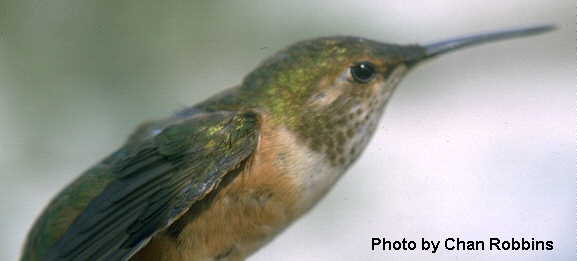
Selasphorus rufus
(Rufous Hummingbird)
Order: Apodiformes
Order Description: Swifts, Hummingbirds
Family: Trochilidae
Family Description: Hummingbirds
Physical Description:
3-4" (8-10 cm). Males are non-Iridescent, red-brown on back, sides, and top of tail; breast is white; throat (gorget) is bright iridescent orange-red; crown is green. Occasionally, males have some green on back. Females and immatures are whitish below; dull red-brown on sides, rump, and most of tail; greenish on upper wings and back.
Similar Species- Allen's, Broad-tailed, and Calliope Hummingbirds
Song:
Calls a low tchup and an excited, buzzy zeee-chuppity-chup; very similar to calls of Allen's Hummingbird. The wings of adult males may produce a musical buzz in flight.
Distribution:
Breeds from southern Alaska, southwestern Canada, and western Montana, south and west of Cascades to northwestern California and southern Idaho. Winters mainly in Mexico. Often strays out of usual range.
Habitat:
Found in coniferous forests, second growth, and thickets and brushy hillsides (forages in adjacent scrubby areas and meadows). During migration and in winter, found in open situations where flowers are persent. A study in north-central Idaho found these hummingbirds more common in clearcut areas than in fragmented or contiguous stands of coniferous forest.
Diet:
Feeds on nectar, insects, and tree sap.
Ecology:
Builds nest in tree, often on drooping branch; occasionally nests on vine. May nest in loose colony of up to 10 nests. Defends feeding territory during migration and on breeding grounds. Capable of altering energy balance by employing Nocturnal torpor.
Reproduction:
Female lays 2 eggs. Young are capable of first flight about 20 days after hatching.
Conservation:
| Element Code: | ABNUC51020 |
| Status: | Protected nongame species |
| Global Rank: | G5 |
| State Rank: | S5,NTMB |
| National Rank: | N5B |
Important State References:
Hutto, R.L. 1993. Effects of clearcutting and fragmentation on the birds of a western coniferous forest. Final report to the Clearwater National Forest., Univ. Montana, Missoula. 13pp.
Photo by C. S. Robbins, ©2002.
Design by Ean Harker©1999, 2000.
Written by Jason Karl, 2000.
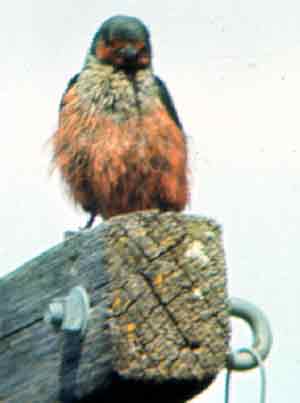
Melanerpes lewis
(Lewis' Woodpecker)
Order: Piciformes
Order Description: Woodpeckers
Family: Picidae
Family Description: Woodpeckers
Physical Description:
10 1/2-11 1/2" (27-29 cm). A large, dark woodpecker, slightly smaller than a flicker. Metallic greenish-black back, head, and tail; collar and breast gray, pinkish-red belly; dark red face patch framed with greenish black. Sexes look alike. Immatures duller; lack red face and gray collar; have less extensive red below.
Song:
Usually silent; it occasionally gives a low, harsh churring note or a series of harsh churr notes.
Distribution:
Breeds from southwestern Canada, Montana, and southern Great Plains states, south to south-central California, central Arizona, southern New Mexico, and eastern Colorado. Winters mainly from northern Oregon, southern Idaho, central Colorado, and south-central Nebraska, south irregularly to northern Mexico, southern New Mexico, and western Texas.
Habitat:
Found in open forests and woodlands (often logged or burned), including oak, coniferous forests (primarily ponderosa pine), and riparian woodlands and orchards.
Diet:
Feeds mainly on insects (e.g., ants, beetles, flies, grasshoppers, tent caterpillars). Also eats fruits and nuts.
Ecology:
Nests in cavity in tree, frequently on dead limb; may nest on pole. Catches prey in air; also drops from perch to capture prey on ground. Stores nuts in natural cavities for use in non-breeding season. May damage orchard crops. Primarily uses cavities excavated by other species.
Reproduction:
Pair forms life-long bond. Both sexes incubate 5-9 eggs (usually 6-7), for 13-14 days. Young are capable of first flight 28-34 days after hatching.
Conservation:
| Element Code: | ABNYF04010 |
| Status: | Protected nongame species |
| Global Rank: | G4 |
| State Rank: | S4,NTMB |
| National Rank: | N5B,N5N |
Important State References:
Saab, V.A. and J. Dudley. 1995. Nest usurpation and cavity use by Lewis' Woodpecker. USDA Forest Service Inter. Res. Sta. Rep., Boise. 13pp.
Photos by C Trost and Luther Goldman,© 1999
Design by Ean Harker©1999, 2000.
Written by Jason Karl, 2000.
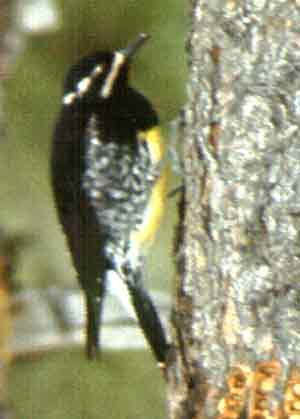
Sphyrapicus thyroideus
(Williamson's Sapsucker)
Order: Piciformes
Order Description: Woodpeckers
Family: Picidae
Family Description: Woodpeckers
Physical Description:
9-9 1/2" (24 cm). A medium-sized woodpecker unlike any other in the United States. Male has black head, breast band, and back, white facial stripes, bright red throat, and large white shoulder and rump patches. Lemon yellow belly is bordered with black-and-white-barred flanks. In flight, black with white rump and shoulder patches. Sexes very dissimilar: female has brown head, dark brown and white "zebra" stripes on back, sides, and wings; large dark bib, white rump, and smaller, less brilliant yellow area on belly.
Similar Species- female resembles a small flicker
Song:
A soft, nasal churrr, descending in pitch. Drums a distinctive, patterned, rapid series of taps, followed by three or four taps given slowly.
Distribution:
Breeds from southern interior British Columbia, Idaho, and western Montana, south in mountains to northern and east-central California, and locally in southern California, central Arizona, southern New Mexico, and northern Baja California. Winters mainly from breeding range, south to northern Baja California, northwestern Mexico, and western Texas.
Habitat:
Found in montane coniferous forests, especially fir and lodgepole pine. During migration and in winter, also found in lowland forests.
Diet:
Consumes sap, cambium, and insects. Ants may comprise 86% of animal food. Also eats white wood- boring larvae and moths of spruce budworms.
Ecology:
Nests in cavity in standing snag/hollow tree; sometimes returns to same tree, but not same cavity, year after year. Drills holes in trees, or forages on ground.
Reproduction:
Both sexes incubate 3- 7 eggs (usually 5-6), for 12-14 days. Nestlings are altricial. Young are tended by both adults, and leave nest cavity about 28-35 days after hatching.
Conservation:
| Element Code: | ABNYF05030 |
| Status: | Protected nongame species |
| Global Rank: | G5 |
| State Rank: | S4,NTMB |
| National Rank: | N5B,N5N |
Important State References:
No references are available at this time.
Original images provided by C. Trost,© 2000.
Design by Ean Harker©1999, 2000.
Written by Jason Karl, 2000.
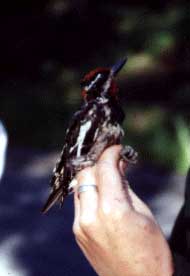
Sphyrapicus nuchalis
(Red-naped Sapsucker)
Order: Piciformes
Order Description: Woodpeckers
Family: Picidae
Family Description: Woodpeckers
Physical Description:
8-9" (20-23 cm). Medium-sized woodpecker; smaller than a flicker. Characterized by black-and-white stripes on face, a long white wing patch, barred back, and white rump. Have red nape, forehead, and throat (female's throat is only partly red). Have black chest crescent separating throat from pale yellow belly. Immatures dusky brown with light spots on back, lighter belly and breast, with black-and-white checkered wings and tail.
Similar Species- Yellow-bellied Sapsucker, female Williamson's Sapsucker resembles immature Red-naped
Song:
A soft, slurred, nasal whee-ur or mew. Also drums: several rapid thumps followed by several slow, rhythmic thumps. The display communication of the spring pair is not a drum but a broken series tap: prrrrrrrp, prrp, prp, prp.
Distribution:
Breeds in Rocky Mountain region from south-central British Columbia, southwestern Alberta, and western Montana, south (east of Cascades) to east- central California, southern Nevada, central Arizona, southern New Mexico, and extreme western Texas. Winters in southern California, Oregon (casually), southern Nevada, central Arizona, and central New Mexico, and south to northern Mexico.
Habitat:
Found primarily in coniferous/deciduous forests that include aspen and cottonwood. During migration and in winter, found in various forest and open woodland habitats, and in parks, orchards, and gardens. A study in north-central Idaho found no differences in numbers among clearcut, fragmented, and contiguous stands of coniferous forest.
Diet:
Drinks sap and eats cambium, fruits, and berries. Also eats insects in wood.
Ecology:
Nests in cavity in live tree, frequently near water. Often returns to nest in same tree, but not same cavity, year after year. Drills holes in trees to obtain food.
Reproduction:
Both sexes incubate 4- 5 eggs for 12-13 days. Nestlings fledge at 25-29 days. In Montana and Wyoming, nestlings have been noted in late June to mid-July.
Conservation:
| Element Code: | ABNYF05040 |
| Status: | Protected nongame species |
| Global Rank: | G5 |
| State Rank: | S5 |
| National Rank: | N5B,N?N |
Important State References:
Hutto, R.L. 1993. Effects of clearcutting and fragmentation on the birds of a western coniferous forest. Final report to Clearwater National Forest, Univ. Montana, Missoula. 13pp.
Original images provided by Jason Karl,© 1999
Design by Ean Harker©1999, 2000.
Written by Jason Karl, 2000.
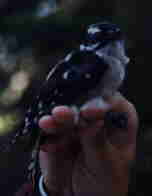
Picoides pubescens
(Downy Woodpecker)
Order: Piciformes
Order Description: Woodpeckers
Family: Picidae
Family Description: Woodpeckers
Physical Description:
6-7" (15-18 cm). A smaller version of the Hairy Woodpecker, with bill proportionately shorter. Black-and-white-striped head and checkered wings; white belly, breast, and central back. Male has small red patch on nape.
Similar Species- Hairy Woodpecker
Song:
Call is a swift, flat, high-pitched pik, not as sharp as the Hairy's peek!; also gives a rapid whinny of notes, descending in pitch: ki-ki-ki-ki-ki.
Distribution:
Breeds from western and central Alaska, east across portions of Canada to Newfoundland, and south to southern California, central Texas, Gulf Coast, and southern Florida. Winters throughout breeding range, but more northern populations are mostly migratory, occurring irregularly southward.
Habitat:
Found in deciduous and mixed woodlands, second growth, parks, orchards, swamps, and riparian woodlands.
Diet:
Eats mostly insects (adults, larvae, pupae, and eggs), but will also eat berries and nuts.
Ecology:
Nests in cavity in standing snag. Constructs new nesting cavity yearly. Forages on bark of tree.
Reproduction:
Both sexes incubate 3- 7 eggs (usually 4-5), for 12 days. Young leave nest at 20-22 days, and are dependent on parents for food for 3 more wk. Female may produce 2 broods/yr in southern range.
Conservation:
| Element Code: | ABNYF07030 |
| Status: | Protected nongame species |
| Global Rank: | G5 |
| State Rank: | S5 |
| National Rank: | N5 |
Important State References:
No references are available at this time.
Original images provided by Jason Karl,© 1999
Design by Ean Harker©1999, 2000.
Written by Jason Karl, 2000.
Picoides albolarvatus
(White-headed Woodpecker)
Link to photo provided by USGS - Patuxent Wildlife Research Center: http://www.mbr-pwrc.usgs.gov/Infocenter/infocenter.html
Order: Piciformes
Order Description: Woodpeckers
Family: Picidae
Family Description: Woodpeckers
Physical Description:
9-9 1/4" (23 cm). Small woodpecker. Mainly black with front of head white (our only woodpecker with a white head), white throat, and large white wing patch; no white on the rump. Male has red patch on nape.
Similar Species- Hairy Woodpecker, Male Acorn Woodpecker
Song:
Calls include a sharp pee-dik, sometimes rapidly repeated; also a rattle similar to Downy and Nuttall's Woodpeckers. Drum is a short even series.
Distribution:
Resident from south-central British Columbia, north-central Washington and northern Idaho, south through Oregon (east of Cascades) to southern California and west-central Nevada.
Habitat:
Found in montane coniferous forests (primarily pine and fir). Usually found at elevations of 1200-2800 m during nesting season, but may descend to lower elevations during winter. In Idaho, species is restricted to mature or old ponderosa pine and mixed coniferous forests.
Diet:
Eats seeds of ponderosa and sugar pine, spiders, beetles, ants, fly larvae, and other insects.
Ecology:
Constructs nesting cavity in standing snag/hollow tree; may use same tree year after year. Forages mainly on trunks of living conifers by prying off loose bark to obtain food. But may also obtain food in air. Idaho study located nests in ponderosa pine and Douglas-fir snags in habitats ranging from dry meadows to partial cuts to forest edges.
Reproduction:
Both sexes incubate 4- 5 eggs. Nestlings are altricial, and are tended by both adults.
Conservation:
| Element Code: | ABNYF07070 |
| Status: | Protected nongame species |
| Global Rank: | G4 |
| State Rank: | S2 |
| National Rank: | N4 |
Important State References:
Frederick, G.P. and T.L. Moore. 1991. Distribution and habitat of white-headed woodpeckers (Picoides albolarvatus) in west-central Idaho. Idaho Dept. Fish & Game, Boise. 32pp.
Design by Ean Harker©1999, 2000.
Written by Jason Karl, 2000.
Picoides tridactylus
(Three-toed Woodpecker)
Link to photo provided by USGS - Patuxent Wildlife Research Center: http://www.mbr-pwrc.usgs.gov/Infocenter/infocenter.html
Order: Piciformes
Order Description: Woodpeckers
Family: Picidae
Family Description: Woodpeckers
Physical Description:
Size: 8-9.5" (20-24cm). A black and white woodpecker. White ladder pattern on a black back. Black head with white facial stripes. Male has a yellow cap on its head. Black wings, rump and tail. Barred sides and white belly.
Similar Species- The Black-backed Woodpecker is larger and lacks the ladder pattern on its back. Hairy and Downy woodpeckers lack the barred sides and have a red cap.
Song:
Call is a squeaky pik! Also gives a dry rattle. Drumming similar to Black- backed woodpecker, sounds like a drum roll, increasing in tempo at the end.
Distribution:
Breeds, often locally, from northwestern and central Alaska to northern Saskatchewan and northern Labrador, and south to central Washington, central Arizona, south-central New Mexico, central Saskatchewan, northeastern Minnesota, northern New England, and southern Quebec. Wanders irregularly or casually north and south.
Habitat:
Found in coniferous forests (primarily spruce/fir and lodgepole, less frequently in mixed forests). Found also in willow thickets along streams, in high-elevation aspen groves, in swamps, and in burned-over coniferous forests.
Diet:
Eats mainly wood-boring insects, but will also eat spiders, berries, and cambium.
Ecology:
Excavates cavities in tree or standing snag. Forages on tree bark. Few nests have been found in Idaho. In Oregon, home range size varied from 52-300 ha, depending on habitat quality.
Reproduction:
Both sexes incubate 4 eggs (usually), for 14 days. Young are tended by both parents until fledging at 22-26 days.
Conservation:
| Element Code: | ABNYF07080 |
| Status: | Protected nongame species |
| Global Rank: | G5 |
| State Rank: | S3 |
| National Rank: | N5 |
Important State References:
No references are available at this time.
Design by Ean Harker©1999, 2000.
Written by Jason Karl, 2000.
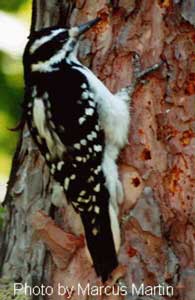
Picoides villosus
(Hairy Woodpecker)
Order: Piciformes
Order Description: Woodpeckers
Family: Picidae
Family Description: Woodpeckers
Physical Description:
8 1/2-10 1/2" (22-27 cm). A medium-sized, black-and-white woodpecker. Larger than its relative, the Downy. Black-and-white striped head with black eye-mask. Light belly and breast; white back; black wings with white spots; large bill. Tail black with white outer tail feathers. Male has small red patch on nape.
Similar Species- Downy Woodpecker, Strickland's Woodpecker
Song:
A loud, sharp, high-pitched peek!, and a short Kingfisher-like rattle.
Distribution:
Breeds from western and central Alaska, east to northern Saskatchewan and Newfoundland, and south to northern Baja California, highlands of Middle America, Gulf Coast, and southern Florida. Winters generally throughout breeding range; more northern populations are partially migratory.
Habitat:
Found in forests, open woodlands, swamps, well-wooded towns and parks, and open situations with scattered trees.
Diet:
Eats mainly insects (beetles, ants, and caterpillars, but especially boring larvae). Also eats other invertebrates, and some fruits and nuts. Seeds may be important food in winter.
Ecology:
Uses various foraging substrates, ranging from dead and live trees to downed wood and ground. May concentrate feeding in areas of insect outbreaks. Nests in cavity in tree or standing snag. Uses tree cavities for roosting and winter cover. Female spends entire year on breeding territory, and is joined in late winter by male. Reported territory size is 0.6-15 ha (varies with habitat quality). In eastern U.S., individuals use forest areas of 2-4 ha or larger, though much larger area (possibly 12 ha) may be needed to support viable breeding population. In Iowa study, minimum width of riparian forest necessary to support breeding population was 40 m. Idaho study in hemlock and grand fir forests found species occurring in all life forms from burned and shrub areas to mature forests.
Reproduction:
Both sexes incubate 3- 6 eggs (usually 4) for 11-12 days. Young leave nest at 28-30 days, rely on parents for about 2 more wk, and may return to nest to roost.
Conservation:
| Element Code: | ABNYF07040 |
| Status: | Protected nongame species |
| Global Rank: | G5 |
| State Rank: | S3 |
| National Rank: | N5 |
Important State References:
Peterson, S.R. 1982. A preliminary survey of forest bird communities in northern Idaho. Northwest Sci. 56:287-298.
Photo by Marcus Martin,© 1999
Design by Ean Harker©1999, 2000.
Written by Jason Karl, 2000.
Picoides arcticus
(Black-backed Woodpecker)
Link to photo provided by USGS - Patuxent Wildlife Research Center: http://www.mbr-pwrc.usgs.gov/Infocenter/infocenter.html
Order: Piciformes
Order Description: Woodpeckers
Family: Picidae
Family Description: Woodpeckers
Physical Description:
Size: 9-10"(23-25cm). A black and white woodpecker. Back glossy black. Lacks any white patterning on its back. Head glossy black with a narrow white line behind the eye and heavy white mustache. Males have a yellow cap on their head. rump and tail black. Sides heavily barred. Belly white.
Similar Species- Three-toed Woodpecker has a white ladder pattern on its back and more white behind the eye. Hairy and Downy Woodpeckers have white on their backs and lack the barred sides.
Song:
Call note is a sharp Pik! Drumming sounds like a drum roll, increasing in tempo at the end.
Distribution:
Resident, often locally, from western and central Alaska to northern Saskachewan and central Labrador, and south to southeastern British Columbia, central California, northwestern Wyoming, portions of Great Plains states and Prairie Provinces, and northern New England. Wanders irregularly south in winter.
Habitat:
Found in coniferous forests (primarily spruce/fir), especially in windfalls and burned areas with standing dead trees. Found less frequently in mixed forests, and rarely in deciduous woodlands in winter.
Diet:
Eats mainly wood- boring insects, but will also eat spiders, fruits, nuts, and some cambium.
Ecology:
Excavates new cavity each year, in decaying tree or standing snag. Forages on bark. Populations can be irruptive in recent burns. Few nests have been located in Idaho. In Oregon, home range size varied from 70-324 ha, and there was no intraspecific overlap.
Reproduction:
Both sexes incubate 2- 6 eggs (usually 4) for 14 days. Young are tended by both parents.
Conservation:
| Element Code: | ABNYF07090 |
| Status: | Protected nongame species |
| Global Rank: | G5 |
| State Rank: | S3 |
| National Rank: | N4 |
Important State References:
Medin, D.E. 1985. Densities and nesting heights of breeding birds in a Idaho Douglas-fir forest. Northwest Sci. 59:45-52.
Design by Ean Harker©1999, 2000.
Written by Jason Karl, 2000.
Colaptes auratus
(Northern Flicker)
Link to photo provided by USGS - Patuxent Wildlife Research Center: http://www.mbr-pwrc.usgs.gov/Infocenter/infocenter.html
Order: Piciformes
Order Description: Woodpeckers
Family: Picidae
Family Description: Woodpeckers
Physical Description:
Size: 12.5-14" (32-36cm). A large woodpecker with a barred, cinnamon-brown back and spotted white belly. White rump, easily seen in flight, identifies this woodpecker. Gray head with brown crown and nape. Red mustache on male separated by a bold black collar from the spotted belly. Salmon-pink under-sides of tail and wings are conspicuous in flight.
Similar Species- No similar looking woodpeckers in Idaho. Pileated woodpecker gives a similar prolonged call, but lower pitched and descending. Female Williamson's Sapsucker.
Song:
Call note a strongly accented and descending Keee! Also Flicka-flicka-flicka! And a loud, prolonged series: week-week-week-week-week….
Distribution:
Breeds from tree limit in central Alaska and portions of Canada, south through British Columbia, eastern Montana, and interior (east of Rockies) to southern Texas, Gulf Coast, southern Florida, and Nicaragua. Winters from southern Canada, south through breeding range to southern Texas and Gulf Coast. Resident in portions of Southwest.
Habitat:
Found in forests (deciduous and coniferous), open woodlands, open situations with scattered trees and snags, riparian woodlands, pine/oak associations, parks, and deserts (usually containing large cacti). Preliminary results of Montana-Idaho study of old-growth and rotation-aged Douglas-fir found flickers are old-growth associates.
Diet:
Feeds on insects (ants, beetles, wasps, grasshoppers, grubs, etc.). Also eats fruits, berries, and seeds (clovers, grasses, ragweed, etc.).
Ecology:
Feeds on ground or catches insects in air. Nests in cavity in standing snag; may nest on houses, poles, or banks. May return to same nesting cavity year after year. Cavities excavated by flickers are used by many species of secondary cavity users.
Reproduction:
Both sexes incubate eggs for 11-12 days. clutch size is larger in northern range than in south. Nestlings are altricial. Young are tended by both adults, and leave nest 25-28 days after hatching.
Conservation:
| Element Code: | ABNYF10020 |
| Status: | Protected nongame species |
| Global Rank: | G5 |
| State Rank: | S5 |
| National Rank: | N5B,N5N |
Important State References:
Hejl, S.J. and R.E. Woods. 1990. Bird assemblages in old-growth and rotation-aged Douglas-fir/Ponderosa pine stands in the northern Rocky Mountains: a preliminary assessment. Pp. 93-100 in D.M. Baumgartner and J.E. Lotan, eds. Proceedings of a Symposium on Interior Douglas-fir: the species and its management. Feb 27, 1990, Spokane, WA.
Design by Ean Harker©1999, 2000.
Written by Jason Karl, 2000.
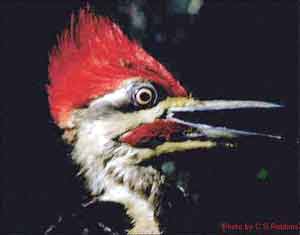
Dryocopus pileatus
(Pileated Woodpecker)
Order: Piciformes
Order Description: Woodpeckers
Family: Picidae
Family Description: Woodpeckers
Physical Description:
Size: 16-19.5" (41-50cm). A large white and black woodpecker with a distinctive red crest. Black and white striped face. Males have a red mustache. Long white throat stripe. White flanks and underwing linings can be seen in flight.
Similar Species- There are no similar looking species in Idaho. Northern flickers can sound like Pileated Woodpeckers. However, the call of the Flicker is higher pitched, generally faster, and does not descend.
Song:
A slow, loud Kee-kee-kee-kee-kee-kee! Often descending in pitch toward the end.
Distribution:
Resident across portions of Canada, south to central California, Idaho, western Montana, eastern Dakotas, Gulf Coast, and southern Florida.
Habitat:
Found in dense coniferous and mixed forests, open woodlands, second growth, and, locally, parks and wooded residential areas of towns. Preliminary results of Montana-Idaho study of old-growth and rotation-aged Douglas-fir found Pileated Woodpeckers are old-growth associates.
Diet:
Eats mainly ants and beetles, but will also eat other insects, fruits, and seeds.
Ecology:
Nests in cavity in standing snag, frequently in area free of bark. Oregon study found territory size to be 267-1056 ha; size was negatively correlated with percent forest overstory canopy cover, percent saw timber cover, and log and stump volume. Logs and stumps are important foraging substrates, but species will also dig into anthills.
Reproduction:
Both sexes incubate usually 3-4 eggs for 18 days. Young are tended by both parents, and leave nest in 22-26 days. Family group stays together until fall or later.
Conservation:
| Element Code: | ABNYF12020 |
| Status: | Protected nongame species |
| Global Rank: | G5 |
| State Rank: | S4 |
| National Rank: | N5 |
Important State References:
Hejl, S.J. and R.E. Woods. 1990. Bird assemblages in old-growth and rotation-aged Douglas-fir/Ponderosa pine stands in the northern Rocky Mountains: a preliminary assessment. Pp. 93-100 in D.M. Baumgartner and J.E. Lotan, eds. Proceedings of a Symposium on Interior Douglas-fir: the species and its management. Feb 27, 1990, Spokane, WA.
Photos by C. S. Robbins, ©2002
Design by Ean Harker©1999, 2000.
Written by Jason Karl, 2000.
Contopus cooperi
(Olive-sided Flycatcher)
Link to photo provided by USGS - Patuxent Wildlife Research Center: http://www.mbr-pwrc.usgs.gov/Infocenter/infocenter.html
Order: Passeriformes
Order Description: Passerines
Family: Tyrannidae
Family Description: Tyrant Flycatchers
Physical Description:
Size: 7-8" (18-20cm). A large, stocky, short-tailed flycatcher. Adults a drab olive-brown on the back and flanks. Olive of flanks almost meets on its white chest, giving it the appearance of wearing a vest. Head large with a thick bill. Immatures are similar to adults, but are often darker above and below.
Similar Species- Western Wood-Pewee is smaller, paler and longer tailed. Also lacks the vested look.
Song:
The song of the Olive-sided Flycatcher is a very distinct, three-parted whistle with the second note higher than the first and descending to the third. Some say it sounds like: Quick-Three-Beers! Call is a repetitious pip-pip-pip.
Distribution:
Breeds from portions of Alaska and Canada, south (west of Rockies) to northern Baja California, Arizona, New Mexico, and western Texas, and (east of Rockies) through portions of Midwest, Northeast, and middle Atlantic states. Winters in mountains of South America, and in small numbers in Central America and southern Mexico.
Habitat:
Found in forests and woodlands (especially in burned-over areas with standing dead trees) such as taiga, subalpine coniferous forests, mixed forests, boreal bogs, muskeg, and borders of lakes and streams. Idaho study found species responded psitively in numbers to single-tree logging.
Diet:
Eats insects.
Ecology:
Hunts from perch. Builds cup-shaped nest in coniferous or deciduous tree. Usually territorial in non-breeding areas.
Reproduction:
Female incubates 3-4 eggs for 16-17 days. Young usually leave nest in 15-19 days.
Conservation:
| Element Code: | ABPAE32010 |
| Status: | Protected nongame species |
| Global Rank: | G? |
| State Rank: | S?,NTMB |
Important State References:
Medin, D.E. and G.D. Booth. 1989. Responses of birds and small mammals to single-tree selection logging in Idaho. USDA Forest Service Int. Res. Station Res. Paper INT-408, Boise. 11pp.
Design by Ean Harker©1999, 2000.
Written by Jason Karl, 2000.
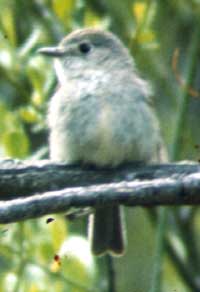
Empidonax traillii
(Willow Flycatcher)
Order: Passeriformes
Order Description: Passerines
Family: Tyrannidae
Family Description: Tyrant Flycatchers
Physical Description:
Size: 5.25-6.75" (13-17cm). This Empidonax flycatcher is olive- brown above and light on the throat, breast and belly. Pale eye-ring. Two white to off- white wing bars. Bill broad, dark above, light below.
Similar Species- Most Empidonax flycatchers are so similar in appearance that it is nearly impossible to tell them apart be sight alone without a bird in hand. Luckily, their songs and calls along with habitat are good diagnostics.
Song:
A sneezy, emphatic Ftiz-bhew! also a dry Whit!
Distribution:
Breeds from central British Columbia, east to southern Minnesota and Nova Scotia, and south to southern California, western and central Texas, Arizona, and portions of southeastern United States. Winters from central Mexico to Colombia.
Habitat:
Found in thickets, scrubby and brushy areas, open second growth, swamps, and open woodlands. In Idaho study of riparian birds, Willow Flycatchers were intermediate in association with mesic and xeric willow habitats.
Diet:
Eats insects.
Ecology:
Catches prey in air, or takes food from foliage. builds cup-shaped nest in shrub or deciduous tree. In Ontario study, territory size ranged from about 1000 to 4700 m2. Although Willow Flycatchers are declining in Pacific Northwest, their numbers in Idaho appear stable.
Reproduction:
Female incubates 3-4 eggs for 12-15 days. Young are tended by both parents, and leave nest at 12-15 days. Occasional polygyny may occur. High rate of cowbird parasitism occurs in northern Colorado.
Conservation:
| Element Code: | ABPAE33040 |
| Status: | Protected nongame species |
| Global Rank: | G5 |
| State Rank: | S4,NTMB |
| National Rank: | N5B |
Important State References:
Sharp, B. 1986. Management guidelines for the Willow Flycatcher. U.S. Fish and Wildlife Service, Portland. 21pp.
Photo by C. Trost ,©1999
Song by Gregory Gough, 1997
Design by Ean Harker©1999, 2000.
Written by Jason Karl, 2000.
Empidonax oberholseri
(Dusky Flycatcher)
Order: Passeriformes
Order Description: Passerines
Family: Tyrannidae
Family Description: Tyrant Flycatchers
Physical Description:
Size: 5.25-6" (13-15cm). Dark gray above (maybe with a slight olive tinge). buff throat and breast. Belly pale yellow. Thin white eye ring and wing bars.
Similar Species- Most Empidonax flycatchers are so similar in appearance that it is nearly impossible to tell them apart be sight alone without a bird in hand. Luckily, their songs and calls along with habitat are good diagnostics.
Song:
A three-parted Trip-per-Wheet! with the last note higher. Note is a dry Whit!
Distribution:
Breeds from portions of western Canada and western U.S., south to southern California, southern Nevada, southwestern Utah, central Arizona, and central and northeastern New Mexico. Winters from southern California (casually), southern Arizona, and northern Mexico, south (mostly in highlands), to portions of Mexico, and casually south to northwestern Guatemala.
Habitat:
Found in brushy habitat, thickets, open coniferous forests, mountain chaparral, aspen groves, and cottonwood forests. Often found near water. During migration and in winter, found in deserts. In preliminary results of Montana-Idaho study, species was found to be associated with rotation-aged Douglas-fir stands.
Diet:
Eats insects.
Ecology:
Builds cup-shaped nest in shrub or tree (frequently juniper or sage). Hunts from perch, or forages in foliage.
Reproduction:
Both sexes incubate 3- 4 eggs (usually), for 12-15 days. Young are tended by both adults, and leave nest about 18 days after hatching.
Conservation:
| Element Code: | ABPAE33090 |
| Status: | Protected nongame species |
| Global Rank: | G5 |
| State Rank: | S5 |
| National Rank: | N5B, NZN |
Important State References:
Hejl, S.J. and R.E. Woods. 1990. Bird assemblages in old-growth and rotation-aged Douglas-fir/Ponderosa pine stands in the northern Rocky Mountains: a preliminary assessment. Pp. 93-100 in D.M. Baumgartner and J.E. Lotan, eds., Proceedings of a Symposium on Interior Douglas-fir: the species and its management. Feb. 27, 1990, Spokane WA.
Design by Ean Harker©1999, 2000.
Written by Jason Karl, 2000.
Myiarchus cinerascens
(Ash-throated Flycatcher)
Link to photo provided by USGS - Patuxent Wildlife Research Center: http://www.mbr-pwrc.usgs.gov/Infocenter/infocenter.html
Order: Passeriformes
Order Description: Passerines
Family: Tyrannidae
Family Description: Tyrant Flycatchers
Physical Description:
7 1/2-8 1/2" (19-22 cm). Grayish brown above with a rich brown tail; whitish below with yellowing belly. Bushy crest, dark eye, and black bill.
Similar Species- Great Crested, Brown- crested, and Dusky-capped flycatchers.
Song:
A rolling ka-wheer; more like a trill at the end.
Distribution:
Breeds from southwestern Oregon, eastern Washington, southern Idaho, southwestern Wyoming, Colorado, New Mexico, northern and central Texas, and sometimes Oklahoma, south to Baja California and mainland of Mexico. Winters from northern Baja California, southeastern California, and central Arizona, south into mainland of Mexico and portions of Central America.
Habitat:
Found in shrub steppe, pinyon/juniper and oak woodlands, chaparral, thorn scrub, and riparian woodlands. Also found in open deciduous woodlands in winter.
Diet:
Primarily insectivorous (consumes bees, wasps, ants, caterpillars, moths, grasshoppers, etc.). Will also eat spiders and some berries.
Ecology:
Nests in natural or abandoned cavity in tree; may occasionally nest in fence post. May displace small woodpeckers from nesting holes. Often forages by flying out from perch and catching prey in air.
Reproduction:
Female incubates 3-7 eggs (usually 4-5), for about 15 days. Young are altricial, are tended by both parents, and leave nest in 16-17 days.
Conservation:
| Element Code: | ABPAE43050 |
| Status: | Protected nongame species |
| Global Rank: | G5 |
| State Rank: | S3,NTMB |
| National Rank: | N5B,N4N |
Important State References:
No references are available at this time.
Design by Ean Harker©1999, 2000.
Written by Jason Karl, 2000.
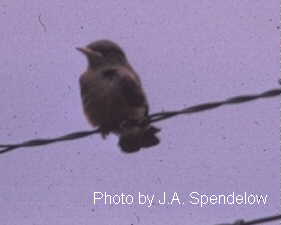
Sayornis saya
(Say's Phoebe)
Order: Passeriformes
Order Description: Passerines
Family: Tyrannidae
Family Description: Tyrant Flycatchers
Physical Description:
7-8" (18-20 cm). Gray above, lighter grayish-brown to breast, and orange belly. Dark eyes and bill. Immatures have two rufous wing bars.
Similar Species- Eastern Phoebe, Vermillion Flycatcher.
Song:
A down-slurred whistle, pwe-whurr, occasionally followed by a higher trill.
Distribution:
Breeds from Alaska and portions of western Canada, south to central Mexico. Winters from northern California, northern Arizona, New Mexico, and southern Texas, south to Baja California and south-central mainland of Mexico.
Habitat:
Found in arid, open country such as shrub steppe, dry barren foothills, canyons, cliffs, and around ranches.
Diet:
Eats insects (bees, wasps, ants, flies, beetles, butterflies, etc.) and other invertebrates (sow bugs, spiders, millipedes). Also feeds on some berries.
Ecology:
Builds cup-shaped nest on cliff, wall, bridge, or under eaves of buildings. forages by darting out from perch to capture prey in air; may also forage in foliage. Often Hovers in air.
Reproduction:
Female incubates 3-7 eggs (usually 4-5), for 12-14 days. Young are altricial and downy, are tended by both parents, and leave nest in about 14 days. Male may tend first brood while female renests.
Conservation:
| Element Code: | ABPAE35030 |
| Status: | Protected nongame species |
| Global Rank: | G5 |
| State Rank: | S5,NTMB |
| National Rank: | N4N,N5B |
Important State References:
No references are available at this time.
Original images provided by Jeff Spendelow,© 2000
Design by Ean Harker©1999, 2000.
Written by Jason Karl, 2000.
Tyrannus verticalis
(Western Kingbird)
Link to photo provided by USGS - Patuxent Wildlife Research Center: http://www.mbr-pwrc.usgs.gov/Infocenter/infocenter.html
Order: Passeriformes
Order Description: Passerines
Family: Tyrannidae
Family Description: Tyrant Flycatchers
Physical Description:
8-9" (20-23 cm). Gray head with black bill, eye-stripe and eye; whitish back and breast; orange-yellow belly; dusky wings; black tail with white outer feathers.
Similar Species- Eastern, Cassin's, and Tropical kingbirds.
Song:
A squeaky twit-twit tchery-ity-it.
Distribution:
Breeds from southwestern Canada, south to northern Baja California, northwestern mainland of Mexico and west-central Texas, and east to northwestern Ohio (rarely to Missouri). Winters mainly from Mexico, south to Costa Rica, and in small numbers in coastal southeastern United States.
Habitat:
Found in open and partly- open country, especially savannas, agricultural lands, and areas with scattered trees. May also be found in deserts.
Diet:
Primarily insectivorous (eats wasps, beetles, moths, caterpillars, grasshoppers, and true bugs). Will also eat spiders, millipedes, and some fruits. May accasionally take tree frogs.
Ecology:
Feeds in air or on ground. Builds cup-shaped nest in tree, usually near trunk. Two or more pairs may nest in same tree. May drive hawks, crows, and jays away from nest.
Reproduction:
clutch size varies from 3-5 eggs, but is often 4. Incubation lasts 12-14 days. Nestlings are tended by both parents. Reproductive success is positively correlated with insect abundance.
Conservation:
| Element Code: | ABPAE52050 |
| Status: | Protected nongame species |
| Global Rank: | G5 |
| State Rank: | S5,NTMB |
| National Rank: | N5B |
Important State References:
No references are available at this time.
Design by Ean Harker©1999, 2000.
Written by Jason Karl, 2000.
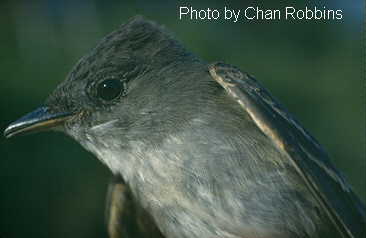
Contopus sordidulus
(Western Wood-pewee)
Order: Passeriformes
Order Description: Passerines
Family: Tyrannidae
Family Description: Tyrant Flycatchers
Physical Description:
Size: 6-6.5" (15-17cm). Dark olive-gray above and lighter gray below. slightly crested head. Lacks eye-ring. Two distinct white wing bars.
Similar Species- Empidonax flycatchers have white eye rings, rounder heads and longer tails. Easily separated by call.
Song:
A strong peee-a-wheeet! slurring up to the last syllable. Also a down-slurred peeer! Calls incessantly.
Distribution:
Breeds from east-central Alaska, south through western Canada to western U.S., southern Baja California, interior highlands of Mexico, and portions of Central America. Winters mainly in Colombia and Venezuela, south to Peru and Bolivia, and casually to Costa Rica.
Habitat:
Found in forests and forest edges and woodlands (especially coniferous or mixed coniferous/deciduous forests), and in poplar or riparian woodlands. Idaho study found preference for open canopy in cottonwood forest with willow subcanopy.
Diet:
Feeds on wide variety of insects including bees, wasps, ants, and flies.
Ecology:
Builds concealed nest in tree at end of branch. Hunts from perch. Idaho study conducted in cottonwood forests indicated pewees were more strongly associated with agricultural landscapes compared to more natural landscapes and avoided campground areas.
Reproduction:
Breeding begins in early May in southern range, to early June in north. Female incubates 3 eggs (sometimes 2-4), for about 12 days.
Conservation:
| Element Code: | ABPAE32050 |
| Status: | Protected nongame species |
| Global Rank: | G5 |
| State Rank: | S5,NTMB |
| National Rank: | N5B |
Important State References:
Saab, V.A. 1996. Influences of spatial scale and land-use practices on habitat relationships of breeding birds in cottonwood riparian forests. Ph.D. Dissertation, Univ. Colorado, Boulder. 140 pp.
Photos by C. S. Robbins and George Jameson, ©2002
Design by Ean Harker©1999, 2000.
Written by Jason Karl, 2000.
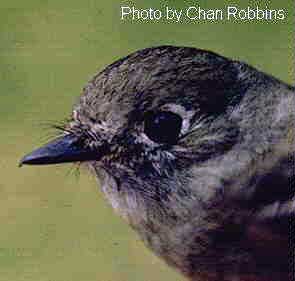
Empidonax hammondii
(Hammond's Flycatcher)
Order: Passeriformes
Order Description: Passerines
Family: Tyrannidae
Family Description: Tyrant Flycatchers
Physical Description:
Size: 5-5.5" (13-14cm). This Empidonax flycatcher is olive-gray above with a light throat, and breast and yellowish belly. Thin white eyering and wing bars. Bill narrower and shorter than other Empids. Flicks wings and tail more vigorously than other Empids.
Similar Species- Most Empidonax flycatchers are so similar in appearance that it is nearly impossible to tell them apart be sight alone without a bird in hand. Luckily, their songs and calls along with habitat are good diagnostics.
Song:
A thin Zee-beek! Also a buzzy Tzurrek! Note a thin Pip!
Distribution:
Breeds from east-central Alaska and western Canada, south through northwestern U.S. to east-central California, eastern Nevada, Utah, northeastern Arizona, western Colorado and north-central New Mexico. Winters from southeastern Arizona, south through highlands of Mexico to portions of Central America.
Habitat:
Found in coniferous forests and woodlands. During migration and in winter, found in deserts and scrub, and in pine and pine/oak associations. In preliminary results of Idaho-Montana study, Hammond's Flycatchers were found to be old-growth associates in Douglas-fir/ponderosa pine forests.
Diet:
Eats insects such as beetles, moths, flies, bees, and wasps.
Ecology:
Builds cup-shaped nest in coniferous (sometimes deciduous) tree. Hunts from perch.
Reproduction:
Female incubates 2-4 eggs for 15 days. Young are tended by both adults, and leave nest 17-18 days after hatching.
Conservation:
| Element Code: | ABPAE33080 |
| Status: | Protected nongame species |
| Global Rank: | G5 |
| State Rank: | S5 |
| National Rank: | N5B,NZN |
Important State References:
Hejl, S.J. and R.E. Woods. 1990. Bird assemblages in old-growth and rotation-aged Douglas-fir/Ponderosa pine stands in the northern Rocky Mountains: a preliminary assessment. Pp. 93-100 in D.M. Baumgartner and J.E. Lotan, eds., Proceedings of a Symposium on Interior Douglas-fir: the species and its management. Feb. 27, 1990, Spokane WA.
Photo by C. S. Robbins,© 2002
Design by Ean Harker©1999, 2000.
Written by Jason Karl, 2000.
Empidonax wrightii
(Gray Flycatcher)
Link to photo provided by USGS - Patuxent Wildlife Research Center: http://www.mbr-pwrc.usgs.gov/Infocenter/infocenter.html
Order: Passeriformes
Order Description: Passerines
Family: Tyrannidae
Family Description: Tyrant Flycatchers
Physical Description:
Size 5.5-6" (14-15cm). This Empidonax is gray above and light below (some birds may show an olive tinge on the back). Medium eye ring. Bill long with flesh-colored lower mandible. Pale white wing bars. Tail long, often showing white edges.
Similar Species- Most Empidonax flycatchers are so similar in appearance that it is nearly impossible to tell them apart be sight alone without a bird in hand. Luckily, their songs and calls along with habitat are good diagnostics.
Song:
A staccato, two-syllable song. Che-whip! or Che-whey! Note a dry Whit!
Distribution:
Breeds from central Oregon, southwestern Idaho, southwestern Wyoming, northeastern Utah, and central Colorado, south to east-central California, southern Nevada, central Arizona, and west-central New Mexico. Winters from southern California and central Arizona, south to Baja California and south-central mainland of Mexico.
Habitat:
Found in arid woodlands and brushy areas. During migration and in winter, also found in arid scrub, riparian woodlands, and mesquite. Idaho study found species more abundant in old-growth juniper stands than in prescribed burn or clearcut areas.
Diet:
Apparently eats small insects (beetles, grasshoppers, moths, etc.).
Ecology:
Hunts from perch; catches food in air or on ground. Builds cup-shaped nest in shrub or tree (frequently juniper or sage). Breeding population of approximately 25 pairs/100 ha has been reported in Oregon. Chipmunks and jays have been observed destroying nests.
Reproduction:
Female incubates 3-4 eggs for 14 days. Nestlings are altricial and downy, are tended by both parents, leave nest in 16 days, and are fed by parents for 14 more days.
Conservation:
| Element Code: | ABPAE33100 |
| Status: | Protected nongame species |
| Global Rank: | G5 |
| State Rank: | S2,NTMB |
| National Rank: | N5B,NZN |
Important State References:
McCoy, M. 1993. Breeding bird survey of clearcut, prescribed burn, and seral/old growth stands of western juniper. USDI Bur. Land Manage., Boise District, Challenge Cost Share Project Report, Boise. 19pp.
Design by Ean Harker©1999, 2000.
Written by Jason Karl, 2000.

Empidonax occidentalis
(Cordilleran Flycatcher)
Order: Passeriformes
Order Description: Passerines
Family: Tyrannidae
Family Description: Tyrant Flycatchers
Physical Description:
Size: 5.75" (15cm). This species was once lumped with the Pacific-Slope Flycatcher into the species of Western Flycatcher. These two species are almost indistinguishable by sight. Range and song are the most useful discriminators. Olive-brown above. Throat gray to white, yellowish belly. Eye ring tear-shaped.
Similar Species- Most Empidonax flycatchers are so similar in appearance that it is nearly impossible to tell them apart be sight alone without a bird in hand. Luckily, their songs and calls along with habitat are good diagnostics.
Song:
A three-parted Pseet-Trip-Pseet! Call note a two-syllable Whip-eeep! ending upward.
Distribution:
Breeds from southeastern Washington, southwestern Alberta, northern Idaho, western Montana, Wyoming, and western South Dakota, south (generally east of Cascades and Sierra Nevada) to Northern California, Nevada, portions of Arizona and Mexico, western Texas, and western Nebraska. Winters from southern Baja California and northern Mexico, south through breeding range.
Habitat:
Found in wooded areas ranging from riparian woodlands through aspens into coniferous forest zones; extends out into shrub steppe during nonbreeding season. Also found in shady canyon bottoms. In winter, found mostly in mixed woodlands and forests.
Diet:
Mainly insectivorous, but also east small amounts of seeds and berries.
Ecology:
Nests on rocky ledge, dirt bank, in mouth of mine tunnel, or in protected spot around building (commonly aroung mountain cabins).
Reproduction:
Female incubate 3-4 eggs for 12-13 days. Nestlings fledge at 14-18 days.
Conservation:
| Element Code: | ABPAE33160 |
| Status: | Protected nongame species |
| Global Rank: | G5 |
| State Rank: | S4,NTMB |
| National Rank: | N5B |
Important State References:
No references are available at this time.
Photo by C. Trost,© 2000
Design by Ean Harker©1999, 2000.
Written by Jason Karl, 2000.
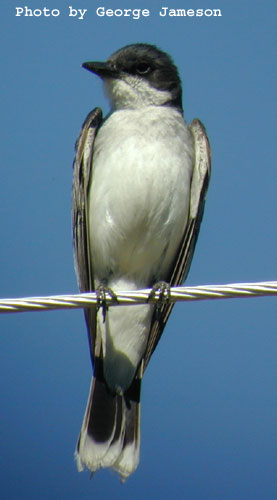
Tyrannus tyrannus
(Eastern Kingbird)
Order: Passeriformes
Order Description: Passerines
Family: Tyrannidae
Family Description: Tyrant Flycatchers
Physical Description:
8-9" (20-23 cm). White below; blackish head and tail, dusky back and wings. Tail is white tipped, wings have slight white edging.
Similar Species- Western Kingbird
Song:
A series of kit-kit-kit that speeds up and then has a two-noted, higher pitched ending.
Distribution:
Breeds across portions of Canada, south to northeastern California, Utah, New Mexico, Gulf Coast, and Florida. Winters in portions of South America.
Habitat:
Found in forest edges, open situations with scattered trees and shrubs, cultivated lands with bushes and fencerows, and parks. In Idaho, usually associated with riparian zones.
Diet:
Eats mainly insects, but will also eat seeds and small fruits.
Ecology:
Forages in air, on ground, or on water surface. Builds cup-shaped nest, usually midway in tree; may nest on fence post or stump. Will harass larger birds, and defend nest against humans.
Reproduction:
Female incubates 3-5 eggs for 12-13 days (perhaps longer). Young are tended by both parents, and leave nest at about 13-14 days. Parents continue to feed young for up to 5 additional wk.
Conservation:
| Element Code: | ABPAE52060 |
| Status: | Protected nongame species |
| Global Rank: | G5 |
| State Rank: | S4,NTMB |
| National Rank: | N5B |
Important State References:
No references are available at this time.
Photos by Marcus Martin and George Jameson, ©2002
Design by Ean Harker©1999, 2000.
Written by Jason Karl, 2000.
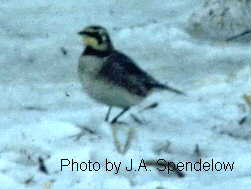
Eremophila alpestris
(Horned Lark)
Order: Passeriformes
Order Description: Passerines
Family: Alaudidae
Family Description: Larks
Physical Description:
7-8" (18-20 cm). Brown above and white below; small, black "horns", black moustache, and black bib; yellow wash on throat and face. Immatures have darker back and brown spotted faces.
Song:
Male sings a tinkling song that ends emphatically.
Distribution:
Breeds from northernmost North America, south to southern Baja California, southern Mexico, Louisiana, northern Alabama, and North Carolina. Winters in southern Canada, south through breeding range, and locally and irregularly to Gulf Coast and Florida.
Habitat:
Found in grasslands, tundra, sandy regions, shrub steppe, grazed pastures, stubble fields, open cultivated areas, and (rarely) open areas in forest.
Diet:
Eats mainly seeds and some insects.
Ecology:
Obtains most food from ground surface. Builds nest in depression on ground. Female may perform distraction displays. In Nevada study, breeding density was 1.3-1.5 individuals/ha in shadscale habitat. Horned Lark is one of the most abundant birds in deserts of southern Idaho.
Reproduction:
Egg-laying occurs early March at northern end of range. Female incubates 2-7 eggs (commonly 4) for 10-14 days. Females produce 1 brood annually at higher latitudes and elevations, 2 or possibly 3 at lower ones. Young are tended by both parents, and leave nest at 9-12 days. Idaho study found grazing may have delayed onset of nesting activities.
Conservation:
| Element Code: | ABPAT02010 |
| Status: | Protected nongame species |
| Global Rank: | G5 |
| State Rank: | S5,NTMB |
| National Rank: | N5B,N5N |
Important State References:
Reynolds, T.D. and C.H. Trost. 1981. Grazing, crested wheatgrass, and bird populations in southeastern Idaho. Northwest Sci. 55:225-234.
Original images provided by J. A. Spendelow,© 2000
Design by Ean Harker©1999, 2000.
Written by Jason Karl, 2000.
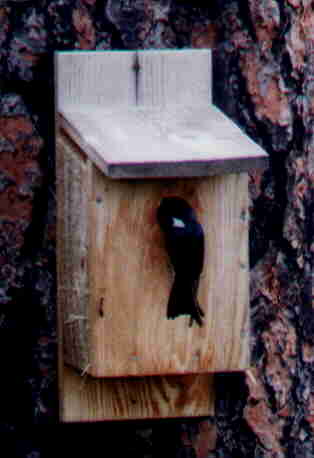
Tachycineta bicolor
(Tree Swallow)
Order: Passeriformes
Order Description: Passerines
Family: Hirundinidae
Family Description: Swallows
Physical Description:
5-6" (13-15 cm). Males have metallic blue to blue-green above and white below. Females are brown above. Have a slightly notched tail.
Similar Species- Violet-green, Bank, and Northern Rough-winged swallows.
Song:
Liquid twew-twew-twew variations.
Distribution:
Breeds from western Alaska to Newfoundland, south to southern California, Nevada, Arizona, and New Mexico, and east to portions of southeastern United States. Winters primarily from southern California and extreme southern U.S., south through Mexico to portions of Central America.
Habitat:
Found in open situations near water, including streams, lakes, ponds, marshes and coastal regions, savannas, and pastures.
Diet:
Eats insects and spiders. Occasionally eats some seeds and fruits.
Ecology:
Forages in air or on ground. Nests in cavity in standing snag. Nests alone or in loose colony. Many individuals may congregate where food is abundant, or form roosts when weather is cold. When not breeding, flocks may contain thousands of individuals.
Reproduction:
Egg are laid late April to late June in southern range, and early May to mid-June in north. Female (typically) incubates 4-6 eggs for 13-16 days. Nestlings are altricial and downy. Young are tended by both sexes, leave nest 16-24 days after hatching, and receive little parental care after that. Species is generally monogamous, but sometimes polygynous if food is superabundant. Inclement weather and resulting scarcity of food may result in high nestling mortality in some years.
Conservation:
| Element Code: | ABPAU03010 |
| Status: | Protected nongame species |
| Global Rank: | G5 |
| State Rank: | S5,NTMB |
| National Rank: | N5B,N5N |
Important State References:
No references are available at this time.
Photo by Jason Karl,© 1999
Design by Ean Harker©1999, 2000.
Written by Jason Karl, 2000.
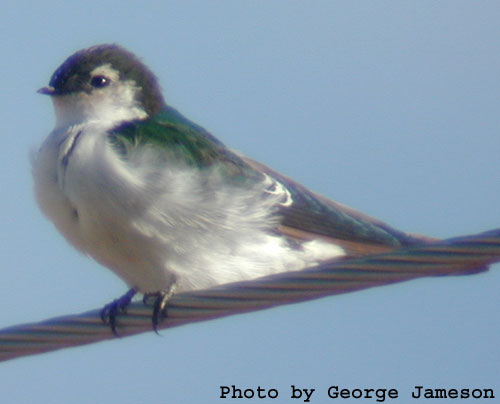
Tachycineta thalassina
(Violet-green Swallow)
Order: Passeriformes
Order Description: Passerines
Family: Hirundinidae
Family Description: Swallows
Physical Description:
5-5 1/2" (13-14 cm). Green crown and back often overlaid with a purple gloss in males; white face and underparts; bronze wings; white rump; dark bronze, slightly forked tail.
Similar Species- White-throated Swift, Tree Swallow
Song:
High, whistled dee-chip.
Distribution:
Breeds from portions of Alaska and western Canada, south through Montana and portions of Great Plains to southern baja California and northern mainland of Mexico; also breeds south through Colorado to western Texas. Winters from portions of California, south through interior Mexico to portions of Central America.
Habitat:
Found in open forest (coniferous, deciduous or mixed), and in woodlands (primarily in highlands, but frequently at low elevations in northern range). During migration and in winter, also found in meadows, fields and watercourses, more commonly in highland regions.
Diet:
Feeds on flying insects (e.g., flies, leafhoppers, ants, wasps, bees, beetles, moths, midges, and mayflies).
Ecology:
Forages over ponds, fields, and wooded areas, catching prey in flight. May occasionally forage on ground, on accumulations of insects. Nests in cavity in tree. May form loose nesting colonies if nest sites are abundant. Arizona study found 2.5-15 breeding pairs/40 ha in northern part of state; up to 50 pairs/40 ha in thinned forest with added nest boxes.
Reproduction:
Eggs are laid May to early July in southern range; egg laying begins in late May in north. Female incubates 4-5 eggs (sometimes 6 in northern range; fewer in south), for 13-15 days. altricial nestlings are tended by both parents, and leave nest in 23-25 days. Female usually produces 1 brood/season, although 2 broods/season have been reported in Oregon.
Conservation:
| Element Code: | ABPAU03040 |
| Status: | Protected nongame species |
| Global Rank: | G5 |
| State Rank: | S5,NTMB |
| National Rank: | N5B,NZN |
Important State References:
No references are available at this time.
Photo by George Jameson, ©2002.
Design by Ean Harker©1999, 2000.
Written by Jason Karl, 2000.

Stelgidopteryx serripennis
(Northern Rough-winged Swallow)
Order: Passeriformes
Order Description: Passerines
Family: Hirundinidae
Family Description: Swallows
Physical Description:
5-5 3/4" (13-15 cm). Light brown above and whitish below with dusky throat; short, notched tail.
Similar Species- Bank Swallow, immature Tree Swallow
Song:
A trilled Brrrrt.
Distribution:
Breeds from southeastern Alaska (rarely) and southern Canad, south through U.S., Mexico, and portions of Central America to Costa Rica. Winters from southern Texas, southern Louisiana, and southern Flroida, south through breeding range to Panama.
Habitat:
Found in open and partly- open situations, especially along watercourses with steep banks and roadside cuts.
Diet:
Eats insects (e.g., flies, wasps, bees, and beetles).
Ecology:
Swoops low over open ground or water to obtain food. May occasionally scavenge on ground. Burrows in or uses soil for nest. Nests singly or in small, scattered groups. May form loose colonies. sometimes nests in Bank Swallow colonies.
Reproduction:
Female incubates 4-8 eggs (usually 6-7), for 15-16 days. Nestlings are altricial, are tended by both adults, and leave nest when 18-21 days old. Female will re-lay if first nestling attempt fails.
Conservation:
| Element Code: | ABPAU07010 |
| Status: | Protected nongame species |
| Global Rank: | G5 |
| State Rank: | S5,NTMB |
| National Rank: | N5B,N5N |
Important State References:
No references are available at this time.
Photo by J. A. Spendelow
Design by Ean Harker©1999, 2000.
Written by Jason Karl, 2000.
Riparia riparia
(Bank swallow)
Link to photo provided by USGS - Patuxent Wildlife Research Center: http://www.mbr-pwrc.usgs.gov/Infocenter/infocenter.html
Order: Passeriformes
Order Description: Passerines
Family: Hirundinidae
Family Description: Swallows
Physical Description:
4 3/4-5 1/2" (12-14 cm). Brown above and white below with a brown breast band. Notched tail.
Similar Species- Northern Rough-winged Swallow, Tree Swallow
Song:
A soft, dry, chattering rattle.
Distribution:
Breeds from portions of Alaska, east to Newfoundland, and south to southern California and eastern Virginia. Winters mainly from eastern Panama to Peru and northern Argentina, and casually in Central America.
Habitat:
Found in open and partly- open situations, frequently near flowing water.
Diet:
Feeds primarily on flying insects (e.g., beetles, mosquitoes, winged ants, flies, and moths).
Ecology:
Catches food in air over fields, wetlands, and water. If necessary, may forage up to several km from nesting area. Burrows in or uses soil for nest. Forms colonies of various sizes; largest colonies, which may reach several hundred pairs, often occur in artificial sites. When not breeding, may form flocks of hundreds or thousands. Inclement weather and resulting scarcity of food may be important factor in nestling mortality in some years; erosion of nest sites and predators also sometimes destroy nests.
Reproduction:
Both sexes incubate 4- 8 eggs (usually 4-5), for 12-16 days. Young are altricial, are tended by both sexes, leave nest when 18-22 days old, and return to original burrow for few days after first flight. In some areas in southern range, females may produce 2 broods.
Conservation:
| Element Code: | ABPAU08010 |
| Status: | Protected nongame species |
| Global Rank: | G5 |
| State Rank: | S5,NTMB |
| National Rank: | N5B |
Important State References:
No references are available at this time.
Design by Ean Harker©1999, 2000.
Written by Jason Karl, 2000.
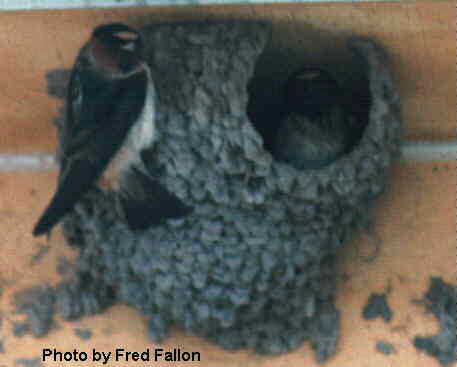
Petrochelidon pyrrhonota
(Cliff Swallow)
Order: Passeriformes
Order Description: Passerines
Family: Hirundinidae
Family Description: Swallows
Physical Description:
5-6" (13-15 cm). Dark brown to black above with buff forehead, chestnut neck, and cinnamon rump; buff below. Tail slightly forked, but often appears square.
Similar Species- Cave Swallow, young Barn Swallows
Song:
Loud churr or chew notes.
Distribution:
Breeds from Alaska and portions of Canada, south to central Mexico, western Texas, Missouri, and portions of southeastern United Staes. Winters in South America.
Habitat:
Found in open to semi- wooded habitat (such as cliffs, canyons, and farms) near meadows, marshes, and water.
Diet:
Primarily insectivorous; often feeds on small, swarming insects. Eats beetles, flying ants, wasps, grasshoppers, mosquitoes, and other insects.
Ecology:
gregarious at all seasons. Constructs nest on cliff, or under bridge, culvert, or eaves. Nests in colonies of up to 1000+ individuals (few hundred is average). Catches prey in air. Forages usually within 0.5 km of colony, but will sometimes travel several kilometers. Periodically, populations may decline drastically due to prolonged spring or summer rains and reduced food availability. Parasitic swallow bug is sometimes abundant enought to reduce reproductive success in large colonies.
Reproduction
Both parents incubate 2-6 eggs (usually 3-5), for about 12-14 days. Young are tended by both parents, and are able to fly at 23 days. Female usually produces 1 brood/year; a few have a second brood.
Conservation:
| Element Code: | ABPAU09010 |
| Status: | Protected nongame species |
| Global Rank: | G5 |
| State Rank: | S5,NTMB |
Important State References:
No references are available at this time.
Photo by Fred Fallon, 2002
Design by Ean Harker©1999, 2000.
Written by Jason Karl, 2000.
Hirundo rustica
(Barn swallow)
Link to photo provided by USGS - Patuxent Wildlife Research Center: http://www.mbr-pwrc.usgs.gov/Infocenter/infocenter.html
Order: Passeriformes
Order Description: Passerines
Family: Hirundinidae
Family Description: Swallows
Physical Description:
5 3/4-7 3/4" (15-20 cm). Bluish-black above, rufous below; long, deeply forked tail.
Similar Species- Cliff Swallow
Song:
A series of soft, twittering notes.
Distribution:
Breeds from portions of Alaska, east across much of Canada, and south through much of U.S. to central Mexico. Winters from Costa Rica through South America.
Habitat:
Found in open situations, less frequently in partly-open habitats, frequently near water and agricultural areas.
Diet:
Eats insects (e.g., grasshoppers, dragonflies, leafhoppers, beetles, etc.). Rarely eats berries.
Ecology:
Constructs cup-shaped nest on building, bridge, culvert, or cliff. May nest in small colonies. When not breeding, may form flocks of up to thousands. Flies over open land and water and forages for prey; may occasionally take prey from ground or vegetation. When breeding, usually forages within few hundred meters of nest.
Reproduction
clutch size varies from 4-5 eggs. Incubation lasts 13-17 days (less often 11-19 days), and is performed mainly by female. Young are tended by both adults, fledge at 18-23 days, and stay together and are fed by parents for about 1 wk. Females first breed at 1 yr (a few males remain unpaired until 2 yr). Adults often have same mate in successive years. Females often have 2 broods, except in far northern range. Juveniles may help feed young of second brood. Breeding birds tend to return to same colony and sometimes same nest.
Conservation:
| Element Code: | ABPAU09030 |
| Status: | Protected nongame species |
| Global Rank: | G5 |
| State Rank: | S5,NTMB |
| National Rank: | N5B |
Important State References:
No references are available at this time.
Design by Ean Harker©1999, 2000.
Written by Jason Karl, 2000.
Perisoreus canadensis
(Gray Jay)
Link to photo provided by USGS - Patuxent Wildlife Research Center: http://www.mbr-pwrc.usgs.gov/Infocenter/infocenter.html
Order: Passeriformes
Order Description: Passerines
Family: Corvidae
Family Description: Crows and Jays
Physical Description:
10-13" (25-33 cm). Dark gray above and light gray below. Wings and tail feathers are lighter on edges. White hood has a dark gray crown and/or nape. Immatures are more uniformly gray.
Similar Species- Other jays.
Song:
Short, hollow whistled notes as well as jay-like cackling. Usually quiet.
Distribution:
Breeds from western and central Alaska, east across Canada, and south to northern California, eastern Oregon, Idaho, Utah, eastern Arizona, northern New Mexico, Colorado, portions of Great Plains and Great Lakes states, and New England. Winters mainly through breeding range.
Habitat:
Found in coniferous and mixed coniferous/deciduous forests (primarily spruce), including open and partly-open woodlands and around bogs. Often found around campgrounds. In preliminary results of northern Idaho study, Gray Jays were more abundant in fragmented than in continuous stands of old-growth forest.
Diet:
Omnivorous. Feeds on insects, berries, lichen, mice, carrion, and scraps from campsites. Probably eats birds' eggs.
Ecology:
Builds cup-shaped nest in coniferous (sometimes deciduous) tree, usually near trunk. Usually seen in small family groups or in pairs. Forages on ground, or sometimes in foliage. Stores food.
Reproduction:
Female incubates 2-5 eggs (usually 3-4), for 16-18 days. Young are tended by both adults, and are capable of first flight when about 15 days old. Nest early, late Feb. or early March, using cached foo for female and young.
Conservation:
| Element Code: | ABPAV01010 |
| Status: | Protected nongame species |
| Global Rank: | G5 |
| State Rank: | S5 |
| National Rank: | N5 |
Important State References:
Hejl, S.J. and L.C. Paige. 1993. Birds in continuous and fragmented forests of western red cedar/western hemlock in northern Idaho: a preliminary assessment. Draft manuscript, USDA Forest Service Inter. Res. Sta., Missoula. 18pp.
Design by Ean Harker©1999, 2000.
Written by Jason Karl, 2000.
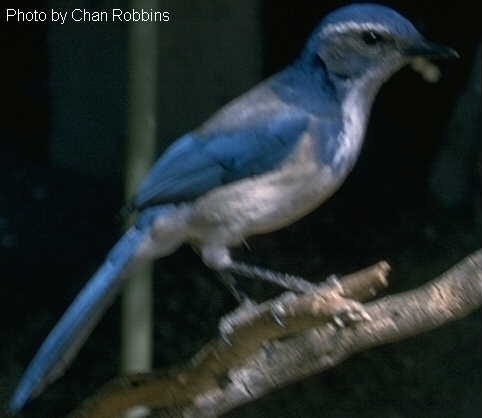
Aphelocoma californica
(Western Scrub Jay)
Order: Passeriformes
Order Description: Passerines
Family: Corvidae
Family Description: Crows and Jays
Physical Description:
11-13" (28-33 cm). Head, wings, and tail blue; back gray; breast whitish with incomplete blue necklace.
Similar Species- Gray-breasted Jay, Pinyon Jay
Song:
A coarse, squeaky iennk.
Distribution:
Resident from southwestern Washington, southwestern Wyoming, Colorado, and central Texas, south through southwestern U.S. to southern Baja California and Oaxaca, Mexico. Also resides in central Florida.
Habitat:
Found in scrub (especially oak, pinyon and juniper), brush, chaparral, and pine/oak associations. When not breeding, also found in riparian woodlands, gardens, orchards, and lowland brushy areas.
Diet:
Feeds on nuts (acorns, pinyon), grains (corn, oats), fruits, insects (wasps, bees, caterpillars, cutworms, grasshoppers, etc.), mollusks, eggs and young of small birds, mice, shrews, frogs, and lizards.
Ecology:
Builds cup-shaped nest in deciduous (occasionally coniferous) tree; will sometimes nest in shrub. Forages on ground. caches food, particularly nuts. Travels alone or in small family groups. In Florida, a similar species, groups of related birds defend year-round territories.
Reproduction:
Female incubates 2-7 eggs (usually 4-6), for 16 days. Young are tended by parents and (in Florida) young of previous brood. Young leave nest at about 18 days, and first breed as early as 1 yr in some areas, 2+ yr in Florida and on Santa Cruz Island, California. Adults form long-term pair bond. There is a high adult survivorship.
Conservation:
| Element Code: | ABPAV06040 |
| U.S. ESA Status: | LT |
| Status: | Protected nongame species |
| Global Rank: | G5 |
| State Rank: | S2 |
| National Rank: | N3 |
Important State References:
No references are available at this time.
Photo by C. S. Robbins, Š2002
Design by Ean Harker 1999, 2000.
Written by Jason Karl, 2000.
Nucifraga columbiana
(Clark's Nutcracker)
Link to photo provided by USGS - Patuxent Wildlife Research Center: http://www.mbr-pwrc.usgs.gov/Infocenter/infocenter.html
Order: Passeriformes
Order Description: Passerines
Family: Corvidae
Family Description: Crows and Jays
Physical Description:
12-13" (30-33 cm). Black wings and tail with large white patches; gray body with white undertail coverts; dark bill and eyes.
Similar Species- Gray Jay, Pinyon Jay
Song:
A guttural kraa-kraa, and a repeated, dry krak-krak-krak-krak-krak
Distribution:
Resident from central British Columbia, southwestern Alberta, western and central Montana, and western and southeastern Wyoming, south through mountains of central Washington, eastern Oregon, and central and eastern California and Nevada, to northern Baja California. Also present in Rockies to east-central Arizona and southern New Mexico. Wanders irregularly beyond normal range.
Habitat:
Found in open coniferous forests and in forest edges and clearings (primarily in mountains, but also in lowlands in winter). Preliminary results of Idaho-Montana study suggest Clark's Nutcrackers are more common in rotation-aged than old-growth Douglas-fir stands.
Diet:
Pine seeds are primary food for both adults and nestlings, but individuals will also eat insects, acorns, berries, snails, carrion, and, sometimes, eggs and young of small birds.
Ecology:
Builds cup-shaped nest in tree. Takes food from foliage. caches food; nearly all winter food, and much of breeding season food, is derived from pine seeds collected and stored in fall. May travel in large flocks (25-100 birds).
Reproduction:
Both sexes incubate 2- 6 eggs (usually 2-3), for 17-18 days. Young leave nest at 24-28 days.
Conservation:
| Element Code: | ABPAV08010 |
| Status: | Protected nongame species |
| Global Rank: | G5 |
| State Rank: | S5 |
| National Rank: | N5 |
Important State References:
Hejl, S.J. and R.E. Woods. 1990. Bird assemblages in old-growth and rotation-aged Douglas-fir/Ponderosa pine stands in the northern Rocky Mountains: a preliminary assessment. Pp. 93-100 in D.M. Baumgartner and J.E. Lotan, eds., Proceedings of a Symposium on Interior Douglas-fir: the species and its management. Feb. 27, 1990, Spokane WA.
Design by Ean Harker©1999, 2000.
Written by Jason Karl, 2000.
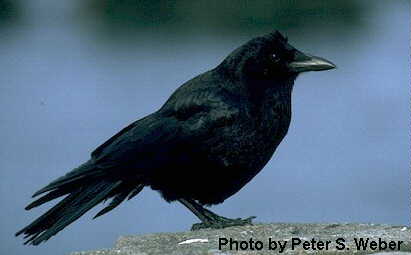
Corvus brachyrhynchos
(American Crow)
Order: Passeriformes
Order Description: Passerines
Family: Corvidae
Family Description: Crows and Jays
Physical Description:
17-21" (43-53 cm). Black overall with stubby bill and legs; tail squared and slightly fan-shaped.
Similar Species- Northwestern Crow, Common and Chihuahuan ravens
Song:
A slightly descending caw.
Distribution:
Breeds across portions of Canada, south to northern Baja California, Texas, Gulf Coast, and southern Florida. Winters from southern Canada, south throughout breeding range.
Habitat:
Found in open and partly- open country (primarily in humid situations), including agricultural lands, suburban areas, orchards, and tidal flats. Restricted mostly to riparian forests and adjacent areas in arid regions. Generally avoids dense coniferous forests and deserts.
Diet:
Eats various small vertebrates, invertebrates, carrion, grain, and fruits.
Ecology:
Builds cup-shaped nest in tree, occasionally in shrub. May form small breeding colonies and roost communally in winter. Forages on ground. May cooperatively forage and cache food.
Reproduction:
Both sexes incubate 3- 7 eggs (usually 4-6), for about 18 days. Young are tended by both parents, and first fly at 4-5 wk. Females produce 1 or 2 broods annually. yearlings may help dominant pair breed.
Conservation:
| Element Code: | ABPAV10010 |
| Status: | Protected nongame species |
| Global Rank: | G5 |
| State Rank: | S5 |
| National Rank: | N5B,N5N |
Important State References:
No references are available at this time.
Photos by Peter S. Weber,© 2000 and Jeff Spendelow,© 1999
Design by Ean Harker©1999, 2000.
Written by Jason Karl, 2000.
Cyanocitta stelleri
(Steller's Jay)
Link to photo provided by USGS - Patuxent Wildlife Research Center: http://www.mbr-pwrc.usgs.gov/Infocenter/infocenter.html
Order: Passeriformes
Order Description: Passerines
Family: Corvidae
Family Description: Crows and Jays
Physical Description:
11 1/2-13 1/2" (29-34 cm). Dark blue except for a black, crested head and black barring on wings and tail.
Similar Species- Blue Jay
Song:
A chook-chook-chook, a nasal kwheck-kwheck, and often a mimic of the Red- tailed Hawk's call.
Distribution:
Resident from portions of Alaska and southwestern Canada, south through western Montana, Wyoming, northern Colorado and western Nebraska to southern California and Arizona, east to portions of Colorado, New Mexico, and Texas, and south from there through highlands of Middle America to Nicaragua.
Habitat:
Found in coniferous and mixed coniferous/deciduous forests, in humid coniferous forests (in northwestern northern America), and in arid pine/oak. Also occurs in open woodlands, campsites, orchards, and gardens. A study in north-central Idaho found no differences in numbers among clearcut, fragmented, and contiguous stands of coniferous forest.
Diet:
Feeds on acorns, pine seeds, fruits, insects, spiders, small reptiles and amphibians, and eggs and young of small birds.
Ecology:
Builds cup-shaped nest in coniferous (occasionally deciduous) tree. May travel in flocks of a dozen or more, but is less gregarious than other jays. Forages in trees and on ground. caches food.
Reproduction:
Female incubates 3-5 eggs (usually 4). Nestlings are altricial. Young are tended by both adults.
Conservation:
| Element Code: |
ABPAV02010 |
| Status: | Protected nongame species |
| Global Rank: | G5 |
| State Rank: | S5 |
| National Rank: | N5 |
Important State References:
Hutto, R.L. 1993. Effects of clearcutting and fragmentation on the birds of a western coniferous forest. Final report to Clearwater National Forest, Univ. Montana, Missoula. 13pp.
Design by Ean Harker©1999, 2000.
Written by Jason Karl, 2000.
Gymnorhinus cyanocephalus
(Pinyon Jay)
Order: Passeriformes
Order Description: Passerines
Family: Corvidae
Family Description: Crows and Jay
Physical Description:
9-11 3/4" (23-30 cm). Blues and grays fading into one another; throat streaked with light gray; black, spike-like bill; legs and eyes black.
Similar Species- Other jays, Mountain Bluebird
Song:
A high-pitched caaa, sometimes sounds like wicked laughter.
Distribution:
Resident from central Oregon, east-central Montana, and western South Dakota, south to northern Baja California, central Nevada, and western Oklahoma. Occurs irregularly to southern Washington, northern Idaho, southwestern Saskatchewan, Great Basin and parts of Midwest, and portions of Mexico.
Habitat:
Found in pinyon/juniper woodlands, less frequently in pine. When not breeding, also found in scrub oak and sagebrush.
Diet:
Eats pinyon and other pine seeds, berries, small seeds, and grain. Also eats larvae, nymphs, and adults of insects such as beetles, grasshoppers, caterpillars, and ants. May eat birds' eggs and hatchlings.
Ecology:
Gregarious; forms complex social organizations. Forages on ground or in foliage. May cache seeds communally and live in loose flock (flock has an established home range but may wander to other areas in search of food). Builds cup-shaped nest in juniper or pine. Breeds in loose, scattered colonies. During nesting season, flocks of yearlings may form. Nesting success is often low due to predation or severe weather.
Reproduction:
Female incubates 3-6 eggs (usually 3-4), for 15-17 days. Nestlings are altricial, are tended by both adults, and leave nest in about 3 wk. Adults remain paired throughout year. In Arizona study, pair bonds were apparently monogamous, perennial, and lasted average of 2.5 yr; males initiated breeding at average age of 2 yr, females at 1.6 yr, and deserted females were incapable of rearing offspring. Idaho study found jays had very low nesting success due to predation by Northern Harriers and Black-billed Magpies.
Conservation:
| Element Code: | ABPAV07010 |
| Status: | Protected nongame species |
| Global Rank: | G5 |
| State Rank: | S2 |
| National Rank: | N5 |
Important State References:
Brody, A. 1992. The sociality of pinon jays with and without pinon pine. M.S. Thesis, Idaho St. Univ., Pocatello. 179pp.
Design by Ean Harker©1999, 2000.
Written by Jason Karl, 2000.
Pica pica
(Black-billed Magpie)
Link to photo provided by USGS - Patuxent Wildlife Research Center: http://www.mbr-pwrc.usgs.gov/Infocenter/infocenter.html
Order: Passeriformes
Order Description: Passerines
Family: Corvidae
Family Description: Crows and Jays
Physical Description:
17 1/2-22" (44-56 cm). Iridescent black above with white shoulder and wing patches; white below with black throat and lower belly. Very long, iridescent black tail.
Similar Species- Yellow-billed Magpie
Song:
A nasal mag? mag? mag?
Distribution:
Resident from portions of Alaska and western Canada, south to eastern California, southern Nevada, southern Utah, extreme northeastern Arizona, northern New Mexico, western and northeastern Oklahoma, and western Kansas.
Habitat:
Found (in either arid or humid habitats) in open country (including grasslands), open situations with scattered trees, shrubby areas, riparian and open woodlands, and forest edges and farmlands.
Diet:
Eats insects, carrion, mice, snakes, some eggs and young of small birds, and some grains and fruits.
Ecology:
Often forages on ground. Usually seen in small flocks of 6-10 birds; larger flocks may form in winter. Builds enclosed, spherical nest in tree or sometimes in shrub. Nests in scattered, loose colonies, and roosts communally after breeding season, and especially in winter (Alberta study found up to 150 birds in February and March). Abandoned magpie nests often are used by other bird species as shelter, daytime retreat, or nests. Individuals roost in dense thickets of deciduous trees or scrub, or, especially in north in winter, in dense conifers. In Idaho, a number of studies have been conducted on genetic variability, behavior, social organization, and nesting density/dispersion.
Reproduction:
Female incubates 5-8 eggs (usually 6-7) for 16-18 days. Pair often remains monogamous for several years. Young reach sexual maturity in 1 yr. Alberta study indicates that male parental care is required for successful rearing of young.
Conservation:
| Element Code: | ABPAV09010 |
| Status: | Protected nongame species |
| Global Rank: | G5 |
| State Rank: | S5 |
| National Rank: | N5 |
Important State References:
Stone, E.R. 1991. The sociology of North American Black-billed Magpies (Pica pica hudsonia). Ph.D. Dissertation, Idaho St. Univ., Pocatello. 71pp.
Design by Ean Harker©1999, 2000.
Written by Jason Karl, 2000.
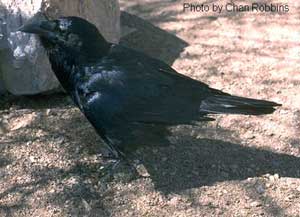
Corvus corax
(Common Raven)
Order: Passeriformes
Order Description: Passerines
Family: Corvidae
Family Description: Crows and Jays
Physical Description:
21 1/2-27" (55-69 cm). A large, all black bird with a large bill, long wings, and long, wedge-shaped tail.
Similar Species- Chihuahuan Raven, American Crow
Song:
A loud, low, croaking krock.
Distribution:
Resident from northernmost North America, south to southern Baja California, Nicaragua, and Texas. Also resident east of Rockies from southern Saskatchewan, northeastern Minnesota, northern Michigan, and northern New England, south to Appalachians and (locally) northern Georgia.
Habitat:
Found in various situations from lowlands to mountains, open country to forested regions, and humid regions to deserts, but found most frequently in hilly or mountainous areas, especially in vicinity of cliffs.
Diet:
Opportunistic; commonly eats birds' eggs and young rodents, some fruits, cereal grains, and insects. In some areas, species is largely a scavenger on various animals.
Ecology:
Builds cup-shaped nest in tree, on cliff, or on human-built structure. Forages on ground. Caches food. May hunt in groups. roosts communally in winter. Southwestern Idaho study found ravens spent 54% of day in agricultural land, 23% in shrub, 13% in grass, and 6% in riparian habitat.
Reproduction:
Female incubates 3-7 eggs (usually 3-6), for 18-21 days. Male feeds female during incubation. Young are tended by both parents, and leave nest in 5-6 wk.
Conservation:
| Element Code: | ABPAV10110 |
| Status: | Protected nongame species |
| Global Rank: | G5 |
| State Rank: | S5 |
| National Rank: | N5 |
Important State References:
Engel, K.A. and L.S. Young. 1992. Movements and habitat use by common ravens from roost sites in southwestern Idaho. J. Wildl. Manage. 56:596-602.
Photo by C. S. Robbins,© 2002
Design by Ean Harker 1999, 2000.
Written by Jason Karl, 2000.
Poecile atricapillus
(Black-capped Chickadee)
Link to photo provided by USGS - Patuxent Wildlife Research Center: http://www.mbr-pwrc.usgs.gov/Infocenter/infocenter.html
Order: Passeriformes
Order Description: Passerines
Family: Paridae
Family Description: Chickadees and Titmice
Physical Description:
4 3/4-5 3/4" (12-15 cm). Black head with white cheeks and sides of neck; gray above; white below with orange-washed flanks.
Similar Species- Mexican Chickadee, Mountain Chickadee.
Song:
A melancholy fee-bee.
Distribution:
Resident across portions of Alaska and Canada, south to northwestern California, southern Utah, central New Mexico, portions of Midwest, northern New Jersey, and (at higher elevations) southern Appalachians. Wanders irregularly south in winter.
Habitat:
Found in deciduous and mixed forests and woodlands, tall thickets, open woodlands, and parks.
Diet:
Eats mainly insects and other small invertebrates, their eggs and immature stages, and seeds and fruits.
Ecology:
Nests in cavity in tree or standing snag. Forages in foliage. Forms foraging and roosting flocks in winter. In Alberta study, winter survival rates were higher in food-supplemented area than in control area, but breeding densities in the 2 areas were similar. In southwestern Alberta, territory size averaged about 8-9 ha, and overlapped territories of Mountain Chickadee. An Idaho study conducted in cottonwood forests indicated these chickadees preferred agricultural landscapes over more natural landscapes.
Reproduction:
Both parents, or female only, incubate 5-10 eggs (usually 6-8), for 11-13 days. Young are tended by both parents, and leave nest at 14-18 days.
Conservation:
| Element Code: | ABPAW01010 |
| Status: | Protected nongame species |
| Global Rank: | G5 |
| State Rank: | S5 |
Important State References:
Saab, V.A. 1996. Influences of spatial scale and land-use practices on habitat relationships of breeding birds in cottonwood riparian forests. Ph.D. Dissertation, Univ. Colorado, Boulder. 140pp.
Design by Ean Harker©1999, 2000.
Written by Jason Karl, 2000.
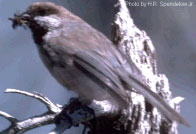
Poecile hudsonicus
(Boreal Chickadee)
Order: Passeriformes
Order Description: Passerines
Family: Paridae
Family Description: Chickadees and Titmice
Physical Description:
5-5 1/2" (13-14 cm). Brown crown, black eye-stripe, white cheeks, gray nape, black throat. Brown back; brownish-red flanks; gray wings and tail; white breast.
Similar Species- Chestnut-backed, Black- capped, and Mountain chickadees.
Song:
A lazy shick-a-day-day.
Distribution:
Resident from western and central Alaska, east to northern Saskatchewan and Labrador, and south to Washington, Montana, Minnesota, and northern New England. Wanders irregularly south after breeding season.
Habitat:
Found in boreal coniferous and mixed forests, in muskeg bogs, in vicinity of white cedar and hemlock swamps, and in birches and streamside willows. In Idaho, prefers open, subalpine forests in northern part of state, but is also found in low, dense montane forests.
Diet:
Eats conifer and birch seeds, and eggs, immature stages, and adults of insects.
Ecology:
Nests in natural or excavated cavity in tree or standing snag. Forages in foliage. Forms mixed-species flocks in winter.
Reproduction:
Female incubates 4-9 eggs (usually 6-7), for 11-16 days. Young are tended by both parents, and leave nest at 18 days.
Conservation:
| Element Code: | ABPAW01060 |
| Status: | Protected nongame species |
| Global Rank: | G5 |
| State Rank: | S1 |
Important State References:
Taylor, D.M. and C.H. Trost. 1987. The status of rare birds in Idaho. Murrelet 68:69-93.
Original images provided byH.R. Spendelow Jr.,© 2000
Design by Ean Harker©1999, 2000.
Written by Jason Karl, 2000.
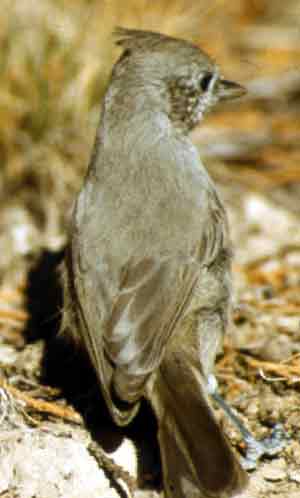
Baeolophus inornatus
(Juniper Titmouse)
Order: Passeriformes
Order Description: Passerines
Family: Paridae
Family Description: Chickadees and Titmice
Physical Description:
5-5 3/4" (13-15 cm). Entirely gray with a crested head.
Similar Species- Bridled Titmouse
Song:
Song is a quick, clear, three syllable whickity-whickity-whickity. Call is similar to the chickadee's.
Distribution:
Resident from southern Oregon, Nevada, southeastern Idaho, southwestern Wyoming, and south-central Colorado, south to Baja California, extreme northeastern Sonora, central and southeastern Arizona, central New Mexico, and western Texas.
Habitat:
Found in pinyon/juniper, and juniper and oak woodlands.
Diet:
Feeds on acorns, juniper seeds, pinyon nuts, fruits, leaf galls, and weed seeds. Will also eat invertebrates, including beetles, leafhoppers, caterpillars, flies, ants, and spiders.
Ecology:
Takes food from vegetation and from bark, usually low to moderately high in bushes and trees, but sometimes on ground. Often seen in mixed-species foraging flocks. Nests in natural or excavated cavity in tree or standing snag. During nesting, may defend territory of 1.2-4.9 ha. In Idaho, spends the winter on territory caching, then pecking open juniper seeds.
Reproduction:
Female incubates 6-8 eggs for 14-16 days. Young are tended by both parents, leave nest in about 3 wk, and remain with parents for 3-4 additional wk. Adult pair may remain together for 2 or more yr.
Conservation:
| Element Code: | ABPAW01100 |
| Status: | Protected nongame species |
| Global Rank: | G5 |
| State Rank: | S4 |
Important State References:
No references are available at this time.
Photo by C. Trost. ©1999.
Design by Ean Harker©1999, 2000.
Written by Jason Karl, 2000.
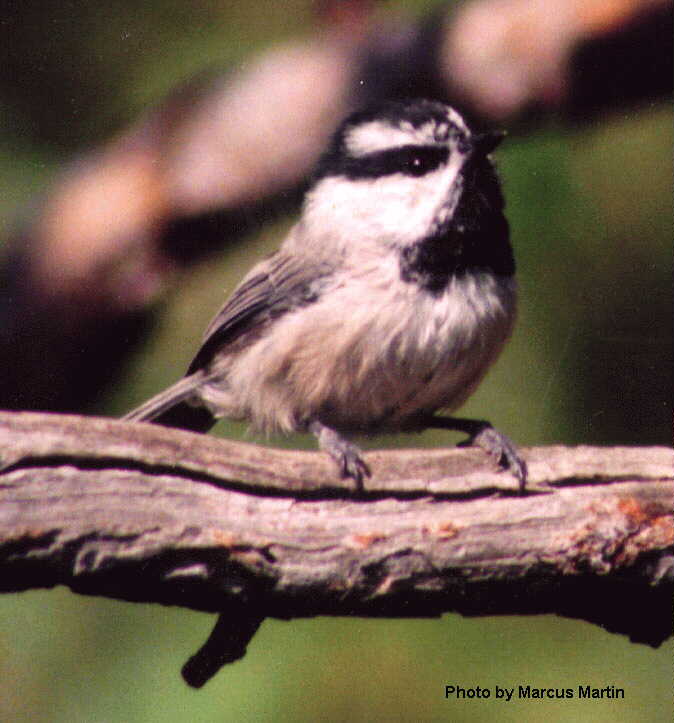
Poecile gambeli
(Mountain Chickadee)
Order: Passeriformes
Order Description: Passerines
Family: Paridae
Family Description: Chickadees and Titmice
Physical Description:
5-5 3/4" (13-15 cm). Black crown, white eyebrow, black eye- stripe, white cheeks and nape, and black throat. Gray above and whitish below.
Similar Species- Other chickadees, Bridled Titmouse
Song:
A clear, whistled fee-bee-bee; and a husky chick-a zhee-zhee.
Distribution:
Resident in mountains from southeastern Alaska, British Columbia, and southwestern Alberta, south to northern Baja California, central and southeastern Arizona, southeastern and central New Mexico, and southwestern Texas.
Habitat:
During breeding season, found in montane coniferous forests (especially pine, spruce/fir, and pinyon/juniper). During winter, found at lower elevations in mixed (pine/oak) and riparian woodlands. Pacific Northwest study indicated species is habitat generalist, found in structurally variable montane forests.
Diet:
Feeds on a variety of insect food.
Ecology:
Nests in natural or excavated cavity in standing snag or tree. Forages in foliage. Forms mixed-species flocks in winter. Mean territory size has been estimated at 1.5 ha. Breeding density has been reported as 71.5 breeding pairs/100 ha in White Mountains in Arizona, less than 10 breeding pairs/40 ha in northern Arizona, and up to 11 pairs/40 ha in thinned forest with added nest boxes. Territory size in southwestern Alberta averaged about 6-7 ha, and overlapped with territories of Black-capped Chickadee.
Reproduction:
clutch size is usually 6-12 eggs. Incubation lasts 14 days. Young are tended by both parents, and leave nest in about 20 days. Female possibly produces 2 broods annually.
Conservation:
| Element Code: | ABPAW01040 |
| Status: | Protected nongame species |
| Global Rank: | G5 |
| State Rank: | S5 |
Important State References:
Langelier, L. 1983. Habitat selection of common breeding bird species in western spruce budworm outbreaks. M.S. Thesis, Univ. Idaho, Moscow. 199pp.
Design by Ean Harker©1999, 2000.
Photo by Marcus Martin, ©1999.
Song recorded by C. S. Robbins. ©1999.
Written by Jason Karl, 2000.
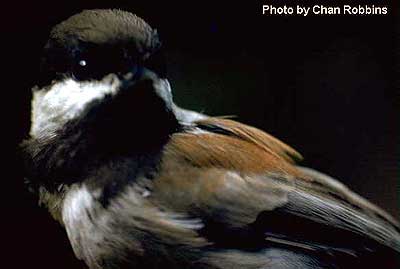
Poecile rufescens
(Chestnut-backed Chickadee)
Order: Passeriformes
Order Description: Passerines
Family: Paridae
Family Description: Chickadees and Titmice
Physical Description:
4 1/2-5" (11-13 cm). Brown crown, black eye-stripe, white below eye and on cheeks, black thin moustache, and brown chin. Chestnut back, shoulders, and flanks; black wings and tail.
Similar Species- Other chickadees
Song:
A faster, shriller chick-a-dee-dee; often just zhee-zhee.
Distribution:
Resident from portions of Alaska, east to western Alberta, and south to southern California and northwestern Montana. Wanders irregularly inland after breeding season.
Habitat:
Found in coniferous and mixed forests, primarily in humid regions, less frequently in pine forests, oak woodlands, pine-oak associations, and thickets. Strongly associated with Douglas-fir in most areas. Northern Idaho study conducted in hemlock-grand fir suggested these birds were associated with older forest stands.
Diet:
Eats mainly insects, but will also eat spiders, some fruits, and conifer seeds.
Ecology:
Nests in natural or excavated cavity in standing snag or live tree. May nest in loose colonies. Forages in foliage. Forms flocks of 4-20 individuals during nonbreeding season, often in loose association with other species (juncos, kinglets, nuthatches, etc.). Recent range expansion in Sierra Nevada was not accompanied by declines in Mountain Chickadee numbers.
Reproduction:
clutch size varies from 5-9 eggs, but is commonly 6-7. Young are tended by both parents.
Conservation:
| Element Code: | ABPAW01070 |
| Status: | Protected nongame species |
| Global Rank: | G5 |
| State Rank: | S4 |
Important State References:
Peterson, S.R. 1982. A preliminary survey of forest bird communities in northern Idaho. Northwest Sci. 56:287-298.
Photo by C. S. Robbins, ©2002.
Design by Ean Harker©1999, 2000.
Written by Jason Karl, 2000.
Psaltriparus minimus
(Bushtit)
Link to photo provided by USGS - Patuxent Wildlife Research Center: http://www.mbr-pwrc.usgs.gov/Infocenter/infocenter.html
Order: Passeriformes
Order Description: Passerines
Family: Paridae
Family Description: Chickadees and Titmice
Physical Description:
3 3/4-4 1/2" (10-12 cm). Chestnut brown head with gray eye- stripe; gray back and dark brown wings; White below with chestnut flanks; long, dark brown tail; black bill. Males have dark eyes, females have yellow eyes.
Similar Species- Verdin, Lucy's Warbler, Gnatcatchers
Song:
Whisper-like, excited squeaks and twitters.
Distribution:
Resident in coastal ranges from southwestern British Columbia, south to southern Baja California. Also resident in interior from southern and southeastern Oregon, southwestern Idaho, north-central Utah, western Colorado, western Oklahoma, and central Texas, south into Mexico and Guatemala.
Habitat:
Found in woodlands, in scrub habitat with scattered trees and shrubs, along brushy streamsides, in pinyon/juniper, in juniper, in chaparral and pine/oak associations, and in trees and shrubs in residential areas. In Rocky Mountains, may be found at elevations up to 1800-2500 m.
Diet:
Feeds primarily on spiders and insects (e.g., aphids, leafhoppers, scale insects, beetles, wasps, ants, and caterpillars). Will also eat some fruits.
Ecology:
Nests in hanging pocket in tree or shrub. Roosts in tightly huddled groups. Gleans prey from foliage while flitting about trees and shrubs. May forage in loose flocks. In winter, often found in mixed species flocks (kinglets, wrens, chickadees) that may number 20-50 birds.
Reproduction:
clutch size is usually 5-7 eggs, but may sometimes number 15. Incubation lasts 12-13 days. Nestlings are altricial, are tended by both parents, and leave nest in 14-15 days.
Conservation:
| Element Code: | ABPAY01010 |
| Status: | Protected nongame species |
| Global Rank: | G5 |
| State Rank: | S4 |
| National Rank: | N5 |
Important State References:
No references are available at this time.
Song recorded by C. S. Robbins. ©1999.
Design by Ean Harker©1999, 2000.
Written by Jason Karl, 2000.
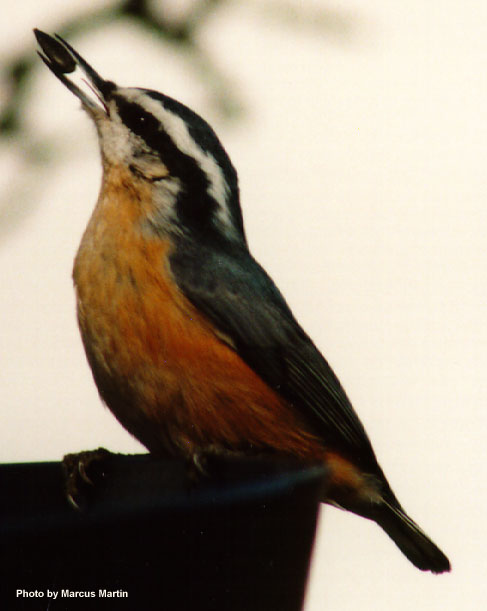
Sitta canadensis
(Red-breasted Nuthatch)
Order: Passeriformes
Order Description: Passerines
Family: Sittidae
Family Description: Nuthatches
Physical Description:
4 1/2-4 3/4" (11-12 cm). Slate- to blue-gray back, wings, and tail; black and white striped head; rusty below.
Similar Species- White-breasted and Pygmy nuthatches.
Song:
A high, nasal yaank yaank yaank; referred to as sounding like a tin horn.
Distribution:
Breeds from southern Alaska, east across portions of Canada, and south to southern California, southern New Mexico, western South Dakota, Minnesota, northern Ohio, southern Appalachians, and in isolated areas farther south. Winters throughout most of breeding range and irregularly in Gulf Coast.
Habitat:
Found in coniferous and mixed forests and aspen woodlands. During migration and in winter, also found in deciduous forests, open woodlands, parks, scrub, and riparian woodlands. Preliminary results of an Idaho-Montana study indicated these birds favored rotation-aged Douglas fir stands over old-growth stands.
Diet:
Eats mainly conifer seeds and insects.
Ecology:
Nests in excavated cavity in standing snag or hollow tree. Forages over trunks and branches.
Reproduction:
clutch size varies from 4-7 eggs, but is usually 5-6. Incubation lasts 12 days. Young are tended by both parents, and leave nest at 18-21 days.
Conservation:
| Element Code: | ABPAZ01010 |
| Status: | Protected nongame species |
| Global Rank: | G5 |
| State Rank: | S5 |
| National Rank: | N5 |
Important State References:
Hejl, S.J. and R.E. Woods. 1990. Bird assemblages in old-growth and rotation-aged Douglas-fir/Ponderosa pine stands in the northern Rocky Mountains: a preliminary assessment. Pp. 93-100 in D.M. Baumgartner and J.E. Lotan, eds., Proceedings of a Symposium on Interior Douglas-fir: the species and its management. Feb. 27, 1990, Spokane WA.
Photo by Marcus Martin, 1999.
Design by Ean Harker©1999, 2000.
Written by Jason Karl, 2000.
Sitta carolinensis
(White-breasted Nuthatch)
Order: Passeriformes
Order Description: Passerines
Family: Sittidae
Family Description: Nuthatches
Physical Description:
5-6" (13-15 cm). Blue-gray back and wings; black crown and shoulders; white below and on face; bill slim and pointed.
Similar Species- Red-breasted Nuthatch, Pygmy Nuthatch, Brown Creeper.
Song:
Calls a nasal waank waank waank. Song is a short rapid dwi-dwi-dwi-dwi-dwi- dwi-dow-dow.
Distribution:
Resident from Washington and southern British Columbia, east to southern Saskatchewan and New Brunswick, and south to Baja California, southeastern Arizona, southern Mexican highlands, and Gulf Coast. Absent from most of Great Plains.
Habitat:
Found primarily in deciduous and mixed forest, locally in coniferous forests, and more frequently in open woodlands, pinyon/juniper, clearings, forest edges, parks, and partly-open situations with scattered trees.
Diet:
Eats mainly nuts and seeds in fall and winter, and insects in spring and summer.
Ecology:
Nests in natural or excavated cavity, preferably in standing snag or hollow tree. Forages in mated pairs on trunks and main branches of trees. Hoards surplus food. Maintains year-round territory. In one study, resident pairs stayed together on feeding territory of 10-20 ha throughout year. Arizona study found 3-16 breeding pairs/40 ha.
Reproduction:
Female incubates 5-10 eggs (commonly 8), for about 12 days. Young are tended by both parents, leave nest at about 14 days, and are fed by parents for another 2 wk.
Conservation:
| Element Code: | ABPAZ01020 |
| Status: | Protected nongame species |
| Global Rank: | G5 |
| State Rank: | S4 |
| National Rank: | N5 |
Important State References:
No references are available at this time.
Design by Ean Harker©1999, 2000.
Written by Jason Karl, 2000.
Sitta pygmaea
(Pygmy Nuthatch)
Link to photo provided by USGS - Patuxent Wildlife Research Center: http://www.mbr-pwrc.usgs.gov/Infocenter/infocenter.html
Order: Passeriformes
Order Description: Passerines
Family: Sittidae
Family Description: Nuthatches
Physical Description:
3 3/4-4 1/2" (10-11 cm). Slate gray above with darker eye-line. Cream below with reddish-orange tinted breast and flanks.
Similar Species- Red-breasted Nuthatch
Song:
A monotonous peeping: pwee-di
Distribution:
Resident from southern interior British Columbia, northern Idaho, western Montana, central Wyoming, and southwestern South Dakota, south to northern Baja California, southern Nevada, central and southeastern Arizona, central New Mexico, extreme western Texas, extreme western Oklahoma, and south in mountains to central Mexico. An uncommon bird in Idaho.
Habitat:
Found at elevations up to 3000 m, in pine forests and woodlands (especially in ponderosa pine, less frequently in pinyon/juniper).
Diet:
Feeds on insects such as wasps, ants, beetles, moths, and grasshoppers, but may also eat spiders and pine seeds.
Ecology:
Nests in natural or excavated cavity in tree or standing snag; may nest in post. Social throughout year. Often found in association with Yellow-rumped Warbler, Plain Titmouse, or Mountain Chickadee. Travels in small family groups after nesting season. Family groups form larger, loose flocks in fall and winter. Winter groups average 5-15 individuals, forage as a flock, and roost communally within group territory. Individuals forage on outer branches and twigs as well as along tree trunks.
Reproduction:
Female incubates 4-9 eggs (usually 6-8), for 15.5-16 days. Nestlings are altricial. Young leave nest at 22 days. Cooperative breeding has been documented in California and Arizona; breeding units consisted of 2-5 birds. Helpers (mostly yearlings, and offspring or siblings of the birds they aided) were found at aoub 30% of all nests in northern Arizona; nests with helpers were sometimes more productive than those without helpers.
Conservation:
| Element Code: | ABPAZ01030 |
| Status: | Protected nongame species |
| Global Rank: | G5 |
| State Rank: | S2 |
| National Rank: | N5 |
Important State References:
No references are available at this time.
Design by Ean Harker©1999, 2000.
Written by Jason Karl, 2000.
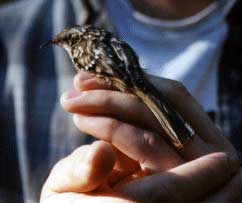
Certhia americana
(Brown Creeper)
Order: Passeriformes
Order Description: Passerines
Family: Certhiidae
Family Description: Creepers
Physical Description:
5 5-3/4" (13-15 cm). Brown camouflaged back that looks like the bark on the tree it is often climbing up with the use of its long, stiff tail. Whitish below; white eyebrow; long, downcurved bill.
Song:
Call is a single, very lispy tsee. Song is a high-pitched whistle: trees-trees-trees see the trees.
Distribution:
Breeds across portions of Alaska and Canada, south to southern California, mountains of middle America, western Texas, and portions of midwestern and eastern United States. Winters throughout breeding range (except for higher latitudes and elevations), south to Gulf Coast.
Habitat:
Found in forests, woodlands, and swamps. During winter and in migration, also found in scrub and parks. Preliminary results of northern Idaho study indicated species was more abundant in continuous old growth than in fragmented or selectively harvested stands.
Diet:
Eats mainly insects and other invertebrates (including immature stages). Also eats some nuts and seeds.
Ecology:
Usually nests under bark in tree; will sometimes nest in cavity. When pursued, spreads wings and remains motionless on tree trunk. Forages on bark of tree trunks and branches.
Reproduction:
clutch size varies from 4-8 eggs, but is commonly 5-6. Incubation lasts 14-15 days. Young are tended by both parents, and leave nest at 13-16 days.
Conservation:
| Element Code: | ABPBA01010 |
| Status: | Protected nongame species |
| Global Rank: | G5 |
| State Rank: | S5,NTMB |
| National Rank: | N5 |
Important State References:
Hejl, S.J. and L.C. Paige. 1993. Birds in continuous and fragmented forests of western red cedar/western hemlock in northern Idaho: a preliminary assessment. Draft manuscript, Inter. Res. Sta., USDA Forest Service, Missoula. 18pp.
Original images provided byJason Karl,© 2000
Design by Ean Harker©1999, 2000.
Written by Jason Karl, 2000.
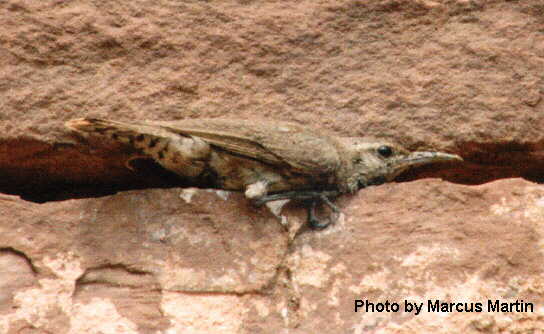
Salpinctes obsoletus
(Rock Wren)
Order: Passeriformes
Order Description: Passerines
Family: Troglodytidae
Family Description: Wrens
Physical Description:
5-6" (13-15 cm). Light brown above, white below. Speckled with black and white above, indistinctly with brown below. Rust-colored rump. Short, pale eyebrow.
Similar Species- Canyon Wren
Song:
Variety of repeated trills, double notes, and raspy single notes.
Distribution:
Breeds from south-central British Columbia, east to southern Saskatchewan, portions of Great Plains, western Oklahoma, and central Texas, and south to southern Baja California and Costa Rica. Winters from northern California, east to southern Utah, south to Arizona, New Mexico, and southern Texas, and further south through breeding range. Occasionally winters in northwestern and central United States.
Habitat:
Found in arid or semi-arid habitat, in shrubby areas in rocky canyons and cliffs, on rock slides and boulder-strewn slopes, and in arroyos with sparse vegetation. Sometimes seen around concrete and stone buildings. Similar to Canyon Wren in habitat, but in Idaho, Rock Wrens are more widely distributed.
Diet:
Probably feeds on insects and spiders, as well as earthworms and larval insects.
Ecology:
Nests in cavity or crevice, under or near rocks. Forages on ground, or takes food from foliage. Few studies have been conducted on this species.
Reproduction:
Female incubates 4-10 eggs (usually 5-6) in northern range, fewer in south. Young are tended by both parents.
Conservation:
| Element Code: | ABPBG03010 |
| Status: | Protected nongame species |
| Global Rank: | G5 |
| State Rank: | S5,NTMB |
| National Rank: | N5 |
Important State References:
No references are available at this time.
Photo by Marcus Martin and J. Spendelow,© 2000
Design by Ean Harker©1999, 2000.
Written by Jason Karl, 2000.
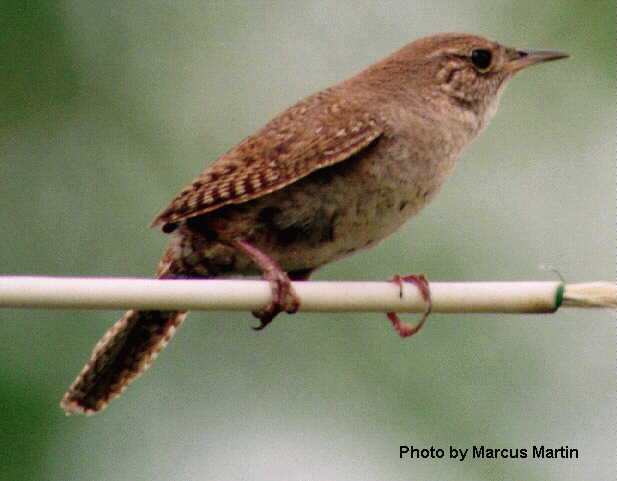
Troglodytes aedon
(House Wren)
Order: Passeriformes
Order Description: Passerines
Family: Troglodytidae
Family Description: Wrens
Physical Description:
4 1/2-5" (11-13 cm). Gray with browner tail, throat, and flanks. Finely barred with black on tail, wings, and belly. Indistinct, buff eyeline above dark eye. Long, slightly curved bill.
Similar Species- Winter Wren
Song:
A rapid, bubbling trill that rises and falls.
Distribution:
Breeds from southern British Columbia, east across southern Canada to New Brunswick, and south to northern Baja California, Texas, and northern Georgia. Also breeds in Mexico and Central and South America. Winters in southern U.S., south to southern Mexico.
Habitat:
Found in thickets, shrubbery, brushy areas, partly-open situations, open woodlands, deciduous forests, farmlands, chaparral, and around human habitation.
Diet:
Feeds almost entirely on insects, but may also eat other small invertebrates.
Ecology:
Nests in excavated cavity, preferably in standing snag or hollow tree. Will also use nest box. In Arizona study, breeding density was 10-18 pairs/40 ha in northern pine forest. Forages on ground, or takes food from vegetation. Sleeps in all seasons in crannies in buildings, holes in trees, niches in banks, or in similar sites. Sometimes destroys clutches of other birds, including conspecifics. Species is one of 7 neotropical migrants thought to be declining in Idaho.
Reproduction:
Female incubates 5-9 eggs (commonly 6-8), for 12-15 days, and may produce 2-3 broods/yr. Young are tended by both parents, and leave nest at 12-18 days; male may feed fledged young while female renests.
Conservation:
| Element Code: | ABPBG09010 |
| Status: | Protected nongame species |
| Global Rank: | G5 |
| State Rank: | S4,NTMB |
| National Rank: | N5B,N5N |
Important State References:
Saab, V. and C.R. Groves. 1992. Idaho's migratory landbirds: description, habitats, and conservation. Nongame Wildlife Leaflet #10, Idaho Dept. Fish & Game, Boise. 16pp.
Photo by Marcus Martin, ©1999.
Design by Ean Harker©1999, 2000.
Written by Jason Karl, 2000.
Cistothorus palustris
(Marsh Wren)
Link to photo provided by USGS - Patuxent Wildlife Research Center: http://www.mbr-pwrc.usgs.gov/Infocenter/infocenter.html
Order: Passeriformes
Order Description: Passerines
Family: Troglodytidae
Family Description: Wrens
Physical Description:
4-5 1/2" (10-14 cm). Brown above with some black and white flecking; white eyebrow; white breast with buff streaks that fades to a buff belly. Long, gray bill tipped with black; black eyes.
Similar Species- Bewick's Wren
Song:
Song is a bubbly, trill-like chattering.
Distribution:
Breeds from central British Columbia, east across southern Canada to New Brunswick, and south to southern California, northern Mexico, Texas, Gulf Coast, and Florida. Breeds locally in interior United States. Winters in coastal areas thorughout breeding range, and in interior from southern U.S. to southern Mexico. Regularly winters in southern Idaho.
Habitat:
Found in freshwater and brackish marshes in cattails, tule, bulrushes, and reeds.
Diet:
Eats mainly insects and other invertebrates.
Ecology:
Builds spherical nest in reeds. Adults may destroy eggs and young of conspecifics and of other marsh-nesting passerines. Species may be excluded form areas of marsh by Yellow-headed Blackbird. Territory size may reach several hundred square meters.
Reproduction:
Female incubates 3-10 eggs 9commonly 5-6), for 12-16 days. Young leave nest at 11-16 days, but are still fed by adult. Female produces 2-3 broods/yr. In most populations, males are polygynous.
Conservation:
| Element Code: | ABPBG10020 |
| Status: | Protected nongame species |
| Global Rank: | G5 |
| State Rank: | S5 |
| National Rank: | N5B,N5N |
Important State References:
No references are available at this time.
Design by Ean Harker©1999, 2000.
Written by Jason Karl, 2000.
Catherpes mexicanus
(Canyon Wren)
Link to photo provided by USGS - Patuxent Wildlife Research Center: http://www.mbr-pwrc.usgs.gov/Infocenter/infocenter.html
Order: Passeriformes
Order Description: Passerines
Family: Troglodytidae
Family Description: Wrens
Physical Description:
5 1/2-5 3/4" (14-15 cm). A small wren with a dark rufous-brown belly contrasting with a white throat and breast; fine black and white speckling above; very long, slightly downcurved bill.
Similar Species- Rock Wren
Song:
Song is distinct, downward spiraling notes, slowing at end.
Distribution:
South of Lewiston through the Snake River Plain. Resident from central coastal California and south-central British Columbia, east to southwestern South Dakota, and south to central Texas and southern Mexico.
Habitat:
Found (usually in arid regions) on cliffs, steep-sided canyons, rocky outcrops, and boulder piles. Also found in towns, around houses and barns, and on old stone buildings.
Diet:
Feeds on insects and spiders.
Ecology:
Nests in situations such as rocky outcrops, human-built structures, and caves. Forages on ground, frequently around rocks, or takes food from foliage. Little is known about ecology.
Reproduction:
Female incubates 5-6 eggs (sometimes 4-8). Male provides female's food during incubation. Young are altricial.
Conservation:
| Element Code: | ABPBG04010 |
| Status: | Protected nongame species |
| Global Rank: | G5 |
| State Rank: | S5,NTMB |
| National Rank: | N5 |
Important State References:
No references are available at this time.
Design by Ean Harker©1999, 2000.
Written by Jason Karl, 2000.
Troglodytes troglodytes
(Winter Wren)
Link to photo provided by USGS - Patuxent Wildlife Research Center: http://www.mbr-pwrc.usgs.gov/Infocenter/infocenter.html
Order: Passeriformes
Order Description: Passerines
Family: Troglodytidae
Family Description: Wrens
Physical Description:
4-4 1/2" (10-11 cm). Stubby, little brown wren with a short tail usually held erect. Darker brown baring and white specks both above and below.
Similar Species- House Wren
Song:
Rapid, high-pitched, incessant warbling.
Distribution:
Resident from southern Alaska, east across portions of Canada to Labrador, and south to central California, Idaho, Minnesota, southern Appalachians, and New Jersey. Winters from southern part of breeding range, south to southern California, Texas, Gulf Coast, and Florida.
Habitat:
Found in coniferous forests (primarily near water and with dense understory), and in open areas with low cover along rocky coasts, cliffs, islands, high mountain areas, or logged areas with large amounts of slash. During winter and in migration, also found in deciduous woods with understory, thickets, and brusy fields. Preliminary results of northern Idaho study found species was more abundant in continuous old growth than in fragmented or selectively harvested stands.
Diet:
Feeds almost entirely on insects (e.g., beetles, Diptera, caterpillars) and spiders.
Ecology:
Secretive. Nests in natural (sometimes excavated) cavity, preferably in standing snag or hollow tree. Male may construct dummy nest. Individuals obtain food from ground surface, or from substrates within 3 m of ground.
Reproduction:
Female incubates 4-7 eggs (commonly 5-6), for 14-17 days. Young are tended by both parents, and leave nest in 15-20 days.
Conservation:
| Element Code: | ABPBG09050 |
| Status: | Protected nongame species |
| Global Rank: | G5 |
| State Rank: | S5 |
| National Rank: | N5 |
Important State References:
Hejl, S.J. and L.C. Paige. 1993. Birds in continuous and fragmented forests of western red cedar/western hemlock in northern Idaho: a preliminary assessment. Draft manuscript, Inter. Res. Sta., USDA Forest Service, Missoula. 18pp.
Design by Ean Harker©1999, 2000.
Written by Jason Karl, 2000.
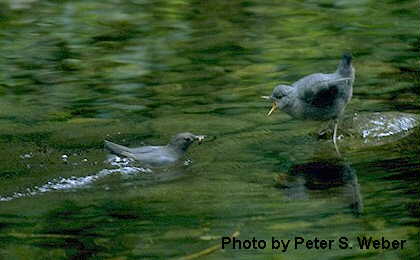
Cinclus mexicanus
(American Dipper)
Order: Passeriformes
Order Description: Passerines
Family: Cinclidae
Family Description: Dippers
Physical Description:
7-8 1/2" (18-22 cm). Slate gray with short tail and browner head. Juveniles have white edgings on underparts.
Song:
Repeated variety of phrases: high pitched whistes, trills, etc. Call is a loud dzheet.
Distribution:
Resident from portions of Alaska and western Canada, south in mountains to southwestern South Dakota, and further south to southern California, highlands of Mexico, and western Panama.
Habitat:
Found up to treeline along montane streams, especially along swift-flowing water. Found less frequently along mountain ponds and lakes. In winter, occasionally found along rocky seacoasts.
Diet:
Feeds on adult insects and their larvae (e.g., caddisflies, stoneflies, mayflies, mosquitos, and water beetles). Also eats clams, snails, and some trout fry.
Ecology:
Solitary except during nesting season. Nests on rock in stream, on cliff face, or behind waterfall. Adapted for semi-aquatic foraging. Walks, swims, or dives in or under water, and walks on stream bottoms while foraging. Characteristic dipping behavior upon alighting may signal mate.
Reproduction:
Female incubates 3-6 eggs (usualy 4-5), for 15-17 days. Young are altricial, are tended by both adults, and leave nest at 24-25 days.
Conservation:
| Element Code: | ABPBH01010 |
| Status: | Protected nongame species |
| Global Rank: | G5 |
| State Rank: | S5 |
| National Rank: | N5 |
Important State References:
No references are available at this time.
Photo by Peter S. Weber,© 2000
Design by Ean Harker©1999, 2000.
Written by Jason Karl, 2000.
Regulus satrapa
(Golden-crowned Kinglet)
Link to photo provided by USGS - Patuxent Wildlife Research Center: http://www.mbr-pwrc.usgs.gov/Infocenter/infocenter.html
Order: Passeriformes
Order Description: Passerines
Family: Regulidae
Family Description: Kinglets
Physical Description:
3 1/4-4 1/4" (8-11 cm). Olive-gray above, dirty white below. Yellow crown bordered with black; gray face with black eye-stripe. White wing bars and slightly notched tail.
Similar Species- Ruby-crowned Kinglet, Hutton's Vireo
Song:
Song begins with raspy, high notes that ascend slowly, faster ascending notes, and ends with an upward, whistled chatter.
Distribution:
Breeds from southern Alaska, east to Newfoundland, and south to central California, southern Arizona, U.S.-Canadian border, and western North Carolina. Winters from south-coastal Alaska and southern Canada, south to northern Baja California, southwestern U.S., Guatemala, Gulf Coast, and Florida.
Habitat:
Found in coniferous forests and woodlands (especially spruce). During migration and in winter, also found in deciduous woodlands, scrub, and brush. Pacific Northwest study found these kinglets associated with dense, shaded forests with some shrub interspersion. Preliminary results of northern Idaho study indicated species was more abundant in continuous old growth stands than in fragmented or selectively harvested stands.
Diet:
Feeds primarily on insects and their eggs (e.g., bark beetles, scale insects, and aphids). Drinks tree sap.
Ecology:
Builds hanging nest on branch near trunk. Forages among branches of trees. Often obtains prey while clinging to or hanging from foliage. In winter, seen in association with chickadees, Brown Creepers, and Downy Woodpeckers.
Reproduction:
clutch size varies from 5-11 eggs (usually 8-9). Incubation probably lasts about 14-15 days.
Conservation:
| Element Code: | ABPBJ05010 |
| Status: | Protected nongame species |
| Global Rank: | G5 |
| State Rank: | S5 |
| National Rank: | N5 |
Important State References:
Langelier, L. 1983. Habitat selection of common breeding bird species in western spruce budworm outbreaks. M.S. Thesis, Univ. Idaho, Moscow. 119pp.
Design by Ean Harker©1999, 2000.
Written by Jason Karl, 2000.
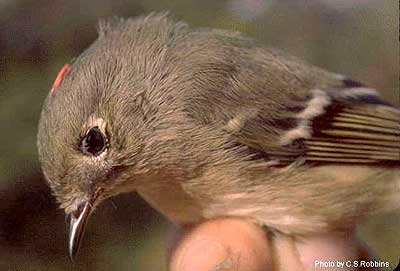
Regulus calendula
(Ruby-crowned Kinglet)
Order: Passeriformes
Order Description: Passerines
Family: Regulidae
Family Description: Kinglets
Physical Description:
3 3/4-4 1/2" (10-11 cm). Olive gray with black and white wing bars and on tail; more yellowish below and paler on throat; white eye-ring. Males have red crown patch.
Similar Species- Golden-crowned Kinglet, Hutton's Vireo
Song:
Song begins with several high, thin notes followed by a few lower notes and then a rising warble.
Distribution:
Breeds from northwestern Alaska, east across portions of Canada, and south to central New Mexico and southern California. Winters from southern British Columbia, Virginia, and Indiana, south to southern Florida, Gulf Coast, and through Mexico to Guatemala.
Habitat:
Found in coniferous forests and woodlands. During migration and in winter, found in deciduous woodlands, shrubs and thickets. May also be found in old fields, gardens, yards, and parks. Northern Idaho study conducted in hemlock-grand fir found this species associated with older conifer stands.
Diet:
Feeds primarily on insects and other small invertebrates (e.g., wasps, ants, beetles, moths, spiders, and pseudoscorpions). Will also eat some berries and seeds and drink sap.
Ecology:
Builds hanging nest on tree limb. Forages at branch tips in trees and often in shrubs. Captures aerial prey. May hover while foraging. Seen in scattered groups in association with other species (e.g., Golden- crowned Kinglets, nuthatches, and chickadees).
Reproduction:
Female incubates 5-11 eggs (usually 7-8), for about 12 days. Nestlings are downy and altricial, are tended by both parents, and fly at about 12 days.
Conservation:
| Element Code: | ABPBJ05020 |
| Status: | Protected nongame species |
| Global Rank: | G5 |
| State Rank: | S5,NTMB |
| National Rank: | N5B,N5N |
Important State References:
Peterson, S.R. 1982. A preliminary survey of forest bird communities in northern Idaho. Northwest Sci. 56:287-298.
Photo by C. S. Robbins. ©2002.
Design by Ean Harker©1999, 2000.
Written by Jason Karl, 2000.
Polioptila caerulea
(Blue-gray Gnatcatcher)
Link to photo provided by USGS - Patuxent Wildlife Research Center: http://www.mbr-pwrc.usgs.gov/Infocenter/infocenter.html
Order: Passeriformes
Order Description: Passerines
Family: Sylviidae
Family Description: Gnatcatchers, and Old World Warblers
Physical Description:
4-5" (10-13 cm). Bluish-gray above, white below; long black tail edged with white; narrow white eye-ring. Males have black on forehead.
Similar Species- Black-tailed Gnatcatcher
Song:
Call is repeated, raspy zhees. Song is a wheezy: keer-chit-chi-keer-keer.
Distribution:
Breeds from southern South Dakota, central Nevada, southern Utah, Oregon, portions of upper Midwest, southern Ontario, and portions of New England, south to southern Baja California, Guatemala, Gulf Coast, and Florida. Winters along coastal southeastern U.S., south to Central America.
Habitat:
Found in deciduous forests, open woodlands, second growth, scrub, brushy areas, and chaparral. In winter, found in wide range of brushy habitats. In Idaho, species is associated with juniper stands.
Diet:
Insects and other small invertebrates.
Ecology:
Takes food from foliage; may hover while foraging. Builds nest on limb, or in fork of tree. Breeding pairs establish territory which male defends, occasionally assisted by female. In California study, breeding territories averaged 4.6 ac, and ranged from 2.2-7.4 ac.
Reproduction:
Both sexes incubate 4- 5 eggs for 15 days. Nestlings are altricial and naked at hatching. Young are brooded and fed by both parents, and leave nest in 12-13 days.
Conservation:
| Element Code: | ABPBJ08010 |
| Status: | Protected nongame species |
| Global Rank: | G5 |
| State Rank: | S3,NTMB |
| National Rank: | N5B,N5N |
Important State References:
Taylor, D.M. and C.H. Trost. 1987. The status of rare birds in Idaho. Murrelet 68:69-93.
Design by Ean Harker©1999, 2000.
Written by Jason Karl, 2000.
Sialia mexicana
(Western Bluebird)
Link to photo provided by USGS - Patuxent Wildlife Research Center: http://www.mbr-pwrc.usgs.gov/Infocenter/infocenter.html
Order: Passeriformes
Order Description: Passerines
Family: Turdidae
Family Description: Thrushes, Solitaires and Bluebirds
Physical Description:
6-7" (15-18 cm). Male has blue hood, wings, tail, and rump with chestnut breast, flanks, and (usually) shoulders; varying amount of chestnut and blue on back. Female is sooty gray above with some light blue markings on shoulders and edges of tail; buff below with pale cinnamon flanks.
Similar Species- Male Eastern Bluebird, Mountain Bluebird
Song:
Song is an abrupt cher cherlee cherb.
Distribution:
Resident from southern British Columbia and central Montana, south in mountains to northern Baja California and central mainland of Mexico. May wander to other areas during winter.
Habitat:
Found in open or riparian woodlands, farmlands, orchards, and savannas. Also inhabits desert areas during winter.
Diet:
Mainly insectivorous. Eats grasshoppers, caterpillars, beetles, other insects, and other invertebrates (spiders, earthworms, sow bugs, etc.). Feeds seasonally on berries and other fruits.
Ecology:
Nests in excavated cavity, preferably in standing snag or hollow tree. Forages by flycatching, and by dropping from perch to ground. Colorado study found average of 0.6 breeding birds/ha in montane forests. In Idhao, species has probably benefited from extensive placement of nestboxes.
Reproduction:
clutch size varies from 3-8 eggs (usually 4-6). Incubation lasts 13-14 days. altricial nestlings are tended by both parents. Fledged young are tended by male while female renests (female usually produces 2 broods/yr).
Conservation:
| Element Code: | ABPBJ15020 |
| Status: | Protected nongame species |
| Global Rank: | G5 |
| State Rank: | S4,NTMB |
| National Rank: | N5 |
Important State References:
Saab, V.A. and J. Dudley. 1995. Nest usurpation and cavity use by Lewis' Woodpecker. USDA Forest Service Inter. Res. Sta. Rep., Boise. 13pp.
Design by Ean Harker©1999, 2000.
Written by Jason Karl, 2000.
Sialia currucoides
(Mountain Bluebird)
Link to photo provided by USGS - Patuxent Wildlife Research Center: http://www.mbr-pwrc.usgs.gov/Infocenter/infocenter.html
Order: Passeriformes
Order Description: Passerines
Family: Turdidae
Family Description: Thrushes, Solitaires & Bluebirds
Idaho's State Bird:
The Mountain Bluebird (Sialia currucoides) was adopted as the state bird for Idaho by the state legislature in 1931.
Physical Description:
6 1/2-8" (17-20 cm). Male is bright blue, slightly paler below; dark bill, eyes, and legs. Female is dull blue above, has a reddish-brown throat, and buff below.
Similar Species- Other female bluebirds
Song:
Song is a soft, coarse, two-noted slur.
Distribution:
Breeds from central Alaska, east through portions of western Canada, and south in mountains to California, Nevada, northern Arizona, southern New Mexico, western Oklahoma, Colorado, and portions of Great Plains. Winters from southern British Columbia and western Montana, south to central Mexico and southern Texas, and east, at least casually, to eastern Kansas, western Oklahoma and central Texas.
Habitat:
Found in subalpine meadows, rangelands, open coniferous forests, and pinyon/juniper woodlands, usually at elevations above 1500 m. During winter and in migration, also found in grasslands, deserts, brushy areas, and agricultural lands. Idaho study found Mountain Bluebirds were more abundant on prescribed burn juniper stands than on old-growth or clearcut areas.
Diet:
Primarily insectivorous. Feeds on beetles, ants, bees, wasps, caterpillars, grasshoppers, and other insects. Will also consume some berries and grapes.
Ecology:
Nests in previously used excavated cavities, preferably in standing snag or hollow tree. Hovers and drops to ground while foraging, or darts out from low perch to catch prey. Wyoming study recorded 6-7 bluebirds/16.2 ha. In Idaho, species has probably benefited from extensive nestbox placement.
Reproduction:
Both sexes, but primarily female, incubate about 4-8 eggs (usually 5-6) for 13-14 days. Female sometimes produces 2 broods/yr. altricial young are tended by both parents, sometimes with assistance of young of first brood.
Conservation:
| Element Code: | ABPBJ15030 |
| Status: | Protected nongame species |
| Global Rank: | G5 |
| State Rank: | S4,NTMB |
| National Rank: | N5 |
Important State References:
McCoy, M. 1993. Breeding bird survey of clearcut, prescribed burn, and seral/old growth stands of western juniper. USDI Bur. Land Manage., Boise District, Challenge Cost Share Project Report, Boise. 19pp.
Design by Ean Harker©1999, 2000.
Written by Jason Karl, 2000.
Myadestes townsendi
(Townsend's Solitaire)
Link to photo provided by USGS - Patuxent Wildlife Research Center: http://www.mbr-pwrc.usgs.gov/Infocenter/infocenter.html
Order: Passeriformes
Order Description: Passerines
Family: Turdidae
Family Description: Thrushes, Solitaires and Bluebirds
Physical Description:
8-9 1/2" (20-24 cm). A slender gray bird with a long, darker tail with thin, white edges. Dark edging on wings, dark eye encircled by white, and dark bill. Juveniles have dark scalloping below and pale spots above.
Similar Species- Northern Mockingbird, female bluebirds
Song:
Call is a short, high-pitched pwip. Song is a loud, melodious rising and falling of phrases with some trills.
Distribution:
Breeds from portions of Alaska and western Canada, south in mountains in western U.S. to southern California, Arizona, New Mexico, and central Mexico, and east to Montana, norhteastern Wyoming, and portions of Great Plains. Winters from southwestern Canada, Montana, and South Dakota, east to central Texas, and south to northern Baja California and central Mexico.
Habitat:
Breeds in open montane coniferous forests. Idaho study found species responded positively in number to diameter- cut logging. When not breeding, found in open or riparian woodlands, pinyon/juniper associations, chaparral, and deserts.
Diet:
Feeds on insects (e.g., caterpillars, beetles, wasps, ants, and bugs). Also eats pine seeds and fruits (e.g., juniper berries, and berries of rose, cedar, mistletoe, and madrona).
Ecology:
Nests in sheltered area on ground. Flies out from perch and catches insects in air. Usually seen singly, in pairs, or in small family groups.
Reproduction:
clutch size varies from 3-5 eggs, but is usually 4. Nestlings are altricial. Breeding biology is poorly known.
Conservation:
| Element Code: | ABPBJ16010 |
| Status: | Protected nongame species |
| Global Rank: | G5 |
| State Rank: | S5 |
| National Rank: | N5 |
Important State References:
Medin, D.E. 1985. Breeding bird responses to diameter-cut logging in west-central Idaho. USDA Forest Service Inter. Res. Sta. Res. Paper INT-355, Boise. 12pp.
Photo by Jim Stasz
Design by Ean Harker©1999, 2000.
Written by Jason Karl, 2000.
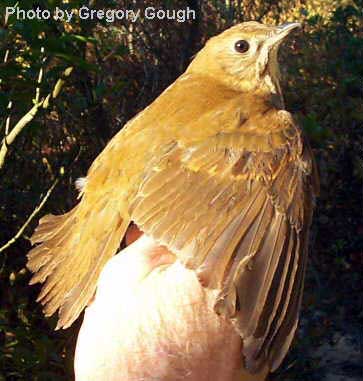
Catharus fuscescens
(Veery)
Order: Passeriformes
Order Description: Passerines
Family: Turdidae
Family Description: Thrushes, Solitaires and Bluebirds
Physical Description:
6 1/2-7 3/4" (17-20 cm). Brown above and buff below with brown spotting on breast. Barely noticeable buff eye-ring. Immatures have spots on head and back.
Similar Species- Swainson's Thrush
Song:
Downward spiraling, coarse whistles: vee-ur vee-ur vee-ur veer.
Distribution:
Breeds from southern British Columbia, east across southern Canada to Newfoundland, and south to Oregon, Colorado, portions of Midwest, and southern Appalachians. Winters in northern South America. This species is rare south of the Snake River, except in the Henry's Lake and Driggs areas.
Habitat:
Found in cottonwood, alder, and other swampy forests, as well as aspen communities, especially in more open areas with shrubby understory. Also found in second growth, or willow or alder shrubbery near water. Results of an Idaho study indicated probability of finding Veeries present in cottonwood forest increased with patch size; and speices showed a preference for dogwood subcanopies. Numbers were significantly reduced in grazed areas and campgrounds compared to relatively undisturbed sites.
Diet:
Eats insects, other invertebrates, and (especially during migration) small fruits.
Ecology:
Forages on forest floor and trees, often near water. Builds cup-shaped nest (preferably on moist substrate) on ground or in shrub.
Reproduction:
Lays eggs in May or June. Female incubates 3-5 eggs (usually 4), for 11-12 days. Young are tended by both parents, and leave nest at 10-12 days.
Conservation:
| Element Code: | ABPBJ18080 |
| Status: | Protected nongame species |
| Global Rank: | G5 |
| State Rank: | S5,NTMB |
| National Rank: | N5B |
Important State References:
Saab, V.A. 1996. Influence of spatial scale and land management on habitat use by breeding birds in cottonwood forests of southeastern Idaho. Ph.D. Dissertation, Univ. Colorado, Boulder. 140pp.
Photo by Gregory Gough, ©2002
Written by Jason Karl, 2000.
Design by Ean Harker©1999, 2000.
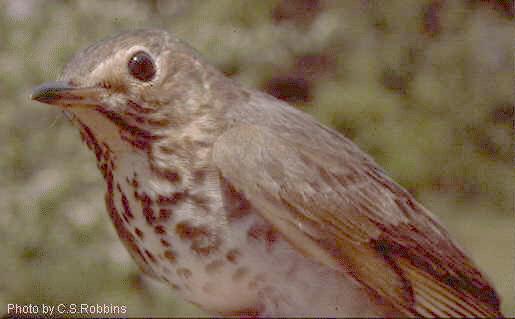
Catharus ustulatus
(Swainson's Thrush)
Order: Passeriformes
Order Description: Passerines
Family: Turdidae
Family Description: Thrushes, Solitaires and Bluebirds
Physical Description:
6 1/2-7 3/4" (17-20 cm). Olive-brown above; buff eye-ring. buff below with olive-brown spotting on breast; flanks darker.
Similar Species- Hermit Thrush and Veery
Song:
Upward spiraling, flute-like song.
Distribution:
Breeds from portions of Alaska and Canada, south to southern California, northern New Mexico, northern Nebraska, eastern Montana, northern Minnesota, northern New Engand, and Virginia. Winters in portions of South America, and in small numbers to northern Mexico.
Habitat:
Found in dense, tall shrubbery, coniferous woodlands (especailly spruce), aspen/poplar forests, second growth, and willow and alder thickets. During migration and in winter, also found in deciduous forests, open woodlands, humid lowland forests, scrub and brush (mostly mid-story or lower, but well above ground). Most common in mountains. Preliminary results of northern Idaho study indicated species was more abundant in continuous stands of old- growth cedar/hemlock than in fragmented or selectively harvested stands. In southeastern Idaho, species was strongly associated with cottonwood patches adjacent to natural upland vegetation as opposed to agriculture, and preferred cottonwood forests with willow subcanopies.
Diet:
Eats insects and other invertebrates, small fruits, and seeds. frugivorous in migration and during winter.
Ecology:
Builds cup-shaped nest low in coniferous tree or shrub. Solitary when not breeding, but found in loose flocks in migration (sometimes concentrated in large numbers near fruiting trees and shrubs). Takes food from foliage. May hover and drop to ground while foraging. Preliminary results of Idaho study conducted in cottonwood forests found species was negatively associated with grazed areas.
Reproduction:
Female incubates 3-4 eggs (usually), for 10-14 days. Young are tended by both parents, and leave nest at 10-14 days.
Conservation:
| Element Code: | ABPBJ18100 |
| Status: | Protected nongame species |
| Global Rank: | G5 |
| State Rank: | S5,NTMB |
| National Rank: | N5B |
Important State References:
Saab, V.A. 1996. Influence of spatial scale and land management on habitat use by breeding birds in cottonwood forests of southeastern Idaho. Ph.D. Dissertation, Univ. Colorado, Boulder. 140pp.
Photos by Jason Karl,© 2000 and C. S. Robbins, ©2002.
Design by Ean Harker©1999, 2000.
Written by Jason Karl, 2000.
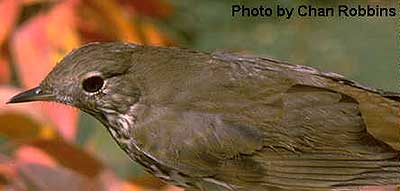
Catharus guttatus
(Hermit Thrush)
Order: Passeriformes
Order Description: Passerines
Family: Turdidae
Family Description: Thrushes, Solitaires and Bluebirds
Physical Description:
6 1/2-8" (17-20 cm). Brownish-olive above with tail more rusty; eye-ring whitish. Whitish below with brownish spotting. Often flicks tail.
Similar Species- Swainson's Thrush and Veery
Song:
Eerie song begins with a long, clear whistle followed by flute-like warbles. Often changes pitch from one rendition to the next.
Distribution:
Breeds from portions of Alaska and Canada, south to southern California, western Texas, northern Minnesota, northeastern Ohio, and Virginia. Winters from southern British Columbia, southern Ontario, and northern U.S., south to southern Baja California, Central America, Texas, and Gulf Coast.
Habitat:
Found in open, humid, coniferous and mixed forests and forest edges; in dry, sandy, sparse jackpine; and, less frequently, in deciduous forests and thickets. During migration and in winter, also found in chaparral, riparian woodlands, arid pine/oak, and desert scrub. Preliminary results of northern Idaho study found abundance was higher in selectively harvested stands than in continuous old-growth stands.
Diet:
Eats insects, other invertebrates, and some small fruits.
Ecology:
Builds cup-shaped nest, frequently in moist situations, on ground or low in tree or shrub. Forages on ground. May also take food from foliage, or hover while foraging.
Reproduction:
Female incubates 3-4 eggs (usually) for 12-13 days. Young are tended by both parents, and leave nest at 10-12 days.
Conservation:
| Element Code: | ABPBJ18110 |
| Status: | Protected nongame species |
| Global Rank: | G5 |
| State Rank: | S4,NTMB |
| National Rank: | N5 |
Important State References:
Hejl, S.J. and L.C. Paige. 1993. Birds in continuous and fragmented forests of western red cedar/western hemlock in northern Idaho: a preliminary assessment. Draft manuscript, Inter. Res. Sta., USDA Forest Service, Missoula. 18pp.
Photo by C. S. Robbins. ©2002.
Design by Ean Harker©1999, 2000.
Written by Jason Karl, 2000.
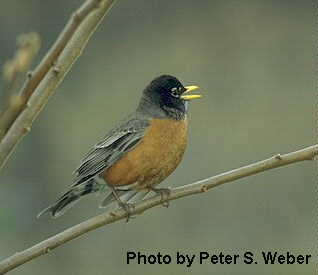
Turdus migratorius
(American Robin)
Order: Passeriformes
Order Description: Passerines
Family: Turdidae
Family Description: Thrushes, Solitaires and Bluebirds
Physical Description:
9-11" (23-28 cm). Dark gray to black above; white, broken eyering. Red-orange breast and belly; white undertail coverts. Yellow bill; white streaking on throat.
Similar Species- Varied Thrush
Song:
Rising and falling phrases: cheer-up cheerily.
Distribution:
Breeds from portions of Alaska and Canada, south to southern California, southern Mexico, Gulf Coast, and central Florida. Resident in mountains of southern Baja California. Winters from British Columbia and northern U.S. (irregularly), south to Baja California, Guatemala, and Gulf Coast.
Habitat:
Found in forests, woodlands, scrub, parks, thickets, gardens, cultivated lands, savannas, swamps, and suburbs.
Diet:
Worms, insects, and other invertebrates dominate spring diet. Fruits dominate fall and winter diet.
Ecology:
Builds nest in shrub or human-built structure. Will occasionally nest on ground. Forages on ground. May take food from vegetation. Frequently roosts communally after young fledge.
Reproduction:
Female incubates 3-6 eggs (usually 4), for 11-14 days. Young are tended by both parents, and leave nest at 14- 16 days. Female usually produces 2 broods/yr.
Conservation:
| Element Code: | ABPBJ20170 |
| Status: | Protected nongame species |
| Global Rank: | G5 |
| State Rank: | S5,NTMB |
| National Rank: | N5 |
Important State References:
Medin, D.E. 1985. Densities and nesting heights of breeding birds in a Idaho Douglas-fir forest. Northwest Sci. 59:45-52.
Photo by Peter S. Weber,© 2000
Design by Ean Harker©1999, 2000.
Written by Jason Karl, 2000.
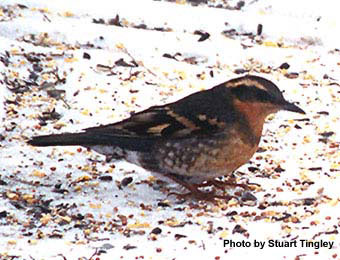
Ixoreus naevius
(Varied Thrush)
Order: Passeriformes
Order Description: Passerines
Family: Turdidae
Family Description: Thrushes, Solitaires and Bluebirds
Physical Description:
9-10" (23-25 cm). Gray-black above with orange eyebrow and wing bars. Orange below with gray-black necklace and scaling on flanks. Female paler; immature has incomplete necklace.
Similar Species- American Robin
Song:
Two long eerie, quavering notes, second one higher than first after a long pause.
Distribution:
Breeds from portions of Alaska and western Canada, south to northwestern Montana, northern Idaho, Washington, most of Oregon, and extreme northwestern California. Winters from southern Alaska, southern British Columbia, and northern Idaho, south through Washington, Oregon and California to northern Baja California. Wanders widely in central and northeastern North America.
Habitat:
Found in humid, coastal and interior montane coniferous forests, deciduous forests with dense understory, and tall shrubs (especially alder). During migration and in winter, also found in open woodlands and chaparral. Northern Idaho study conducted in hemlock/grand fir forests found this species associated with older conifer stands.
Diet:
Eats insects, earthworms, seeds, and berries.
Ecology:
Builds nest in small conifer, usually against trunk. Feeds in trees or forages on ground.
Reproduction:
clutch size varies from 2-5 eggs, but is usually 3-4. Incubation lasts about 14 days. Nestlings are altricial.
Conservation:
| Element Code: | ABPBJ22010 |
| Status: | Protected nongame species |
| Global Rank: | G5 |
| State Rank: | S5 |
| National Rank: | N5 |
Important State References:
Peterson, S.R. 1982. A preliminary survey of forest bird communities in northern Idaho. Northwest Sci. 56:287-298.
Photo by Stuart Tingley
Design by Ean Harker©1999, 2000.
Written by Jason Karl, 2000.
Dumetella carolinensis
(Gray Catbird)
Link to photo provided by USGS - Patuxent Wildlife Research Center: http://www.mbr-pwrc.usgs.gov/Infocenter/infocenter.html
Order: Passeriformes
Order Description: Passerines
Family: Mimidae
Family Description: Mockingbirds and Thrashers
Physical Description:
8-9 1/4" (20-24 cm). Slate gray except for a red undertail covert. crown and tail darker.
Similar Species- Northern Mockingbird
Song:
Call is a catlike scolding. Song is a variety of chattery whistles.
Distribution:
Breeds from southern British Columbia, east across southern Canada to Nova Scotia, and south to central New Mexico, Texas, central portions of Gulf states, and northern Florida. Winters from Atlantic coastal lowlands, north to Long Island, and from Gulf states to Panama.
Habitat:
Found in thickets, dense brushy and shrubby areas, undergrowth of forest edges, hedgerows, gardens, and dense second growth. An Idaho study in cottonwood forests reported that the probability of detecting catbirds increased with patch size; the species avoided grazed areas.
Diet:
Eats insects, other invertebrates, small fruits, and arillate seeds.
Ecology:
Builds cup-shaped nest, frequently in thickets. Forages on ground or in vegetation. Sometimes forms loose flocks during migration.
Reproduction:
Female incubates 2-6 eggs (usually 4), for 12-15 days. Young are tended by both parents, and leave nest at 10- 15 days. Female often produces 2 broods/yr.
Conservation:
| Element Code: | ABPBK01010 |
| Status: | Protected nongame species |
| Global Rank: | G5 |
| State Rank: | S5,NTMB |
| National Rank: | N5B,N5N |
Important State References:
Saab, V.A. 1996. Influence of spatial scale and land management on habitat use by breeding birds in cottonwood forests of southeastern Idaho. Ph.D. Dissertation, Univ. Colorado, Boulder. 140pp.
Design by Ean Harker©1999, 2000.
Written by Jason Karl, 2000.
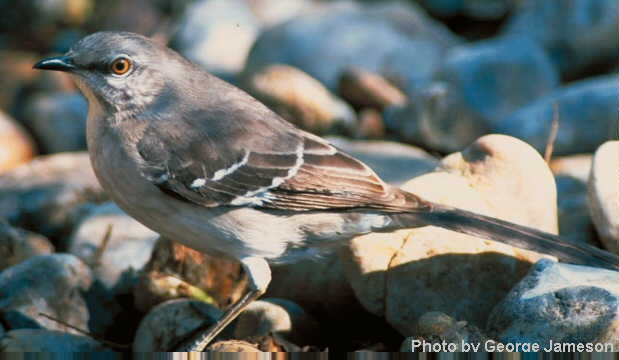
Mimus polyglottos
(Northern Mockingbird)
Order: Passeriformes
Order Description: Passerines
Family: Mimidae
Family Description: Mockingbirds and Thrashers
Physical Description:
Length 10", with long tail. Gray on back and lighter below. White outer tail feathers and wing patches which are flashed repeatedly in a nervous manner.
Similar species- Loggerhead Shrike and Northern Shrike, which have a thicker bill and a dark face mask.
Song:
Original and mimicked phrases in clear whistles, often repeated in sets of three.
Distribution:
Resident populations in southern United States from California, Arizona, Texas, Oklahoma, Tennessee, and North Carolina, with summer movements to southern Oregon, Idaho, and across to the Great Lakes and New England.
Habitat:
A variety of open to partly open situations from areas of scattered brush to forest edges and even desert conditions. In many areasvirtually restricted to areas of human habitiation.
Diet:
Insects and other invertebrates, fruits and berries.
Ecology:
Uses songs and calls of other birds, as well as rusty gates, with unmated males singing more vigorously, and often at night. Feeds by gleaning branches and on the ground, where frequent wing flashes are thought to scare up insect prey, but also to distract snakes and other potential predators. Nests in an open cup of twigs, places in a coniferous or deciduous shrub.
Reproduction:
monogamous, lays 3-5 eggs, incubated for 12-13 days by the female only. She broods the young for 4 days after hatching and the male gathers most of the food for his mate and the family. Fairly rare nesting species in southern Idaho, and occasionally further north.
Conservation:
| Element Code: | ABPBK03010 |
| Status: | Protected nongame species |
| Global Rank: | G5 |
| State Rank: | S1 |
| National Rank: | N5 |
Important State References:
No references are available at this time.
Photo by George Jameson, ©2002.
Design by Ean Harker©1999, 2000.
Written by Jason Karl, 2000.
Oreoscoptes montanus
(Sage Thrasher)
Link to photo provided by USGS - Patuxent Wildlife Research Center: http://www.mbr-pwrc.usgs.gov/Infocenter/infocenter.html
Order: Passeriformes
Order Description: Passerines
Family: Mimidae
Family Description: Mockingbirds and Thrashers
Physical Description:
8-9" (20-23 cm). Drab gray above, white below with dark spotting on breast. Yellow eyes. Immatures darker with less well defined spotting bellow.
Similar Species- Curve-billed Thrasher, Bendire's Thrasher
Song:
Song consists of cackles, whistles, and harsh warbles.
Distribution:
Breeds from southern British Columbia southeast to Wyoming, south to southern California (east of Coast Ranges), west to Utah, and south from there to northern New Mexico, northwestern Texas, and western Oklahoma. Winters south to Baja California and northern mainland of Mexico.
Habitat:
Found in sagebrush steppe. During migration and in winter, also found in scrub, brush, and thickets, primarily in arid or semi-arid situations (rarely around towns). In many areas, confined to regions where Artemisia tridentata grows. Idaho study found big sagebrush used for nesting were taller than average, had greater foliage density, and most often faced easterly. A recent study in southwestern Idaho concluded that distribution of sage thrashers was influenced by both local vegetation cover and landscape features such as patch size.
Diet:
Feeds on variety of insects, including grasshoppers, beetles, weevils, ants, and bees. Will also eat fruits and berries.
Ecology:
Forages on ground. Builds nest in, or under, sagebrush. Density rarely exceeds 30/km2. Idaho study found average territory size was 1.14 ha.
Reproduction:
Idaho study found both sexes incubated average of 3.5 eggs for 15 days; nestling period averaged 12.3 days and fledglings averaged 2.2/nest. Nestlings are altricial and downy.
Conservation:
| Element Code: | ABPBK04010 |
| Status: | Protected nongame species |
| Global Rank: | G5 |
| State Rank: | S5,NTMB |
| National Rank: | N5B,N5N |
Important State References:
Peterson, K.L. and L.B. Best. 1991. Nest-site selection by Sage Thrashers in southeastern Idaho. Great Basin Nat. 51:261-266.
Design by Ean Harker©1999, 2000.
Written by Jason Karl, 2000.
Anthus rubescens
(American Pipit)
Link to photo provided by USGS - Patuxent Wildlife Research Center: http://www.mbr-pwrc.usgs.gov/Infocenter/infocenter.html
Order: Passeriformes
Order Description: Passerines
Family: Motacillidae
Family Description: Pipits
Physical Description:
Length 6.5". Brownish-gray above with a rich buffy breast and belly, and faint streaks on chest. White outer tail feathers. Walks in open ground, rather than hopping. Rear toenail elongated.
Similar species- Horned Lark, Sprague's Pipit.
Song:
Flight call is a sharp "pip-pipit", the song is a series of rapid "cheedle" notes.
Distribution:
Breeds in arctic tundra and mountains of North America. Winters (primarily coastally) from British Columbia, east to New York, and south through southern U.S. to Guatemala. Nests in alpine conditions on Sawtell Peak and the mountains to the east of Henry's Lake in eastern Idaho.
Habitat:
When not breeding, found along seacoasts, beaches, mudflats, wet meadows, sandy areas and cultivated fields. Rosy Finches and pipits are only birds in Idaho which nest exclusively in alpine habitat.
Diet:
Species feeds on insects, spiders, mites, mollusks, crustaceans, and aquatic worms.
Ecology:
Builds cup-shaped nest on ground under rock or vegetation. Forms large flocks in winter. Forages while walking along open ground, or on mud flats and marshes. Also wades through shallow pools in tidal flats.
Reproduction:
Breeding begins early to mid-June. Female incubates 4-5 eggs (sometimes 3-7), for about 14 days. Nestlings are altricial, are tended by both adults, and leave nest 14-15 days after hatching. In central Idaho mountains, nests with eggs can be consistently located around July 4.
Conservation:
| Element Code: | ABPBM02050 |
| Status: | Protected nongame species |
| Global Rank: | G5 |
| State Rank: | S4,NTMB |
| National Rank: | N5B,N5N |
Important State References:
No references are available at this time.
Design by Ean Harker©1999, 2000.
Written by Jason Karl, 2000.

Lanius ludovicianus
(Loggerhead Shrike)
Order: Passeriformes
Order Description: Passerines
Family: Laniidae
Family Description: Shrikes
Physical Description:
8-10" (20-25 cm). Gray crown extends down back of neck and shoulders. Black mask; white cheeks and throat. Black wings and tail edged with white. Light gray below. Juvenile barred on underparts.
Similar Species- Northern Shrike, Northern Mockingbird
Song:
Song is a series of coupled phrases: chereep-chereep. Calls include a creaky zeeet.
Distribution:
Breeds across portions of Canada, south through Great Basin to Baja California, Mexico, Gulf Coast, and southern Florida. Winters in southern half of breeding range, south to Gulf Coast, southern Florida, and Mexico.
Habitat:
Found in open country with scattered trees and shrubs, in savannas, desert scrub and, occasionally, in open juniper woodlands. Often found on poles, wires or fenceposts.
Diet:
Feeds primarily on insects, small birds, lizards, and rodents. Diet varies with season and location; in parts of range, 76% of food eaten in winter may be meat.
Ecology:
Constructs bulky, cup- shaped nest in shrub. A study in southeastern Idaho located nests in sagebrush, bitterbrush, and greasewood. Most nests were in sagebrush, and a lower than expected nest height was observed in all shrub species. Species hunts from perch, or catches prey in mid-air. Territorial throughout year. Size of territory may be about 6 ha in grassy hills; 10-16 ha in semi-desert. May maintain separate breeding and winter territories. Idaho study indicated that shrikes directly lowered nesting success of Sage and Brewer's Sparrows and Sage Thrashers. Loggerheads are one of 3 shrub-steppe neotropical migrants declining in Idaho. Shrike species throughout world are thought to be declining.
Reproduction:
Female incubates 4-5 eggs (sometimes 6-7), for 14-16 days. Incubation by both sexes (for 10-12 days) has also been reported. Young are tended by both adults, fledge in about 3 wk, and become independent in 36 days. Females produce 2 broods/season.
Conservation:
| Element Code: | ABPBR01030 |
| Status: | Protected nongame species |
| Global Rank: | G? |
| State Rank: | S3,NTMB |
| National Rank: | N5 |
Important State References:
Woods, C.P. and T.J. Cade. 1996. Nesting habits of the loggerhead shrike in sagebrush. Condor 98:75-81.
Photo by C. S. Robbins. ©2002.
Design by Ean Harker©1999, 2000.
Written by Jason Karl, 2000.
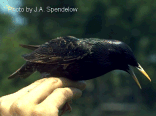
Sturnus vulgaris
(European starling)
Order: Passeriformes
Order Description: Passerines
Family: Sturnidae
Family Description: Starlings
Physical Description:
Length 8.5". Adults in breeding plumage are Iridescent blue-black, with a yellow bill. In fresh fall plumage they are black with spotted edges on the feathers, giving a speckled appearance, and black bill. Juveniles are brown with faint streaks on their breast. Tail appears short.
Similar species- Western Meadowlark in shape, and Purple Martin in flight.
Song:
Makes a chirping and click sound.
Distribution:
Common throughout Idaho with the exception of higher mountainous areas in central Idaho.
Habitat:
Open country, especially associated with human development. Often in huge flocks with blackbirds in the fall and winter around feed lots.
Diet:
Insects and other invertebrates, as well as Russian olives and other fruits. Probes into ground by spreading soil with bill, and mimics other species while feeding.
Ecology:
Introduced to New York City in 1890 and spread throughout the United States and southern Canada. Bold and aggressive, often taking nesting holes from other species.
Reproduction:
Secondary cavity nester. monogamous, but parasitizes (i.e. lays eggs in) other starling nests. Lays 3-5 eggs, incubated by both sexes for 12-16 days. Young remain in the nest for 18-21 days.
Conservation:
| Element Code: | ABPBT01010 |
| Status: | Nongame species |
| Global Rank: | G5 |
| State Rank: | S? |
| National Rank: | NE5 |
Important State References:
No references are available at this time.
Original images provided by Jeff Spendelow,© 2000
Design by Ean Harker©1999, 2000.
Written by Jason Karl, 2000.
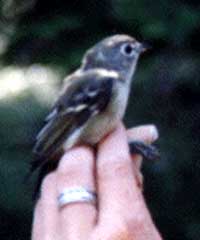
Vireo solitarius
(Blue-headed Vireo)
Order: Passeriformes
Order Description: Passerines
Family: Vireonidae
Family Description:Vireos
Physical Description:
5-6" (13-15 cm). Gray head with white spectacles and black eyes; olive-brown back, wings, and tail; wings have white and black barring; white below with yellow wash on flanks.
Similar Species- Gray and Hutton's vireos
Song:
Short, burry, whistled phrases
Distribution:
Blue-headed Vireos nest in the Eastern Idaho region. Breeds across portions of Canada, south to Baja California, central Honduras, western Texas, northern Minnesota, southern Ohio, southern Appalachians, and New Jersey. Winters from southern California, northern Mexico, and portions of southeastern U.S., south to Costa Rica and western Panama.
Habitat:
Found in mixed woodlands, humid montane forests, pine/oak, oak forests, and pinyon/juniper. During migration and in winter, also found in variety of forests, woodlands, scrub, and thicket habitats, but prefers forest edges and semi-open situations.
Diet:
Eats mostly insects, but will also eat some spiders and small fruits.
Ecology:
Builds cup-shaped nest in tree (usually coniferous). Forages among foliage and branches of trees and shrubs. Species is common host for Brown-headed Cowbird, especially near settled areas in western U.S.; cowbirds reduce vireo reproductive success.
Reproduction:
Both sexes incubate 3- 5 eggs (usually 4), for probably 13-14 days.
Conservation:
| Element Code: | ABPBW01160(?) |
| Status: | Protected nongame species |
| Global Rank: | G5 |
| State Rank: | S5 |
| National Rank: | N5B,N5N |
Species Update:
The Solitary Vireo species in Idaho has been recently reclassified into three new species: Cassin's, Plumbeous, and Blue-headed Vireos.
Important State References:
Hejl, S.J. and R.E. Woods. 1990. Bird assemblages in old-growth and rotation-aged Douglas-fir/Ponderosa pine stands in the northern Rocky Mountains: a preliminary assessment. Pp. 93-100 in D.M. Baumgartner and J.E. Lotan, eds., Proceedings of a Symposium on Interior Douglas-fir: the species and its management. Feb. 27, 1990, Spokane WA.
Information by C. Trost, 2000.
Original images provided by Jason Karl,© 2000
Design by Ean Harker©, 2000.
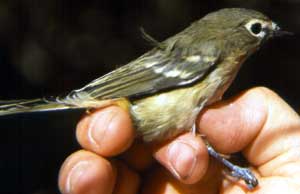
Vireo cassinii
(Cassin's Vireo)
Order: Passeriformes
Order Description: Passerines
Family: Vireonidae
Family Description:Vireos
Physical Description:
5-6" (13-15 cm). Gray head with white spectacles and black eyes; olive-brown back, wings, and tail; wings have white and black barring; white below with yellow wash on flanks.
Similar Species- Gray and Hutton's vireos
Song:
Short, burry, whistled phrases
Distribution:
In Idaho, Cassin's Vireos nest to the north of the Snake River. Breeds across portions of Canada, south to Baja California, central Honduras, western Texas, northern Minnesota, southern Ohio, southern Appalachians, and New Jersey. Winters from southern California, northern Mexico, and portions of southeastern U.S., south to Costa Rica and western Panama.
Habitat:
Found in mixed woodlands, humid montane forests, pine/oak, oak forests, and pinyon/juniper. During migration and in winter, also found in variety of forests, woodlands, scrub, and thicket habitats, but prefers forest edges and semi-open situations.
Diet:
Eats mostly insects, but will also eat some spiders and small fruits.
Ecology:
Builds cup-shaped nest in tree (usually coniferous). Forages among foliage and branches of trees and shrubs. Species is common host for Brown-headed Cowbird, especially near settled areas in western U.S.; cowbirds reduce vireo reproductive success.
Reproduction:
Both sexes incubate 3- 5 eggs (usually 4), for probably 13-14 days.
Conservation:
| Element Code: | ABPBW01160(?) |
| Status: | Protected nongame species |
| Global Rank: | G5 |
| State Rank: | S5 |
| National Rank: | N5B,N5N |
Species Update:
The Solitary Vireo species in Idaho has been recently reclassified into three new species: Cassin's, Plumbeous, and Blue-headed Vireos.
Important State References:
Hejl, S.J. and R.E. Woods. 1990. Bird assemblages in old-growth and rotation-aged Douglas-fir/Ponderosa pine stands in the northern Rocky Mountains: a preliminary assessment. Pp. 93-100 in D.M. Baumgartner and J.E. Lotan, eds., Proceedings of a Symposium on Interior Douglas-fir: the species and its management. Feb. 27, 1990, Spokane WA.
Information by C. Trost, 2000.
Original images provided by C. Trost,© 2000
Design by Ean Harker w/ Mike Legler©, 2000.
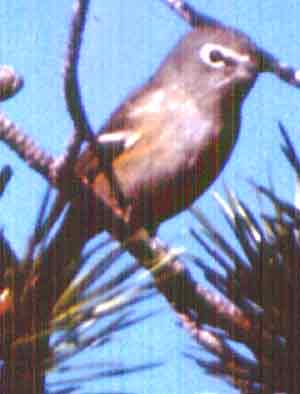
Vireo plumbeus
(Plumbeous Vireo)
Order: Passeriformes
Order Description: Passerines
Family: Vireonidae
Family Description:Vireos
Physical Description:
5-6" (13-15 cm). Gray head with white spectacles and black eyes; olive-brown back, wings, and tail; wings have white and black barring; white below with yellow wash on flanks.
Similar Species- Gray and Hutton's vireos
Song:
Short, burry, whistled phrases
Distribution:
Plumbeous Vireos nest south of the Snake River in mountainous habitats. Breeds across portions of Canada, south to Baja California, central Honduras, western Texas, northern Minnesota, southern Ohio, southern Appalachians, and New Jersey. Winters from southern California, northern Mexico, and portions of southeastern U.S., south to Costa Rica and western Panama.
Habitat:
Found in mixed woodlands, humid montane forests, pine/oak, oak forests, and pinyon/juniper. During migration and in winter, also found in variety of forests, woodlands, scrub, and thicket habitats, but prefers forest edges and semi-open situations.
Diet:
Eats mostly insects, but will also eat some spiders and small fruits.
Ecology:
Builds cup-shaped nest in tree (usually coniferous). Forages among foliage and branches of trees and shrubs. Species is common host for Brown-headed Cowbird, especially near settled areas in western U.S.; cowbirds reduce vireo reproductive success.
Reproduction:
Both sexes incubate 3- 5 eggs (usually 4), for probably 13-14 days.
Conservation:
| Element Code: | ABPBW01160(?) |
| Status: | Protected nongame species |
| Global Rank: | G5 |
| State Rank: | S5 |
| National Rank: | N5B,N5N |
Species Update:
The Solitary Vireo species in Idaho has been recently reclassified into three new species: Cassin's, Plumbeous, and Blue-headed Vireos.
Important State References:
Hejl, S.J. and R.E. Woods. 1990. Bird assemblages in old-growth and rotation-aged Douglas-fir/Ponderosa pine stands in the northern Rocky Mountains: a preliminary assessment. Pp. 93-100 in D.M. Baumgartner and J.E. Lotan, eds., Proceedings of a Symposium on Interior Douglas-fir: the species and its management. Feb. 27, 1990, Spokane WA.
Information by C. Trost, 2000.
Original images provided by C. Trost,© 2000
Design by Ean Harker ©, 2000.
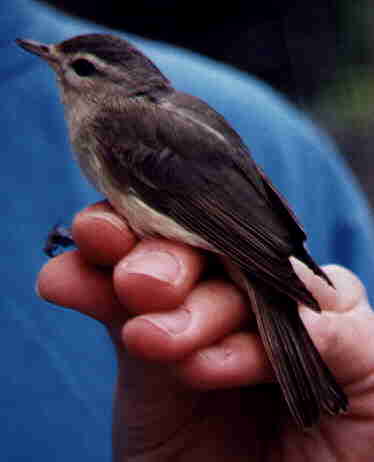
Vireo gilvus
(Warbling Vireo)
Order: Passeriformes
Order Description: Passerines
Family: Vireonidae
Family Description: Vireos
Physical Description:
4 1/2-5 1/2" (11-14 cm). Dark gray above, pale gray or white below; whitish eyebrow and dark eyes. Immatures tinged yellow below.
Similar Species- Philadelphia Vireo
Song:
Long, continuous warble with no pauses. Call is a raspy pwchee-chee.
Distribution:
Breeds from British Columbia, east across portions of Canada to northern Michigan, further east to Nova Scotia, and south to Baja California, northern Mexico, Texas, and portions of southeastern United States. Winters from northern Mexico to Nicaragua, and casually to Costa Rica.
Habitat:
Found in open, deciduous and deciduous/coniferous woodlands, riparian forests and thickets, pine/oak associations, orchards, and parks. During migration and in winter, found in wide variety of forest, woodland, and scrub habitats; seems to prefer light woodlands and savanna groves in winter. Idaho study found species was associated with dry, tall, willow areas.
Diet:
Primarily insectivorous. Feeds on caterpillars, beetles, grasshoppers, ants, spiders, and some berries.
Ecology:
Forages in trees. Builds cup-shaped nest, usually high in tree, but sometimes in shrub. density figures of 13.4 birds/40 ha have been recorded in flatland aspen; 60.0/40 ha in scrub-meadow; and 5 pairs/40 ha in Douglas-fir forest. Species is common cowbird host.
Reproduction:
Male and female, in turn, incubate 4 eggs (sometimes 3-5), for about 12 days. Nestlings are altricial and downy, are tended by both parents, and leave the nest in about 12-14 days.
Conservation:
| Element Code: | ABPBW01210 |
| Status: | Protected nongame species |
| Global Rank: | G5 |
| State Rank: | S5,NTMB |
| National Rank: | N5B |
Important State References:
Douglas, D.C., J.T. Ratti, R.A. Black, and J.R. Alldredge. 1992. Avian habitat associations in riparian zones of Idaho's Centennial Mountains. Wilson Bull. 104:485-500.
Photos by Jason Karl and C. Trost,© 2000
Design by Ean Harker©1999, 2000.
Written by Jason Karl, 2000.
Vireo olivaceus
(Red-eyed Vireo)
Link to photo provided by USGS - Patuxent Wildlife Research Center: http://www.mbr-pwrc.usgs.gov/Infocenter/infocenter.html
Order: Passeriformes
Order Description: Passerines
Family: Vireonidae
Family Description: Vireos
Physical Description:
5 1/2-6 1/2" (14-17 cm). Olive above and whitish below; red eyes with white eyebrows bordered by dark stripes; gray crown.
Similar Species- Warbling Vireo
Song:
Loud and melodious. Interpreted as: see me, here I am, up here, see? Vireo!
Distribution:
Breeds from British Columbia and probably southeastern Alaska, east across portions of Canada, and south to northern Oregon, northern Idaho, eastern Colorado, Texas, Gulf Coast, and southern Florida. Winters in South America.
Habitat:
Found in open, deciduous (less frequently coniferous) forests, especially with sapling undergrowth. Also found in second-growth woodlands, scrub, thickets, and gardens. During migration and in winter, found in various open forests, forest edges, woodlands, scrub, and brush habitats. In Idaho, primarily found in cottonwood riparian habitats and low numbers in aspen stands.
Diet:
Eats insects, small fruits, and seeds. Notably frugivorous, almost totally so away from breeding areas.
Ecology:
Forages in trees. Builds cup-shaped nest in shrub or deciduous tree. In one study, 45 territories averaged 0.7 ha/pair. Species is a common cowbird host.
Reproduction:
Female (mostly or entirely) incubates 3-5 eggs (usually 4), for 11-14 days. Young are tended by both parents, and leave nest at 10-14 days. Female occasionally produces 2 broods/yr.
Conservation:
| Element Code: | ABPBW01240 |
| Status: | Protected nongame species |
| Global Rank: | G5 |
| State Rank: | S5,NTMB |
| National Rank: | N5B |
Important State References:
No references are available at this time.
Design by Ean Harker©1999, 2000.
Written by Jason Karl, 2000.
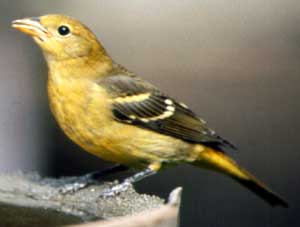
Piranga ludoviciana
(Western Tanager)
Order: Passeriformes
Order Description: Passerines
Family: Thraupidae
Family Description: Tanagers
Physical Description:
6-7 1/2" (15-19 cm). Yellow head, underparts, and rump; face washed with red; black wings, back, and tail; wings have two pale yellow bars. Female similar, but minus red wash on face.
Similar Species- Female orioles
Song:
Similar to the American Robin's song, but brusker.
Distribution:
Breeds from southeastern Alaska, east through western Canada, and south through western U.S. to northern Baja California, southern Nevada, southwestern Utah, Arizona, southern New Mexico, and western Texas. Winters from southern Baja California and central mainland of Mexico, south to portions of Central America (rarely southern US.).
Habitat:
Breeds mostly in coniferous and mixed mountain woodlands. Migrates and winters in variety of forest, woodland, scrub and partly-open habitats. Preliminary results of Idaho-Montana study indicated species favored old growth over rotation-aged stands in Douglas-fir/ponderosa pine habitats.
Diet:
Feeds on variety of insects and fruits.
Ecology:
Nests on horizontal branch of coniferous (occasionally deciduous) tree.
Reproduction:
Female incubates 3-5 eggs for 13 days. Nestlings are altricial. Young are tended by both adults.
Conservation:
| Element Code: | ABPBX45050 |
| Status: | Protected nongame species |
| Global Rank: | G5 |
| State Rank: | S5,NTMB |
| National Rank: | N5B |
Important State References:
Hejl, S.J. and R.E. Woods. 1990. Bird assemblages in old-growth and rotation-aged Douglas-fir/Ponderosa pine stands in the northern Rocky Mountains: a preliminary assessment. Pp. 93-100 in D.M. Baumgartner and J.E. Lotan, eds., Proceedings of a Symposium on Interior Douglas-fir: the species and its management. Feb. 27, 1990, Spokane WA.
Photo by C. Trost,© 2000
Design by Ean Harker©1999, 2000.
Written by Jason Karl, 2000.
Bombycilla cedrorum
(Cedar Waxwing)
Link to photo provided by USGS - Patuxent Wildlife Research Center: http://www.mbr-pwrc.usgs.gov/Infocenter/infocenter.html
Order: Passeriformes
Order Description: Passerines
Family: Bombycillidae
Family Description: Waxwings
Physical Description:
6 1/2-8" (17-20 cm). Silky looking bird because of its fine, small feathers. Crested head is brown with a black mask edged in white. Wings are brown at shoulder and gray at ends with red, waxy tips. These feathers are only found on adults. Brown breast fades to yellow bellow. Gray tail is tipped with yellow.
Similar Species- Bohemian Waxwing
Song:
Single, high pitched zeee, sometimes trilled.
Distribution:
Breeds from southeastern Alaska, east to Newfoundland, and south to northern California, northern Utah, western Oklahoma, southern Illinois, and parts of southeastern United States. Winters from southern Canada (locally) and northern U.S., south to central Panama, and casually to northern South America.
Habitat:
Found in variety of open woodland types (either deciduous or coniferous), and in forest edges, second growth, parks, orchards, and gardens. During migration and in winter, occurs wherever there are trees.
Diet:
Feeds opportunistically on small fruits. May consume maple tree sap and flower petals. In spring and summer, eats various insects.
Ecology:
Forages in vegetation, or may fly from perch to capture prey. Nests in tree; nest size varies. Individuals may form small nesting colonies of up to 12 pairs, and may travel in small groups or flocks. Winter flocks may reach thousands of individuals.
Reproduction:
Breeding season varies. Female incubates 3-5 eggs (sometimes 6), for 12-16 days. Young are tended by both adults, and leave nest at 14-18 days.
Conservation:
| Element Code: | ABPBN01020 |
| Status: | Protected nongame species |
| Global Rank: | G5 |
| State Rank: | S5,NTMB |
| National Rank: | N5 |
Important State References:
No references are available at this time.
Design by Ean Harker©1999, 2000.
Written by Jason Karl, 2000.
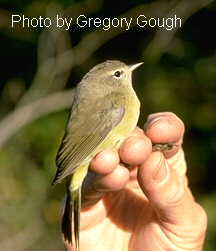
Vermivora celata
(Orange-crowned Warbler)
Order: Passeriformes
Order Description: Passerines
Family: Parulidae
Family Description: Wood Warblers
Physical Description:
4 1/2-5 1/2" (11-14 cm). Yellowy-green below and olive-gray above.
Similar Species- Tennessee and Wilson's warblers.
Song:
A high-pitched, tinny trill that changes speed and tone.
Distribution:
Breeds from portions of Alaska and Canada, south to northwestern Baja California, southeastern Arizona, and western Texas. Winters from northern California to southern Texas, and in parts of southeastern United States, Mexico, and Central America.
Habitat:
Found in deciduous and mixed woodlands, shrub, chaparral, steep shaded slopes, riparian thickets, and aspen woodlands. During migration and in winter, found in woodlands, forest edges, a variety of brushy, shrubby areas, and in open and overgrown pastures. Preliminary results of northern Idaho study found species was more abundant in selectively harvested stands than in continuous stands of old-growth conifers.
Diet:
Feeds on insects (wasps, ants, flies, caterpillars, etc.) and spiders.
Ecology:
Usually builds nest on ground, but will sometimes nest low in shrub or tree canopy. Not gregarious, but will occasionally forage with other bird species. Forages 1-11 m above ground.
Reproduction:
clutch size varies from 4-6 eggs, but is usually 5. Nestlings are altricial and downy and fledge in 8-10 days. Breeding biology is poorly known.
Conservation:
| Element Code: | ABPBX01050 |
| Status: | Protected nongame species |
| Global Rank: | G5 |
| State Rank: | S5,NTMB |
| National Rank: | N5B,N5N |
Important State References:
Hejl, S.J. and L.C. Paige. 1993. Birds in continuous and fragmented forests of western red cedar/western hemlock in northern Idaho: a preliminary assessment. Draft manuscript, Inter. Res. Sta., USDA Forest Service, Missoula. 18pp.
Photo by Gregory Gough ,©1999.
Design by Ean Harker©1999, 2000.
Written by Jason Karl, 2000.
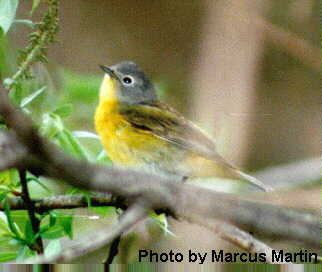
Vermivora ruficapilla
(Nashville Warbler)
Order: Passeriformes
Order Description: Passerines
Family: Parulidae
Family Description: Wood Warblers
Physical Description:
4-5" (10-13 cm). Gray head and back of neck with spotted, chestnut crown patch and white eyering. Yellow-orange below. Brown wings and back.
Similar Species- MacGillivray's, Mourning, and Virginia's warblers, and immature male Common Yellowthroat.
Song:
A two part song: sebit-sebit-sebit-ti-ti-ti-ti.
Distribution:
Breeds from southern British Columbia, east to northwestern Montana, and south to southern California and Nevada. Also breeds in portions of eastern Canada and United States. Winters from northern Mexico, east to southern Texas, and south into Guatemala.
Habitat:
Found in forest-bordered bogs, second growth, open deciduous and coniferous woodlands, forest edges and undergrowth, and cut-over or burned areas. During migration and in winter, found in various woodland, scrub, and thicket habitats.
Diet:
Eats insects. In nonbreeding range, visits flowers, takes small berries and seeds, and gleans for small insects.
Ecology:
Builds concealed, cup- shaped nest on ground. Forages from ground to treetop, but usually remains low in trees and thickets at edges of forests. Uncommon cowbird host. Species is poorly studied.
Reproduction:
Female incubates 4-5 eggs for 11-12 days. Young are tended by both parents, and leave nest at about 11 days.
Conservation:
| Element Code: | ABPBX01060 |
| Status: | Protected nongame species |
| Global Rank: | G5 |
| State Rank: | S5,NTMB |
| National Rank: | N5B,NZN |
Important State References:
No references are available at this time.
Photo by Marcus Martin,© 2000
Design by Ean Harker©1999, 2000.
Written by Jason Karl, 2000.
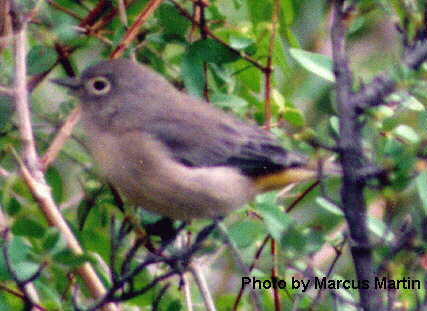
Vermivora virginiae
(Virginia's Warbler)
Order: Passeriformes
Order Description: Passerines
Family: Parulidae
Family Description: Wood Warblers
Physical Description:
4-4 3/4" (10-13 cm). Gray above and whitish gray below. Yellow breast, rump, and undertail; dull red crown patch; distinct white eyering.
Similar Species- Colima, Lucy's, and Nashville warblers
Song:
Colorless push-pull notes: seedle seedle seedle.
Distribution:
Breeds in Great Basin from southeastern Idaho, northeastern Utah, and central Colorado, south to southeastern California, southern Nevada, southeastern Arizona, and central New Mexico. Winters in southwestern Mexico.
Habitat:
Breeds in deciduous woodlands on steep mountain slopes. Also found along mountain streams in sagebrush, or in cottonwood and willow habitat at 1800-2800 m. Winters in arid scrub. In Idaho, species is most closely associated with pinyon/juniper woodlands and nearby riparian areas.
Diet:
Eats insects. Both sexes have been seen carrying caterpillars to young.
Ecology:
Builds concealed, cup- shaped nest on ground. Forages on ground in thick brush, or flies from perch to catch prey. Species is uncommon cowbird host.
Reproduction:
clutch size varies from 3-5 eggs, but is usually 4. Young are cared for by both parents. Little is known about breeding biology.
Conservation:
| Element Code: | ABPBX01070 |
| Status: | Protected nongame species |
| Global Rank: | G5 |
| State Rank: | S2,NTMB |
| National Rank: | N5B |
Important State References:
No references are available at this time.
Photo by Marcus Martin, ©1999.
Design by Ean Harker©1999, 2000.
Written by Jason Karl, 2000.
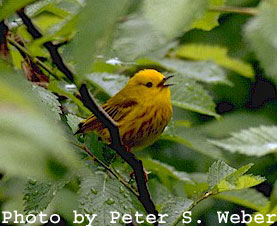
Dendroica petechia
(Yellow Warbler)
Order: Passeriformes
Order Description: Passerines
Family: Parulidae
Family Description: Wood Warblers
Physical Description:
4 1/2-5 1/4" (11-13 cm). Most extensively yellow warbler. Almost completely yellow; wings and tail darker olive-yellow. Males have rust-colored streaks on breast. Both sexes have black eyes and bill.
Similar Species- Female Wilson's Warbler, Orange-crowned Warbler
Song:
Song begins with three similar notes followed by a varied, emphatic ending of notes.
Distribution:
Breeds from northern Alaska, east across northern Canada to Labrador, and south to Panama and northern coast of South America. Winters from southern California, southern Arizona, northern Mexico, and southern Florida, south to central Peru, northern Bolivia, and Amazonian Brazil.
Habitat:
Found in open scrub, second-growth woodlands, thickets, farmlands, and gardens, especially near water. During migration and in winter, found in open woodlands, plantations, brushy areas, and forest edges. Several Idaho studies have found this species to be a riparian habitat generalist.
Diet:
Eats insects (especially caterpillars) and spiders. In southern range, occasionally eats small fruits or nectar.
Ecology:
Takes most food from vegetation; may fly from perch to capture prey. Builds cup-shaped nest in shrub. Territories as small as 0.16 ha have been reported. Migrants are solitary and territorial in winter. Species is one of most common cowbird hosts. Reduced grazing apparently results in increased population size.
Reproduction
Female incubates 3-6 eggs (usually 4-5), for 11-12 days. Young are tended by both parents, and leave nest at 9- 12 days.
Conservation:
| Element Code: | ABPBX03010 |
| Status: | Protected nongame species |
| Global Rank: | G5 |
| State Rank: | S5,NTMB |
| National Rank: | N5B,N5N |
Important State References:
Douglas, D.C., J.T. Ratti, R.A. Black, and J.R. Alldredge. 1992. Avian habitat associations in riparian zones of Idaho's Centennial Mountains. Wilson Bull. 104:485-500.
Photos by Peter S. Weber,© 2000, and Jason Karl,© 2000
Design by Ean Harker©1999, 2000.
Written by Jason Karl, 2000.
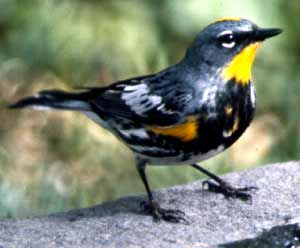
Dendroica coronata
(Yellow-rumped Warbler)
Order: Passeriformes
Order Description: Passerines
Family: Parulidae
Family Description: Wood Warblers
Physical Description:
5-6" (13-15 cm). Gray with dark streaking on back and breast; white belly. Yellow on crown, throat, rump, and armpits. Two white wing bars; white eyering. Females, juveniles, and non-breeding males duller.
Similar Species- Grace's Warbler
Song:
Fast warble, almost a trill.
Distribution:
Breeds from Alaska and Canada, south to north-central and northeastern U.S. and through western U.S. into Baja California. Winters from southwestern Canada and northwestern, central and east-central U.S., south throughout western Mexico to Guatemala and uncommonly to Honduras. Species is one of the most abundant and widely distributed warblers.
Habitat:
When breeding, found in forests or open woodlands. During migration and in winter, found in open forests, woodlands, savannas, roadsides, pastures, and scrub habitat. May be seen in parks and gardens.
Diet:
Feeds on insects (ants, wasps, flies, beetles, mosquitoes, etc.), spiders, and some berries and seeds. May drink tree sap.
Ecology:
Builds cup-shaped nest on horizontal branch in coniferous tree. Forages by moving slowly over trunks and branches, by catching insects in flight, or by hopping on ground.
Reproduction
Female incubates 4-5 eggs for 12-13 days. Nestlings are tended by both parents, but are brooded by female. Young leave nest in 12-14 days.
Conservation:
| Element Code: | ABPBX03060 |
| Status: | Protected nongame species |
| Global Rank: | G5 |
| State Rank: | S5,NTMB |
| National Rank: | N5B,N5N |
Important State References:
Douglas, D.C., J.T. Ratti, R.A. Black, and J.R. Alldredge. 1992. Avian habitat associations in riparian zones of Idaho's Centennial Mountains. Wilson Bull. 104:485-500.
Original images provided by C. Trost,© 2000
Design by Ean Harker©1999, 2000.
Written by Jason Karl, 2000.
Dendroica nigrescens
(Black-throated Gray Warbler)
Link to photo provided by USGS - Patuxent Wildlife Research Center: http://www.mbr-pwrc.usgs.gov/Infocenter/infocenter.html
Order: Passeriformes
Order Description: Passerines
Family: Parulidae
Family Description: Wood Warblers
Physical Description:
4 1/2-5" (11-13 cm). Black crown, white eyebrow, black eyestripe, white moustache, black chin; yellow spot between eye and bill. White below with black streaking on flanks. Dark gray above with two white wing bars and tail edged with white. Females have white chin.
Similar Species- Black-and-white Warbler, Blackpoll
Song:
Starts with repeated whistles on the same note, then rises and gets buzzy.
Distribution:
Breeds from southwestern British Columbia, western Washington, central Oregon, southwestern Idaho, northern Utah, southwestern Wyoming, and northwestern and central Colorado, south in mountains to Arizona, eastern and southern New Mexico, and northern Mexico. Winters from western and southern California and southern Arizona, south to portions of northern Mexico.
Habitat:
Found in dry, open forests and woodlands, and in brushland and chaparral. May inhabit fir forests, edges of clearings, or juniper/pinyon/oak scrub on slopes, foothills, and canyons. In winter, can be found in arid mountain woodlands, including pine/oak. In Idaho, species is associated with juniper stands.
Diet:
Feeds mainly on insects (moths, butterflies, beetles, ants, etc.). May also eat leaf galls and a few spiders.
Ecology:
An inconspicuous, retirng bird. Builds nest in coniferous (sometimes deciduous) tree. Forages among leaves in bushes and trees. Seen singly or in pairs; may be seen in small groups while migrating. Jays, crows, and snakes prey on eggs and young.
Reproduction:
Female incubates 3-5 (usually 4) eggs. Young are tended by both parents.
Conservation:
| Element Code: | ABPBX03070 |
| Status: | Protected nongame species |
| Global Rank: | G5 |
| State Rank: | S3,NTMB |
| National Rank: | N5B,NZN |
Important State References:
No references are available at this time.
Design by Ean Harker©1999, 2000.
Written by Jason Karl, 2000.
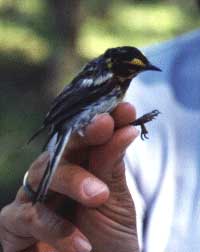
Dendroica townsendi
(Townsend's Warbler)
Order: Passeriformes
Order Description: Passerines
Family: Parulidae
Family Description: Wood Warblers
Physical Description:
4 1/4-5" (11-13 cm). Black and yellow-orange striped head; yellow-orange breast; streaking on flanks; dark olive-brown back and wings with two white wing bars; dark olive-brown tail with white outer edges. Females and immatures duller.
Similar Species- Hermit Warbler, Black- throated Gray Warbler
Song:
Call is a soft chip. Song is a rising series of buzzy notes.
Distribution:
Breeds from southeastern Alaska, south through western Canada to central and northeastern Oregon, northern Idaho, northwestern and south-central Montana, and northwestern Wyoming. Winters in central and southern California, western Mexico, and highlands of Central America.
Habitat:
Found in tall, coniferous and mixed coniferous/deciduous forests. During migration and in winter, found (primarily in montane situations) in humid forests, pine/oak associations, open woodlands, second growth and scrub. Preliminary results of Idaho-Montana study indicate species favors old- growth Douglas-fir stands over rotation-aged stands.
Diet:
Feeds mostly on insects (e.g., weevils, bugs, leafhoppers, caterpillars, etc.) and spiders. In winter, gleans small insects and caterpillars in foliage at all heights; hawks flying insects.
Ecology:
Builds cup-shaped nest in coniferous tree. Summer activity takes place in tops of trees.
Reproduction:
clutch size is usually 3-5 eggs. Nestlings fledge in 8-10 days.
Conservation:
| Element Code: | ABPBX03080 |
| Status: | Protected nongame species |
| Global Rank: | G5 |
| State Rank: | S4,NTMB |
| National Rank: | N5B,N?N |
Important State References:
Hejl, S.J. and R.E. Woods. 1990. Bird assemblages in old-growth and rotation-aged Douglas-fir/Ponderosa pine stands in the northern Rocky Mountains: a preliminary assessment. Pp. 93-100 in D.M. Baumgartner and J.E. Lotan, eds., Proceedings of a Symposium on Interior Douglas-fir: the species and its management. Feb. 27, 1990, Spokane WA.
Photo by Jason Karl,© 2000
Design by Ean Harker©1999, 2000.
Written by Jason Karl, 2000.
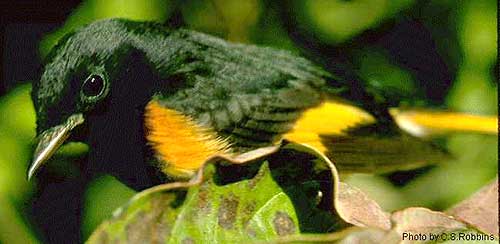
Setophaga ruticilla
(American Redstart)
Order: Passeriformes
Order Description: Passerines
Family: Parulidae
Family Description: Wood Warblers
Physical Description:
4 1/2-5 3/4" (11-15 cm). Adult male is very black except for orange wing and tail patches, orange sides of breast, and white belly. Female is gray with yellow patches.
Song:
Thin, high-pitched notes ending in a slur.
Distribution:
Breeds across portions of Alaska and Canada, south to Oregon, Arizona, Oklahoma, northern Gulf Coast, and Carolinas. Winters from southern Texas (rarely), south through Mexico (mainly coastally), and into Central and South America.
Habitat:
Found in open deciduous and mixed woodlands, second growth and tall shrubbery, orchards, shade trees, thickets, parks, gardens, and small groves. During migration and in winter, found in various forest, woodland, scrub, and thicket habitats.
Diet:
Eats mostly forest tree insects, but will also eat spiders and some fruits and seeds.
Ecology:
Nests in low, deciduous tree or shrub, sometimes in deserted nest of other species; nests are commonly parasitized by Brown-headed Cowbird. Captures prey during aerial sallies; sometimes gleans or hovers. Solitary in winter. Defends winter territory. density in winter (in Jamaica study) was 10- 51/10 ha, which was comparable to breeding densities reported for eastern U.S., but greater than densities reported for other sites in Caribbean and Mexico (0-17/10 ha).
Reproduction:
Female incubates 2-5 eggs (usually 4), for 12-13 days. Young are tended by both parents, and leave nest at 8-9 days.
Conservation:
| Element Code: | ABPBX06010 |
| Status: | Protected nongame species |
| Global Rank: | G5 |
| State Rank: | S4 |
| National Rank: | N5B,NZN |
Important State References:
No references are available at this time.
Photo by C. S. Robbins, ©2002.
Design by Ean Harker©1999, 2000.
Written by Jason Karl, 2000.
Seiurus noveboracensis
(Northern Waterthrush)
Link to photo provided by USGS - Patuxent Wildlife Research Center: http://www.mbr-pwrc.usgs.gov/Infocenter/infocenter.html
Order: Passeriformes
Order Description: Passerines
Family: Parulidae
Family Description: Wood Warblers
Physical Description:
5 1/2-6 1/2" (14-17 cm). Brownish olive above; buff eyestripe; whitish below with dark streaking; moderately long bill.
Similar Species- Ovenbird
Song:
Begins with 3-4 long, rising notes and ends with 3-4 rolling, descending notes.
Distribution:
Breeds from portions of Alaska and Canada, south to Washington, Idaho, North Dakota, Great Lakes, West Virginia, and Massachusetts. Winters in southern Florida, in portions of Mexico, throughout Central America, and in portions of South America.
Habitat:
Found in thickets near water, swamps, and bogs. In migration, found in forests, woodland, scrub, brushy areas, yards, and gardens. In winter, generally found alongside water, often along slow-moving streams in mangroves.
Diet:
Eats various small invertebrates.
Ecology:
Builds nest in ground under bank near water. Forages on muddy ground, among soggy, fallen leaves, or in extremely shallow water.
Reproduction:
Lays eggs from late May to June. Female incubates 3-6 eggs (usually 4-5). Breeding biology is poorly known.
Conservation:
| Element Code: | ABPBX10020 |
| Status: | Protected nongame species |
| Global Rank: | G5 |
| State Rank: | S3,NTMB |
| National Rank: | N5B,NZN |
Important State References:
No references are available at this time.
Design by Ean Harker©1999, 2000.
Written by Jason Karl, 2000.
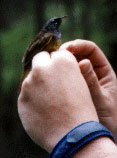
Oporornis tolmiei
(Macgillivray's Warbler)
Order: Passeriformes
Order Description: Passerines
Family: Parulidae
Family Description: Wood Warblers
Physical Description:
4 3/4-5 1/2" (12-14 cm). Slate gray head with black eye stripe that crosses white eye ring. Olive body, tinged yellow below. Male. Female.
Similar Species- Mourning Warbler, female Common Yellowthroat, arboreal Nashville Warbler.
Song:
A rolling chree-chree-chree-chree-chee-chee that ascends four notes and then drops for the last two.
Distribution:
Breeds from southeastern Alaska and western Canada, east to eastern Montana and southwestern South Dakota, and south (mainly in mountains) to southern California, central Arizona, and southern New Mexico. Winters in portions of Mexico and on Pacific side of Central America.
Habitat:
Found in coniferous forest undergrowth and edges, brushy hillsides, riparian thickets, and chaparral. During migration and in winter, found in variety of open woodland undergrowth, scrubby areas and thickets (often in cut-over or burned areas). Idaho study found species to be riparian habitat specialist, preferring dry, tall, willow areas with grasses and forbs.
Diet:
insectivorous.
Ecology:
Nests low in thick shrubs. Forages close to ground in dense vegetation.
Reproduction:
Female incubates 3-6 eggs (usually 4), for 11 days. Nestlings are altricial. Young are tended by both adults, and leave nest when 8-9 days old.
Conservation:
| Element Code: | ABPBX11040 |
| Status: | Protected nongame species |
| Global Rank: | G5 |
| State Rank: | S5,NTMB |
| National Rank: | N5B |
Important State References:
Douglas, D.C., J.T. Ratti, R.A. Black, and J.R. Alldredge. 1992. Avian habitat associations in riparian zones of Idaho's Centennial Mountains. Wilson Bull. 104:485-500.
Photos by Jason Karl and C. Trost,© 2000
Design by Ean Harker©1999, 2000.
Written by Jason Karl, 2000.

Geothlypis trichas
(Common Yellowthroat)
Order: Passeriformes
Order Description: Passerines
Family: Parulidae
Family Description: Wood Warblers
Physical Description:
4 1/2-5 3/4" (11-15 cm). Slightly mottled gray with yellow throat and under tail; pale belly. Male has black mask, yellow extending down breast from throat, and yellow tinged wings. Female has pale yellow eyebrow.
Similar Species- Nashville Warblers, Yellow- breasted Chat
Song:
Song is a repeated whichity-whichity-whichity-which.
Distribution:
Breeds from portions of Alaska and Canada, south to northern Baja California, southern Mexico, southern Texas, Gulf Coast, and southern Florida. Winters from northern California, southwestern U.S., southern Texas, Gulf states and South Carolina, south throughout Mexico, Central America and portions of South America. Species may be the most abundant warbler.
Habitat:
Found in marshes (especially cattail marshes), thickets near water, bogs, brushy pastures, old fields, and, locally, undergrowth of humid forests. During migration and in winter, found in brushy and shrubby areas in both moist and arid regions. Idaho study found species favored wet, low, willow habitats.
Diet:
Eats various small invertebrates.
Ecology:
Nests in shrub. Forages in low plants. Southeastern Massachusetts study reported population density of about 1.5- 2.5 territories/ha. Species is frequent cowbird host.
Reproduction:
Female incubates 3-6 eggs (usually 4), for 11-13 days. Young are tended by both parents, and leave nest at 8- 10 days. polygyny has been observed. Female usually produces 2 broods/yr.
Conservation:
| Element Code: | ABPBX12010 |
| Status: | Protected nongame species |
| Global Rank: | G5 |
| State Rank: | S5,NTMB |
| National Rank: | N5 |
Important State References:
Douglas, D.C., J.T. Ratti, R.A. Black, and J.R. Alldredge. 1992. Avian habitat associations in riparian zones of Idaho's Centennial Mountains. Wilson Bull. 104:485-500.
Photos by C. S. Robbins. ©2002 and C. Trost,© 2000
Design by Ean Harker©1999, 2000.
Written by Jason Karl, 2000.
Wilsonia pusilla
(Wilson's Warbler)
Link to photo provided by USGS - Patuxent Wildlife Research Center: http://www.mbr-pwrc.usgs.gov/Infocenter/infocenter.html
Order: Passeriformes
Order Description: Passerines
Family: Parulidae
Family Description: Wood Warblers
Physical Description:
4 1/2-4 3/4" (11-12 cm). Black crown; yellow below and on head and nape; olive-green back and wings; dark eyes. Females have duller crown.
Similar Species- Female Yellow Warbler
Song:
A short, chattering trill, dropping in pitch.
Distribution:
Breeds from portions of Alaska and Canada, south to southern California, central Nevada, northern Utah, northern New Mexico, northern Minnesota, and portions of upper New England. Winters occasionally along Gulf Coast and southern Texas, throughout most of Mexico, and commonly in Central America.
Habitat:
Found in open areas in moist woodlands, in bogs with scattered trees, and in willow and alder thickets. During winter, found in semi-open or lightly-wooded areas, in canopies, openings, and edges of forest, and in second growth, coffee plantations, brushy fields, and yards.
Diet:
Feeds on insects such as wasps, ants, flies, beetles, and caterpillars.
Ecology:
Builds nest on ground. Forages throughout available vegetation, obtaining most food from leaves by gleaning while perched or flying. Usually solitary and territorial in winter, but may join mixed flocks. California study found territory size in different habitats ranged from about 0.2-2.2 ha.
Reproduction:
clutch size is commonly 3-4 eggs in coastal California, 4-5 in Sierra Nevada, and 5-6 in Alaska. Incubation lasts about 12-15 days; female incubates eggs. Young are tended by both parents, and leave nest at 9-10 days (California). In Sierra Nevada, some males are polygynous.
Conservation:
| Element Code: | ABPBX16020 |
| Status: | Protected nongame species |
| Global Rank: | G5 |
| State Rank: | S5,NTMB |
| National Rank: | N5B |
Important State References:
Douglas, D.C., J.T. Ratti, R.A. Black, and J.R. Alldredge. 1992. Avian habitat associations in riparian zones of Idaho's Centennial Mountains. Wilson Bull. 104:485-500.
Design by Ean Harker©1999, 2000.
Written by Jason Karl, 2000.
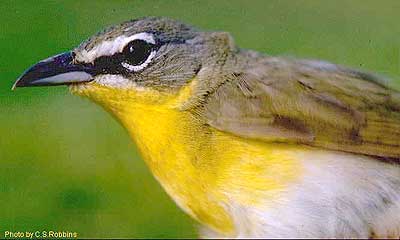
Icteria virens
(Yellow-breasted Chat)
Order: Passeriformes
Order Description: Passerines
Family: Parulidae
Family Description: Wood Warblers
Physical Description:
6 1/2-7 1/2" (16-19 cm). Grayish-brown above, gold below with light gray belly-band. Short, white eyebrow and mustache; white eye ring. Long legs and tail.
Similar Species- Male Common Yellowthroat
Song:
A variety of chucks, hollow whistles, high pitched squawks, and loud flute-like notes.
Distribution:
Breeds east across portions of Canada and northern U.S. to northern New England, and south to Gulf Coast and portions of Mexico. Winters from portions of northern Mexico, southern Texas, and southern Florida, south to portions of Central America.
Habitat:
Found in second growth, shrubby old pastures, thickets, brushy areas, scrub, woodland undergrowth, and fencerows. Often found in low, wet places near streams, pond edges, or swamps.
Diet:
Eats mostly insects, but will also eat small fruits, particularly in winter.
Ecology:
Builds nests in shrubs and sometimes on ground. Sedentary and solitary during winter. May form loose nesting colonies. Southern Indiana study found 5-8 breeding males (plus 2-5 territorial nonbreading males) per 18 ha of upland deciduous scrub; territory averaged 1.24 ha; and very few individuals returned to study area in years following first capture.
Reproduction:
Female incubates 3-6 eggs (usually 5), for 11-12 days. Young are tended by both parents, and leave nest at 8- 11 days. Southern Indiana study found that nests begun in late June and July were more successful than nests begun earlier; nearly all nest failures were attributed to predators.
Conservation:
| Element Code: | ABPBX24010 |
| Status: | Protected nongame species |
| Global Rank: | G5 |
| State Rank: | S5,NTMB |
| National Rank: | N5B |
Important State References:
No references are available at this time.
Photo by C. S. Robbins. ©2002.
Design by Ean Harker©1999, 2000.
Written by Jason Karl, 2000.
Pipilo chlorurus
(Green-tailed Towhee)
Link to photo provided by USGS - Patuxent Wildlife Research Center: http://www.mbr-pwrc.usgs.gov/Infocenter/infocenter.html
Order: Passeriformes
Order Description: Passerines
Family: Emberizidae
Family Description: Blackbirds, Orioles, & Sparrows
Physical Description:
Size: 6.25-7" (16-18cm). A slender ground finch. Sexes similar. The body is slate gray with drab-olive wings and tail. Black wing bars. Note white spots on lores and distinct rufous cap
Similar Species- This bird is fairly distinct and is one of the only Idaho songbirds with a green color. It's song resembles a Fox Sparrow.
Song:
Song is a lively mix of slurred notes and short trills. Call is a soft, catlike Mew.
Distribution:
Breeds from southwestern and central Oregon, southeastern Washington, southern Idaho, southwestern Montana, and Wyoming, south through interior mountains to southern California, southern Nevada, central Arizona, and southern New Mexico. Winters from southern California, southern Arizona, and western and southern Texas, south to southern Baja California and central Mexico.
Habitat:
Found in thickets, chaparral, shrublands, and riparian scrub, primarily in mountains in breeding season, to lowland habitats when not breeding. Avoids forested areas.
Diet:
Feeds on seeds, berries, and insects.
Ecology:
Nests in shrub; when nest is approached, female drops down to ground and runs away. Individuals forage in leaf litter, using double-scratch motion.
Reproduction:
clutch size varies from 2-4 eggs, but is usually 4. Nestlings are altricial and downy.
Conservation:
| Element Code: | ABPBX74010 |
| Status: | Protected nongame species |
| Global Rank: | G5 |
| State Rank: | S5,NTMB |
| National Rank: | N5B,N5N |
Important State References:
No references are available at this time.
Design by Ean Harker©1999, 2000.
Written by Jason Karl, 2000.
Pipilo maculatus
(Spotted Towhee)
Link to photo provided by USGS - Patuxent Wildlife Research Center: http://www.mbr-pwrc.usgs.gov/Infocenter/infocenter.html
Order: Passeriformes
Order Description: Passerines
Family: Emberizidae
Family Description: Blackbirds, Orioles, & Sparrows
Physical Description:
Size: 7-8.5" (18-22cm). A long-tailed bird, slightly smaller than a Robin. Males have a black "hood" on head, extending down the back. Belly white, sides rufous (hence it's old common name: rufous-sided towhee). Two white wing bars and white spots on the shoulder (hence its current common name). White spots on the tail are easily identified in flight and are a good key to identification of this species in the field. Females are similar but with brown heads and back. Less white on the tail.
Similar Species- Robins are larger with solid chestnut breast and belly. Black-headed Grosbeaks are stockier with orangish breast and white belly. Orange extends on to back. No white on the tail.
Song:
Song a three-parted Chup-Chup-Zeeeeeee. With the last part trilled. Very distinct. Call is a one-noted, harsh Zreeee.
Distribution:
Breeds from southern British Columbia, east to southwestern Maine, and south to Baja California, Guatemala, western Texas, northern Oklahoma, northern Arizona, and portions of southeastern United States. Winters north to southern British Columbia, Utah, Colorado, portions of Midwest, and Massachusetts, and south to Guatemala.
Habitat:
Found in undergrowth of open woodlands, forest edges, second growth, brushy areas, chaparral, and riparian thickets.
Diet:
Eats various invertebrates, seeds, small fruits, and some small vertebrates.
Ecology:
Builds cup-shaped nest on ground. Nesting female may fake injury to distract predator. Individuals forage in leaf litter, using double-scratch motion. Massachusetts study reported density of about 1-3 territories/ha. Species is one of the neotropical migrants thought to be declining in Idaho.
Reproduction:
Female (usually) incubates 2-6 eggs (usually 3-4), for 12-13 days. Young are tended by both parents, and leave nest in 10-13 days. Female may produce 2 broods/yr.
Conservation:
| Element Code: | Unknown |
| Status: | Protected nongame species |
| Global Rank: | G5 |
| State Rank: | S5,NTMB |
| National Rank: | N5 |
Important State References:
Saab, V. and C.R. Groves. 1992. Idaho's migratory landbirds: description, habitats, and conservation. Nongame Wildlife Leaflet #10, Idaho Dept. Fish & Game, Boise. 16pp.
Design by Ean Harker©1999, 2000.
Written by Jason Karl, 2000.
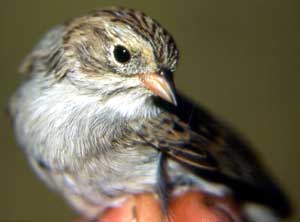
Spizella breweri
(Brewer's Sparrow)
Order: Passeriformes
Order Description: Passerines
Family: Emberizidae
Family Description: Blackbirds, Orioles, & Sparrows
Physical Description:
5-5 1/2" (13-15 cm). Gray with black and chestnut edging on feathers above, dark striping on crown, and a white eyering.
Similar Species- Clay-colored and Vesper sparrows.
Song:
Dry, buzzy trills on different notes, descending at the end.
Distribution:
Breeds across portions of western Canada and southwestern North Dakota, south to southern California, southern Nevada, central Arizona, and northwestern New Mexico. Winters from portions of southwestern U.S., south to southern Baja California and central mainland of Mexico.
Habitat:
Usually found in association with sagebrush. During migration and in winter, also found in desert scrub and creosote bush. Idaho study found Brewer's Sparrows prefer large, living sagebrush for nesting. A recent study in southwestern Idaho concluded that their distribution was influenced by both local vegetation cover and landscape-level features such as patch size.
Diet:
In spring and summer, consumes insects such as alfalfa weevils, aphids, beet leafhopers, caterpillars, and beetles. In fall and winter, feeds on seeds. Obtains water from food.
Ecology:
In Idaho, builds cup-shaped nest in sagebrush between 20 and 50 cm high or in low tree. Forages on ground. May be abundant in sagebrush habitat (Great Basin and Pacific slopes). In eastern Washington, as many as 47 pairs have been recorded on 100 ac. Breeding density of 0.08-0.10 individuals/ha has been reported in shadscale habitat in eastern Nevada. Breeding territory averaged 0.52 ha in Idaho study. During nesting season many males may sing in chorus at dawn and twilight. Two Idaho studies have indicated nesting success is quite low. In Great Basin, population density is usually 150-300/km2, but may exceed 500/km2 in some cases. Species is one of 7 neotropical migrants thought to be declining in Idaho.
Reproduction:
Breeding begins in mid-April in southern range, to May or early June in north. Idaho study found clutch size averaged 3.4 eggs. Nestlings are altricial.
Conservation:
| Element Code: | ABPBX94040 |
| Status: | Protected nongame species |
| Global Rank: | G5 |
| State Rank: | S?,NTMB |
| National Rank: | N5B,N5N |
Important State References:
Peterson, K.L. and L.B. Best. 1985. Brewer's sparrow nest-site characteristics in sagebrush community. J. Field Ornith. 56:23-27.
Photo by C.Trost,© 1998
Design by Ean Harker©1999, 2000.
Written by Jason Karl, 2000.
Chondestes grammacus
(Lark Sparrow)
Link to photo provided by USGS - Patuxent Wildlife Research Center: http://www.mbr-pwrc.usgs.gov/Infocenter/infocenter.html
Order: Passeriformes
Order Description: Passerines
Family: Emberizidae
Family Description: Blackbirds, Orioles, & Sparrows
Physical Description:
5 1/2-6 3/4" (14-17 cm). Delicately marked, light-colored sparrow. Chestnut and white striped head with a dark, thin eye stripe. buff below with dark chest spot; chestnut, black, and white mottled above; dark tail with white corners. Immature has streaked breast and no chest spot.
Similar Species- Vesper Sparrow
Song:
Song is a combination of 4-5 different trills and burry notes.
Distribution:
Breeds from western Oregon, eastern Washington, southern British Columbia, southern Prairie Provinces, and portions of upper Midwest, south to portions of southwestern and southeastern U.S. Winters in southern U.S., south through Mexico, and casually south to El Salvador.
Habitat:
Found in open situations with scattered bushes and trees such as prairies, forest edges, cultivated areas, orchards, fields with bushy borders, and savannas.
Diet:
Feeds on seeds and insects (especially grasshoppers).
Ecology:
gregarious. Builds cup- shaped nest, usually in depression on ground, but may also nest in shrub or crevice in rock. Female may engage in distraction displays. Individuals forage on ground, often in small flocks, and are seen in flocks, especially during winter.
Reproduction:
clutch initiation peaks in early May in southern range, early June in north. Female incubates 3-6 eggs (usually 4- 5), for about 12 days. Young leave nest at 9-10 days, and are able to fly short distances at that time. Males may be polygynous.
Conservation:
| Element Code: | ABPBX96010 |
| Status: | Protected nongame species |
| Global Rank: | G5 |
| State Rank: | S5,NTMB |
| National Rank: | N5B |
Important State References:
No references are available at this time.
Design by Ean Harker©1999, 2000.
Written by Jason Karl, 2000.
Amphispiza belli
(Sage Sparrow)
Link to photo provided by USGS - Patuxent Wildlife Research Center: http://www.mbr-pwrc.usgs.gov/Infocenter/infocenter.html
Order: Passeriformes
Order Description: Passerines
Family: Emberizidae
Family Description: Blackbirds, Orioles, & Sparrows
Physical Description:
5-6" (13-15 cm). Gray head, brown above, and whitish below. Have a light eyering, eyebrow, and white and black vertical bars on neck. Small, black midbreast spot.
Similar Species- Juvenile Black-throated Sparrow
Song:
Finch-like jumbled notes, rising and then falling. Call is a sharp tsit.
Distribution:
Breeds from central Washington, eastern Oregon, southern Idaho, and southwestern and northwestern Colorado, south to southern California, central Baja California, southern Nevada, southwestern Utah, northeastern Arizona and northwestern New Mexico. Winters from portions of southwestern U.S., south to portions of northwestern Mexico.
Habitat:
Found in sagebrush, saltbush brushlands, and chaparral. During migration and in winter, also found in arid plains with sparse bushes, in grasslands, and in open situations with scattered brush. One Idaho study found nesting occurred in areas where sagebrush coverage was sparse but clumped. A recent southwestern Idaho study concluded that distribution of sage sparrows was influenced by both local vegetation cover and landscape features such as patch size.
Diet:
Feeds on insects, spiders, and seeds (especially in winter.)
Ecology:
Builds cup-shaped nest, usually in sagebrush. Idaho study found species preferred large, living sagebrush for nesting; nests were not placed on southwest side of shrubs. Individuals run along ground, stopping to pick up food; may also take food from foliage. Species forms flocks of 25-50 individuals in winter. Breeding territory size usually averages about 1.5-3 ha. population density is usualy 50-200/km2 in Great Basin. In Oregon, predation by Townsend's ground squirrels affected reproductive success; populations in southeastern Washington and northern Nevada incurred high rates of nest predation, probably from gopher snakes.
Reproduction:
An Idaho study found clutch size averaged 2.8 eggs. Incubation lasted about 14 days; successful nests averaged 1.3 fledglings/nest. Nestlings are altricial. Female produces 1-3 broods annually. Reproductive success is greater in wetter years.
Conservation:
| Element Code: | ABPBX97020 |
| Status: | Protected nongame species |
| Global Rank: | G5 |
| State Rank: | S4,NTMB |
| National Rank: | N5 |
Important State References:
Peterson, K.L. and L.B. Best. 1985. Nest-site selection by Sage Sparrows. Condor 87:217-221.
Design by Ean Harker©1999, 2000.
Written by Jason Karl, 2000.
Ammodramus savannarum
(Grasshopper Sparrow)
Link to photo provided by USGS - Patuxent Wildlife Research Center: http://www.mbr-pwrc.usgs.gov/Infocenter/infocenter.html
Order: Passeriformes
Order Description: Passerines
Family: Emberizidae
Family Description: Blackbirds, Orioles, & Sparrows
Physical Description:
4 1/2-5" (11-13 cm). Dark head with buff central stripe and yellow eyebrows; yellow breast fades to white belly; dark brown above with white edgings and stripes.
Similar Species- Baird's Sparrow
Song:
Very faint buzz introduced by two soft notes.
Distribution:
Breeds from eastern Washington and southern British Columbia, east across portions of Canada and U.S. to Maine, and south to southern California, New Mexico, southern Texas, southeastern Arizona, and portions of northern Mexico and southeastern United States. Winters from southern U.S. to Costa Rica.
Habitat:
Found in prairies, old fields, open grasslands, cultivated fields, and savannas.
Diet:
Eats insects, other small invertebrates, grain, and seeds.
Ecology:
Builds nest on ground. Female may perform distraction displays. Forms small colonies when breeding. In one study, breeding territory was found to be about 0.4-1.3 ha. Forages on ground.
Reproduction:
Female incubates 3-6 eggs (commonly 4-5), for 11-13 days. Young are tended by female, and leave nest at 6-9 days while still unable to fly. Female commonly produces 2 broods/yr.
Conservation:
| Element Code: | ABPBXA0020 |
| Status: | Protected nongame species |
| Global Rank: | G4 |
| State Rank: | S3,NTMB |
| National Rank: | N5B,N5N |
Important State References:
No references are available at this time.
Design by Ean Harker©1999, 2000.
Written by Jason Karl, 2000.
Melospiza melodia
(Song Sparrow)
Link to photo provided by USGS - Patuxent Wildlife Research Center: http://www.mbr-pwrc.usgs.gov/Infocenter/infocenter.html
Order: Passeriformes
Order Description: Passerines
Family: Emberizidae
Family Description: Blackbirds, Orioles, & Sparrows
Physical Description:
5-7" (13-18 cm). Brown and gray striped head and breast; gray belly and nape; brown wings and tail; dark central breast spot.
Similar Species- Lincoln's, Swamp, Savannah, and Fox Sparrows
Song:
Song starts with sweet-sweet-sweet, then warbles with a buzzy sound in the middle and at the end.
Distribution:
Breeds across portions of Alaska and Canada, south to southern Baja California, southern Mexico, northern New Mexico, northern Arizona, and portions of southeastern United States. Winters from southern Alaska, coastal and southern British Columbia, northern U.S., and southeastern Canada, south through breeding range and southeastern United States.
Habitat:
Found in brushy, shrubby, and deep, grassy areas along watercourses and seacoasts, in marshes (e.g., cattail, bulrush, and salt), and mostly in northern and eastern portions of range, in forest edges, bogs, brushy clearings, thickets, hedgerows, and gardens. Idaho study found Song Sparrows preferred wet, short-willow communities for breeding.
Diet:
Eats mostly insects and seeds, but will also eat some small fruits.
Ecology:
Forages on ground, or in trees, grasses, and bushes. Builds cup-shaped nest on ground or, occasionally, in shrub. One study reported breeding territory at usually less than 0.4 ha.
Reproduction:
Female incubates 3-6 eggs for 12-13 days. Young are tended by both parents, leave nest at about 10 days, fly well at 17 days, become independent in 18-20 additional days, and reach sexual maturity in 1 yr. Female produces 2-3 broods/yr.
Conservation:
| Element Code: | ABPBXA3010 |
| Status: | Protected nongame species |
| Global Rank: | G5 |
| State Rank: | S5 |
| National Rank: | N5 |
Important State References:
Douglas, D.C., J.T. Ratti, R.A. Black, and J.R. Alldredge. 1992. Avian habitat associations in riparian zones of Idaho's Centennial Mountains. Wilson Bull. 104:485- 500.
Design by Ean Harker©1999, 2000.
Written by Jason Karl, 2000.
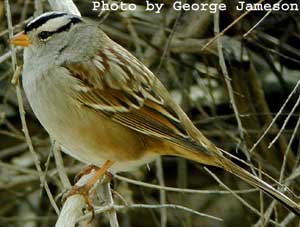
Zonotrichia leucophrys
(White-crowned Sparrow)
Order: Passeriformes
Order Description: Passerines
Family: Emberizidae
Family Description: Blackbirds, Orioles, & Sparrows
Physical Description:
5 1/2-7" (14-18 cm). Black-and-white striped crown; gray neck and breast; brown back, tail, and belly; white wing bars. Immatures have brown and buff head stripes.
Similar Species- White-throated Sparrow
Song:
One long whistle followed by wheezy trills on different pitches.
Distribution:
Breeds from northern Alaska, east across portions of Canada, and south to southern California, Nevada, central Arizona, and northern New Mexico. Winters from southern British Columbia, southeastern Washington, southern Idaho, Wyoming, and portions of Midwest and East, south to southern Baja California, southern mainland of Mexico, and Gulf Coast.
Habitat:
Found in open woodlands, burnt-over areas in forests, brushy areas, brushy subalpine meadows, willow thickets along streams or lakes, parks, and farmland. Idaho study found White-crowned Sparrows preferred dry, tall-willow portions of riparian communities.
Diet:
Feeds primarily on seeds of grasses and weeds (e.g., ragweed, pigweed, goosefoot, and panicum). Also feeds on invertebrates (e.g., ants, caterpillars, true bugs, beetles, spiders, and snails), especially in summer.
Ecology:
Builds cup-shaped nest in shrub or on ground. Large proportion of nests and nestlings may be lost to predators (e.g. garter snakes) in even a stable population. diurnal and crepuscular, but mostly inactive for several hours daily in continuous daylight at high latitudes. Forages on ground, or may take insects from foliage or air. May form flocks in winter, of 10-20 birds in southeastern U.S., 30-50 in West. Species is 1 of 7 neotropical migrants thought to be declining in Idaho.
Reproduction:
Female incubates 2-5 eggs (rarely 6), for 9-15 days. Young are tended by both parents, leave nest in 9-11 days, and are fed to some degree for additional 25-30 days. On California coast, females may produce several broods annually.
Conservation:
| Element Code: | ABPBXA4040 |
| Status: | Protected nongame species |
| Global Rank: | G5 |
| State Rank: | S5,NTMB |
| National Rank: | N5B,N5N |
Important State References:
Douglas, D.C., J.T. Ratti, R.A. Black, and J.R. Alldredge. 1992. Avian habitat associations in riparian zones of Idaho's Centennial Mountains. Wilson Bull. 104:485- 500.
Photo by George Jameson, ©2002.
Design by Ean Harker©1999, 2000.
Written by Jason Karl, 2000.
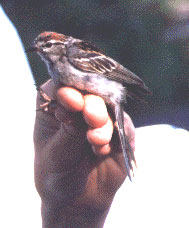
Spizella passerina
(Chipping Sparrow)
Order: Passeriformes
Order Description: Passerines
Family: Emberizidae
Family Description: Blackbirds, Orioles, & Sparrows
Physical Description:
5-5 3/4" (13-15 cm). Breeding adults have distinct chestnut brown cap, white eyebrow, black stripe through eye, gray cheek, and white throat. Winter adults and juveniles have duller streaked crown. All are gray below and reddish-brown back streaked with black.
Similar Species- Clay-colored Sparrow
Song:
A monotonous rattle.
Distribution:
Breeds from Alaska, Yukon, and British Columbia, east to Newfoundland, and south to northern Baja California, Nicaragua, and Gulf Coast. Winters from southwestern and central U.S., south to northern Nicaragua.
Habitat:
Found in open woodlands, woodland edges, edges of lakes and streams, grassy fields, parks, farmyards, and orchards. Preliminary results of Idaho-Montana study found species favored rotation-aged stands over old growth in Douglas-fir/ponderosa pine habitats.Diet:
Feeds on seeds (e.g., grasses, clover ragweed, and knotweed), spiders, and insects (e.g., weevils, beetles, caterpillars, and grasshoppers).
Ecology:
Builds cup-shaped nest in coniferous tree, in vines, or occasionally on ground. Forages primarily on ground; may also take food from foliage or shrubs.
Reproduction:
clutch size varies from 3-5 eggs, but is usually 4. Incubation lasts 11-14 days. Both parents tend young, which are altricial, and leave nest in 9-12 days. Female may produce 2 broods.
Conservation:
| Element Code: | ABPBX94020 |
| Status: | Protected nongame species |
| Global Rank: | G5 |
| State Rank: | S5,NTMB |
| National Rank: | N5B,N5N |
Important State References:
Hejl, S.J. and R.E. Woods. 1990. Bird assemblages in old-growth and rotation-aged Douglas-fir/Ponderosa pine stands in the northern Rocky Mountains: a preliminary assessment. Pp. 93-100 in D.M. Baumgartner and J.E. Lotan, eds., Proceedings of a Symposium on Interior Douglas-fir: the species and its management. Feb. 27, 1990, Spokane WA.
Photo by Jason Karl,© 2000
Design by Ean Harker©1999, 2000.
Written by Jason Karl, 2000.
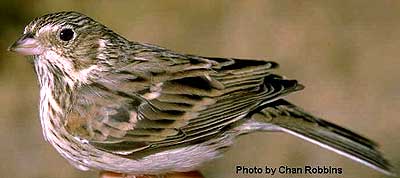
Pooecetes gramineus
(Vesper Sparrow)
Order: Passeriformes
Order Description: Passerines
Family: Emberizidae
Family Description: Blackbirds, Orioles, & Sparrows
Physical Description:
5-6 1/2" (13-17 cm). Rough, unkempt appearance due to the dark feathers that protrude from a light breast; also black and brown feathers that do not lay flat on back and wings. Streaked head with white eyering. "rufous shoulder patches and white outer tail feathers."
Similar Species- Pipits, immature Lark Sparrow, Chestnut-collared and McCown's longspurs, Smith's Longspur, Lapland Longspur, female Lark Bunting.
Song:
Song begins with 2-3 throating whistles followed by trilled notes and a rapid melody.
Distribution:
Breeds across portions of Canada, south to eastern and southern California, central Nevada, southwestern Utah, Arizona, central New Mexico, Colorado, Kansas, Minnesota, Tennessee, and North Carolina. Winters in central California, southwestern U.S., and portions of eastern U.S., south to southern Mexico, Gulf Coast and central Florida.
Habitat:
Found in shrub steppe, grasslands, savannas, weedy pastures, fields, sagebrush, arid scrub, and woodland clearings. Idaho study found species was more abundant in prescribed burn areas of juniper than in old growth or clearcut.Diet:
Feeds on seeds, waste grain, and insects.
Ecology:
Builds cup-shaped nest on ground in excavated depression. Forages on ground. May bathe in dirt. Female may engage in distraction displays. Species is one of 7 neotropical migrants thought to be declining in Idaho.
Reproduction:
Both sexes (usually female) incubate 3-5 eggs (sometimes 6) for 11-13 days. Young leave nest 7-12 days after hatching. Female may produce 2-3 broods/yr.
Conservation:
| Element Code: | ABPBX95010 |
| Status: | Protected nongame species |
| Global Rank: | G5 |
| State Rank: | S4,NTMB |
| National Rank: | N5B,N5N |
Important State References:
McCoy, M. 1993. Breeding bird survey of clearcut, prescribed burn, and seral/old growth stands of western juniper. USDI Bur. Land Manage., Boise District, Challenge Cost Share Project Report, Boise. 19pp.
Photo by C. S. Robbins. ©2002.
Design by Ean Harker©1999, 2000.
Written by Jason Karl, 2000.
Amphispiza bilineata
(Black-throated Sparrow)
Link to photo provided by USGS - Patuxent Wildlife Research Center: http://www.mbr-pwrc.usgs.gov/Infocenter/infocenter.html
Order: Passeriformes
Order Description: Passerines
Family: Emberizidae
Family Description: Blackbirds, Orioles, & Sparrows
Physical Description:
4 3/4-5 1/2" (12-14 cm). Black and white striped head: white eyebrow and whiskers; black throat, eyestripe, and crown. White eyering and black bill. Body grayish-brown, lighter below and darker on tail.
Similar Species- Sage Sparrow
Song:
Song: shi-twi-twit-cheree (last note trilled).
Distribution:
Breeds from northeastern California, southwestern Wyoming, northwestern Oklahoma, and north-central Texas, south to southern Baja California and north-central mainland of Mexico. Winters from U.S. deserts southward.
Habitat:
Found in desert scrub, thorn bush, mesquite and juniper. During migration and in winter, also found occasionally in grassy areas and weedy fields away from desert regions. In Idaho, prefers open shrub areas dominated by high sage, spiny hopsage, or horsebrush exceeding 50 cm in height.
Diet:
Feeds on seeds and insects. During some seasons, species may obtain daily water requirements from food source.
Ecology:
Builds cup-shaped nest in shrub or cactus; in Idaho, all located nests have been 25-45 cm above ground in big sagebrush plants. Individuals usually forage on ground, but may forage in air. In California study, population density of 7/40 ha was reported in desert scrub/creosote/burrobush habitat; in another study, density was 3.9/40 ha.
Reproduction:
clutch size varies from 3-4 eggs. Nestlings are altricial and downy.
Conservation:
| Element Code: | ABPBX97010 |
| Status: | Protected nongame species |
| Global Rank: | G5 |
| State Rank: | S2,NTMB |
| National Rank: | N5 |
Important State References:
Marks, J.S., J.H. Doremus, and A.R. Bammann. 1980. Black-throated Sparrows breeding in Idaho. Murrelet 61:112-113.
Design by Ean Harker©1999, 2000.
Written by Jason Karl, 2000.
Passerculus sandwichensis
(Savannah Sparrow)
Link to photo provided by USGS - Patuxent Wildlife Research Center: http://www.mbr-pwrc.usgs.gov/Infocenter/infocenter.html
Order: Passeriformes
Order Description: Passerines
Family: Emberizidae
Family Description: Blackbirds, Orioles, & Sparrows
Physical Description:
4 1/2-5 3/4" (11-15 cm). Typical adults sandy brown above with dusky streaks; pale central crown stripe bordered by dark stripes; double dark mustache streaks separated by whitish area (upper streak often joins dark ear spot and eyeline to form dark face triangle); eyebrow pale, usually yellowish from bill to eye; white below with dusky streaks on breast and sides; some birds have dark central breast spot. Short notched tail, pale pink legs.
Similar Species- Lincoln's, Song, Baird's, and Vesper Sparrows
Song:
Soft tsit-tsit-tsee-tsay, last note lower.
Distribution:
Breeds across portions of Alaska and Canada, south to Indiana and New Jersey, and south through western U.S. and Mexico (locally) to southwestern Guatemala. Winters from southern British Columbia, southern Nevada, Gulf states, and Massachusetts, south to northern Honduras.
Habitat:
Found in open areas, especially grasslands, tundra, meadows, bogs, farmlands, grassy areas with scattered bushes, and marshes.
Diet:
During summer, eats insects, spiders, and snails. Adults feed arthropods to young. Individuals feed on seeds at other times of year.
Ecology:
Builds cup-shaped nest on ground, frequently under covering vegetation. Infrequently nests in loose colonies. Forages on ground. May form small aggregations in winter.
Reproduction:
Both sexes, in turn, incubate 3-6 eggs (usually 4-5), for 12 days. Nestlings are altricial and downy. Young leave nest about 14 days after hatching.
Conservation:
| Element Code: | ABPBX99010 |
| Status: | Protected nongame species |
| Global Rank: | G5 |
| State Rank: | S5,NTMB |
| National Rank: | N5B,N5N |
Important State References:
No references are available at this time.
Design by Ean Harker©1999, 2000.
Written by Jason Karl, 2000.
Passerella iliaca
(Fox Sparrow)
Order: Passeriformes
Order Description: Passerines
Family: Emberizidae
Family Description: Blackbirds, Orioles, & Sparrows
Physical Description:
6-7 1/4" (15-18 cm). Gray above; white below specked with gray; chestnut tail.
Similar Species- Song Sparrow, Hermit Thrush
Song:
A combination of short, clear notes and sliding whistles.
Distribution:
Breeds across portions of Alaska and Canada, south to Colorado, Nevada, and southern California. Winters from British Columbia, New Mexico, and portions of Midwest, south to southern California, central Texas, portions of Gulf Coast, and southern Florida.
Habitat:
Found in dense thickets in coniferous or mixed forests, in chaparral, parks, and gardens, and in wooded bottomlands along rivers and creeks. Requires dense, brushy cover during nesting season. Idaho study conducted in cottonwood forests found Fox Sparrows avoided grazed areas and were more strongly associated with natural landscapes than agricultural ones.
Diet:
Eats seeds (e.g., smartweed, ragweed), berries (e.g., blueberries, elderberries), grapes, and other fruits. May eat invertebrates (e.g., beetles, spiders, millipedes, and craneflies).
Ecology:
Builds cup-shaped nest on ground or, rarely, in tree. Forages on ground.
Reproduction:
Female (mostly) incubates 3-5 eggs for 12-14 days; nestlings fledge at 9-11 days.
Conservation:
| Element Code: | ABPBXA2010 |
| Status: | Protected nongame species |
| Global Rank: | G5 |
| State Rank: | S5,NTMB |
| National Rank: | N5B,N5N |
Important State References:
Saab, V.A. 1996. Influences of spatial scale and land-use practices on habitat relationships of breeding birds in cottonwood riparian forests. Ph.D. Dissertation, Univ. Colorado, Boulder. 140pp.
Design by Ean Harker©1999, 2000.
Written by Jason Karl, 2000.
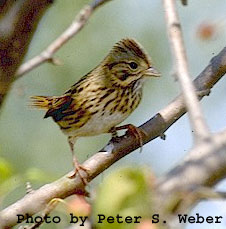
Melospiza lincolnii
(Lincoln's Sparrow)
Order: Passeriformes
Order Description: Passerines
Family: Emberizidae
Family Description: Blackbirds, Orioles, & Sparrows
Physical Description:
5-6" (13-15 cm). Resembles Song Sparrow, but more slender; tail shorter; face grayer; breast buff with much finer streaks. Eyebrow and sides of neck gray; cheek brownish with buff mustache; narrow eye-ring white.
Similar Species- Song Sparrow, immature Swamp Sparrow
Song:
Trilling that starts with low passages, rises abruptly, then drops.
Distribution:
Breeds across portions of Alaska and Canada, south to southwestern U.S., central Minnesota, and New England. Winters from southern U.S., south regularly to Honduras, and casually to central Panama.
Habitat:
Found in bogs, wet meadows, riparian thickets, shrubby forest edges, marshes, and brushy fields. Idaho study found Lincoln's Sparrows preferred wet, short-willow communities for breeding.
Diet:
Eats insects, seeds, and grain.
Ecology:
Forages on ground. Builds cup-shaped nest on ground. One study reported breeding territory of about 0.4 ha. Species possibly competes with Song Sparrow when breeding territories overlap.
Reproduction:
Female incubates 3-6 eggs (usually 4-5), for about 13 days. Young are tended by both parents, and leave nest at 10-12 days. Female may produce 2 broods/yr.
Conservation:
| Element Code: | ABPBXA3020 |
| Status: | Protected nongame species |
| Global Rank: | G5 |
| State Rank: | S5,NTMB |
| National Rank: | N5B,N5N |
Important State References:
Douglas, D.C., J.T. Ratti, R.A. Black, and J.R. Alldredge. 1992. Avian habitat associations in riparian zones of Idaho's Centennial Mountains. Wilson Bull. 104:485- 500.
Photos by Peter S. Weber,© 2000 and Jason Karl,© 2000
Design by Ean Harker©1999, 2000.
Written by Jason Karl, 2000.
Junco hyemalis
(Dark-eyed [Oregon] Junco)
Link to photo provided by USGS - Patuxent Wildlife Research Center: http://www.mbr-pwrc.usgs.gov/Infocenter/infocenter.html
Order: Passeriformes
Order Description: Passerines
Family: Emberizidae
Family Description: Blackbirds, Orioles, & Sparrows
Physical Description:
5-6 1/4" (13-16 cm). Has black hood and brownish-gray body. Female has lighter hood.
Similar Species- Yellow-eyed Junco
Song:
Loose, musical trill and a sharp tik.
Distribution:
Breeds across Alaska and portions of Canada, south to northern Baja California, central Arizona, western Texas, Appalachians to northern Georgia, and southern New England. Winters from southern Canada, south through U.S. to southern Florida, southern Texas, and northern Mexico.
Habitat
Found in coniferous and deciduous forests, forest edges, clearings, bogs, open woodlands, brushy areas adjacent to forests, and burned-over lands. During migration and in winter, found in variety of open woodlands, and in brushy and grassy habitats.
Diet:
Feeds on seeds throughout year. Also eats insects during breeding season, and waste grain in fall and winter.
Ecology:
Builds cup-shaped nest on ground, frequently against vertical surface. Occasionally builds in tree, shrub, or on building. Forages on ground, or takes insects in air. Forms small flocks in winter; may forage with other species (e.g., chickadees, sparrows). Species is 1 of 7 neotropical migrants thought to be declining in Idaho.
Reproduction:
clutch size varies from 3-5 eggs. Incubation lasts about 11-12 days.
Conservation:
| Element Code: | ABPBXA5020 |
| Status: | Protected nongame species |
| Global Rank: | G5 |
| State Rank: | S5,NTMB |
| National Rank: | N5 |
Important State References:
Douglas, D.C., J.T. Ratti, R.A. Black, and J.R. Alldredge. 1992. Avian habitat associations in riparian zones of Idaho's Centennial Mountains. Wilson Bull. 104:485- 500.
Design by Ean Harker©1999, 2000.
Written by Jason Karl, 2000.
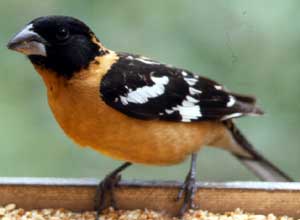
Pheucticus melanocephalus
(Black-headed Grosbeak)
Order: Passeriformes
Order Description: Passerines
Family: Cardinalidae
Family Description: Cardinals, Grosbeaks, & Buntings
Physical Description:
6 1/2-8 1/4" (17-22 cm). Black head and wings; head may have some white or rust; wings have white markings. Rust breast that extends around collar; pale belly; pale bill; black tail with white markings. Female is duller; fine black and buff stripes on head.
Similar Species- Rose-breasted Grosbeak
Song:
Robin-like song with addition of some whirring and spik sounds; much longer than American Robin.
Distribution:
Breeds from portions of western Canada, northeastern Montana, and northwestern North Dakota, south along Pacific Coast to northern Baja California, central and southeastern Arizona, and eastern New Mexico, east through portions of Midwest, and further south into mainland of Mexico. Winters in Mexico.
Habitat:
Found in deciduous forests and woodlands, pine/oak associations, oak scrub, pinyon/juniper woodlands, and deciduous thickets. Often found on edges of ponds, streams, or forests. Results of an Idaho study in cottonwood forest indicated grosbeaks were most strongly associated with willow subcanopies and avoided grazed areas.
Diet:
Feeds on insects, spiders, berries, seeds, and buds.
Ecology:
Builds cup-shaped nest in tree, or sometimes in shrub. Forages in crowns of deciduous trees, in shrubs, and on ground. Both male and female defend nesting territory against other breeding pairs. In New Mexico, jays are primary nest predators.
Reproduction:
Both sexes incubate 3- 4 eggs for 12-13 days. Nestlings are altricial and downy, are tended by both parents, and leave nest in 9-12 days.
Conservation:
| Element Code: | ABPBX61040 |
| Status: | Protected nongame species |
| Global Rank: | G5 |
| State Rank: | S5,NTMB |
| National Rank: | N5B |
Important State References:
Saab, V.A. 1996. Influence of spatial scale and land management on habitat use by breeding birds in cottonwood forests of southeastern Idaho. Ph.D. Dissertation, Univ. Colorado, Boulder. 140pp.
Photo by C. Trost,© 1999
Design by Ean Harker©1999, 2000.
Written by Jason Karl, 2000.
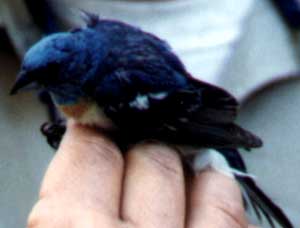
Passerina amoena
(Lazuli Bunting)
Order: Passeriformes
Order Description: Passerines
Family: Cardinalidae
Family Description: Cardinals, Grosbeaks, & Buntings
Physical Description:
5-5 1/2" (13-14 cm). Male has bright turquoise head and back; tail blackish; wings blackish with two white bars; breast rusty; belly white. Female is brown, paler below, dark tail, dark wings with buff bars; tinged blue on primaries, rump, and tail.
Similar Species- Male Western Bluebird, Indigo, Varied, and Painted buntings, female Blue Grosbeak.
Song:
Song consists of a number of short whistled notes followed by longer whistles: sweet-sweet chew-chew seet chew.
Distribution:
Breeds from southern British Columbia, east to southern Saskatchewan and sections of midwestern U.S., and south to southeastern California, northwestern Baja California, southern Nevada, southwestern Utah, central Arizona, northern New Mexico, and western Oklahoma. Winters from southern Arizona (scarce), south to portions of Mexico.
Habitat:
Found in arid, brushy areas in canyons, riparian thickets, chaparral and open woodlands. During migration and in winter, found in open, grassy and weedy areas. Results of Idaho study conducted in cottonwood forest found bunting most strongly associated with dense shrub layers, a willow subcanopy, and herbaceous ground cover; species also avoided grazed areas.
Diet:
Species feeds on insects (grasshoppers, caterpillars, beetles, ants, etc.), and seeds (wild oats, canary grass, needlegrass, etc.).
Ecology:
Nests in shrub. After breeding, may form flocks and move to higher elevations.
Reproduction:
Breeding begins late March in southern range, early June in north. Female incubates 3-5 eggs for 12 days. Nestlings are altricial and downy, are either tended by both parents or by female, and leave nest in 10-15 days.
Conservation:
| Element Code: | ABPBX64020 |
| Status: | Protected nongame species |
| Global Rank: | G5 |
| State Rank: | S5,NTMB |
| National Rank: | N5B |
Important State References:
Saab, V.A. 1996. Influence of spatial scale and land management on habitat use by breeding birds in cottonwood forests of southeastern Idaho. Ph.D. Dissertation, Univ. Colorado, Boulder. 140pp.
Original images provided by Jason Karl and C. Trost,© 2000
Design by Ean Harker©1999, 2000.
Written by Jason Karl, 2000.
Guiraca caerulea
(Blue Grosbeak)
Link to photo provided by USGS - Patuxent Wildlife Research Center: http://www.mbr-pwrc.usgs.gov/Infocenter/infocenter.html
Order: Passeriformes
Order Description: Passerines
Family: Cardinalidae
Family Description: Cardinals, Grosbeaks, & Buntings
Physical Description:
6-7 1/2" (15-19 cm). Brilliant blue with small black mask, and two dark rusty wing bars. Female is cinnamon brown with gray wings and pale blue rump.
Similar Species- Indigo Bunting, Brown- headed Cowbird
Song:
A finch-like warble, only with shorter notes. Call is a thin tchink.
Distribution:
Breeds from central California, southern Nevada, Utah, southern Colorado, the Dakotas, and portions of the midwest and mid-Atlantic states, south to northern Baja California, southern Arizona, Costa Rica, Gulf coast, and central Florida. Winters from southern Baja and northern Mexico, south to Panama and portions of South America.
Habitat:
Found in partly-open situations with scattered trees, and in riparian woodlands, scrub, thickets, cultivated lands, woodland edges, overgrown fields, and hedgerows. In Idaho, nests in hayfields or chickory, Russian olive, willow, and wild rose thickets next to sagebrush foothills.
Diet:
In general, eats mostly insects, but will also consume snails, spiders, seeds, grains, and wild fruits.
Ecology:
Nests in shrub, or sometimes in tree. Forms flocks prior to migration. Forages on ground and in shrubs and trees. Obtains grit from roadsides or streams. Species is a rare breeder in Idaho.
Reproduction:
Female incubates 2-5 eggs (usually 4) in northern range, for 11-12 days. Young are tended by both parents, and leave nest at 9-13 days. Female may produce 2 broods in southern range; male feeds fledged young if female re-nests.
Conservation:
| Element Code: | ABPBX63010 |
| Status: | Protected nongame species |
| Global Rank: | G5 |
| State Rank: | S1,NTMB |
| National Rank: | N5B,NZN |
Important State References:
Rich, T. 1981. Second breeding locale for the blue grosbeak in Idaho. Murrelet 62:91-92.
Design by Ean Harker©1999, 2000.
Written by Jason Karl, 2000.
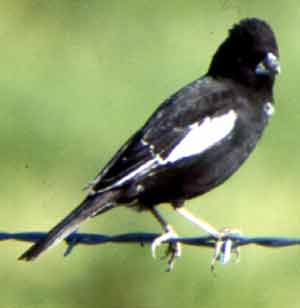
Calamospiza melanocorys
(Lark Bunting)
Order: Passeriformes
Order Description: Passerines
Family: Cardinalidae
Family Description: Cardinals, Grosbeaks, & Buntings
Physical Description:
Length 7". Breeding male black with white patches on the inner wings and under tips of the tail. Female is streaked grayish-brown witha buffy wing patch. Winter males look like females with whiter wing patches.
Similar species- Female resembles a Cassin's Finch, but wrong habitat.
Song:
Call is a soft "hooo-ee", and song is a series of high whistles and trills given from a perch or while hovering in a song flight
Distribution:
Great Plains from southern Canada to New Mexico and the Texas panhandle. It has recently invaded eastern Idaho from over the Continental Divide and now nests as far west as Minidoka NWR, with colonies on the Arco desert and near Dubois, as well as lower Curlew Valley.
Habitat:
Found in sagebrush communities and the edges of agricultural fields.
Diet:
Insects and other invertebrates in the summer, seeds in the fall and winter.
Ecology:
Gregarious for most of the year, except when breeding, then colonial but territorial. Nest is a cup shaped structure on the ground.
Reproduction:
Monogamous, but later females are polygynous. Lays 4-5 eggs, which are incubated by female (male?) for 11-12 days. Young altricial and fed by both male and female for 8-9 days when they fledge.
Conservation:
| Element Code: | - |
| Status: | Protected nongame species |
| Global Rank: | G? |
| State Rank: | S? |
| National Rank: | - |
Important State References:
No references are available at this time.
Information and photo by C. Trost,© 2000
Design by Ean Harker© 2000.
DAI layout by Mike Legler. 2000.
Dolichonyx oryzivorus
(Bobolink)
Link to photo provided by USGS - Patuxent Wildlife Research Center: http://www.mbr-pwrc.usgs.gov/Infocenter/infocenter.html
Order: Passeriformes
Order Description: Passerines
Family: Icteridae
Family Description: Blackbirds, Orioles, & Meadowlarks
Physical Description:
6-8" (15-20 cm). Adult male black except for buffy yellow hindneck, white rump, and white scapulars. Females, non-breeding males, and immatures are buff-yellow overall with dark streaks on back; also dark crown stripes and line behind eye.
Similar Species- Female Red-winged Blackbird, Savannah Sparrow, male Lark Bunting
Song:
Song starts with low reedy notes and rolls upward. Some can hear the bird's own name in the song: bob-o-LINK.
Distribution:
Breeds from southern British Columbia, east across southern Canada to Nova Scotia, south to Oregon, Utah, portions of Midwest and New Jersey, and locally to Tennessee and North Carolina. Winters in central and southern South America.
Habitat:
Found in tall-grass areas, flooded meadows, prairies, deep cultivated grains, and hayfields. During migration and in winter, also found in rice fields, marshes, and open, woody areas. Nests locally in wheat fields in Idaho.
Diet:
Eats mainly seeds, but will also eat insects and grain.
Ecology:
Builds cup-shaped nest on ground. Forages on ground, or may take insects from foliage. When not breeding, often found in large flocks.
Reproduction:
Female incubates 4-7 eggs (usually 5-6), for 11-13 days. Young are tended by both parents, and leave nest at 10-14 days (before they are able to fly). In some areas, females may produce second, unsuccessful clutch after first brood fledges.
Conservation:
| Element Code: | ABPBXA9010 |
| Status: | Protected nongame species |
| Global Rank: | G5 |
| State Rank: | S4,NTMB |
| National Rank: | N5B |
Important State References:
No references are available at this time.
Design by Ean Harker©1999, 2000.
Written by Jason Karl, 2000.
Sturnella neglecta
(Western Meadowlark)
Link to photo provided by USGS - Patuxent Wildlife Research Center: http://www.mbr-pwrc.usgs.gov/Infocenter/infocenter.html
Order: Passeriformes
Order Description: Passerines
Family: Icteridae
Family Description: Blackbirds, Orioles, & Meadowlarks
Physical Description:
8 1/2-11" (22-28 cm). Adults have long, pointed bill; head striped with black and white; cheek yellow; throat and underparts mostly bright yellow with striking black V on breast.
Similar Species- Eastern Meadowlark
Song:
Distinct, 7-10 note flute-like song that ends with approximately 3 descending notes.
Distribution:
Breeds from central British Columbia and central Alberta, east to southern Ontario, northern Michigan, and northwestern Ohio, and south to Baja California, central mainland of Mexico, central Texas and Louisiana. Winters from south- central Canada to central Mexico, and east to Gulf Coast and Florida.
Habitat:
Found in grasslands, shrub steppe, savannas, and cultivated fields and pastures. Summers in grasslands and valleys, but may also be found in foothills and open mountain areas (up to 2500 m in California). A study conducted in southwestern Idaho determined that landscape-level features did not influence the distribution of meadowlarks.
Diet:
Approximately 65- 70% of diet consists of small invertebrates such as beetles, cutworms, caterpillars, grasshoppers, spiders, sow bugs, and snails. Will also eat some grains and seeds.
Ecology:
Builds cup-shaped nest on ground. Forages on ground. One study estimated home range size at 4-13 ha. found in flocks of 10-75 birds in winter. Predators include hawks, crows, skunks, weasels, raccoons, and coyotes.
Reproduction:
In Manitoba, nests are initiated in late April or June (mainly in first half of May). Female incubates 3-7 eggs (usually 5), for 13-15 days. Nestlings are tended by both parents, leave nest in about 12 days, and are fed by parents for 2 additional weeks.
Conservation:
| Element Code: | ABPBXB2030 |
| Status: | Protected nongame species |
| Global Rank: | G5 |
| State Rank: | S5,NTMB |
| National Rank: | N5 |
Important State References:
Knick, S.T. and J.T. Rotenberry. 1995. Landscape characterization of fragmented shrubsteppe habitats in breeding passerines. Conser. Biology 9:1059-1071.
Design by Ean Harker©1999, 2000.
Written by Jason Karl, 2000.
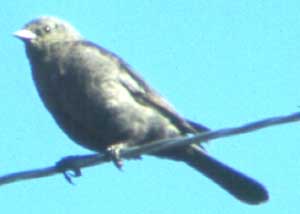
Euphagus cyanocephalus
(Brewer's Blackbird)
Order: Passeriformes
Order Description: Passerines
Family: Icteridae
Family Description: Blackbirds, Orioles, & Meadowlarks
Physical Description:
8-10" (20-25 cm). Male is shiny black all over with yellow eyes. Female has a pale brown head and chest; gray wings, back, and tail; and black eyes.
Similar Species- Rusty Blackbird, Grackles
Song:
A high pitched, descending note followed by a chuck.
Distribution:
Breeds from central interior British Columbia, east to western Great Lakes area, and south to northwestern Baja California, southern Nevada, western and northern Texas, and northern Indiana. Winters from southern British Columbia, and central Alberta, eastern Montana, Kansas, Arizona, and western South Carolina, south to portions of Mexico, southern Texas, Gulf Coast, and southern Florida.
Habitat:
Found in shrubby and bushy areas (especially near water), in riparian woodlands, aspen parklands, cultivated lands, marshes, and around human habitation. During migration and in winter, also found in pastures and fields. Idaho study conducted in riparian habitat found Brewer's Blackbirds favored grazed over ungrazed areas.
Diet:
Feeds on insects, seeds, waste grain, and fruits.
Ecology:
Builds nest in tree (usually coniferous), or sometimes in shrub or on ground. Nests in loose colonies (3-20 pairs). Forages on ground, or takes food from foliage or in air. Sometimes follows plows to eat uncovered insects. Often seen in large flocks; may forage with other blackbirds.
Reproduction:
clutch size varies from 3-7 eggs, but is usually 5-6. Incubation lasts 12-14 days. Young are tended by both adults, and fly 13-14 days after hatching. Female may produce 2 broods. Males may be polygynous.
Conservation:
| Element Code: | ABPBXB5020 |
| Status: | Protected nongame species |
| Global Rank: | G5 |
| State Rank: | S5,NTMB |
| National Rank: | N5B,N5N |
Important State References:
Medin, D.E. and W.P. Clary. 1990. Bird and small mammal populations in a grazed and ungrazed riparian habitat in Idaho. USDA Forest Service Inter. Res. Sta. Res. Paper INT-245. 8pp.
Photo by C. Trost,© 1999
Design by Ean Harker©1999, 2000.
Written by Jason Karl, 2000.
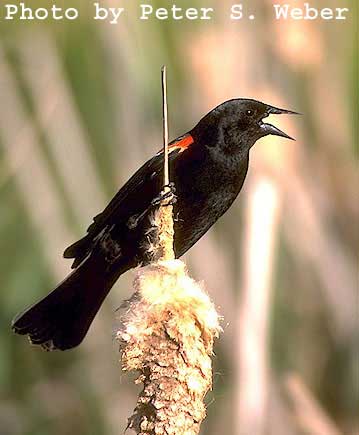
Agelaius phoeniceus
(Red-winged Blackbird)
Order: Passeriformes
Order Description: Passerines
Family: Icteridae
Family Description: Blackbirds, Orioles, & Meadowlarks
Physical Description:
7-9 1/2" (18-24 cm). Males are black except for red wing patches. Females are mottled brown, black, and white with a white eyebrow.
Similar Species- Tricolored Blackbird, female Bobolink, juvenile Brown-headed Cowbird
Song:
Song is a two-note cher-leeee. Calls a simple chuck.
Distribution:
Breeds across portions of Canada, south to Baja California and Costa Rica. Winters over much of U.S., especially in southern portions.
Habitat:
Found in freshwater and brackish marshes, in bushes and small trees along watercourses, and in upland cultivated fields. During migration and in winter, also found in open, cultivated lands, plowed fields, pastures, and prairies. Idaho study found Red-winged Blackbirds avoided grazed riparian areas.
Diet:
Eats mayflies, moths, beetles, caterpillars, grubs, mollusks, other invertebrates, and some fruits. Approximately 73% of diet is vegetable matter, and 27% is animal matter.
Ecology:
Builds cup-shaped nest in reeds, over or near water. Nests in loose groups; some territorial males have harems of up to 15 females. One study reported density of territorial males averaged 0.2-0.7/ha in favorable habitat. gregarious; travels in large flocks, except during breeding season. May travel in mixed flocks with cowbirds and grackles. Forages on ground, or takes food from foliage or air. Species may be most abundant landbird in North America.
Reproduction:
Female incubates 3-5 eggs (usually 4) in northern range, for 11-12 days. Nestlings are tended by both parents or, in some areas, by female only; young are able to leave nest in about 10 days.
Conservation:
| Element Code: | ABPBXB0010 |
| Status: | Protected nongame species |
| Global Rank: | G5 |
| State Rank: | S5,NTMB |
| National Rank: | N5 |
Important State References:
Medin, D.E. and W.P. Clary. 1990. Bird and small mammal populations in a grazed and ungrazed riparian habitat in Idaho. USDA Forest Service Inter. Res. Sta. Res. Paper INT-245. 8pp.
Photo by Peter S. Weber,© 2000
Design by Ean Harker©1999, 2000.
Written by Jason Karl, 2000.
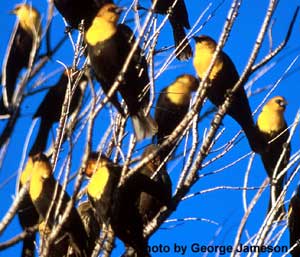
Xanthocephalus xanthocephalus
(Yellow-headed Blackbird)
Order: Passeriformes
Order Description: Passerines
Family: Icteridae
Family Description: Blackbirds, Orioles, & Meadowlarks
Physical Description:
8-11" (20-28 cm). Yellow extends from top of head down to nape and breast; washed with read around black encircled eyes. Remainder of body is black. Female is brown with wash of yellow on breast and behind eye.
Similar Species- Male Bobolink, Horned Lark
Song:
Song a loud, raspy note following two softer whistles. Call a low chuck.
Distribution:
Breeds from central-interior British Columbia, east to extreme western Ontario and northwestern Ohio, and south to southern California, northeastern Baja California, New Mexico, northern Texas, northern Missouri, and northwestern Ohio. Winters from central California, central Arizona, southern New Mexico, and Texas, south to portions of Mexico, and casually to Costa Rica.
Habitat:
Found in freshwater marshes of cattail, tule, or bulrushes. During migration and in winter, also found in open cultivated lands, pastures, and fields.
Diet:
Feeds on insects, seeds, and grain.
Ecology:
Builds cup-shaped nest in reeds over water. Searches for food while walking along ground or perched on seed- bearing plant; also forages in fields and on muddy ground near water. gregarious; often found with much larger flocks of Red-winged Blackbirds in winter. Territorial; may exclude Marsh Wrens from breeding areas (Marsh Wrens may disrupt some nesting attempts).
Reproduction:
Female incubates 3-5 eggs for 12-13 days. Young leave nest 9-12 days after hatching, but are unable to fly until about 21 days.
Conservation:
| Element Code: | ABPBXB3010 |
| Status: | Protected nongame species |
| Global Rank: | G5 |
| State Rank: | S5,NTMB |
| National Rank: | N5B,N5N |
Important State References:
No references are available at this time.
Photo by George Jameson, ©2002.
Design by Ean Harker©1999, 2000.
Written by Jason Karl, 2000.
Molothrus ater
(Brown-headed Cowbird)
Link to photo provided by USGS - Patuxent Wildlife Research Center: http://www.mbr-pwrc.usgs.gov/Infocenter/infocenter.html
Order: Passeriformes
Order Description: Passerines
Family: Icteridae
Family Description: Blackbirds, Orioles, & Meadowlarks
Physical Description:
6-8" (15-20 cm). Male has coffee-brown head and metallic black body. Female is dark brown all over.
Similar Species- Bronzed Cowbird
Song:
Calls sound like they are coming from underwater: glug-glug-glee; also a single, high-pitched note and a rattle.
Distribution:
Breeds from northern British Columbia, east across portions of Canada, and south to central Mexico, southern Texas, Gulf Coast, and southern Florida. Winters from northern California, southern New Mexico, Kansas, Great Lakes region, New England, and Nova Scotia, south to southern Baja California, southern Mexico, Gulf Coast, and southern Florida.
Habitat:
Found in woodlands, forests (primarily deciduous), forest edges, city parks, suburban gardens, farms, and ranches. During migration and in winter, also found in open situations, cultivated lands, fields, pastures, and scrub. In Idaho, alteration of sagebrush lands through grazing or agriculture has provided mechanism for cowbirds to parasitize shrub-steppe birds.
Diet:
Eats mostly insects, but will also eat grain, seeds, and some fruits.
Ecology:
Lays eggs in nests built by other species (I.e., nest parasitism). Forages on ground. Female defends a territory, male does not. gregarious. Forms flocks in fall and winter, sometimes with other species.
Reproduction:
Adult female usually removes eggs of host. Host incubates cowbird eggs for 10-12 days (female cowbird probably produces 8-40 eggs/season). Young leave nest at 10-11 days, are fed by host, and become independent at 25-39 days.
Conservation:
| Element Code: | ABPBXB7030 |
| Status: | Protected nongame species |
| Global Rank: | G5 |
| State Rank: | S5,NTMB |
| National Rank: | N5 |
Important State References:
Rich, T.D. 1978. Cowbird parasitism of Sage and Brewer's Sparrows. Condor 80:348.
Design by Ean Harker©1999, 2000.
Written by Jason Karl, 2000.
Quiscalus quiscula
(Common Grackle)
Link to photo provided by USGS - Patuxent Wildlife Research Center: http://www.mbr-pwrc.usgs.gov/Infocenter/infocenter.html
Order: Passeriformes
Order Description: Passerines
Family: Icteridae
Family Description: Blackbirds, Orioles, & Meadowlarks
Physical Description:
11-13 1/2" (28-34 cm). Black head, tail and underparts; back, wings, and flanks are Iridescent. Have yellow eyes and long tail.
Similar Species- Great-tailed Grackle, Brewer's Blackbird
Song:
Hoarse, creaking call like a rusty hinge.
Distribution:
Breeds from northeastern British Columbia, east across portions of Canada, south to southern Texas, Gulf Coast, and southern Florida, and west to Wyoming, Colorado, and New Mexico. Winters from Kansas, southern Great Lakes region, New England and Nova Scotia, south to southeastern New Mexico, southern Texas, Gulf Coast, and Florida. Breeder in urban areas of southeastern Idaho; invaded Idaho successfully as a nester in 1970's.
Habitat:
Found in partly-open situations with scattered trees, open woodlands, forest edges, marsh edges, islands, swamp thickets, coniferous groves, riparian woodlands, cities, suburbs, and farms. During migration and in winter, also found in open situations, cultivated lands, and fields. In Idaho, has adapted to forested urban environments.
Diet:
Eats various invertebrates, grain, seeds, fruits, sometimes small vertebrates, and birds' eggs.
Ecology:
Builds cup-shaped nest, frequently in tree, but sometimes in shrub or human-built structure. Nests usually in loose colonies. Forages on ground, in shrubs and trees, and in shallow water. roosts communially in large flocks (sometimes greater than 100,000 individuals) in summer and fall in northeastern U.S.; often roosts with starlings.
Reproduction
Female incubates 4-7 eggs (commonly 5-6), for 12-14 days. Young are tended by both sexes, leave nest at 10- 17 days, and remain in nest vicinity for 2-3 days. Female may produce 2 broods/yr.
Conservation:
| Element Code: | ABPBXB6070 |
| Status: | Protected nongame species |
| Global Rank: | G5 |
| State Rank: | S2,NTMB |
| National Rank: | N5 |
Important State References:
Taylor, D.M. and C.H. Trost. 1985. The Common Grackle in Idaho. Am. Birds 39:217-218.
Design by Ean Harker©1999, 2000.
Written by Jason Karl, 2000.
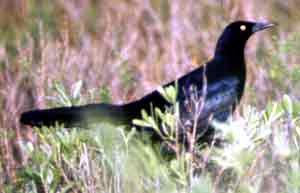
Quiscalus mexicanus
(Great-tailed Grackle)
Order: Passeriformes
Order Description: Passerines
Family: Icteridae
Family Description: Blackbirds, Orioles, & Meadowlarks
Physical Description:
Length 15-18". Male Iridescent blue-black with a long keeled tail and a yellow eye. Female brown backed with a buffy chest and breast.
Similar species- Common Grackle is smalller, Brewer's Blackbird has shorter tail.
Song:
A series of loud clacks and whistles, raucous.
Distribution:
Texas, New Mexico, Arizona, and rapidly expanding into Nevada, southern Oregon, and southern Idaho. Irrigated agriculture has allowed the expansion of the species throughout the West.
Habitat:
Marshes and riparian zones near rivers, as well as open farmlands with scattered groves of trees, and around human habitation.
Diet:
Insects, fruit, grain, and seeds, as well as lizards, bird eggs, and ectoparasites off domestic stock.
Ecology:
Nest in colonies, where they displace native species either directly or by eating their eggs and young. Frequently feed around livestock, where they are loud and vocal birds.
Reproduction:
Promiscuous. Female builds a cup nest in reeds or brush where she lays 3-5 eggs. They are incubated by the female only for 13-14 days, and young are fed by the female for anouther 20-23 days. Nested in Marshing area along the Snake River, probably near Lake Lowell, and near Burley.
Conservation:
| Element Code: | - |
| Status: | Protected nongame species |
| Global Rank: | G? |
| State Rank: | S? |
| National Rank: | - |
Important State References:
No references are available at this time.
Information and photo by C. Trost,© 2000
Photo by Marcus Martin, ©1999.
Design by Ean Harker© 2000.
DAI layout by Mike Legler. 2000.

Icterus bullockii
(Bullock's Oriole)
Order: Passeriformes
Order Description: Passerines
Family: Icteridae
Family Description: Blackbirds, Orioles, & Meadowlarks
Physical Description:
7-8 1/2" (18-22 cm). Adult male has bright orange eyebrow, cheek, underparts, and rump; black crown, eyestripe, upper back, chin, and tail. Wings are black and white. Female is lighter gray and paler orange with a pale orange tail.
Similar Species- Hooded Oriole
Song:
Sweetly whistled whetew-whetew-whetew-whetew.
Distribution:
Breeds from southern Canada and all of U.S. (except extreme southeastern portions), to northern Mexico. Winters in central U.S., and south to northern South America.
Habitat:
Found in open or riparian woodlands, deciduous forest edges, partly-open situations with scattered trees, orchards, and shade trees. During migration and in winter, also found in humid forest edges, second growth, and scrub. An Idaho study conducted in cottonwood forests showed Bullock's Orioles prefer habitat edges adjacent to agricultural landscapes.
Diet:
Eats insects, especially caterpillars; also eats various fruits and nectar.
Ecology:
Builds hanging nest in tree (usually deciduous). When not breeding, usually forms groups of 2-5 individuals (rarely up to 15); each group has definite home range. Sometimes forms large communal roosts. Gleans food from trees and shrubs; also takes food in air.
Reproduction:
Female incubates 3-6 eggs (commonly 4-5), for 12-14 days. Young are tended by both parents, and leave nest at 12-14 days.
Conservation:
| Element Code: | ABPBXB9220 |
| Status: | Protected nongame species |
| Global Rank: | G5 |
| State Rank: | S5,NTMB |
| National Rank: | N5B,NZN |
Important State References:
Saab, V.A. 1996. Influences of spatial scale and land-use practices on habitat relationships of breeding birds in cottonwood riparian forests. Ph.D. Dissertation, Univ. Colorado, Boulder. 140pp.
Photo by C. S. Robbins. ©2002 and C. Trost,© 1999
Design by Ean Harker©1999, 2000.
Written by Jason Karl, 2000.
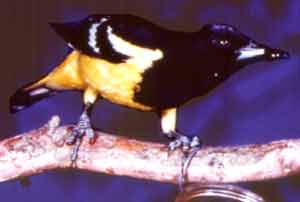
Icterus parisorum
(Scott's Oriole)
Order: Passeriformes
Order Description: Passerines
Family: Icteridae
Family Description: Blackbirds, Orioles, & Meadowlarks
Physical Description:
Length 9". Adult male with a black hood that extends to the back and breast. rump, shoulders and belly brilliant lemon yellow. Adult female is yellowish-olive with streaks above, and dull greenish yellow below.
Similar Species- Orchard Oriole, female Bullock's Oriole
Song:
A loud rapid burst or whistles, resembling a Western Meadolark's.
Distribution:
Breeder in western Texas, New Mexico, Arizona, Utah, and Nevada. Winters in Mexico. Invaded Idaho in the pinyon-juniper zone along the southern border.
Habitat:
Juniper woodlands and other semi-arid habitats.
Diet:
Insects and other invertebrates, fruit and nectar.
Ecology:
A territorial species of the arid southwest. It nests in junipers, scrub, riparian woodlands and palm groves. The nest is a woven stick and grass cup, but not as pendulous as in other orioles.
Reproduction:
Monogamous, 2-4 eggs incubated by the female for 12-14 days. altricial young fledge after another 14 days, and are cared for by both the male and female.
Conservation:
| Element Code: | - |
| Status: | Protected nongame species |
| Global Rank: | G? |
| State Rank: | S? |
| National Rank: | - |
Important State References:
No references are available at this time.
Information and photo by C. Trost,© 2000
Design by Ean Harker© 2000.
DAI layout by Mike Legler. 2000.
Leucosticte tephrocotis
(Gray-crowned Rosy Finch)
Order: Passeriformes
Order Description: Passerines
Family: Fringillidae
Family Description: Finches, Crossbills, and Grosbeaks
Link to photo provided by USGS - Patuxent Wildlife Research Center: http://www.mbr-pwrc.usgs.gov/Infocenter/infocenter.html
Physical Description:
5 3/4-6 3/4" (15-17 cm). Has brown body, pink on flanks, blackish forehead, and gray patch extending behind eye and over crown. Female is less colorful.
Similar Species- Other finches
Song:
A brusk tchew-tchew-tchew-tchew; also a chattering call.
Distribution:
Breeds from Alaska, portions of western Canada, and northwestern Montana, south through mountains to east-central California, Utah, and northern New Mexico. Winters from southern Alaska and portions of southwestern Canada, south to eastern California, southern Nevada, northern New Mexico, and northeastern Nebraska.
Habitat:
Found in barren, rocky, or grassy areas and cliffs, among glaciers or beyond timberline. During migration and in winter, also found in open situations, fields, cultivated lands, brushy areas, and aroung human habitation. One of only 2 species in Idaho that nests exclusively in alpine habitats. Gray-crowned Rosy Finch is suspected but unconfirmed as a nesting species in these habitats in Idaho.
Diet:
Eats seeds and insects.
Ecology:
Builds cup-shaped nest on ground, cliff, or human-built structure. Males typically outnumber females in breeding and wintering populations. During breeding season, male defends "territory" around female wherever she moves. When not breeding, individuals form large flocks of up to 1000+ birds. Species forages on ground, gleans insects from vegetation, or may take insects from air.
Reproduction:
Female incubates 4-5 eggs for 12-14 days. Young are tended by both adults, and leave nest at about 20 days. In Aleutians, eggs are laid in late April-July, clutch size is 3-6 eggs, fledging occurs at 15- 22 days, and female produces 2 broods/yr.
Conservation:
| Element Code: | ABPBY02030 |
| Status: | Protected nongame species |
| Global Rank: | G5 |
| State Rank: | S4 |
| National Rank: | N5 |
Important State References:
No references are available at this time.
Design by Ean Harker ©1999, 2000.
Written by Jason Karl, 2000.
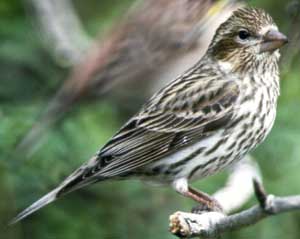
Carpodacus cassinii
(Cassin's Finch)
Order: Passeriformes
Order Description: Passerines
Family: Fringillidae
Family Description: Finches, Crossbills, and Grosbeaks
Physical Description:
6-6 1/2" (15-17 cm). Red head and red and brown streaked back and wings. Light buff below with no streaking. Females are gray-brown above with white streaking and white below with gray-brown streaking.
Similar Species- Purple Finch, House Finch
Song:
Warbling song ending in a 2-3 note ascending scale. Calls a tcher-werp.
Distribution:
Breeds from southern interior British Columbia, extreme southwestern Alberta, Montana, and northern Wyoming, south to portions of California, southern Nevada, northern Arizona and northern New Mexico. Winters mainly from southern British Columbia, northwestern Montana, and eastern Wyoming, south to northern Baja California, southern Arizona, and central Mexico.
Habitat:
Found in open, montane coniferous forests at higher elevations. During migration and in winter, also found in deciduous woodlands, second growth, scrub, brushy areas, partly-open situations with scattered trees, and occasionally in suburbs near mountains. Idaho study found Cassin's Finches responded positively in number to diameter-cut logging.
Diet:
Eats seeds and buds of plants, insects, and berries.
Ecology:
Forages on ground, or takes food from foliage. Builds cup-shaped nest in tree, frequently near end of large limb. Male defends zone around female during breeding period; female is more attached to particular site than is male. Individuals are usually seen in flocks, except during nesting season. Often seen in association with crossbills and Evening Grosbeaks.
Reproduction:
Female incubates 3-6 eggs (usually 4-5), for about 12-14 days. Young are tended by both adults, and first breed as yearlings in some areas, and at 2 yr in other areas.
Conservation:
| Element Code: | ABPBY04030 |
| Status: | Protected nongame species |
| Global Rank: | G5 |
| State Rank: | S5,NTMB |
| National Rank: | N5 |
Important State References:
Medin, D.E. 1985. Breeding bird responses to diameter-cut logging in west-central Idaho. USDA Forest Service Inter. Res. Sta. Res. Paper INT-355, Boise. 12pp.
Photo byC. Trost,© 1998-9
Design by Ean Harker©1999, 2000.
Written by Jason Karl, 2000.
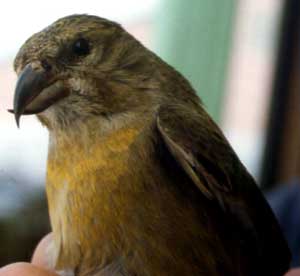
Loxia curvirostra
(Red Crossbill)
Order: Passeriformes
Order Description: Passerines
Family: Fringillidae
Family Description: Finches, Crossbills, and Grosbeaks
Physical Description:
5 1/4-6 1/2" (13-17 cm). Rusty red with white flecks; dark wings and tail. Have crossed mandibles as indicated by name. Females are grayish with dull yellow rump and underparts. Immatures duller and streaked.
Similar Species- Pine Siskin, White-winged Crossbill
Song:
Soft, whistled kip or jip-jip-jip-jip-jip.
Distribution:
Resident from southeastern Alaska, east to Newfoundland, and south in western U.S. to northern Baja California and Nicaragua (south in eastern U.S. to northern Wisconsin, Tennessee, and North Carolina).
Habitat:
Found in coniferous and mixed coniferous/deciduous forests, pine savannas, and pine/oak habitat. During migration and in winter, found in deciduous forests, and in more open, scrubby areas. Preliminary results of Idaho-Montana study found species favoring rotation-aged Douglas- fir stands over old-growth.
Diet:
Eats seeds (e.g., pine, fir, spruce, hemlock, larch, birch, alder, elm), buds, and insects.
Ecology:
Builds cup-shaped nest in tree. Takes food from foliage, or forages on ground. May feed with other species. Does not maintain feeding territory. Forms flocks when not breeding.
Reproduction:
Breeding season varies, depending in part on food supply. Female incubates 3-4 eggs, sometimes 5, for about 12-14 days (in Rockies, female may breed in year hatched, and may produce 2 broods). Young leave nest about 17 days after hatching.
Conservation:
| Element Code: | ABPBY05010 |
| Status: | Protected nongame species |
| Global Rank: | G5 |
| State Rank: | S5 |
| National Rank: | N5 |
Important State References:
Hejl, S.J. and R.E. Woods. 1990. Bird assemblages in old-growth and rotation-aged Douglas-fir/Ponderosa pine stands in the northern Rocky Mountains: a preliminary assessment. Pp. 93-100 in D.M. Baumgartner and J.E. Lotan, eds., Proceedings of a Symposium on Interior Douglas-fir: the species and its management. Feb. 27, 1990, Spokane WA.
Photo by C. Trost,© 2000
Design by Ean Harker©1999, 2000.
Written by Jason Karl, 2000.
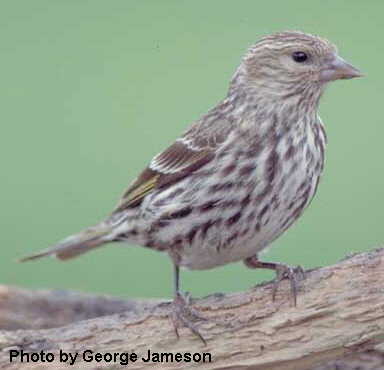
Carduelis pinus
(Pine Siskin)
Order: Passeriformes
Order Description: Passerines
Family: Fringillidae
Family Description: Finches, Crossbills, and Grosbeaks
Physical Description:
4 1/2-5 1/4" (11-13 cm). A small, streaked finch with sharp, pointed bill. Grayish-brown above, buffy below.
Similar Species- Immature Red Crossbill, juvenile Common Redpoll, female Purple Finch, House Finch.
Song:
Call an ascending, buzzy terrreeeeee. Song: te te tree te te tree tree te te.
Distribution:
Breeds from portions of Alaska and Canada, south to northern Baja California, central highlands of Mexico, Kansas, Pennsylvania, and southern New Jersey. Winters from breeding range, south to Gulf Coast and northern Florida.
Habitat:
Found in forests and woodlands, parks, gardens, and yards in suburban areas. During migration and in winter, found in variety of woodland and forest habitats, in partly-open situations with scattered trees, and in open fields, pastures, and savannas. Preliminary results of Idaho-Montana study suggest species prefers old-growth stands over rotation-aged stands in Douglas- fir/ponderosa pine forests.
Diet:
Eats seeds (e.g., alder, birch, pine, maple, thistle) and insects.
Ecology:
Bulds saucer-shaped nest in tree. May form loose colonies when nesting. Takes food from foliage, or forages on ground. gregarious. In fall and winter, travels in flocks of typically 50-200 individuals; occasionally, a few siskins will travel in flocks with goldfinches and redpolls.
Reproduction:
Female incubates 3-4 eggs (sometimes 5), for 13 days. Nestlings are altricial and downy. Both parents tend young, which leave nest 15 days after hatching. Female sometimes produces 2 broods/yr.
Conservation:
| Element Code: | ABPBY06030 |
| Status: | Protected nongame species |
| Global Rank: | G5 |
| State Rank: | S5,NTMB |
| National Rank: | N5 |
Important State References:
Hejl, S.J. and R.E. Woods. 1990. Bird assemblages in old-growth and rotation-aged Douglas-fir/Ponderosa pine stands in the northern Rocky Mountains: a preliminary assessment. Pp. 93-100 in D.M. Baumgartner and J.E. Lotan, eds., Proceedings of a Symposium on Interior Douglas-fir: the species and its management. Feb. 27, 1990, Spokane WA.
Photo by George Jameson, ©2002.
Design by Ean Harker©1999, 2000.
Written by Jason Karl, 2000.
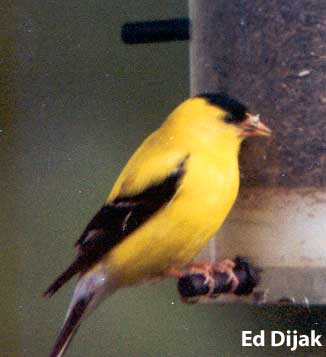
Carduelis tristis
(American Goldfinch)
Order: Passeriformes
Order Description: Passerines
Family: Fringillidae
Family Description: Finches, Crossbills, and Grosbeaks
Physical Description:
4 1/2-5 1/2" (11-14 cm). Yellowy-gold with black forehead, wings, and tail. Wings have two narrow white bars; tail has white edges. Females and immatures duller and no black on head.
Similar Species- Female Lawrence's Goldfinch, immature Indigo Bunting, Lesser Goldfinch.
Song:
A prolonged jumble of short trills and thin twittering notes.
Distribution:
Breeds across southern Canada, south to southwestern California, northern Baja California, eastern Oregon, central Nevada, extreme northeastern Texas, central Georgia, and South Carolina. Winters from southern Canada and northern U.S., south to northern Mexico, Gulf Coast, and southern Florida.
Habitat:
Found in weedy fields, cultivated lands, open deciduous and riparian woodlands, forest edges, second growth, shrubbery, orchards, and farmlands. Results of an Idaho study conducted in cottonwood forests indicated a preference for agricultural landscapes over more natural landscapes.
Diet:
Feeds on seeds (e.g., birch, alder, conifer, thistle, and goldenrod). will also eat some berries and insects. Young eat partly-digested, regurgitated seeds.
Ecology:
Builds cup-shaped nest in shrub or tree, often near water. Takes food from foliage, or forages on ground. Usually travels and forages in flocks, except during breeding season.
Reproduction:
Female incubates 4-6 eggs (usually 5), for 12-14 days. Young are tended by both adults, and leave nest 10-16 days after hatching.
Conservation:
| Element Code: | ABPBY06110 |
| Status: | Protected nongame species |
| Global Rank: | G5 |
| State Rank: | S5 |
| National Rank: | N5 |
Important State References:
Saab, V.A. 1996. Influences of spatial scale and land-use practices on habitat relationships of breeding birds in cottonwood riparian forests. Ph.D. Dissertation, Univ. Colorado, Boulder. 140pp.
Photos by Ed Dijak, Fred Fallon, and Jason Karl,© 2000-02
Design by Ean Harker©1999, 2000.
Written by Jason Karl, 2000.
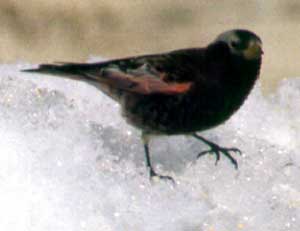
Leucosticte atrata
(Black Rosy Finch)
Order: Passeriformes
Order Description: Passerines
Family: Fringillidae
Family Description: Finches, Crossbills, and Grosbeaks
Physical Description:
Length 6.25". Black head, chest and back, with a wedge of gray from the nape to the eye. The wings, belly and rump are rosy colored, mixed with brown. The female has less gray in the nape.
Similar Species- Gray crowned Rosy Finches.
Song:
Calls a series of "cheew" notes.
Distribution:
Breeds in rocky alpine habitats in central Idaho, southwestern Montana, the Tetons, and the Ruby mountains near Elko, Nevada.
Habitat:
Barren, rocky or grassy areas with cliffs among glaciers above treeline. Winters in open areas at lower elevations, sometimes visiting human habitation with feeders.
Diet:
Insects and other invertebrates in the spirng and summer, seeds and other plant parts in the fall and winter.
Ecology:
Not truly territorial in that the male follows the female wherever she goes. Feed on snowbanks at high elevations and glean insects that are too cold to move. In winter they flock, with Gray-crowned Rosy-Finches on exposed ridges and near feeders. At night they roost in caves, mine shafts, or in abandoned Cliff Swallow nests.
Reproduction:
monogamous. Female builds a cup nest in a cliff crevice where she lays 4-5 eggs. Female incubates for 12-14 days, then the altricial young are fed for an additional 16-22 days by both male and female.
Conservation:
| Element Code: | - |
| Status: | Protected nongame species |
| Global Rank: | G? |
| State Rank: | S? |
| National Rank: | - |
Important State References:
No references are available at this time.
Original images provided by C. Trost,© 2000
Design by Ean Harker©1999, 2000.
Written by Jason Karl, 2000.
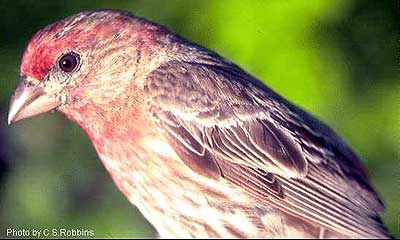
Carpodacus mexicanus
(House Finch)
Order: Passeriformes
Order Description: Passerines
Family: Fringillidae
Family Description: Finches, Crossbills, and Grosbeaks
Physical Description:
5-5 3/4" (13-15 cm). Red head and breast; streaked gray elsewhere. Thick, short bill. The female is mostly a brownish-gray with diffuse streaks on her breast.
Similar Species- Male Purple Finch, Male Cassin's Finch, Pine Siskin
Song:
Warbling song with an upward, burry ending. Call is a burry chirp.
Distribution:
From southern British Columbia, east to Idaho, Wyoming, and western Nebraska, south to Oklahoma and Texas, and west to California, Baja California, and further south into Mexico. Introduced in eastern United States.
Habitat
Found in arid scrub and brush, thornbush, oak/juniper, pine/oak associations, chaparral, open woodlands, towns, cultivated lands, and savannas.
Diet:
Eats seeds, plant buds and blossoms, and fruits (approximately 86% of diet is seeds). Nestlings are fed regurgitated seeds.
Ecology
Usually builds nest in tree, but may sometimes nest in shrub or building; may also take nest from other species. Forages on ground, or takes food from foliage. Forms flocks when not breeding.
Reproduction:
Female incubates 2-6 eggs (usually 4-5), for 12-14 days. Young are tended by both parents, leave nest in 14-19 days, and are fed by parents for 2-3 wk after leaving nest.
Conservation:
| Element Code: |
ABPBY04040 |
| Status: | Protected nongame species |
| Global Rank: | G5 |
| State Rank: | S5 |
| National Rank: | N5 |
Important State References:
No references are available at this time.
Photo by C. S. Robbins, George Jameson, ©2002 and C. Trost,© 1999
Design by Ean Harker©1999, 2000.
Written by Jason Karl, 2000.
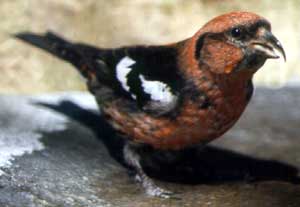
Loxia leucoptera
(White-winged Crossbill)
Order: Passeriformes
Order Description: Passerines
Family: Fringillidae
Family Description: Finches, Crossbills, and Grosbeaks
Physical Description:
Two distinct white wing bars on a bird with a crossed bill. Adults males are red overall, pinker in the winter. Young males are yellow and females are mottled with a yellowish-gray belly and rump. Juveniles are streaked on the head and front, and thinner wing bars.
Similar species- Red Crossbill, Pine Grosbeak.
Song:
Flight call is rapid series of "chet" calls, song combines harsh rattles and musical warbles.
Distribution:
Alaska and the Yukon to central Manitoba and irregularly south along the Rockies to Utah and Colorado. In Idaho it has nested in the Selkirks north of Sandpoint, and probably in the Yellowstone area.
Habitat:
Information is not available at this time.
Diet:
Conifer seeds, but also seeds of deciduous trees, grasses, berries, and insects. They have a fondness for salt and frequently are killed along salted roads.
Ecology:
An irruptive species that moves with the cone crops, and nests where they are plentiful. They usually breed in the late winter and spring, and the male feeds the female by regurgitation. In winter they move in flocks of 12-50 birds, sometimes with Red Crossbills and Pine Grosbeaks.
Reproduction:
monogamous. Female builds a cup nest in a conifer branch where she lays 2-5 eggs. Only the female incubates for 12-14 day, when she is fed by her mate.
Conservation:
| Element Code: | ABPBY05020 |
| Status: | Protected nongame species |
| Global Rank: | G5 |
| State Rank: | S1 |
| National Rank: | N5 |
Important State References:
No references are available at this time.
Photos by C. Trost and C. S. Robbins. ©2002.
Design by Ean Harker©1999, 2000.
Written by Jason Karl, 2000.
Carduelis psaltria
(Lesser Goldfinch)
Link to photo provided by USGS - Patuxent Wildlife Research Center: http://www.mbr-pwrc.usgs.gov/Infocenter/infocenter.html
Order: Passeriformes
Order Description: Passerines
Family: Fringillidae
Family Description: Finches, Crossbills, and Grosbeaks
Physical Description:
3 1/2-4" (9-10 cm). Black or green back, wings, and tail; three white, v-shaped bars on back, white patch on lower wing. Bright yellow underparts. Females and immatures have duller yellow below.
Similar Species- American Goldfinch Lawrence's Goldfinch
Song:
Calls a falling teee; song is a jumble of high-pitched twittering notes sometimes including songs of neighboring species.
Distribution:
Resident from southwestern Washington, western Oregon, northeastern California, northern Nevada, northern Utah, and northern Colorado, south to northwestern Oklahoma, north-central and central Texas, Mexico, and northern South America. Mainly migratory in Rocky Mountain region.
Habitat:
Found, in areas where water is available, in partly-open situations with scattered trees, and in woodland edges, second growth, open fields, pastures, and around human habitation.
Diet:
Thistle and other seeds comprise about 96% of diet. May also take a few insects during breeding season.
Ecology:
Usually nests 0.6-9 m above ground in dense foliage in tree or shrub, often near water. Usually forages on or near ground. Frequently forages in flocks. Species may form loose winter flocks of 20-30 birds that may also include other species of goldfinches and passerines. Lesser Goldfinch is an uncommon breeder in Idaho.
Reproduction:
Female incubates 3-6 eggs (usually 4-5), for 12 days. Nestlings are altricial and downy, and are tended by both parents. Breeding pairs may stay together all winter.
Conservation:
| Element Code: | ABPBY06090 |
| Status: | Protected nongame species |
| Global Rank: | G5 |
| State Rank: | S1,NTMB |
| National Rank: | N5 |
Important State References:
Stephens, D.A., C. Webb, and C.H. Trost. 1990. First report of nesting lesser goldfinch in Idaho. Western Birds 21(1): 33-34.
Design by Ean Harker©1999, 2000.
Written by Jason Karl, 2000.
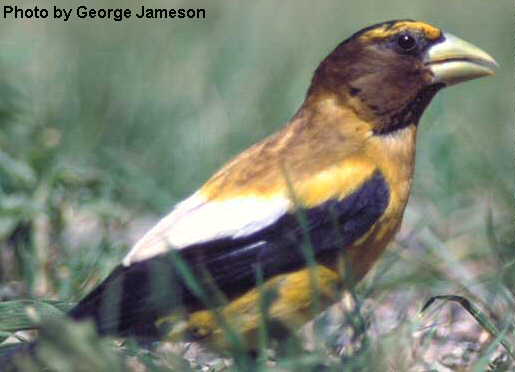
Coccothraustes vespertinus
(Evening Grosbeak)
Order: Passeriformes
Order Description: Passerines
Family: Fringillidae
Family Description: Finches, Crossbills, and Grosbeaks
Physical Description:
7-8 1/2" (18-22 cm). A large, plump finch with heavy conical bill. Wings and short tail are black; white patches on wings. Brown head with yellow forehead and eyebrows; olive-brown neck and breast. Yellow back, rump, and belly; bill yellowish in breeding and ivory in winter. Female and immatures grayish with yellow wash; wings and tail marked with white.
Song:
Calls constantly to maintain contact with flock. A shrill tchew and a trilled pwerp.
Distribution:
Breeds from British Columbia, east across portions of Canada, and south in mountains to central California and Veracruz, Mexico. Breeds in eastern U.S. to Minnesota, northern New York, and Massachusetts. Winters throughout breeding range, and irregularly to Gulf Coast and central Florida.
Habitat:
Found in montane coniferous (primarily spruce and fir) and mixed coniferous/deciduous forests at higher elevations, in second growth, and occasionally in parks. During migration and in winter, found in variety of forest and woodland habitats and around human habitation.
Diet:
Eats buds and seeds of deciduous trees, shrubs, and conifers. Will eat some insects in summer.
Ecology:
Builds cup-shaped nest in tree, near edge of limb. Gregarious; travels and forages in flocks throughout much of year. Forages on ground, or in foliage.
Reproduction:
In Colorado, most nests are initiated in late May or early June. Female incubates 2-5 eggs (usually 3-4), for about 11-14 days. Male provides most of female's food during incubation. Young are tended by both adults, and leave nest at 13-14 days.
Conservation:
| Element Code: | ABPBY09020 |
| Status: | Protected nongame species |
| Global Rank: | G5 |
| State Rank: | S5 |
| National Rank: | N5 |
Important State References:
No references are available at this time.
Photos by George Jameson, ©2002 and Jason Karl,© 1998
Design by Ean Harker©1999, 2000.
Written by Jason Karl, 2000.

Pinicola enucleator
(Pine Grosbeak)
Order: Passeriformes
Order Description: Passerines
Family: Fringillidae
Family Description: Finches, Crossbills, and Grosbeaks
Physical Description:
8-10" (20-25 cm). Male has red head, breast, and back; dark tail. Gray, black, and white bars on wings; black eye with indistinct black line. Female and immature has chestnut crown and rump, gray elsewhere with black and white bars on wings.
Similar Species- White-winged Crossbill
Song:
Warbling with little variation in pitch (only 3 notes).
Distribution:
Breeds from western Alaska, east across northern Canada to Newfoundland, and south to central California, northern New Mexico, northern Alberta, central Manitoba, central Maine, and Nova Scotia. Winters from western Alaska and portions of western and southern Canada, south through breeding range.
Habitat:
Found in open coniferous (less commonly mixed coniferous/deciduous) forests and forest edges. During migration and in winter, also found in deciduous forests, woodlands, second growth, and shrubbery.
Diet:
Feeds on wide variety of seeds. Also eats fruits and insects.
Ecology:
Builds cup-shaped nest, usually in coniferous tree, but may nest in shrub. Takes food from foliage or ground. gregarious; may gather in flocks of up to 100 birds.
Reproduction:
Female incubates 2-6 eggs (usually 4), for 13-14 days. Young leave nest about 20 days after hatching.
Conservation:
| Element Code: | ABPBY03010 |
| Status: | Protected nongame species |
| Global Rank: | G5 |
| State Rank: | S4 |
| National Rank: | N5 |
Important State References:
No references are available at this time.
Photo by Marcus Martin
Design by Ean Harker©1999, 2000.
Written by Jason Karl, 2000.
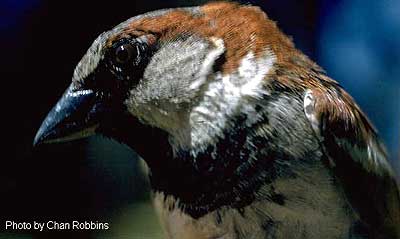
Passer domesticus
(House Sparrow)
Order:Passeriformes
Order Description: Passerines
Family: Passeridae
Family Description: Weaver Finches
Physical Description:
Length 6.25" Male in breeding plumage has a gray crown, chestnut nape, and black bib, which is edged with gray in fresh fall plumage. Female has a streaked back, buffy eyeline, and unstreaked breast.
Song:
The call is a series of "cheeps" that can become a chatter when in a group.
Distribution:
Introduced initially in 1850 in Brooklyn, New York. Now established from central British Columbia, and the Mackenzie, central Saskatchewan, central Ontario southern Quebec, and Newfoundland south thorugh the continental United States.
Habitat:
Information is not available at this time.
Diet:
Insects and spiders, forb seeds, blossoms, and seeds in livestock feces.
Ecology:
A highly adaptable and social species that originally was dependent on farms and livestock. Its popluations decreased with the decline of horses and the subsequent increase in automobiles, but has moved into urban environments, where bird feeders are frequented. It is still abundant around farmsteads and any human habitation.
Reproduction:
Nest in an artificial or natural cavity, and occasionally in a ball of grass with a hole in the side, which is lined with hair and feathers. The female lays 4-6 eggs, which she alone incubates for 10-13 days. The altricial young are fed insects and seed pulp by both parents for 14-17 more days.
Conservation:
| Element Code: | ABPBZ01010 |
| Status: | Nongame species |
| Global Rank: | G5 |
| State Rank: | S? |
| National Rank: | NE5 |
Important State References:
No references are available at this time.
Photo by C. S. Robbins. ©2002.
Design by Ean Harker©1999, 2000.
Written by Jason Karl, 2000.
